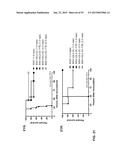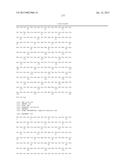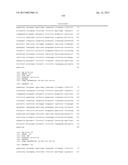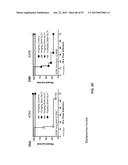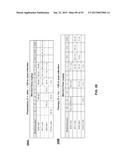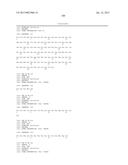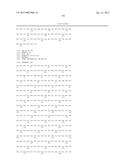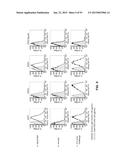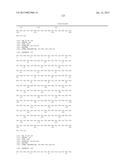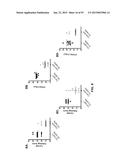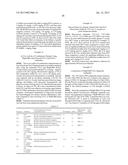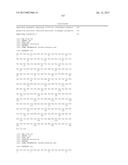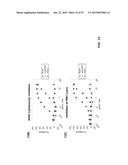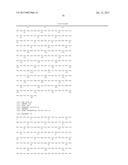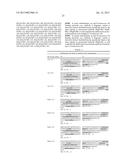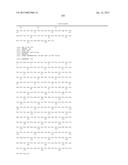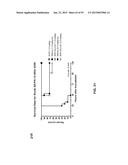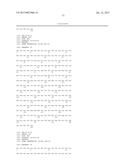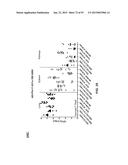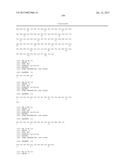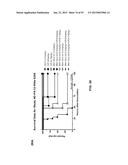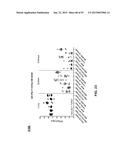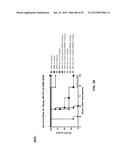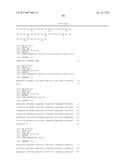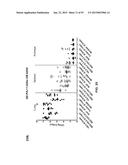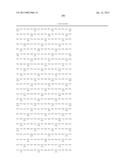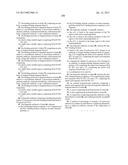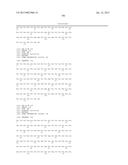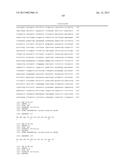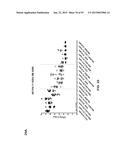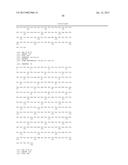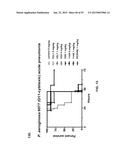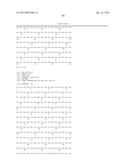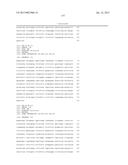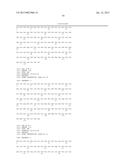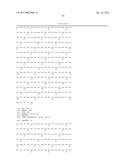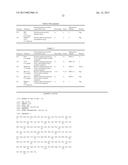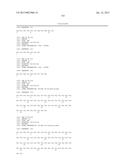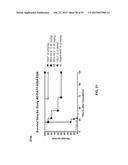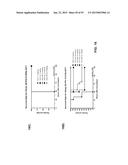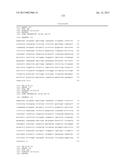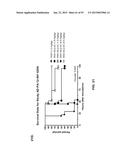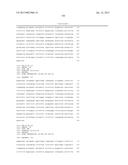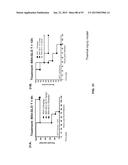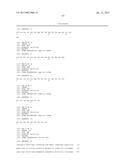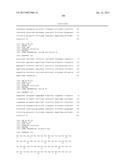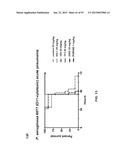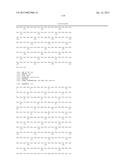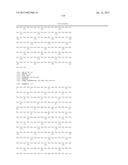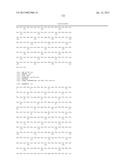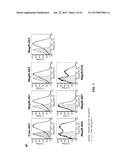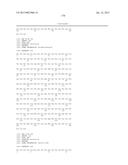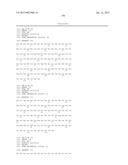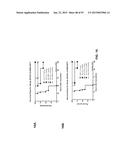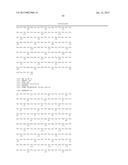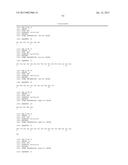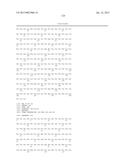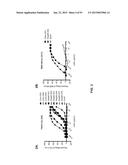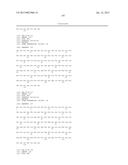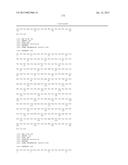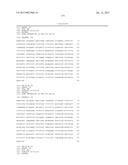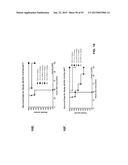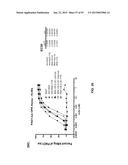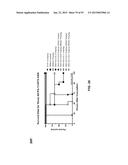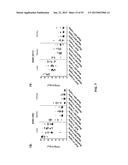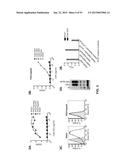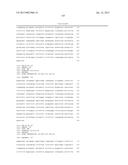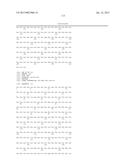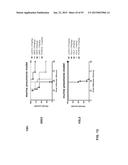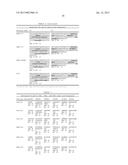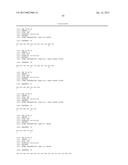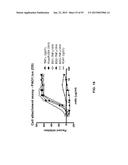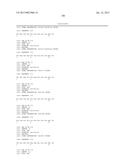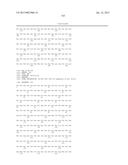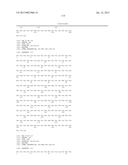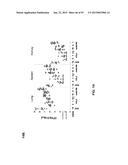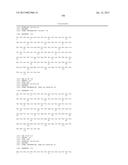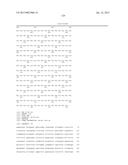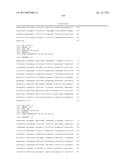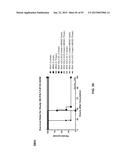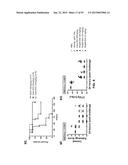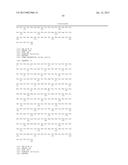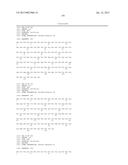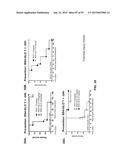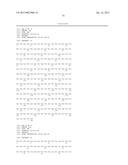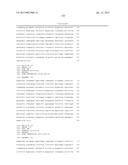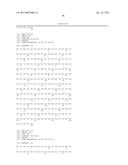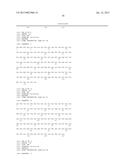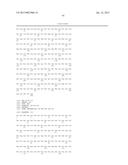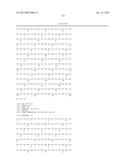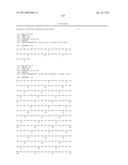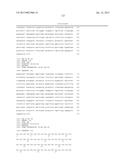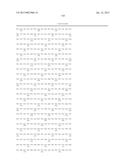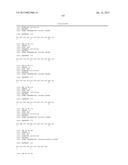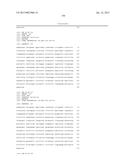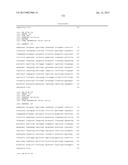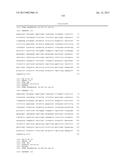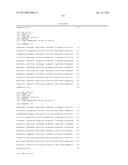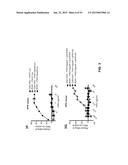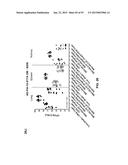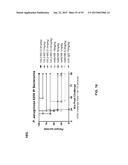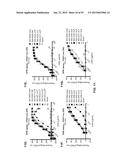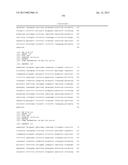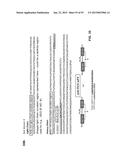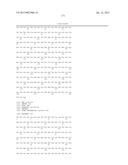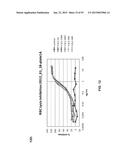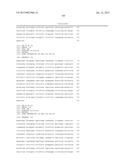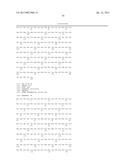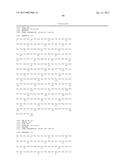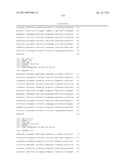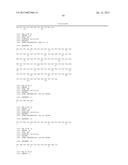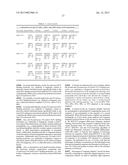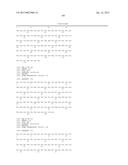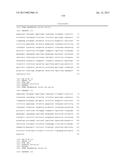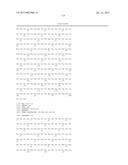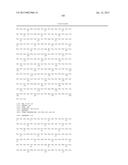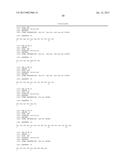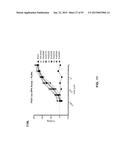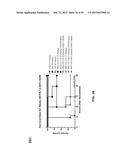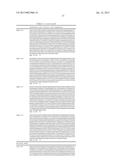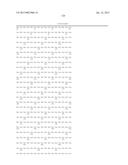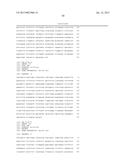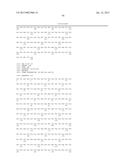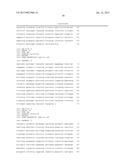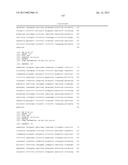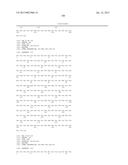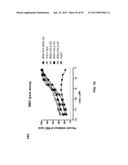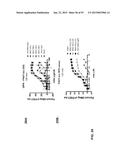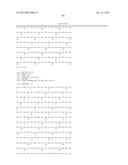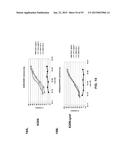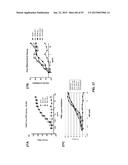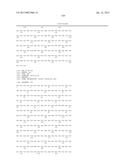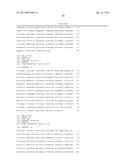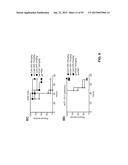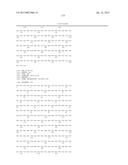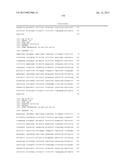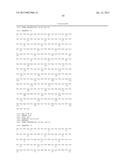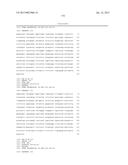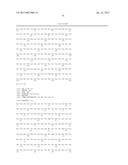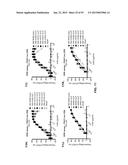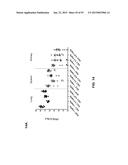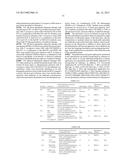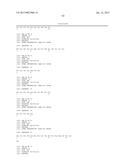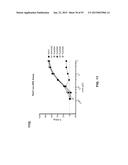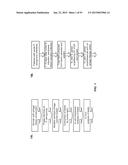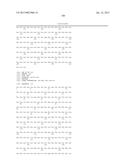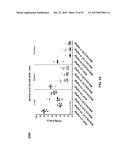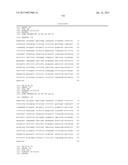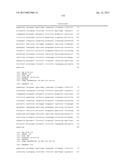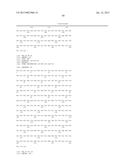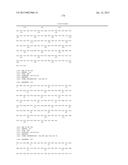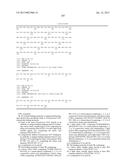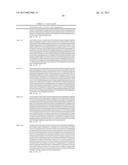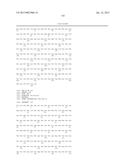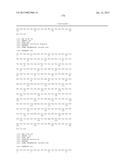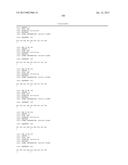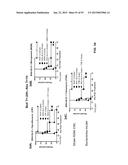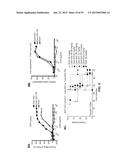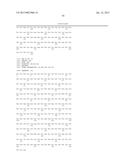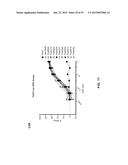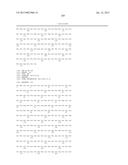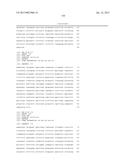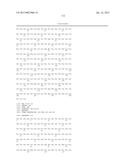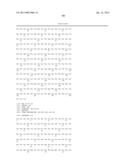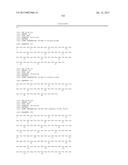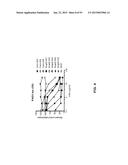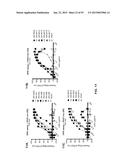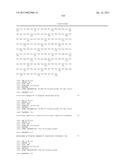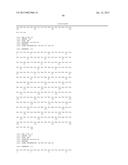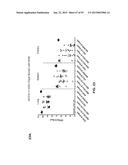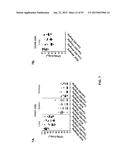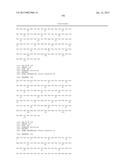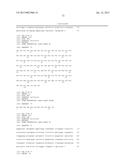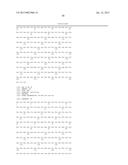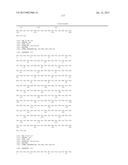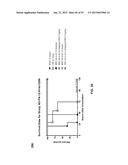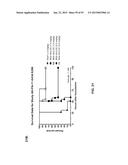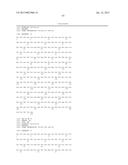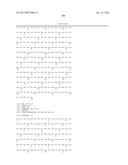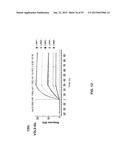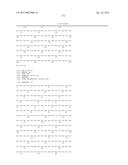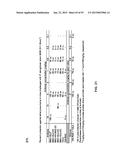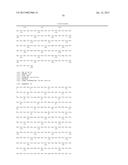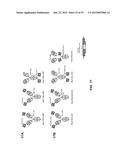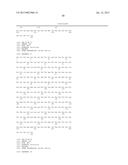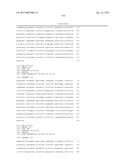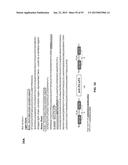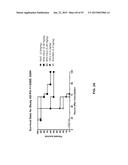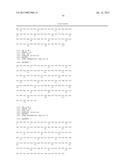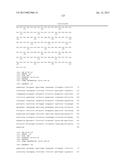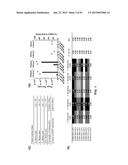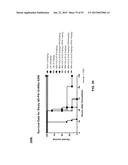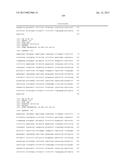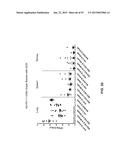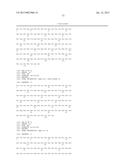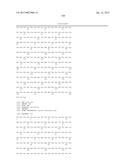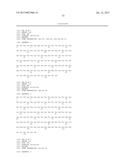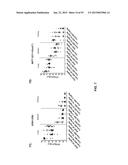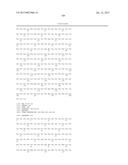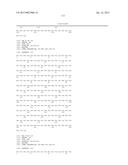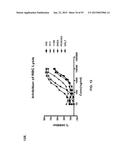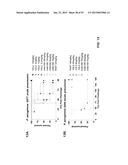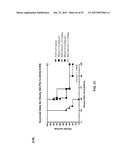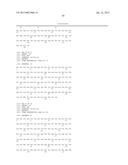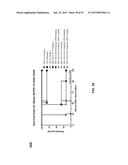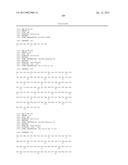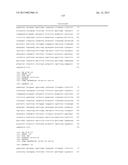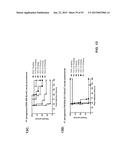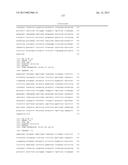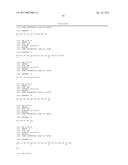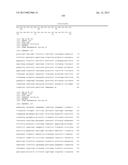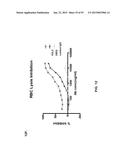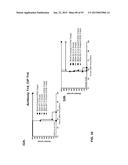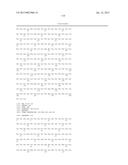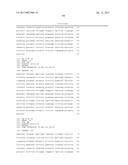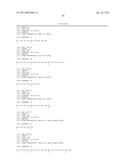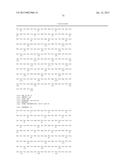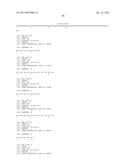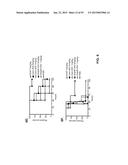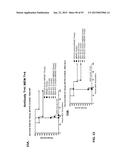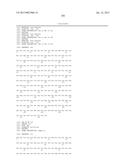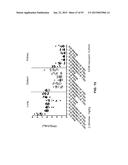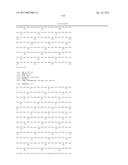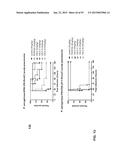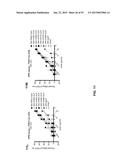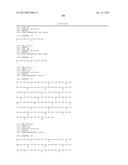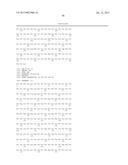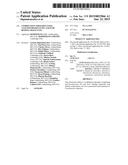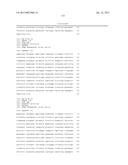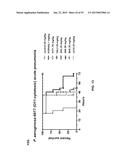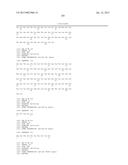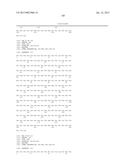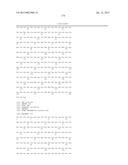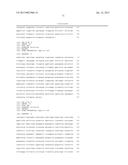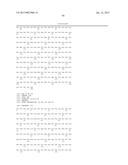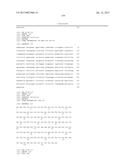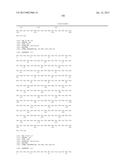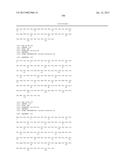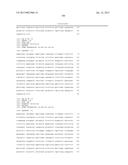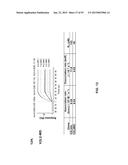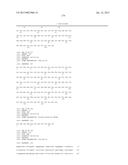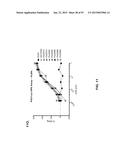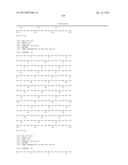Patent application title: COMBINATION THERAPIES USING ANTI-PSEUDOMONAS PSL AND PCRV BINDING MOLECULES
Inventors:
Antonio Digiandomenico (Gaithersburg, MD, US)
Paul Warrener (Gaithersburg, MD, US)
Charles Stover (Gaithersburg, MD, US)
Bret Sellman (Gaithersburg, MD, US)
Ralph Minter (Gaithersburg, MD, US)
Sandrine Guillard (Cambridge, GB)
Steven Rust (Cambridge, GB)
Mladen Tomich (Exton, PA, US)
Vignesh Venkatraman (Cambridge, GB)
Reena Varkey (Gaithersburg, MD, US)
Li Peng (Gaithersburg, MD, US)
Melissa Damschroder (Gaithersburg, MD, US)
Melissa Damschroder (Gaithersburg, MD, US)
Partha Chowdhury (Gaithersburg, MD, US)
Nazzareno Dimasi (Gaithersburg, MD, US)
Nazzareno Dimasi (Gaithersburg, MD, US)
Ryan Fleming (Gaithersburg, MD, US)
Binyam Bezabeh (Gaithersburg, MD, US)
Changshou Gao (Gaithersburg, MD, US)
Changshou Gao (Gaithersburg, MD, US)
Godfrey Rainney (Gaithersburg, MD, US)
Cuihua Gao (Gaithersburg, MD, US)
IPC8 Class: AC07K1612FI
USPC Class:
4241361
Class name: Immunoglobulin, antiserum, antibody, or antibody fragment, except conjugate or complex of the same with nonimmunoglobulin material structurally-modified antibody, immunoglobulin, or fragment thereof (e.g., chimeric, humanized, cdr-grafted, mutated, etc.) bispecific or bifunctional, or multispecific or multifunctional, antibody or fragment thereof
Publication date: 2015-01-22
Patent application number: 20150023966
Abstract:
This disclosure relates to combination therapies comprising
anti-Pseudomonas Psl and PcrV binding molecules and related compositions,
for use in prevention and treatment of Pseudomonas infection.Claims:
1-73. (canceled)
74. An isolated binding molecule or antigen binding fragment thereof that specifically binds to Pseudomonas PcrV, wherein the binding molecule: (a) binds to the same Pseudomonas PcrV epitope as an antibody or antigen-binding fragment thereof comprising a heavy chain variable region (VH) comprising the amino acid sequence SEQ ID NO: 216 and a light chain variable region (VL) comprising the amino acid sequence SEQ ID NO: 217; (b) competitively inhibits Pseudomonas PcrV binding by an antibody or antigen-binding fragment thereof comprising a VH comprising the amino acid sequence SEQ ID NO: 216 and a VL comprising the amino acid sequence SEQ ID NO: 217; or (c) a combination of (a) and (b).
75. The binding molecule of claim 74, comprising: (a) a heavy chain CDR1 comprising SYAMN (SEQ ID NO:218), or a variant thereof comprising 1, 2, 3, or 4 conservative amino acid substitutions; a heavy chain CDR2 comprising AITISGITAYYTDSVKG (SEQ ID NO: 219), or a variant thereof comprising 1, 2, 3, or 4 conservative amino acid substitutions; and a heavy chain CDR3 comprising EEFLPGTHYYYGMDV (SEQ ID NO: 220), or a variant thereof comprising 1, 2, 3, or 4 conservative amino acid substitutions; (b) a light chain CDR1 comprising RASQGIRNDLG (SEQ ID NO: 221), or a variant thereof comprising 1, 2, 3, or 4 conservative amino acid substitutions; a light chain CDR2 comprising SASTLQS (SEQ ID NO: 222), or a variant thereof comprising 1, 2, 3, or 4 conservative amino acid substitutions; and a light chain CDR3 comprising LQDYNYPWT (SEQ ID NO: 223), or a variant thereof comprising 1, 2, 3, or 4 conservative amino acid substitutions; or (c) a combination of (a) and (b).
76. The binding molecule of claim 74, comprising: (a) a heavy chain variable region having at least 90% sequence identity to SEQ ID NO: 216; (b) a light chain variable region having at least 90% sequence identity to SEQ ID NO: 217; or (c) a combination of (a) and (b).
77. The binding molecule of claim 74, comprising an antibody or antigen-binding fragment thereof.
78. The binding molecule or fragment thereof of claim 77, which is a recombinant antibody, a monoclonal antibody, a chimeric antibody, a humanized antibody, a fully human antibody, a bispecific antibody, or any combination thereof.
79. The binding molecule or fragment thereof of claim 78, comprising: (a) a heavy chain variable region comprising SEQ ID NO: 216; and (b) a light chain variable region comprising SEQ ID NO: 217.
80. The binding molecule of claim 75, comprising an antibody or antigen-binding fragment thereof.
81. The binding molecule or fragment thereof of claim 80, which is a recombinant antibody, a monoclonal antibody, a chimeric antibody, a humanized antibody, a fully human antibody, a bispecific antibody, or any combination thereof.
82. The binding molecule or fragment thereof of claim 81, comprising: (a) a heavy chain variable region comprising SEQ ID NO: 216; and (b) a light chain variable region comprising SEQ ID NO: 217.
83. The binding molecule of claim 76, comprising an antibody or antigen-binding fragment thereof.
84. The binding molecule or fragment thereof of claim 83, which is a recombinant antibody, a monoclonal antibody, a chimeric antibody, a humanized antibody, a fully human antibody, a bispecific antibody, or any combination thereof.
85. The binding molecule or fragment thereof of claim 84, comprising: (a) a heavy chain variable region comprising SEQ ID NO: 216; and (b) a light chain variable region comprising SEQ ID NO: 217.
86. A bispecific antibody comprising a binding domain that binds to Pseudomonas Psl and a binding domain that binds to Pseudomonas PcrV.
87. The bispecific antibody of claim 86, wherein: (a) the Psl binding domain comprises a scFv fragment and the PcrV binding domain comprises an intact immunoglobulin; or (b) the Psl binding domain comprises an intact immunoglobulin and the PcrV binding domain comprises a scFv fragment.
88. The bispecific antibody of claim 87, wherein: (a) the scFv is fused to the amino-terminus of the VH region of the intact immunoglobulin; (b) the scFv is fused to the carboxy-terminus of the CH3 region of the intact immunoglobulin; or (c) the scFv is inserted in the hinge region of the intact immunoglobulin.
89. The bispecific antibody of claim 86, wherein the anti-PcrV binding domain: (a) binds to the same Pseudomonas PcrV epitope as an antibody or antigen-binding fragment thereof comprising a VH comprising the amino acid sequence SEQ ID NO: 216 and a VL comprising the amino acid sequence SEQ ID NO: 217; (b) competitively inhibits Pseudomonas PcrV binding by an antibody or antigen-binding fragment thereof comprising a VH comprising the amino acid sequence SEQ ID NO: 216 and a VL comprising the amino acid sequence SEQ ID NO: 217; or (c) a combination of (a) and (b).
90. The bispecific antibody of claim 89, wherein the anti-PcrV binding domain comprises a VH comprising the amino acid sequence SEQ ID NO: 216 and a VL comprising the amino acid sequence SEQ ID NO: 217.
91. An isolated polynucleotide molecule comprising a nucleic acid sequence that encodes the bispecific antibody or fragment thereof of claim 86.
92. A vector comprising the polynucleotide of claim 91.
93. A cell comprising the polynucleotide of claim 91.
94. A composition comprising bispecific antibody or fragment thereof of claim 86, and a pharmaceutically acceptable carrier.
95. A method of preventing or treating a Pseudomonas infection in a subject in need thereof, comprising administering to a subject an effective amount of the composition of claim 94.
Description:
REFERENCE TO SEQUENCE LISTING SUBMITTED ELECTRONICALLY
[0001] The content of the electronically submitted sequence listing in ASCII text file entitled sequencelisting_PCTascii.txt created on Nov. 6, 2012 and having a size of 382 kilobytes filed with the application is incorporated herein by reference in its entirety.
BACKGROUND
[0002] 1. Field of the Disclosure
[0003] This disclosure relates to combination therapies using anti-Pseudomonas Psl and PcrV binding domains for use in the prevention and treatment of Pseudomonas infection. Furthermore, the disclosure provides compositions useful in such therapies.
[0004] 2. Background of the Disclosure
[0005] Pseudomonas aeruginosa (P. aeruginosa) is a gram-negative opportunistic pathogen that causes both acute and chronic infections in compromised individuals (Ma et al., Journal of Bacteriology 189(22):8353-8356 (2007)). This is partly due to the high innate resistance of the bacterium to clinically used antibiotics, and partly due to the formation of highly antibiotic-resistant biofilms (Drenkard E., Microbes Infect 5:1213-1219 (2003); Hancokc & Speert, Drug Resist Update 3:247-255 (2000)).
[0006] P. aeruginosa is a common cause of hospital-acquired infections in the Western world. It is a frequent causative agent of bacteremia in burn victims and immune compromised individuals (Lyczak et al., Microbes Infect 2:1051-1060 (2000)). It is also the most common cause of nosocomial gram-negative pneumonia (Craven et al., Semin Respir Infect 11:32-53 (1996)), especially in mechanically ventilated patients, and is the most prevalent pathogen in the lungs of individuals with cystic fibrosis (Pier et al., ASM News 6:339-347 (1998)).
[0007] Pseudomonas Psl exopolysaccharide is reported to be anchored to the surface of P. aeruginosa and is thought to be important in facilitating colonization of host tissues and in establishing/maintaining biofilm formation (Jackson, K. D., et al., J Bacteriol 186, 4466-4475 (2004)). Its structure comprises mannose-rich repeating pentasaccharide (Byrd, M. S., et al., Mol Microbiol 73, 622-638 (2009)).
[0008] PcrV is a relatively conserved component of the type III secretion system. PcrV appears to be an integral component of the translocation apparatus of the type III secretion system mediating the delivery of the type III secretory toxins into target eukaryotic cells (Sawa T., et al. Nat. Med. 5, 392-398 (1999)). Active and passive immunization against PcrV improved acute lung injury and mortality of mice infected with cytotoxic P. aeruginosa (Sawa et al. 2009). The major effect of immunization against PcrV was due to the blockade of translocation of the type III secretory toxins into eukaryotic cells.
[0009] Due to increasing multidrug resistance, there remains a need in the art for the development of novel strategies for the identification of new Pseudomonas-specific prophylactic and therapeutic agents.
BRIEF SUMMARY
[0010] The disclosure provides a binding molecule or antigen binding fragment thereof that specifically binds Pseudomonas PcrV, which comprises: (a) a heavy chain CDR1 comprising SYAMN (SEQ ID NO:218), or a variant thereof comprising 1, 2, 3, or 4 conservative amino acid substitutions; a heavy chain CDR2 comprising AITISGITAYYTDSVKG (SEQ ID NO: 219), or a variant thereof comprising 1, 2, 3, or 4 conservative amino acid substitutions; and a heavy chain CDR3 comprising EEFLPGTHYYYGMDV (SEQ ID NO: 220), or a variant thereof comprising 1, 2, 3, or 4 conservative amino acid substitutions; (b) a light chain CDR1 comprising RASQGIRNDLG (SEQ ID NO: 221), or a variant thereof comprising 1, 2, 3, or 4 conservative amino acid substitutions; a light chain CDR2 comprising SASTLQS (SEQ ID NO: 222), or a variant thereof comprising 1, 2, 3, or 4 conservative amino acid substitutions; and a light chain CDR3 comprising LQDYNYPWT (SEQ ID NO: 223), or a variant thereof comprising 1, 2, 3, or 4 conservative amino acid substitutions; or combinations of (a) and (b). In one embodiment, the binding molecule or antigen binding fragment thereof specifically binds Pseudomonas PcrV, and comprises: (a) a heavy chain CDR1 comprising SYAMN (SEQ ID NO: 218), a heavy chain CDR2 comprising AITISGITAYYTDSVKG (SEQ ID NO: 219), and a heavy chain CDR3 comprising EEFLPGTHYYYGMDV (SEQ ID NO: 220); and (b) a light chain CDR1 comprising RASQGIRNDLG (SEQ ID NO: 221), a light chain CDR2 comprising SASTLQS (SEQ ID NO: 222), and a light chain CDR3 comprising LQDYNYPWT (SEQ ID NO: 223). In one embodiment, the isolated binding molecule or antigen binding fragment thereof specifically binds Pseudomonas PcrV and comprises (a) a heavy chain variable region having at least 90% sequence identity to SEQ ID NO: 216; (b) a light chain variable region having at least 90% sequence identity to SEQ ID NO: 217; or combinations of (a) and (b). In another embodiment, the binding molecule or fragment thereof comprises: (a) a heavy chain variable region having at least 95% sequence identity to SEQ ID NO: 216; (b) a light chain variable region having at least 95% sequence identity to SEQ ID NO: 217; or combinations of (a) and (b). In another embodiment, the binding molecule or fragment thereof is V2L2 and comprises: (a) a heavy chain variable region comprising SEQ ID NO: 216; and (b) a light chain variable region comprising SEQ ID NO: 217.
[0011] In one embodiment, the disclosure provides an isolated binding molecule or antigen binding fragment thereof that specifically binds to the same Pseudomonas PcrV epitope as an antibody or antigen-binding fragment thereof comprising the VH and VL region of V2L2. In another embodiment, the disclosure provides an isolated binding molecule or antigen binding fragment thereof that specifically binds to Pseudomonas PcrV, and competitively inhibits Pseudomonas PcrV binding by an antibody or antigen-binding fragment thereof comprising the VH and VL of V2L2. In one embodiment, the binding molecule or fragment thereof is a recombinant antibody. In one embodiment, the binding molecule or fragment thereof is a monoclonal antibody. In one embodiment, the binding molecule or fragment thereof is a chimeric antibody. In one embodiment, the binding molecule or fragment thereof is a humanized antibody. In one embodiment, the binding molecule or fragment thereof is a human antibody. In one embodiment, the binding molecule or fragment thereof is a bispecific antibody.
[0012] In one embodiment, the binding molecule or fragment thereof inhibits delivery of type III secretory toxins into target cells.
[0013] In one embodiment, the disclosure provides a bispecific antibody comprising a binding domain that binds to Pseudomonas Psl and a binding domain that binds to Pseudomonas PcrV. In one embodiment, the Psl binding domain comprises a scFv fragment and the PcrV binding domain comprises an intact immunoglobulin. In one embodiment, the Psl binding domain comprises an intact immunoglobulin and said PcrV binding domain comprises a scFv fragment. In one embodiment, the scFv is fused to the amino-terminus of the VH region of the intact immunoglobulin. In one embodiment, the scFv is fused to the carboxy-terminus of the CH3 region of the intact immunoglobulin. In one embodiment, the scFv is inserted in the hinge region of the intact immunoglobulin.
[0014] In one embodiment, the anti-Psl binding domain specifically binds to the same Pseudomonas Psl epitope as an antibody or antigen-binding fragment thereof comprising the heavy chain variable region (VH) and light chain variable region (VL) region at least 90% identical to the corresponding region of WapR-004. In one embodiment, the anti-Psl binding domain specifically binds to Pseudomonas Psl, and competitively inhibits Pseudomonas Psl binding by an antibody or antigen-binding fragment thereof comprising a VH and VL region at least 90% identical to the corresponding region of WapR-004. In one embodiment, the VH and VL of WapR-004 comprise SEQ ID NO:11 and SEQ ID NO:12, respectively. In one embodiment, the WapR-004 sequence is selected from the group consisting of: SEQ ID NO:228, SEQ ID NO:229, and SEQ ID NO:235. In one embodiment, the anti-PcrV binding domain specifically binds to the same Pseudomonas PcrV epitope as an antibody or antigen-binding fragment thereof comprising the VH and VL region of V2L2. In one embodiment, the anti-PcrV binding domain specifically binds to Pseudomonas PcrV, and competitively inhibits Pseudomonas PcrV binding by an antibody or antigen-binding fragment thereof comprising the VH and VL of V2L2. In another embodiment, the anti-PcrV binding domain specifically binds to the same Pseudomonas PcrV epitope as an antibody or antigen-binding fragment thereof comprising a VH and VL region at least 90% identical to the corresponding region of V2L2. In one embodiment, the VH and VL of V2L2 comprise SEQ ID NO:216 and SEQ ID NO:217, respectively. In one embodiment, the VH and VL of WapR-004 (SEQ ID NOs:11 and 12, respectively) and the VH and VL of V2L2 (SEQ ID NOs: 216 and 217, respectively). In one embodiment, the bispecific antibody comprises an amino acid sequence selected from the group consisting of: SEQ ID NO:228, SEQ ID NO:229, and SEQ ID NO:235.
[0015] In one embodiment, the disclosure provides a polypeptide comprising an amino acid sequence of SEQ ID NO:216 or SEQ ID NO:217. In one embodiment, the polypeptide is an antibody.
[0016] In one embodiment, the disclosure provides a cell comprising or producing the binding molecule or polypeptide disclosed herein.
[0017] In one embodiment, the disclosure provides an isolated polynucleotide molecule comprising a polynucleotide that encodes a binding molecule or polypeptide described herein. In one embodiment, the polynucleotide molecule comprises a polynucleotide sequence selected from the group consisting of: SEQ ID NO:238 and SEQ ID NO:239. In another embodiment, the disclosure provides a vector comprising a polynucleotide described herein. In another embodiment, the disclosure provides a cell comprising a polynucleotide or vector.
[0018] In one embodiment, the disclosure provides a composition comprising a binding molecule, bispecific antibody, or polypeptide described herein and a pharmaceutically acceptable carrier.
[0019] In one embodiment, the disclosure provides a composition comprising a binding domain that binds to Pseudomonas Psl and a binding domain that binds to Pseudomonas PcrV. In one embodiment, the anti-Psl binding domain specifically binds to the same Pseudomonas Psl epitope as an antibody or antigen-binding fragment thereof comprising the heavy chain variable region (VH) and light chain variable region (VL) region at least 90% identical to the corresponding region of WapR-004, Cam-003, Cam-004, Cam-005, WapR-001, WapR-002, WapR-003, or WapR-016. In one embodiment, the anti-Psl binding domain specifically binds to Pseudomonas Psl, and competitively inhibits Pseudomonas Psl binding by an antibody or antigen-binding fragment thereof comprising a VH and VL region at least 90% identical to the corresponding region of WapR-004, Cam-003, Cam-004, Cam-005, WapR-001, WapR-002, WapR-003, or WapR-016. In one embodiment, the VH and VL of WapR-004 comprise SEQ ID NO:11 and SEQ ID NO:12, respectively, the VH and VL of Cam-003 comprise SEQ ID NO:1 and SEQ ID NO:2, respectively, the VH and VL of Cam-004 comprise SEQ ID NO:3 and SEQ ID NO:2, respectively, the VH and VL of Cam-005 comprise SEQ ID NO:4 and SEQ ID NO:2, respectively, the VH and VL of WapR-001 comprise SEQ ID NO:5 and SEQ ID NO:6, respectively, the VH and VL of WapR-002 comprise SEQ ID NO:7 and SEQ ID NO:8, respectively, the VH and VL of WapR-003 comprise SEQ ID NO:9 and SEQ ID NO:10, respectively, and the VH and VL of WapR-016 comprise SEQ ID NO: 15 and SEQ ID NO:16, respectively. In one embodiment, the anti-PcrV binding domain specifically binds to the same Pseudomonas PcrV epitope as an antibody or antigen-binding fragment thereof comprising the VH and VL region of V2L2. In one embodiment, the anti-PcrV binding domain specifically binds to Pseudomonas PcrV, and competitively inhibits Pseudomonas PcrV binding by an antibody or antigen-binding fragment thereof comprising the VH and VL of V2L2. In one embodiment, the anti-PcrV binding domain specifically binds to the same Pseudomonas PcrV epitope as an antibody or antigen-binding fragment thereof comprising a VH and VL region at least 90% identical to the corresponding region of V2L2. In one embodiment, the VH and VL of V2L2 comprise SEQ ID NO:216 and SEQ ID NO:217, respectively. In one embodiment, the anti-Psl binding domain comprises the VH and VL region of WapR-004, and said anti-PcrV binding domain comprises the VH and VL region of V2L2, or antigen-binding fragments thereof.
[0020] In one embodiment, the composition comprises a first binding molecule comprising said anti Psl-binding domain, and a second binding molecule comprising a PcrV-binding domain. In one embodiment, the first binding molecule is an antibody or antigen binding fragment thereof, and said second binding molecule is an antibody or antigen binding fragment thereof. In one embodiment, the antibodies or antigen binding fragments are independently selected from the group consisting of: monoclonal, humanized, chimeric, human, Fab fragment, Fab' fragment, F(ab)2 fragment, and scFv fragment. In one embodiment, the binding domains, binding molecules or fragments thereof, bind to two or more, three or more, four or more, or five or more different P. aeruginosa serotypes. In one embodiment, the binding domains, binding molecules or fragments thereof, bind to at least 80%, at least 85%, at least 90% or at least 95% of P. aeruginosa strains isolated from infected patients. In one embodiment, the P. aeruginosa strains are isolated from one or more of lung, sputum, eye, pus, feces, urine, sinus, a wound, skin, blood, bone, or knee fluid. In one embodiment, the antibody or antigen binding fragment thereof is conjugated to an agent selected from the group consisting of antimicrobial agent, a therapeutic agent, a prodrug, a peptide, a protein, an enzyme, a lipid, a biological response modifier, pharmaceutical agent, a lymphokine, a heterologous antibody or fragment thereof, a detectable label, polyethylene glycol (PEG), and a combination of two or more of any said agents. In one embodiment, the detectable label is selected from the group consisting of an enzyme, a fluorescent label, a chemiluminescent label, a bioluminescent label, a radioactive label, or a combination of two or more of any said detectable labels.
[0021] In one embodiment, the disclosure provides a method of preventing or treating a Pseudomonas infection in a subject in need thereof, comprising administering to the subject an effective amount of a composition described herein, wherein said administration provides a synergistic therapeutic effect in the prevention or treatment of the Pseudomonas infection in said subject, and wherein said synergistic effect is greater than the sum of the individual effects of administration of equal molar quantities of the individual binding domains. In one embodiment, the synergistic therapeutic effect results in greater percent survival than the additive percent survival of subjects to which only one of the binding domains has been administered. In one embodiment, the composition is administered for two or more prevention/treatment cycles. In one embodiment, the binding domains or binding molecules are administered simultaneously. In one embodiment, the binding domains or binding molecules are administered sequentially. In one embodiment, the Pseudomonas infection is a P. aeruginosa infection. In one embodiment, the subject is a human. In one embodiment, the infection is an ocular infection, a lung infection, a burn infection, a wound infection, a skin infection, a blood infection, a bone infection, or a combination of two or more of said infections. In one embodiment, the subject has acute pneumonia, burn injury, corneal infection, cystic fibrosis, or a combination thereof.
[0022] In one embodiment, the disclosure provides a method of preventing or treating a Pseudomonas infection in a subject in need thereof, comprising administering to the subject an effective amount of the binding molecule or fragment thereof, a bispecific antibody, a polypeptide, or a composition described herein.
[0023] In one embodiment, the disclosure provides a kit comprising a composition described herein.
BRIEF DESCRIPTION OF THE DRAWINGS/FIGURES
[0024] FIG. 1 (A-F): Phenotypic whole cell screening with human antibody phage libraries identified P. aeruginosa functionally active specific antibodies. (A) Overview of complete antibody selection strategy. (B) Flow diagram describing the process to isolate antibody variable region genes from patients recently exposed to P. aeruginosa. (C) Characteristics of the scFv phage display libraries, indicating the size and diversity of the cloned antibody repertoire. (D) Comparison of the phage display selection efficiency using either the patient antibody library or a naive antibody library, when selected on P. aeruginosa 3064 Δ WapR (1) or P. aeruginosa PAO1 MexAB OprM Δ WapR (2) in suspension. Bars indicate the output titers (in CFU) at each round of selection, and circles indicate the proportion of duplicated VH CDR3 sequences, an indication of clonal enrichment. (E) ELISA screen of scFv from phage display to test binding to multiple strains of P. aeruginosa. ELISA data (absorbance at 450 nm) are shown for eight individual phage-scFvs from selections and one irrelevant phage-scFv. (F) FACS binding of P. aeruginosa specific antibodies with representative strains from unique P. aeruginosa serotypes. For each antibody tested a human IgG negative control antibody is shown as a shaded peak.
[0025] FIG. 2 (A-B): Evaluation of mAbs promoting OPK of P. aeruginosa (A) Opsonophagocytosis assay with luminescent P. aeruginosa serogroup O5 strain (PAO1.lux), with dilutions of purified monoclonal antibodies derived from phage panning. (B) Opsonophagocytosis assay with luminescent P. aeruginosa serogroup O11 strain (9882-80.lux), with dilutions of purified WapR-004 and Cam-003 monoclonal antibodies derived from phage panning. In both A and B, R347, an isotype matched human monoclonal antibody that does not bind P. aeruginosa antigens, was used as a negative control.
[0026] FIG. 3 (A-I): Identification of the P. aeruginosa Psl exopolysaccharide target of antibodies derived from phenotypic screening. Reactivity of antibodies was determined by indirect ELISA on plates coated with indicated P. aeruginosa strains: (A) wild type PAO1, PAO1ΔwbpL, PAO1ΔrmlC and PAO1ΔgalU. (B) PAO1ΔpslA. The Genway antibody is specific to a P. aeruginosa outer membrane protein and was used as a positive control. (C) FACS binding analysis of Cam-003 to PAO1 and PAO1ΔpslA. Cam-003 is indicated by a solid black line and clear peak; an isotype matched non-P. aeruginosa-specific human IgG1 antibody was used as a negative control and is indicated by a gray line and shaded peak. (D) LPS purified from PAO1 and PAO1ΔpslA was resolved by SDS-PAGE and immunobloted with antisera derived from mice vaccinated with PAO1ΔwapRΔalgD, a mutant strain deficient in O-antigen transport to the outer membrane and alginate production. (E) Cam-003 ELISA binding data with isogenic mutants of PAO1. Cam-003 is only capable of binding to strains expressing Psl. pPW145 is a pUCP expression vector containing pslA. (F and G) Opsonophagocytosis assays indicating that Cam-003 only mediates killing of strains capable of producing Psl (wild type PAO1 and PAO1ΔpslA complemented in trans with the pslA gene). (H and I) ELISA data indicating reactivity of anti-Psl antibodies WapR-001, WapR-004, and WapR-016 with PAO1 ΔwbpLΔalgD and PAO1 ΔwbpLΔalgDΔpslA. R347 was used as a negative control in all experiments.
[0027] FIG. 4: Anti-Psl mAbs inhibit cell attachment of luminescent P. aeruginosa strain PAO1.lux to A549 cells. Log-phase PAO1.lux were added to a confluent monolayer of A549 cells at an MOI of 10 followed by analysis of RLU after repeated washing to remove unbound P. aeruginosa. Results are representative of three independent experiments performed in duplicate for each antibody concentration.
[0028] FIG. 5 (A-C): In vivo passaged P. aeruginosa strains maintain/increase expression of Psl. The Cam-003 antibody is shown by a solid black line and a clear peak; the human IgG negative control antibody is shown as a gray line and a shaded peak. (A) For the positive control, Cam-003 was assayed for binding to strains grown to log phase from an overnight culture (˜5×108/ml). (B) The inocula for each strain were prepared to 5×108 CFU/ml from an overnight TSA plate grown to lawn and tested for reactivity to Cam-003 by flow cytometry. (C) Four hours post intraperitoneal challenge, bacteria was harvested from mice by peritoneal lavage and assayed for the presence of Psl with Cam-003 by flow cytometry.
[0029] FIG. 6 (A-F): Survival rates for animals treated with anti-Psl monoclonal antibodies Cam-003 or WapR-004 in a P. aeruginosa acute pneumonia model. (A-D) Animals were treated with Cam-003 at 45, 15, and 5 mg/kg and R347 at 45 mg/kg or PBS 24 hours prior to intranasal infection with (A) PAO1 (1.6×107 CFU), (B) 33356 (3×107 CFU), (C) 6294 (7×106 CFU), (D) 6077 (1×106 CFU). (E-F) Animals were treated with WapR-004 at 5 and 1 mg/kg as indicated followed by infection with 6077 at (E) (8×105 CFU), or (F) (6×105 CFU). Animals were carefully monitored for survival up to 72 hours (A-D) or for 120 hours (E-F). In all experiments, PBS and R347 served as negative controls. Results are represented as Kaplan-Meier survival curves; differences in survival were calculated by the Log-rank test for Cam-003 vs. R347. (A) Cam-003 (45 mg/kg--P<0.0001; 15 mg/kg--P=0.0003; 5 mg/kg--P=0.0033). (B) Cam-003 (45 mg/kg--P=0.0012; 15 mg/kg--P=0.0012; 5 mg/kg--P=0.0373). (C) Cam-003 (45 mg/kg--P=0.0007; 15 mg/kg--P=0.0019; 5 mg/kg--P=0.0212). (D) Cam-003 (45 mg/kg--P<0.0001; 15 mg/kg--P<0.0001; 5 mg/kg--P=0.0001). Results are representative of at least two independent experiments. (E) [Cam-003 (5 mg/kg) vs. R347 (5 mg/kg): P=0.02; Cam-003 (1 mg/kg) vs. R347 (5 mg/kg): P=0.4848; WapR-004 (5 mg/kg) vs. R347 (5 mg/kg): P<0.0001; WapR-004 (1 mg/kg) vs. R347 (5 mg/kg): P=0.0886; WapR-004 (5 mg/kg) vs. Cam-003 (5 mg/kg): P=0.0017; WapR-004 (1 mg/kg) vs. Cam-003 (1 mg/kg): P=0.2468; R347 (5 mg/kg) vs. PBS: P=0.6676] (F) [Cam-003 (5 mg/kg) vs. R347 (5 mg/kg): P=0.0004; Cam-003 (1 mg/kg) vs. R347 (5 mg/kg): P<0.0001; WapR-004 (5 mg/kg) vs. R347 (5 mg/kg): P<0.0001; WapR-004 (1 mg/kg) vs. R347 (5 mg/kg): P<0.0001; WapR-004 (5 mg/kg) vs. Cam-003 (5 mg/kg): P=0.0002; WapR-004 (1 mg/kg) vs. Cam-003 (1 mg/kg): P=0.2628; R347 (5 mg/kg) vs. PBS: P=0.6676]. Results are representative of five independent experiments.
[0030] FIG. 7 (A-F): Anti-Psl monoclonal antibodies, Cam-003 and WapR-004, reduce organ burden after induction of acute pneumonia. Mice were treated with Cam-003 antibody 24 hours prior to infection with (A) PAO1 (1.1×107 CFU), (B) 33356 (1×107 CFU), (C) 6294 (6.25×106 CFU) (D) 6077 (1×106 CFU), and WapR-004 antibody 24 hours prior to infection with (E) 6294 (˜1×107 CFU), and (F) 6206 (˜1×106 CFU). 24 hours post-infection, animals were euthanized followed by harvesting or organs for identification of viable CFU. Differences in viable CFU were determined by the Mann-Whitney U-test for Cam-003 or WapR-004 vs. R347. (A) Lung: Cam-003 (45 mg/kg--P=0.0015; 15 mg/kg--P=0.0021; 5 mg/kg--P=0.0015); Spleen: Cam-003 (45 mg/kg--P=0.0120; 15 mg/kg--P=0.0367); Kidneys: Cam-003 (45 mg/kg--P=0.0092; 15 mg/kg--P=0.0056); (B) Lung: Cam-003 (45 mg/kg--P=0.0010; 15 mg/kg--P<0.0001; 5 mg/kg--P=0.0045); (C) Lung: Cam-003 (45 mg/kg--P=0.0003; 15 mg/kg--P=0.0039; 5 mg/kg--P=0.0068); Spleen: Cam-003 (45 mg/kg--P=0.0057; 15 mg/kg--P=0.0230; 5 mg/kg--P=0.0012); (D) Lung: Cam-003 (45 mg/kg--P=0.0005; 15 mg/kg--P=0.0003; 5 mg/kg--P=0.0007); Spleen: Cam-003 (45 mg/kg--P=0.0015; 15 mg/kg--P=0.0089; 5 mg/kg--P=0.0089); Kidneys: Cam-003 (45 mg/kg--P=0.0191; 15 mg/kg--P=0.0355; 5 mg/kg--P=0.0021). (E) Lung: WapR-004 (15 mg/kg--P=0.0011; 5 mg/kg--P=0.0004; 1 mg/kg--P=0.0002); Spleen: WapR-004 (15 mg/kg--P<0.0001; 5 mg/kg--P=0.0014; 1 mg/kg--P<0.0001); F) Lung: WapR-004 (15 mg/kg--P<0.0001; 5 mg/kg--P=0.0006; 1 mg/kg--P=0.0079); Spleen: WapR-004 (15 mg/kg--P=0.0059; 5 mg/kg--P=0.0261; 1 mg/kg--P=0.0047); Kidney: WapR-004 (15 mg/kg--P=0.0208; 5 mg/kg--P=0.0268.
[0031] FIG. 8 (A-G): Anti-Psl monoclonal antibodies Cam-003 and WapR-004 are active in a P. aeruginosa keratitis model and thermal injury model. Mice were treated with a control IgG1 antibody or Cam-003 at 45 mg/kg (A, B) or 15 mg/kg (C, D) or PBS or a control IgG1 antibody or Cam-003 at 45 mg/kg or WapR-004 at 45 mg/kg or 15 mg/kg or 5 mg/kg (F, G) 24 hours prior to infection with 6077 (O11-cytotoxic--2×106 CFU). Immediately before infection, three 1 mm scratches were made on the left cornea of each animal followed by topical application of P. aeruginosa in a 5 μl inoculum. 24 hours after infection, the corneal pathology scores were calculated followed by removal of the eye for determination of viable CFU. Differences in pathology scores and viable CFU were determined by the Mann-Whitney U-test. (A) P=0.0001, (B) P<0.0001, (C) P=0.0003, (D) P=0.0015. (F) and (G) Cam-003 (45 mg/kg) vs. WapR-004 (45 mg/kg): P=0.018; Cam-003 (45 mg/kg) vs. WapR-004 (15 mg/kg): P=0.0025; WapR-004 (45 mg/kg) vs. WapR-004 (15 mg/kg): P=0.1331; WapR-004 (5 mg/kg) vs. Ctrl: P<0.0001. Results are representative of five independent experiments. (E) Survival analysis from Cam-003 and R347 treated CF-1 mice in a P. aeruginosa thermal injury model after 6077 infection (2×105 CFU) (log-rank: R347 vs. Cam-003 15 mg/kg, P=0.0094; R347 vs. Cam-003 5 mg/kg, P=0.0017). Results are representative of at least three independent experiments. (n) refers to number of animals in each group. FIG. 8 (H): Anti-Psl and anti-PcrV monoclonal antibodies are active in a P. aeruginosa mouse ocular keratitis model. Mice were injected intraperitoneally (IP) with PBS or a control IgG1 antibody (R347) at 45 mg/kg or WapR-004 (α-Psl) at 5 mg/kg or V2L2 (α-PcrV) at 5 mg/kg, 16 hours prior to infection with 6077 (O11-cytotoxic--1×106 CFU) Immediately before infection, mice were anesthetized followed by initiation of three 1 mm scratches on the cornea and superficial stroma of one eye of each mouse using a 27-gauge needle under a dissection microscope, followed by topical application of P. aeruginosa 6077 strain in a 5 μl inoculum.
[0032] FIG. 9 (A-C): A Cam-003 Fc mutant antibody, Cam-003-TM, has diminished OPK and in vivo efficacy but maintains anti-cell attachment activity. (A) PAO1.lux OPK assay with Cam-003 and Cam-003-TM, which harbors mutations in the Fc domain that prevents Fc interactions with Fcγ receptors (Oganesyan, V., et al., Acta Crystallogr D Biol Crystallogr 64, 700-704 (2008)). R347 was used as a negative control. (B) PAO1 cell attachment assay with Cam-003 and Cam-003-TM. (C) Acute pneumonia model comparing efficacy of Cam-003 vs. Cam-003-TM.
[0033] FIG. 10 (A-C): A: Epitope mapping and identification of the relative binding affinity for anti-Psl monoclonal antibodies. Epitope mapping was performed by competition ELISA and confirmed using an OCTET® flow system with Psl derived from the supernatant of an overnight culture of P. aeruginosa strain PAO1. Relative binding affinities were measured on a FORTEBIO® OCTET® 384 instrument. Also shown are antibody concentrations where cell attachment was maximally inhibited and OPK EC50 values for each antibody. B, C. Relative binding affinities of various WapR-004 mutants as measured on a FORTEBIO® OCTET® 384 instrument. Also shown are OPK EC50 values for the various mutants.
[0034] FIG. 11 (A-M): Evaluation of WapR-004 (W4) mutants clones in the P. aeruginosa opsonophagocytic killing (OPK) assay (A-M) OPK assay with luminescent P. aeruginosa serogroup O5 strain (PAO1.lux), with dilutions of different W4 mutant clones in scFv-Fc format. In some instances, W4 IgG1 was included in the assay and is indicated as W4-IgG1. W4-RAD-Cam and W4-RAD-GB represent the same WapR-004RAD sequence described herein. "W4-RAD" is a shorthand name for WapR-004RAD, and W4-RAD-Cam and W4-RAD-GB designations in panels D through M represent two different preparations of WapR-004RAD. (N-Q): Evaluation of the optimized anti-Psl mAbs derived from lead (WapR-004) optimization in the P. aeruginosa OPK assay. (N-O) OPK assay with luminescent PAO1.lux using dilutions of purified lead optimized monoclonal antibodies. (P-Q) Repeat OPK assay with PAO1.lux with dilutions of purified mAbs to confirm results. (N-Q): W4-RAD was used as a comparative positive control. In all experiments, R347, a human IgG1 monoclonal antibody that does not bind P. aeruginosa antigens, was used as a negative control.
[0035] FIG. 12 (A-H): (A) The PcrV epitope diversity. (B) Percent inhibition of cytotoxicity analysis for the parental V2L2 mAb, mAb166 (positive control) and R347 (negative control). (C) Evaluation of the V2L2 mAb, mAb166 (positive control) and R347 (negative control) ability to prevent lysis of RBCs. (D) Evaluation of the V2L2-germlined mAb (V2L2-GL) and optimized V2L2-GL mAbs (V2L2-P4M, V2L2-MFS, V2L2-MD and V2L2-MR) to prevent lysis of RBCs. (E) Evaluation of mAbs 1E6, 1F3, 11A6, 29D2, PCRV02 and V2L7 to prevent lysis of RBCs (F) Evaluation of mAbs V2L2 and 29D2 to prevent lysis of RBCs. (G-H) Relative binding affinities of V2L2-GL and V2L2-MD antibodies.
[0036] FIG. 13 (A-I): In vivo survival study of anti-PcrV antibody treated mice. (A) Mice were treated 24 hours prior to infection with: 1.03×106 CFU 6077 (exoU.sup.+) with 45 mg/kg R347 (negative control), 45 mg/kg, 15.0 mg/kg, 5.0 mg/kg, or 1.0 mg/kg mAb166 (positive control), or 15 mg/kg, 5.0 mg/kg, 1.0 mg/kg, or 0.2 mg/kg V2L2. Survival was monitored for 96 hours. (B) Mice were treated 24 hours prior to infection with: 2.1×107 CFU 6294 (exoS.sup.+) with 15 mg/kg R347 (negative control), 15.0 mg/kg, 5.0 mg/kg, or 1.0 mg/kg mAb166 (positive control), or 15 mg/kg, 5.0 mg/kg, or 1.0 mg/kg V2L2. Survival was monitored for 168 hours. Mice were treated 24 hours prior to infection with: (C) 6294 (O6) or (D) PA103A with R347 (negative control), 5 mg/kg of the PcrV antibody PcrV-02, or 5 mg/kg, 1.0 mg/kg, 0.2 mg/kg, or 0.04 mg/kg V2L2. Mice were treated 24 hours prior to infection with strain 6077 with R347 (negative control), 5 mg/kg of the PcrV antibody PcrV-02, V2L7 (5 mg/kg or 1 mg/kg), 3G5 (5 mg/kg or 1 mg/kg), or 11A6 (5 mg/kg or 1 mg/kg) (E), or 25 mg/kg of the V2L7, 1E6, 1F3, 29D2, R347 or 1 mg/kg of the PcrV antibody PcrV-01 (F), or 25 mg/kg of the 21F1, V2L2, 2H3, 4A8, SH3, LE10, R347 or 1 mg/kg of the PcrV-02 (G), or the 29D2 (1 mg/kg, 3 mg/kg or 10 mg/kg), the V2L2 (1 mg/kg, 3 mg/kg or 10 mg/kg) R347 or 1 mg/kg of the PcrV-02 (H). Mice were treated 24 hours prior to infection with: 6294 (O6) or PA103A with the V2L2 (0.04 mg/kg, 0.2 mg/kg, 1 mg/kg or 5 mg/kg), R347 or 5 mg/kg of the PcrV-02. Percent survival was assayed in an acute pneumonia model.
[0037] FIG. 14: Organ burden analysis of V2L2 treated mice. Mice were treated 24 hours prior to infection with 6206 with (A) R347 (negative control), 1 mg/kg, 0.2 mg/kg, or 0.07 mg/kg V2L2 and (B) 15 mg/kg R347 (negative control); 15.0 mg/kg, 5.0 mg/kg, or 1.0 mg/kg mAb166 (positive control); or 5.0 mg/kg, 1.0 mg/kg, or 0.2 mg/kg V2L2. Colony forming units were identified per gram of tissue in lung, spleen, and kidney.
[0038] FIG. 15: Organ burden analysis of V2L2 and WapR-004 (W4) treated mice. Mice were treated 24 hours prior to infection with 6206 (O11-ExoU+) with R347 (negative control), V2L2 alone, or V2L2 (0.1 mg/kg) in combination with increasing concentrations of W4 (0.1, 0.5, 1.0, or 2.0 mg/kg). Colony forming units were identified per gram of tissue in lung, spleen, and kidney.
[0039] FIG. 16 (A-G): Survival rates for animals treated with anti-PcrV monoclonal antibody V2L2 in a P. aeruginosa acute pneumonia model. V2L2-GL, V2L2-MD, V2L2-PM4, V2L2-A and V2L2-MFS designations in panels A through G represent different preparations of V2L2. (A-C) Animals were treated with V2L2 at 1 mg/kg, 0.5 mg/kg or R347 at 0.5 mg/kg prior to intranasal infection with (A) 6077 (9.75×105 CFU), (B, C) 6077 (9.5×105 CFU). (D-F) Animals were treated with V2L2 at 0.5 mg/kg, 0.1 mg/kg or R347 at 0.5 mg/kg followed by infection with 6077 (D) (1×106 CFU), (E) (9.5×105 CFU) or F (1.026×106 CFU). (G) Animals were treated with V2L2-MD at (0.04 mg/kg, 0.2 mg/kg, 1 mg/kg or 5 mg/kg), mAb166 (positive control) at (0.2 mg/kg, 1 mg/kg, 5 mg/kg or 15 mg/kg), or R347 at 0.5 mg/kg followed by infection with 6206 (2×107+ CFU).
[0040] FIG. 17 (A-B): Schematic representation of (A) Bs1-TNFα/W4, Bs2-TNFα/W4, Bs3-TNFα/W4 and (B) Bs2-V2L2/W4-RAD, Bs3-V2L2/W4-RAD, and Bs4-V2L2-W4-RAD Psl/PcrV bispecific antibodies. (A) For Bs1-TNFα/W4, the W4 scFv is fused to the amino-terminus of TNFα VL through a (G4S)2 linker. For Bs2-TNFα/W4, the W4 scFv is fused to the amino-terminus of TNFα VH through a (G4S)2 linker. For Bs3-TNFα/W4, the W4 scFv is fused to the carboxy-terminus of CH3 through a (G4S)2 linker. (B) For Bs2-V2L2-2C, the W4-RAD scFv is fused to the amino-terminus of V2L2 VH through a (G4S)2 linker. For Bs2-W4-RAD-2C, the V2L2 scFv is fused to the amino-terminus of W4-RAD VH through a (G4S)2 linker. For Bs3-V2L2-2C, the W4-RAD scFv is fused to the carboxy-terminus of CH3 through a (G4S)2 linker. For Bs4-V2L2-2C, the W4-RAD scFv is inserted in the hinge region, linked by (G4S)2 linker on the N-terminal and C-terminal of the scFv.
[0041] FIG. 18: Evaluation of WapR-004 (W4) scFv activity in a bispecific constructs depicted in FIG. 17A. The W4 scFv was ligated onto two different bispecific constructs (in alternating N- or C-terminal orientations) having a TNFα binding arm. Each W4-TNFα bispecific construct (Bs1-TNFα/W4, Bs2-TNFα/W4 and Bs3-TNFα/W4) retained the ability to inhibit cell attachment similarly as W4 using the PAO1.lux (O5) assay indicating that the W4 scFv retains its activity in a bispecific format. R347 was used as a negative control.
[0042] FIG. 19 (A-C): Anti-Psl and anti-PcrV binding domains were combined in the bispecific format by replacing the TNFα antibody of FIG. 17B with V2L2. These constructs are identical to those depicted in FIG. 17B with the exception of using the non-stabilized W4-scFv in place of the stabilized W4-RAD scFv. Both W4 and W4-RAD target identical epitopes and have identical functional activities. Percent inhibition of cytotoxicity was analysed for both BS2-V2L2 and BS3-V2L2 using both (A) 6206 and (B) 6206ΔpslA treated A549 cells. (C) BS2-V2L2, BS3-V2L2, and BS4-V2L2 were evaluated for their ability to prevent lysis of RBCs compared to the parental control. All bi-specific constructs retained anti-cytotoxicity activity similar to the parental V2L2 antibody using 6206 and 6206ΔpslA infected cells and prevented lysis of RBCs similar to the parental control (V2L2). R347 was used as a negative control in all experiments.
[0043] FIG. 20 (A-C): Evaluation of anti-Psl/anti-PcrV bispecific constructs for promoting OPK of P. aeruginosa. Opsonophagocytosis assay is shown with luminescent P. aeruginosa serogroup O5 strain (PAO1.lux), with dilutions of purified Psl/TNFα bispecific antibodies (Bs2-TNFα and Bs3-TNFα); the W4-RAD or V2L2-IgG1 parental antibodies; the Psl/PcrV bispecific antibodies Bs2-V2L2 or Bs3-V2L2, or the Bs2-V2L2-2C, Bs3-V2L2-2C, Bs4-V2L2-2C or the Bs4-V2L2-2C antibody harboring a YTE mutation (Bs4-V2L2-2C-YTE). (A) While the Bs2-V2L2 antibody showed similar killing compared to the parental W4-RAD antibody, the killing for the Bs3-V2L2 antibody was decreased. (B) While the Bs2-V2L2-2C and Bs4-V2L2-2C antibodies showed similar killing compared to the parental W4-RAD antibody, the killing for the Bs3-V2L2-2C antibody was decreased. (C) W4-RAD and W4-RAD-YTE designations represent different preparations of W4-RAD. Bs4-V2L2-2C (old lot) and Bs4-V2L2-2C (new lot), designations represent different preparations of Bs4-V2L2-2C. The YTE modification in Bs4-V2L2-2C-YTE is a modification made to antibodies that increases the half-life of antibodies. Different preparations of Bs4 antibodies (old lot vs. new lot) showed similar killing compared to the parental W4-RAD antibody, however the Bs4-V2L2-2C-YTE antibodies had a 3-fold drop in OPK activity when compared to Bs4-V2L2-2C (See EC50 table). R347 was used as a negative control in all experiments.
[0044] FIG. 21 (A-I): In vivo survival study of anti-Psl/anti-PcrV bispecific antibodies Bs2-V2L2, Bs3-V2L2, Bs4-V2L2-2C and Bs4-V2L2-2C-YTE-treated mice in a 6206 acute pneumonia model system. Mice (n=10) were treated with (A): R347 (negative control, 0.2 mg/kg), Bs2-V2L2 (0.28 mg/kg), Bs3-V2L2 (0.28 mg/kg), V2L2 (0.2 mg/kg) or W4-RAD (0.2 mg/kg); (B-C): R347 (negative control, 1 mg/kg), Bs2-V2L2 (0.5 mg/kg or 1 mg/kg), or Bs4-V2L2-2C (0.5 mg/kg or 1 mg/kg); (D): R347 (negative control, 1 mg/kg), Bs3-V2L2 (0.5 mg/kg or 1 mg/kg), or Bs4-V2L2-2C (0.5 mg/kg or 1 mg/kg); (E): R347 (negative control, 2 mg/kg), a combination of the individual W4 and V2L2 antibodies (0.5 mg/kg or 1 mg/kg each) or Bs4-V2L2-2C (1 mg/kg or 2 mg/kg); (F): R347 (negative control, 1 mg/kg), a mixture of the individual W4 and V2L2 antibodies (0.5 mg/kg or 1 mg/kg each) or Bs4-V2L2-2C (1 mg/kg or 0.5 mg/kg). Twenty-four hours post-treatment, all mice were infected with ˜(6.25×105-1×106 CFU/animal) 6206 (O11-ExoU+). All mice were monitored for 120 hours. (A): All of the control mice succumbed to infection by approximately 30 hours post-infection. All of the Bs3-V2L2 animals survived, along with those which received the V2L2 control. Approximately 90% of the W4-RAD immunized animals survived. In contrast, approximately 50% of the Bs2-V2L2 animals succumbed to infection by 120 hours. (B-F): All of the control mice succumbed to infection by approximately 48 hours post-infection. (B): Bs4-V2L2-2C had greater activity in comparison to Bs2-V2L2 at both 1.0 and 0.5 mg/kg. (C): Bs4-V2L2-2C appeared to have greater activity in comparison to Bs2-V2L2 at 1.0 mg/kg (results are not statistically significant). (D): Bs4-V2L2-2C had greater activity in comparison to Bs3-V2L2 at 0.5 mg/kg. (E): Bs4-V2L2-2C at both 2 mg/kg and 1 mg/kg had greater activity in comparison to the antibody mixture at both 1.0 and 0.5 mg/kg. (F): Bs4-V2L2 (1 mg/kg) has similar activity at both 1.0 and 0.5 mg/kg. (G-H): Both Bs4-V2L2-2C and Bs4-V2L2-2C-YTE had similar activity at both 1.0 and 0.5 mg/kg. Results are represented as Kaplan-Meier survival curves; differences in survival were calculated by the Log-rank test for (B) Bs4-V2L2-2C vs. Bs2-V2L2 (1 mg/kg--P=0.034; 0.5 mg/kg--P=0.0002); (D) Bs4-V2L2-2C vs. Bs3-V2L2 (0.5 mg/kg--P<0.0001); (E): Bs4-V2L2-2C (2 mg/kg) vs. antibody mixture (1 mg/kg each)--P=0.0012; Bs4-V2L2-2C (1 mg/kg) vs. antibody mixture (0.5 mg/kg each)--P=0.0002. (G-H): Mice (n=8) were treated with: R347 (negative control, 1 mg/kg), Bs4-V2L2-2C (1 and 0.5 mg/kg), and Bs4-V2L2-2C-YTE (1 and 0.5 mg/kg) and 6206 (9e5 CFU). No difference in survival between Bs4-V2L2-2C and Bs4-V2L2-2C-YTE at either dose were observed by Log-Rank. (I): To analyze the efficacy of each antibody construct, mice were treated with 0.1 mg/kg, 0.2 mg/kg, 0.5 mg/kg, 1 mg/kg, 2 mg/kg, 5 mg/kg, 10 mg/kg or 15 mg/kg and analyzed for survival in a 6206 lethal pneumonia model. The percent survival is indicated in the table with the number of animals for each comparison indicated in parentheses.
[0045] FIG. 22: Organ burden analysis of anti-Psl/PcrV bispecific antibody-treated animals using the 6206 acute pneumonia model. Mice were treated 24 hours prior to infection with 6206 (O11-ExoU+) with R347 (negative control), V2L2 or W4-RAD alone (0.2 mg/kg), Bs2-V2L2 (0.28 mg/kg), or BS3-V2L2 (0.28 mg/kg). Colony forming units were identified per gram of tissue in lung, spleen, and kidney. At the concentration tested, both Bs2-V2L2 and Bs3-V2L2 significantly decreased organ burden in lung. However, neither of the bispecific constructs was able to significantly affect organ burden in spleen or kidney compared to the parental antibodies.
[0046] FIG. 23 (A-B): Organ burden analysis of anti-Psl/PcrV bispecific antibody-treated animals using a 6294 model system. Mice were treated 24 hours prior to infection with 6294 with R347 (negative control), V2L2 or W4-RAD alone (0.5 mg/kg), Bs2-V2L2 (0.7 mg/kg), or Bs3-V2L2 (0.7 mg/kg) (A), or V2L2 or W4-RAD alone (0.2 mg/kg), Bs2-V2L2 (0.2 mg/kg), Bs3-V2L2 (0.2 mg/kg) or a combination of the individual W4-RAD and V2L2 antibodies (0.1 mg/kg each) (B). Twenty-four hours post-administration of antibody, all mice were infected with an inoculum containing 2.5×107 CFU 6294 (A) or 1.72×107 CFU 6294 (B). Colony forming units were identified per gram of tissue in lung, spleen, and kidney. Using the 6294 model system, (A) both the BS2-V2L2 and BS3-V2L2 significantly decreased organ burden in all of the tissues to a level comparable to that of the V2L2 parental antibody. The W4-RAD parental antibody had no effect on decreasing organ burden. (B) Bs2-V2L2, Bs3-V2L2, and W4-RAD+V2L2 combination significantly decreased organ burden in all of the tissues to a level comparable to that of the V2L2 parental antibody.
[0047] FIG. 24: In vivo survival study of Bs2-W4/V2L2 and Bs3-W4/V2L2-treated mice in a 6294 model system. Mice were treated with R347 (negative control, 0.2 mg/kg), Bs2-V2L2 (0.28 mg/kg), Bs3-V2L2 (0.28 mg/kg), V2L2 (0.2 mg/kg) or W4-RAD (0.2 mg/kg). Twenty-four hours post-treatment, all mice were infected with 6294. All mice were monitored for 120 hours. All of the control mice succumbed to infection by approximately 75 hours post-infection. Sixty percent of the Bs3-V2L2 and 50% of the Bs2-V2L2 animals survived after 120 hours post-inoculation. As was seen in the organ burden studies, W4-RAD immunization did not affect survival with all mice succumbing to infection at approximately the same time as the controls.
[0048] FIG. 25 (A-D): Organ burden analysis of anti-Psl/PcrV bispecific antibody or W4+V2L2 combination therapy in the 6206 model system. Suboptimal concentrations of antibody were used (A-C) to enable the ability to decipher antibody activity. (D) High concentrations of Bs4 were used. Mice were treated 24 hours prior to infection with 6206 with R347 (negative control), V2L2 or W4-RAD alone (0.2 mg/kg), Bs2-V2L2 (0.2 mg/kg), Bs3-V2L2 (0.2 mg/kg), Bs4 (15.0, 5.0 and 1.0 mg/kg) or a combination of the individual W4 and V2L2 antibodies (0.1 mg/kg each). Twenty-four hours post-administration of antibody, all mice were infected with an inoculum containing (A), (B) 4.75×105 CFU 6206 (O11-ExoU+), or (C) 7.75×105 CFU 6206 (O11-ExoU+) or (D) 9.5×105 CFU 6206 (O11-ExoU+). Colony forming units were identified per gram of tissue in lung, spleen, and kidney. Using the 6206 model system, both the BS2-V2L2 and BS3-V2L2 decreased organ burden in the lung, spleen and kidneys to a level comparable to that of the W4+V2L2 combination. In the lung, the combination significantly reduced bacterial CFUs Bs2- and Bs3-V2L2 and V2L2 using the Kruskal-Wallis with Dunn's post test. Significant differences in bacterial burden in the spleen and kidney were not observed, although a trend towards reduction was noted. (D) When optimal concentrations of Bs4-V2L2-2C were used (15.0, 5.0, and 1.0), rapid and efficient bacterial clearance was observed from the lung. In addition, bacterial dissemination to the spleen and kidneys were also ablated. Asterisks indicate statistical significance when compared to the R347 control using the Kruskal-Wallis with Dunn's post test.
[0049] FIG. 26 (A-J): Therapeutic adjunctive therapy: Bs4-V2L2-2C+antibiotic. (A)-(B) Mice were treated 24 hours prior to infection with 1×106 CFU 6206 with 0.5 mg/kg R347 (negative control) or Bs4-V2L2-2C (0.2 mg/kg or 0.5 mg/kg) or Ciprofloxacin (CIP) (20 mg/kg or 6.7 mg/kg) 1 hour post infection, or a combination of the Bs4-V2L2-2C 24 hours prior to infection and CIP 1 hour post infection (0.5 mg/kg+20 mg/kg or 0.5 mg/kg+6.7 mg/kg or 0.2 mg/kg+20 mg/kg or 0.2 mg/kg+6.7 mg/kg, respectively). (C) Mice were treated 1 hour post infection with 9.5×105 CFU 6206 with 5 mg/kg R347 or CIP (20 mg/kg or 6.7 mg/kg) or Bs4-V2L2-2C (1 mg/kg or 5 mg/kg), or a combination of the Bs4-V2L2-2C and CIP (5 mg/kg+20 mg/kg or 5 mg/kg+6.7 mg/kg or 1 mg/kg+20 mg/kg or 1 mg/kg+6.7 mg/kg, respectively). (D) Mice were treated 2 hours post infection with 9.5×105 CFU 6206 with 5 mg/kg R347 or CIP (20 mg/kg or 6.7 mg/kg) or Bs4-V2L2-2C (1 mg/kg or 5 mg/kg), or a combination of the Bs4-V2L2-2C and Cipro (5 mg/kg+20 mg/kg or 5 mg/kg+6.7 mg/kg or 1 mg/kg+20 mg/kg or 1 mg/kg+6.7 mg/kg, respectively). (E) Mice were treated 2 hours post infection with 9.75×105 CFU 6206 with 5 mg/kg R347 or Bs4-V2L2-2C (1 mg/kg or 5 mg/kg) or CIP (20 mg/kg or 6.7 mg/kg) 1 hour post infection, or a combination of the Bs4-V2L2-2C 2 hours post infection and CIP 1 hour post infection (5 mg/kg+20 mg/kg or 5 mg/kg+6.7 mg/kg or 1 mg/kg+20 mg/kg or 1 mg/kg+6.7 mg/kg, respectively). (F) Mice were treated 1 hour post infection with 9.5×105 CFU 6206 with 5 mg/kg R347 or Meropenem (MEM) (0.75 mg/kg or 2.3 mg/kg) or Bs4-V2L2-2C (1 mg/kg or 5 mg/kg), or a combination of the Bs4-V2L2-2C and MEM (5 mg/kg+2.3 mg/kg or 5 mg/kg+0.75 mg/kg or 1 mg/kg+2.3 mg/kg or 1 mg/kg+0.75 mg/kg, respectively). (G) Mice were treated 2 hours post infection with 9.75×105 CFU 6206 with 5 mg/kg R347 or Bs4-V2L2-2C (1 mg/kg or 5 mg/kg) or MEM (0.75 mg/kg or 2.3 mg/kg) 1 hour post infection, or a combination of the Bs4-V2L2-2C 2 hours post infection and MEM 1 hour post infection (5 mg/kg+2.3 mg/kg or 5 mg/kg+0.75 mg/kg or 1 mg/kg+2.3 mg/kg or 1 mg/kg+0.75 mg/kg, respectively). (H) Mice were treated 2 hours post infection with 1×106 CFU 6206 with 5 mg/kg R347 or Bs4-V2L2-2C (1 mg/kg or 5 mg/kg) or MEM (0.75 mg/kg or 2.3 mg/kg), or a combination of the Bs4-V2L2-2C 2 and MEM (5 mg/kg+2.3 mg/kg or 5 mg/kg+0.75 mg/kg or 1 mg/kg+2.3 mg/kg or 1 mg/kg+0.75 mg/kg, respectively). (I) Mice were treated 4 hour post infection with 9.25×105 CFU 6206 with 5 mg/kg R347 or CIP (6.7 mg/kg) or Bs4-V2L2-2C (1 mg/kg or 5 mg/kg) or a combination of the Bs4-V2L2-2C and CIP (5 mg/kg+6.7 mg/kg or 1 mg/kg+6.7 mg/kg, respectively), (J) Mice were treated 4 hour post infection with 1.2×106 CFU 6206 with 5 mg/kg R347+CIP (6.7 mg/kg), CIP (6.7 mg/kg), or Bs4-V2L2-2C (1 mg/kg or 5 mg/kg) or a combination of the Bs4-V2L2-2C and CIP (5 mg/kg+6.7 mg/kg or 1 mg/kg+6.7 mg/kg, respectively). (A-J) Bs4 antibody combined with either CIP or MEM increases efficacy of antibiotic therapy, indicating synergistic protection when the molecules are combined. In addition, although antibiotic delivered by itself or in combination with a P. aeruginosa non-specific antibody can reduce or control bacterial CFU in the lung, antibiotic alone does not protect mice from lethality in this setting. Optimal protection in this setting requires including Bs4-V2L2-2C in combination with antibiotic.
[0050] FIG. 27 (A-C): Difference in functional activity of bi-specific antibodies BS4-WT, BS4-GL and BS4-GLO: opsonophagocytic killing assay (A), anti-cell attachment assay (B), and a RBC lysis anti-cytotoxicity assay (C).
[0051] FIG. 28 (A-B): Percent protection against lethal pneumonia in mice challenged in prophylactic (A) or therapeutic (B) settings with P. aeruginosa strains. The percent survival is indicated in the table with the number of animals for each comparison indicated in parentheses. The dashes indicate not tested.
[0052] FIG. 29 (A-B): Survival rates for animals treated with bispecific antibody Bs4-GLO in a P. aeruginosa lethal bacteremia model. (A) Animals were treated with Bs4-GLO at 15 mg/kg, 5 mg/kg, 1 mg/kg or R347 at 15 mg/kg 24 hours prior to intraperitoneal infection with 6294 (O6) (5.58×107 CFU). (B) Animals were treated with Bs4-GLO at 5 mg/kg, 1 mg/kg, 0.2 mg/kg or R347 at 5 mg/kg 24 hours prior to intraperitoneal infection with 6206 (O11-ExoU.sup.+) (6.48×106 CFU). Results are represented as Kaplan-Meier survival curves; differences in survival were calculated by the Log-rank test for BS4-GLO at each concentration vs. R347. (A) Bs4-GLO at all concentrations vs. R347 P<0.0001. (B) Bs4-GLO at all concentrations vs. R347 P=0.0003. Results are representative of three independent experiments.
[0053] FIG. 30 (A-C): Survival rates for animals prophylactically treated (prevention) with Bs4-GLO in a P. aeruginosa thermal injury model. (A) Animals were treated with Bs4-GLO at 15 mg/kg, 5 mg/kg or R347 at 15 mg/kg 24 hours prior to induction of thermal injury and subcutaneous infection with P. aeruginosa strain 6077 (O11-ExoU.sup.+) with 1.4×105 CFU directly under the wound. (B) Animals were treated with Bs4-GLO at 15 mg/kg or R347 at 15 mg/kg 24 hours prior to induction of thermal injury and subcutaneous infection with P. aeruginosa strain 6206 (O11-ExoU.sup.+) with 4.15×104 CFU directly under the wound. (C) Animals were treated with Bs4-GLO at 15 mg/kg, 5 mg/kg or R347 at 15 mg/kg 24 hours prior to induction of thermal injury and subcutaneous infection with P. aeruginosa strain 6294 (O6) with 7.5×101 CFU directly under the wound. Results are represented as Kaplan-Meier survival curves; differences in survival were calculated by the Log-rank test for Bs4-GLO at each concentration vs. R347. (A-C) Bs4-GLO at all concentrations vs. R347--P<0.0001. Results are representative of two independent experiments for each P. aeruginosa strain.
[0054] FIG. 31 (A-B): Survival rates for animals therapeutically treated (treatment)) with Bs4-GLO in a P. aeruginosa thermal injury model. (A) Animals were treated with Bs4-GLO at 42.6 mg/kg, 15 mg/kg or R347 at 45 mg/kg 4 h hours after induction of thermal injury and subcutaneous infection with P. aeruginosa strain 6077 (O11-ExoU.sup.+) with 1.6×105 CFU directly under the wound. (B) Animals were treated with Bs4-GLO at 15 mg/kg, 5 mg/kg or R347 at 15 mg/kg 12 h hours after induction of thermal injury and subcutaneous infection with P. aeruginosa strain 6077 (O11-ExoU.sup.+) with 1.0×105 CFU directly under the wound. Results are represented as Kaplan-Meier survival curves; differences in survival were calculated by the Log-rank test for BS4-GLO at each concentration vs. R347. (A) Bs4-GLO at both concentrations vs. R347--P=0.0004. (B) Bs4-GLO at 5 mg/kg vs. R347--P=0.048. Results are representative of two independent experiments.
[0055] FIG. 32 (A-B): Therapeutic adjunctive therapy: Bs4GLO+ciprofloxacin (CIP): (A) Mice were treated 4 hour post infection with 9.5×105 CFU 6206 with 5 mg/kg R347+CIP (6.7 mg/kg) or Bs4-WT (1 mg/kg or 5 mg/kg) or a combination of the Bs4-WT and CIP (5 mg/kg+6.7 mg/kg or 1 mg/kg+6.7 mg/kg, respectively). (B) Mice were treated 4 hour post infection with 9.5×105 CFU 6206 with 5 mg/kg R347+CIP (6.7 mg/kg) or Bs4-GLO (1 mg/kg or 5 mg/kg) or a combination of the Bs4-GLO and CIP (5 mg/kg+6.7 mg/kg or 1 mg/kg+6.7 mg/kg, respectively
[0056] FIG. 33 (A-B): Therapeutic adjunctive therapy: Bs4-GLO+meropenem (MEM): (A) Mice were treated 4 hour post infection with 9.5×105 CFU 6206 with 5 mg/kg R347+MEM (0.75 mg/kg) or Bs4-WT (1 mg/kg or 5 mg/kg) or a combination of the Bs4-WT and MEM (5 mg/kg+0.75 mg/kg or 1 mg/kg+0.75 mg/kg, respectively). (B) Mice were treated 4 hour post infection with 9.5×105 CFU 6206 with 5 mg/kg R347+MEM (0.75 mg/kg) or Bs4-GLO (1 mg/kg or 5 mg/kg) or a combination of the Bs4-GLO and MEM (5 mg/kg+0.75 mg/kg or 1 mg/kg+0.75 mg/kg, respectively).
[0057] FIG. 34 (A-C): Therapeutic adjunctive therapy: Bs4-GLO+antibiotic in a lethal bacteremia model. Mice were treated 24 hours prior to intraperitoneal infection with P. aeruginosa strain 6294 (O6) 9.3×107 with Bs4-GLO at (0.25 mg/kg or 0.5 mg/kg) or R347 (negative control). One hour post infection, mice were treated subcutaneously with (A) 1 mg/kg CIP, (B) 2.5 mg/kg MEM or (C) 2.5 mg/kg TOB. Results are represented as Kaplan-Meier survival curves; differences in survival were calculated by the Log-rank test for Bs4-GLO at each concentration vs. R347.
[0058] FIG. 35 (A-B) Schematic representation of alternative formats for Bs4 constructs (A) anti-PcrV variable regions are present separately on the heavy and light chains while the anti-Psl variable regions are present as an scFv within the hinge region of the heavy chain and (B) anti-Psl variable regions are present separately on the heavy and light chains while the anti-PcrV variable regions are present as an scFv within the hinge region of the heavy chain.
DETAILED DESCRIPTION
I. Definitions
[0059] It is to be noted that the term "a" or "an" entity refers to one or more of that entity; for example, "a binding molecule which specifically binds to Pseudomonas Psl and/or PcrV," is understood to represent one or more binding molecules which specifically bind to Pseudomonas Psl and/or PcrV. As such, the terms "a" (or "an"), "one or more," and "at least one" can be used interchangeably herein.
[0060] As used herein, the term "polypeptide" is intended to encompass a singular "polypeptide" as well as plural "polypeptides," and refers to a molecule composed of monomers (amino acids) linearly linked by amide bonds (also known as peptide bonds). The term "polypeptide" refers to any chain or chains of two or more amino acids, and does not refer to a specific length of the product. Thus, peptides, dipeptides, tripeptides, oligopeptides, "protein," "amino acid chain," or any other term used to refer to a chain or chains of two or more amino acids are included within the definition of "polypeptide," and the term "polypeptide" can be used instead of, or interchangeably with any of these terms. The term "polypeptide" is also intended to refer to the products of post-expression modifications of the polypeptide, including without limitation glycosylation, acetylation, phosphorylation, amidation, derivatization by known protecting/blocking groups, proteolytic cleavage, or modification by non-naturally occurring amino acids. A polypeptide can be derived from a natural biological source or produced by recombinant technology, but is not necessarily translated from a designated nucleic acid sequence. It can be generated in any manner, including by chemical synthesis.
[0061] A polypeptide as disclosed herein can be of a size of about 3 or more, 5 or more, 10 or more, 20 or more, 25 or more, 50 or more, 75 or more, 100 or more, 200 or more, 500 or more, 1,000 or more, or 2,000 or more amino acids. Polypeptides can have a defined three-dimensional structure, although they do not necessarily have such structure. Polypeptides with a defined three-dimensional structure are referred to as folded, and polypeptides which do not possess a defined three-dimensional structure, but rather can adopt a large number of different conformations, and are referred to as unfolded. As used herein, the term glycoprotein refers to a protein coupled to at least one carbohydrate moiety that is attached to the protein via an oxygen-containing or a nitrogen-containing side chain of an amino acid residue, e.g., a serine residue or an asparagine residue.
[0062] By an "isolated" polypeptide or a fragment, variant, or derivative thereof is intended a polypeptide that is not in its natural milieu. No particular level of purification is required. For example, an isolated polypeptide can be removed from its native or natural environment. Recombinantly produced polypeptides and proteins expressed in host cells are considered isolated as disclosed herein, as are native or recombinant polypeptides which have been separated, fractionated, or partially or substantially purified by any suitable technique.
[0063] Other polypeptides disclosed herein are fragments, derivatives, analogs, or variants of the foregoing polypeptides, and any combination thereof. The terms "fragment," "variant," "derivative" and "analog" when referring to a binding molecule such as an antibody which specifically binds to Pseudomonas Psl and/or PcrV as disclosed herein include any polypeptides which retain at least some of the antigen-binding properties of the corresponding native antibody or polypeptide. Fragments of polypeptides include, for example, proteolytic fragments, as well as deletion fragments, in addition to specific antibody fragments discussed elsewhere herein. Variants of a binding molecule, e.g., an antibody which specifically binds to Pseudomonas Psl and/or PcrV as disclosed herein include fragments as described above, and also polypeptides with altered amino acid sequences due to amino acid substitutions, deletions, or insertions. Variants can occur naturally or be non-naturally occurring. Non-naturally occurring variants can be produced using art-known mutagenesis techniques. Variant polypeptides can comprise conservative or non-conservative amino acid substitutions, deletions or additions. Derivatives of a binding molecule, e.g., an antibody which specifically binds to Pseudomonas Psl and/or PcrV as disclosed herein are polypeptides which have been altered so as to exhibit additional features not found on the native polypeptide. Examples include fusion proteins. Variant polypeptides can also be referred to herein as "polypeptide analogs." As used herein a "derivative" of a binding molecule, e.g., an antibody which specifically binds to Pseudomonas Psl and/or PcrV refers to a subject polypeptide having one or more residues chemically derivatized by reaction of a functional side group. Also included as "derivatives" are those peptides which contain one or more naturally occurring amino acid derivatives of the twenty standard amino acids. For example, 4-hydroxyproline can be substituted for proline; 5-hydroxylysine can be substituted for lysine; 3-methylhistidine can be substituted for histidine; homoserine can be substituted for serine; and ornithine can be substituted for lysine.
[0064] The term "polynucleotide" is intended to encompass a singular nucleic acid as well as plural nucleic acids, and refers to an isolated nucleic acid molecule or construct, e.g., messenger RNA (mRNA) or plasmid DNA (pDNA). A polynucleotide can comprise a conventional phosphodiester bond or a non-conventional bond (e.g., an amide bond, such as found in peptide nucleic acids (PNA)). The term "nucleic acid" refers to any one or more nucleic acid segments, e.g., DNA or RNA fragments, present in a polynucleotide. By "isolated" nucleic acid or polynucleotide is intended a nucleic acid molecule, DNA or RNA, which has been removed from its native environment. For example, a recombinant polynucleotide encoding a binding molecule, e.g., an antibody which specifically binds to Pseudomonas Psl and/or PcrV contained in a vector is considered isolated as disclosed herein. Further examples of an isolated polynucleotide include recombinant polynucleotides maintained in heterologous host cells or purified (partially or substantially) polynucleotides in solution. Isolated RNA molecules include in vivo or in vitro RNA transcripts of polynucleotides. Isolated polynucleotides or nucleic acids further include such molecules produced synthetically. In addition, polynucleotide or a nucleic acid can be or can include a regulatory element such as a promoter, ribosome binding site, or a transcription terminator.
[0065] As used herein, a "coding region" is a portion of nucleic acid which consists of codons translated into amino acids. Although a "stop codon" (TAG, TGA, or TAA) is not translated into an amino acid, it can be considered to be part of a coding region, but any flanking sequences, for example promoters, ribosome binding sites, transcriptional terminators, introns, and the like, are not part of a coding region. Two or more coding regions can be present in a single polynucleotide construct, e.g., on a single vector, or in separate polynucleotide constructs, e.g., on separate (different) vectors. Furthermore, any vector can contain a single coding region, or can comprise two or more coding regions, e.g., a single vector can separately encode an immunoglobulin heavy chain variable region and an immunoglobulin light chain variable region. In addition, a vector, polynucleotide, or nucleic acid can encode heterologous coding regions, either fused or unfused to a nucleic acid encoding an a binding molecule which specifically binds to Pseudomonas Psl and/or PcrV, e.g., an antibody, or antigen-binding fragment, variant, or derivative thereof. Heterologous coding regions include without limitation specialized elements or motifs, such as a secretory signal peptide or a heterologous functional domain.
[0066] In certain embodiments, the polynucleotide or nucleic acid is DNA. In the case of DNA, a polynucleotide comprising a nucleic acid which encodes a polypeptide normally can include a promoter and/or other transcription or translation control elements operably associated with one or more coding regions. An operable association is when a coding region for a gene product, e.g., a polypeptide, is associated with one or more regulatory sequences in such a way as to place expression of the gene product under the influence or control of the regulatory sequence(s). Two DNA fragments (such as a polypeptide coding region and a promoter associated therewith) are "operably associated" if induction of promoter function results in the transcription of mRNA encoding the desired gene product and if the nature of the linkage between the two DNA fragments does not interfere with the ability of the expression regulatory sequences to direct the expression of the gene product or interfere with the ability of the DNA template to be transcribed. Thus, a promoter region would be operably associated with a nucleic acid encoding a polypeptide if the promoter was capable of effecting transcription of that nucleic acid. The promoter can be a cell-specific promoter that directs substantial transcription of the DNA only in predetermined cells. Other transcription control elements, besides a promoter, for example enhancers, operators, repressors, and transcription termination signals, can be operably associated with the polynucleotide to direct cell-specific transcription. Suitable promoters and other transcription control regions are disclosed herein.
[0067] A variety of transcription control regions are known to those skilled in the art. These include, without limitation, transcription control regions which function in vertebrate cells, such as, but not limited to, promoter and enhancer segments from cytomegaloviruses (the immediate early promoter, in conjunction with intron-A), simian virus 40 (the early promoter), and retroviruses (such as Rous sarcoma virus). Other transcription control regions include those derived from vertebrate genes such as actin, heat shock protein, bovine growth hormone and rabbit β-globin, as well as other sequences capable of controlling gene expression in eukaryotic cells. Additional suitable transcription control regions include tissue-specific promoters and enhancers as well as lymphokine-inducible promoters (e.g., promoters inducible by interferons or interleukins).
[0068] Similarly, a variety of translation control elements are known to those of ordinary skill in the art. These include, but are not limited to ribosome binding sites, translation initiation and termination codons, and elements derived from picornaviruses (particularly an internal ribosome entry site, or IRES, also referred to as a CITE sequence).
[0069] In other embodiments, a polynucleotide can be RNA, for example, in the form of messenger RNA (mRNA).
[0070] Polynucleotide and nucleic acid coding regions can be associated with additional coding regions which encode secretory or signal peptides, which direct the secretion of a polypeptide encoded by a polynucleotide as disclosed herein, e.g., a polynucleotide encoding a binding molecule which specifically binds to Pseudomonas Psl and/or PcrV, e.g., an antibody, or antigen-binding fragment, variant, or derivative thereof. According to the signal hypothesis, proteins secreted by mammalian cells have a signal peptide or secretory leader sequence which is cleaved from the mature protein once export of the growing protein chain across the rough endoplasmic reticulum has been initiated. Those of ordinary skill in the art are aware that polypeptides secreted by vertebrate cells generally have a signal peptide fused to the N-terminus of the polypeptide, which is cleaved from the complete or "full length" polypeptide to produce a secreted or "mature" form of the polypeptide. In certain embodiments, the native signal peptide, e.g., an immunoglobulin heavy chain or light chain signal peptide is used, or a functional derivative of that sequence that retains the ability to direct the secretion of the polypeptide that is operably associated with it. Alternatively, a heterologous mammalian signal peptide, or a functional derivative thereof, can be used. For example, the wild-type leader sequence can be substituted with the leader sequence of human tissue plasminogen activator (TPA) or mouse β-glucuronidase.
[0071] Disclosed herein are certain binding molecules, or antigen-binding fragments, variants, or derivatives thereof. Unless specifically referring to full-sized antibodies such as naturally-occurring antibodies, the term "binding molecule" encompasses full-sized antibodies as well as antigen-binding fragments, variants, analogs, or derivatives of such antibodies, e.g., naturally occurring antibody or immunoglobulin molecules or engineered antibody molecules or fragments that bind antigen in a manner similar to antibody molecules.
[0072] As used herein, the term "binding molecule" refers in its broadest sense to a molecule that specifically binds an antigenic determinant. As described further herein, a binding molecule can comprise one of more of the binding domains described herein. As used herein, a "binding domain" includes a site that specifically binds the antigenic determinant. A non-limiting example of an antigen binding molecule is an antibody or fragment thereof that retains antigen-specific binding.
[0073] The terms "antibody" and "immunoglobulin" can be used interchangeably herein. An antibody (or a fragment, variant, or derivative thereof as disclosed herein comprises at least the variable domain of a heavy chain and at least the variable domains of a heavy chain and a light chain. Basic immunoglobulin structures in vertebrate systems are relatively well understood. See, e.g., Harlow et al., Antibodies: A Laboratory Manual, (Cold Spring Harbor Laboratory Press, 2nd ed. 1988).
[0074] As will be discussed in more detail below, the term "immunoglobulin" comprises various broad classes of polypeptides that can be distinguished biochemically. Those skilled in the art will appreciate that heavy chains are classified as gamma, mu, alpha, delta, or epsilon, (γ, μ, α, δ, ε) with some subclasses among them (e.g., γ1-γ4). It is the nature of this chain that determines the "class" of the antibody as IgG, IgM, IgA, IgG, or IgE, respectively. The immunoglobulin subclasses (isotypes) e.g., IgG1, IgG2, IgG3, IgG4, IgA1, etc. are well characterized and are known to confer functional specialization. Modified versions of each of these classes and isotypes are readily discernible to the skilled artisan in view of the instant disclosure and, accordingly, are within the scope of this disclosure.
[0075] Light chains are classified as either kappa or lambda (κ, λ). Each heavy chain class can be bound with either a kappa or lambda light chain. In general, the light and heavy chains are covalently bonded to each other, and the "tail" portions of the two heavy chains are bonded to each other by covalent disulfide linkages or non-covalent linkages when the immunoglobulins are generated either by hybridomas, B cells or genetically engineered host cells. In the heavy chain, the amino acid sequences run from an N-terminus at the forked ends of the Y configuration to the C-terminus at the bottom of each chain.
[0076] Both the light and heavy chains are divided into regions of structural and functional homology. The terms "constant" and "variable" are used functionally. In this regard, it will be appreciated that the variable domains of both the light (VL) and heavy (VH) chain portions determine antigen recognition and specificity. Conversely, the constant domains of the light chain (CL) and the heavy chain (CH1, CH2 or CH3) confer important biological properties such as secretion, transplacental mobility, Fc receptor binding, complement binding, and the like. By convention the numbering of the constant region domains increases as they become more distal from the antigen binding site or amino-terminus of the antibody. The N-terminal portion is a variable region and at the C-terminal portion is a constant region; the CH3 and CL domains actually comprise the carboxy-terminus of the heavy and light chain, respectively.
[0077] As indicated above, the variable region allows the binding molecule to selectively recognize and specifically bind epitopes on antigens. That is, the VL domain and VH domain, or subset of the complementarity determining regions (CDRs), of a binding molecule, e.g., an antibody combine to form the variable region that defines a three dimensional antigen binding site. This quaternary binding molecule structure forms the antigen binding site present at the end of each arm of the Y. More specifically, the antigen binding site is defined by three CDRs on each of the VH and VL chains.
[0078] In naturally occurring antibodies, the six "complementarity determining regions" or "CDRs" present in each antigen binding domain are short, non-contiguous sequences of amino acids that are specifically positioned to form the antigen binding domain as the antibody assumes its three dimensional configuration in an aqueous environment. The remainder of the amino acids in the antigen binding domains, referred to as "framework" regions, show less inter-molecular variability. The framework regions largely adopt a β-sheet conformation and the CDRs form loops which connect, and in some cases form part of, the β-sheet structure. Thus, framework regions act to form a scaffold that provides for positioning the CDRs in correct orientation by inter-chain, non-covalent interactions. The antigen binding domain formed by the positioned CDRs defines a surface complementary to the epitope on the immunoreactive antigen. This complementary surface promotes the non-covalent binding of the antibody to its cognate epitope. The amino acids comprising the CDRs and the framework regions, respectively, can be readily identified for any given heavy or light chain variable region by one of ordinary skill in the art, since they have been precisely defined (see, "Sequences of Proteins of Immunological Interest," Kabat, E., et al., U.S. Department of Health and Human Services, (1983); and Chothia and Lesk, J. Mol. Biol., 196:901-917 (1987), which are incorporated herein by reference in their entireties).
[0079] In the case where there are two or more definitions of a term which is used and/or accepted within the art, the definition of the term as used herein is intended to include all such meanings unless explicitly stated to the contrary. A specific example is the use of the term "complementarity determining region" ("CDR") to describe the non-contiguous antigen combining sites found within the variable region of both heavy and light chain polypeptides. This particular region has been described by Kabat et al., U.S. Dept. of Health and Human Services, "Sequences of Proteins of Immunological Interest" (1983) and by Chothia et al., J. Mol. Biol. 196:901-917 (1987), which are incorporated herein by reference, where the definitions include overlapping or subsets of amino acid residues when compared against each other. Nevertheless, application of either definition to refer to a CDR of an antibody or variants thereof is intended to be within the scope of the term as defined and used herein. The appropriate amino acid residues which encompass the CDRs as defined by each of the above cited references are set forth below in Table I as a comparison. The exact residue numbers which encompass a particular CDR will vary depending on the sequence and size of the CDR. Those skilled in the art can routinely determine which residues comprise a particular CDR given the variable region amino acid sequence of the antibody.
TABLE-US-00001 TABLE 1 CDR Definitions1 Kabat Chothia VH CDR1 31-35 26-32 VH CDR2 50-65 52-58 VH CDR3 95-102 95-102 VL CDR1 24-34 26-32 VL CDR2 50-56 50-52 VL CDR3 89-97 91-96 1Numbering of all CDR definitions in Table 1 is according to the numbering conventions set forth by Kabat et al. (see below).
[0080] Kabat et al. also defined a numbering system for variable domain sequences that is applicable to any antibody. One of ordinary skill in the art can unambiguously assign this system of "Kabat numbering" to any variable domain sequence, without reliance on any experimental data beyond the sequence itself. As used herein, "Kabat numbering" refers to the numbering system set forth by Kabat et al., U.S. Dept. of Health and Human Services, "Sequence of Proteins of Immunological Interest" (1983). Unless otherwise specified, references to the numbering of specific amino acid residue positions in a binding molecule which specifically binds to Pseudomonas Psl and/or PcrV, e.g, an antibody, or antigen-binding fragment, variant, or derivative thereof as disclosed herein are according to the Kabat numbering system.
[0081] Binding molecules, e.g., antibodies or antigen-binding fragments, variants, or derivatives thereof include, but are not limited to, polyclonal, monoclonal, human, humanized, or chimeric antibodies, single chain antibodies, epitope-binding fragments, e.g., Fab, Fab' and F(ab')2, Fd, Fvs, single-chain Fvs (scFv), single-chain antibodies, disulfide-linked Fvs (sdFv), fragments comprising either a VL or VH domain, fragments produced by a Fab expression library. ScFv molecules are known in the art and are described, e.g., in U.S. Pat. No. 5,892,019. Immunoglobulin or antibody molecules encompassed by this disclosure can be of any type (e.g., IgG, IgE, IgM, IgD, IgA, and IgY), class (e.g., IgG1, IgG2, IgG3, IgG4, IgA1 and IgA2) or subclass of immunoglobulin molecule.
[0082] By "specifically binds," it is generally meant that a binding molecule, e.g., an antibody or fragment, variant, or derivative thereof binds to an epitope via its antigen binding domain, and that the binding entails some complementarity between the antigen binding domain and the epitope. According to this definition, a binding molecule is said to "specifically bind" to an epitope when it binds to that epitope, via its antigen binding domain more readily than it would bind to a random, unrelated epitope. The term "specificity" is used herein to qualify the relative affinity by which a certain binding molecule binds to a certain epitope. For example, binding molecule "A" may be deemed to have a higher specificity for a given epitope than binding molecule "B," or binding molecule "A" may be said to bind to epitope "C" with a higher specificity than it has for related epitope "D."
[0083] By "preferentially binds," it is meant that the antibody specifically binds to an epitope more readily than it would bind to a related, similar, homologous, or analogous epitope. Thus, an antibody which "preferentially binds" to a given epitope would more likely bind to that epitope than to a related epitope, even though such an antibody can cross-react with the related epitope.
[0084] By way of non-limiting example, a binding molecule, e.g., an antibody can be considered to bind a first epitope preferentially if it binds said first epitope with a dissociation constant (KD) that is less than the antibody's KD for the second epitope. In another non-limiting example, a binding molecule such as an antibody can be considered to bind a first antigen preferentially if it binds the first epitope with an affinity that is at least one order of magnitudeless than the antibody's KD for the second epitope. In another non-limiting example, a binding molecule can be considered to bind a first epitope preferentially if it binds the first epitope with an affinity that is at least two orders of magnitude less than the antibody's KD for the second epitope.
[0085] In another non-limiting example, a binding molecule, e.g., an antibody or fragment, variant, or derivative thereof can be considered to bind a first epitope preferentially if it binds the first epitope with an off rate (k(off)) that is less than the antibody's k(off) for the second epitope. In another non-limiting example, a binding molecule can be considered to bind a first epitope preferentially if it binds the first epitope with an affinity that is at least one order of magnitude less than the antibody's k(off) for the second epitope. In another non-limiting example, a binding molecule can be considered to bind a first epitope preferentially if it binds the first epitope with an affinity that is at least two orders of magnitude less than the antibody's k(off) for the second epitope.
[0086] A binding molecule, e.g., an antibody or fragment, variant, or derivative thereof disclosed herein can be said to bind a target antigen, e.g., a polysaccharide disclosed herein or a fragment or variant thereof with an off rate (k(off)) of less than or equal to 5×10-2 sec-1, 10-2 sec-1, 5×10-3 sec-1 or 10-3 sec-1. A binding molecule as disclosed herein can be said to bind a target antigen, e.g., a polysaccharide with an off rate (k(off)) less than or equal to 5×10-4 sec-1, 10-4 sec-1, 5×10-5 sec-1, or 10-5 sec-1, 5×10-6 sec-1, 10-6 sec-1, 5×10-7 sec-1 or 10-7 sec-1.
[0087] A binding molecule, e.g., an antibody or antigen-binding fragment, variant, or derivative disclosed herein can be said to bind a target antigen, e.g., a polysaccharide with an on rate (k(on)) of greater than or equal to 103 M-1 sec-1, 5×103 M-1 sec-1, 104 M-1 sec-1 or 5×104 M-1 sec-1. A binding molecule as disclosed herein can be said to bind a target antigen, e.g., a polysaccharide with an on rate (k(on)) greater than or equal to 105 M-1 sec-1, 5×105 M-1 sec-1, 106 M-1 sec-1, or 5×106 M-1 sec-1 or 107 M-1 sec-1.
[0088] A binding molecule, e.g., an antibody or fragment, variant, or derivative thereof is said to competitively inhibit binding of a reference antibody or antigen binding fragment to a given epitope if it preferentially binds to that epitope to the extent that it blocks, to some degree, binding of the reference antibody or antigen binding fragment to the epitope. Competitive inhibition can be determined by any method known in the art, for example, competition ELISA assays. A binding molecule can be said to competitively inhibit binding of the reference antibody or antigen binding fragment to a given epitope by at least 90%, at least 80%, at least 70%, at least 60%, or at least 50%.
[0089] As used herein, the term "affinity" refers to a measure of the strength of the binding of an individual epitope with the CDR of an immunoglobulin molecule. See, e.g., Harlow et al., Antibodies: A Laboratory Manual, (Cold Spring Harbor Laboratory Press, 2nd ed. 1988) at pages 27-28. As used herein, the term "avidity" refers to the overall stability of the complex between a population of immunoglobulins and an antigen, that is, the functional combining strength of an immunoglobulin mixture with the antigen. See, e.g., Harlow at pages 29-34. Avidity is related to both the affinity of individual immunoglobulin molecules in the population with specific epitopes, and also the valencies of the immunoglobulins and the antigen. For example, the interaction between a bivalent monoclonal antibody and an antigen with a highly repeating epitope structure, such as a polymer, would be one of high avidity.
[0090] Binding molecules or antigen-binding fragments, variants or derivatives thereof as disclosed herein can also be described or specified in terms of their cross-reactivity. As used herein, the term "cross-reactivity" refers to the ability of a binding molecule, e.g., an antibody or fragment, variant, or derivative thereof, specific for one antigen, to react with a second antigen; a measure of relatedness between two different antigenic substances. Thus, a binding molecule is cross reactive if it binds to an epitope other than the one that induced its formation. The cross reactive epitope generally contains many of the same complementary structural features as the inducing epitope, and in some cases, can actually fit better than the original.
[0091] A binding molecule, e.g., an antibody or fragment, variant, or derivative thereof can also be described or specified in terms of their binding affinity to an antigen. For example, a binding molecule can bind to an antigen with a dissociation constant or KD no greater than 5×10-2 M, 10-2 M, 5×10-3 M, 10-3 M, 5×10-4 M, 10-4 M, 5×10-5 M, 10-5 M, 5×10-6 M, 10-6 M, 5×10-7 M, 10-7 M, 5×10-8 M, 10-8 M, 5×10-9 M, 10-9 M, 5×10-10 M, 10-10 M, 5×10-11 M, 10-11 M, 5×10-12 M, 10-12 M, 5×10-13 M, 10-13 M, 5×10-14 M, 10-14 M, 5×10-15 M, or 10-15 M.
[0092] Antibody fragments including single-chain antibodies can comprise the variable region(s) alone or in combination with the entirety or a portion of the following: hinge region, CH1, CH2, and CH3 domains. Also included are antigen-binding fragments also comprising any combination of variable region(s) with a hinge region, CH1, CH2, and CH3 domains. Binding molecules, e.g., antibodies, or antigen-binding fragments thereof disclosed herein can be from any animal origin including birds and mammals. The antibodies can be human, murine, donkey, rabbit, goat, guinea pig, camel, llama, horse, or chicken antibodies. In another embodiment, the variable region can be condricthoid in origin (e.g., from sharks). As used herein, "human" antibodies include antibodies having the amino acid sequence of a human immunoglobulin and include antibodies isolated from human immunoglobulin libraries or from animals transgenic for one or more human immunoglobulins and that do not express endogenous immunoglobulins, as described infra and, for example in, U.S. Pat. No. 5,939,598 by Kucherlapati et al.
[0093] As used herein, the term "heavy chain portion" includes amino acid sequences derived from an immunoglobulin heavy chain. A binding molecule, e.g., an antibody comprising a heavy chain portion comprises at least one of: a CH1 domain, a hinge (e.g., upper, middle, and/or lower hinge region) domain, a CH2 domain, a CH3 domain, or a variant or fragment thereof. For example, a binding molecule, e.g., an antibody or fragment, variant, or derivative thereof can comprise a polypeptide chain comprising a CH1 domain; a polypeptide chain comprising a CH1 domain, at least a portion of a hinge domain, and a CH2 domain; a polypeptide chain comprising a CH1 domain and a CH3 domain; a polypeptide chain comprising a CH1 domain, at least a portion of a hinge domain, and a CH3 domain, or a polypeptide chain comprising a CH1 domain, at least a portion of a hinge domain, a CH2 domain, and a CH3 domain. In another embodiment, a binding molecule, e.g., an antibody or fragment, variant, or derivative thereof comprises a polypeptide chain comprising a CH3 domain. Further, a binding molecule for use in the disclosure can lack at least a portion of a CH2 domain (e.g., all or part of a CH2 domain). As set forth above, it will be understood by one of ordinary skill in the art that these domains (e.g., the heavy chain portions) can be modified such that they vary in amino acid sequence from the naturally occurring immunoglobulin molecule.
[0094] The heavy chain portions of a binding molecule, e.g., an antibody as disclosed herein can be derived from different immunoglobulin molecules. For example, a heavy chain portion of a polypeptide can comprise a CH1 domain derived from an IgG1 molecule and a hinge region derived from an IgG3 molecule. In another example, a heavy chain portion can comprise a hinge region derived, in part, from an IgG1 molecule and, in part, from an IgG3 molecule. In another example, a heavy chain portion can comprise a chimeric hinge derived, in part, from an IgG1 molecule and, in part, from an IgG4 molecule.
[0095] As used herein, the term "light chain portion" includes amino acid sequences derived from an immunoglobulin light chain. The light chain portion comprises at least one of a VL or CL domain.
[0096] Binding molecules, e.g., antibodies or antigen-binding fragments, variants, or derivatives thereof disclosed herein can be described or specified in terms of the epitope(s) or portion(s) of an antigen, e.g., a target polysaccharide that they recognize or specifically bind. The portion of a target polysaccharide which specifically interacts with the antigen binding domain of an antibody is an "epitope," or an "antigenic determinant" A target antigen, e.g., a polysaccharide can comprise a single epitope, but typically comprises at least two epitopes, and can include any number of epitopes, depending on the size, conformation, and type of antigen.
[0097] As previously indicated, the subunit structures and three dimensional configuration of the constant regions of the various immunoglobulin classes are well known. As used herein, the term "VH domain" includes the amino terminal variable domain of an immunoglobulin heavy chain and the term "CH1 domain" includes the first (most amino terminal) constant region domain of an immunoglobulin heavy chain. The CH1 domain is adjacent to the VH domain and is amino terminal to the hinge region of an immunoglobulin heavy chain molecule.
[0098] As used herein the term "CH2 domain" includes the portion of a heavy chain molecule that extends, e.g., from about residue 244 to residue 360 of an antibody using conventional numbering schemes (residues 244 to 360, Kabat numbering system; and residues 231-340, EU numbering system; see Kabat E A et al. op. cit. The CH2 domain is unique in that it is not closely paired with another domain. Rather, two N-linked branched carbohydrate chains are interposed between the two CH2 domains of an intact native IgG molecule. It is also well documented that the CH3 domain extends from the CH2 domain to the C-terminal of the IgG molecule and comprises approximately 108 residues.
[0099] As used herein, the term "hinge region" includes the portion of a heavy chain molecule that joins the CH1 domain to the CH2 domain. This hinge region comprises approximately 25 residues and is flexible, thus allowing the two N-terminal antigen binding regions to move independently. Hinge regions can be subdivided into three distinct domains: upper, middle, and lower hinge domains (Roux et al., J. Immunol. 161:4083 (1998)).
[0100] As used herein the term "disulfide bond" includes the covalent bond formed between two sulfur atoms. The amino acid cysteine comprises a thiol group that can form a disulfide bond or bridge with a second thiol group. In most naturally occurring IgG molecules, the CH1 and CL regions are linked by a disulfide bond and the two heavy chains are linked by two disulfide bonds at positions corresponding to 239 and 242 using the Kabat numbering system (position 226 or 229, EU numbering system).
[0101] As used herein, the term "chimeric antibody" will be held to mean any antibody wherein the immunoreactive region or site is obtained or derived from a first species and the constant region (which can be intact, partial or modified) is obtained from a second species. In some embodiments the target binding region or site will be from a non-human source (e.g. mouse or primate) and the constant region is human.
[0102] The term "bispecific antibody" as used herein refers to an antibody that has binding sites for two different antigens within a single antibody molecule. It will be appreciated that other molecules in addition to the canonical antibody structure can be constructed with two binding specificities. It will further be appreciated that antigen binding by bispecific antibodies can be simultaneous or sequential. Triomas and hybrid hybridomas are two examples of cell lines that can secrete bispecific antibodies. Bispecific antibodies can also be constructed by recombinant means. (Strohlein and Heiss, Future Oncol. 6:1387-94 (2010); Mabry and Snavely, IDrugs. 13:543-9 (2010)).
[0103] As used herein, the term "engineered antibody" refers to an antibody in which the variable domain in either the heavy and light chain or both is altered by at least partial replacement of one or more CDRs from an antibody of known specificity and, if necessary, by partial framework region replacement and sequence changing. Although the CDRs can be derived from an antibody of the same class or even subclass as the antibody from which the framework regions are derived, it is envisaged that the CDRs will be derived from an antibody of different class and preferably from an antibody from a different species. An engineered antibody in which one or more "donor" CDRs from a non-human antibody of known specificity is grafted into a human heavy or light chain framework region is referred to herein as a "humanized antibody." It may not be necessary to replace all of the CDRs with the complete CDRs from the donor variable region to transfer the antigen binding capacity of one variable domain to another. Rather, it may only be necessary to transfer those residues that are necessary to maintain the activity of the target binding site. Given the explanations set forth in, e.g., U.S. Pat. Nos. 5,585,089, 5,693,761, 5,693,762, and 6,180,370, it will be well within the competence of those skilled in the art, either by carrying out routine experimentation or by trial and error testing to obtain a functional engineered or humanized antibody.
[0104] As used herein the term "properly folded polypeptide" includes polypeptides (e.g., anti-Pseudomonas Psl and PcrV antibodies) in which all of the functional domains comprising the polypeptide are distinctly active. As used herein, the term "improperly folded polypeptide" includes polypeptides in which at least one of the functional domains of the polypeptide is not active. In one embodiment, a properly folded polypeptide comprises polypeptide chains linked by at least one disulfide bond and, conversely, an improperly folded polypeptide comprises polypeptide chains not linked by at least one disulfide bond.
[0105] As used herein the term "engineered" includes manipulation of nucleic acid or polypeptide molecules by synthetic means (e.g. by recombinant techniques, in vitro peptide synthesis, by enzymatic or chemical coupling of peptides or some combination of these techniques).
[0106] As used herein, the terms "linked," "fused" or "fusion" are used interchangeably. These terms refer to the joining together of two more elements or components, by whatever means including chemical conjugation or recombinant means. An "in-frame fusion" refers to the joining of two or more polynucleotide open reading frames (ORFs) to form a continuous longer ORF, in a manner that maintains the correct translational reading frame of the original ORFs. Thus, a recombinant fusion protein is a single protein containing two or more segments that correspond to polypeptides encoded by the original ORFs (which segments are not normally so joined in nature.) Although the reading frame is thus made continuous throughout the fused segments, the segments can be physically or spatially separated by, for example, in-frame linker sequence. For example, polynucleotides encoding the CDRs of an immunoglobulin variable region can be fused, in-frame, but be separated by a polynucleotide encoding at least one immunoglobulin framework region or additional CDR regions, as long as the "fused" CDRs are co-translated as part of a continuous polypeptide.
[0107] In the context of polypeptides, a "linear sequence" or a "sequence" is an order of amino acids in a polypeptide in an amino to carboxyl terminal direction in which residues that neighbor each other in the sequence are contiguous in the primary structure of the polypeptide.
[0108] The term "expression" as used herein refers to a process by which a gene produces a biochemical, for example, a polypeptide. The process includes any manifestation of the functional presence of the gene within the cell including, without limitation, gene knockdown as well as both transient expression and stable expression. It includes without limitation transcription of the gene into messenger RNA (mRNA), and the translation of such mRNA into polypeptide(s). If the final desired product is a biochemical, expression includes the creation of that biochemical and any precursors. Expression of a gene produces a "gene product." As used herein, a gene product can be either a nucleic acid, e.g., a messenger RNA produced by transcription of a gene, or a polypeptide which is translated from a transcript. Gene products described herein further include nucleic acids with post transcriptional modifications, e.g., polyadenylation, or polypeptides with post translational modifications, e.g., methylation, glycosylation, the addition of lipids, association with other protein subunits, proteolytic cleavage, and the like.
[0109] As used herein, the terms "treat" or "treatment" refer to both therapeutic treatment and prophylactic or preventative measures, wherein the object is to prevent or slow down (lessen) an undesired physiological change, infection, or disorder. Beneficial or desired clinical results include, but are not limited to, alleviation of symptoms, diminishment of extent of disease, stabilized (i.e., not worsening) state of disease, clearance or reduction of an infectious agent such as P. aeruginosa in a subject, a delay or slowing of disease progression, amelioration or palliation of the disease state, and remission (whether partial or total), whether detectable or undetectable. "Treatment" can also mean prolonging survival as compared to expected survival if not receiving treatment. Those in need of treatment include those already with the infection, condition, or disorder as well as those prone to have the condition or disorder or those in which the condition or disorder is to be prevented, e.g., in burn patients or immunosuppressed patients susceptible to P. aeruginosa infection.
[0110] By "subject" or "individual" or "animal" or "patient" or "mammal," is meant any subject, particularly a mammalian subject, for whom diagnosis, prognosis, or therapy is desired. Mammalian subjects include humans, domestic animals, farm animals, and zoo, sports, or pet animals such as dogs, cats, guinea pigs, rabbits, rats, mice, horses, cattle, cows, bears, and so on.
[0111] As used herein, phrases such as "a subject that would benefit from administration of anti-Pseudomonas Psl and PcrV binding domains or binding molecules" and "an animal in need of treatment" includes subjects, such as mammalian subjects, that would benefit from administration of anti-Pseudomonas Psl and PcrV binding domains or a binding molecule, such as an antibody, comprising one or more of the binding domains. Such binding domains, or binding molecules can be used, e.g., for detection of Pseudomonas Psl or PcrV (e.g., for a diagnostic procedure) and/or for treatment, i.e., palliation or prevention of a disease, with anti-Pseudomonas Psl and PcrV binding molecules. As described in more detail herein, the anti-Pseudomonas Psl and PcrV binding molecules can be used in unconjugated form or can be conjugated, e.g., to a drug, prodrug, or an isotope.
[0112] The term "synergistic effect", as used herein, refers to a greater-than-additive therapeutic effect produced by a combination of compounds wherein the therapeutic effect obtained with the combination exceeds the additive effects that would otherwise result from individual administration the compounds alone. Certain embodiments include methods of producing a synergistic effect in the treatment of Pseudomonas infections, wherein said effect is at least 5%, at least 10%, at least 20%, at least 30%, at least 40%, at least 50%, at least 60%, at least 70%, at least 80%, at least 90%, at least 100%, at least 200%, at least 500%, or at least 1000% greater than the corresponding additive effect.
[0113] "Co-administration" refers to the administration of different compounds, such as an anti-Psl and an anti-PcrV binding domain, or binding molecule comprising one or both an anti-Psl and anti-PcrV binding domain, such that the compounds elicit a synergistic effect on anti-Pseudomonas immunity. The compounds can be administered in the same or different compositions which if separate are administered proximate to one another, generally within 24 hours of each other and more typically within about 1-8 hours of one another, and even more typically within 1-4 hours of each other or close to simultaneous administration. The relative amounts are dosages that achieve the desired synergism.
II. Binding Domains and Binding Molecules
[0114] Antibodies that bind Psl and formats for using these antibodies have been described in the art. See, for example, International Application Nos. PCT/US2012/041538, filed Jun. 8, 2012, and PCT/US2012/63639, filed Nov. 6, 2012 (attorney docket no. AEMS-115WO1, entitled "MULTISPECIFIC AND MULTIVALENT BINDING PROTEINS AND USES THEREOF"), which are herein incorporated in their entireties by reference.
[0115] One embodiment is directed to binding domains that specifically bind to Pseudomonas PcrV, wherein binding can disrupt the activity of the type III toxin secretion system. In certain embodiments, the binding domains have the same Pseudomonas binding specificity as the antibody V2L2.
[0116] Another embodiment is directed to binding domains that specifically bind to Pseudomonas Psl or PcrV, wherein administration of both binding domains results in synergistic effects against Pseudomonas infections by (a) inhibiting attachment of Pseudomonas aeruginosa to epithelial cells, (b) promoting, mediating, or enhancing opsonophagocytic killing (OPK) of P. aeruginosa, (c) inhibiting attachment of P. aeruginosa to epithelial cells, or (d) disrupting the activity of the type III toxin secretion system. In certain embodiments, the binding domains have the same Pseudomonas binding specificity as the antibodies Cam-003, WapR-004, V2L2, or 29D2.
[0117] Other embodiments are directed to an isolated binding molecule(s) comprising one or both binding domains that specifically bind to Pseudomonas Psl and/or PcrV, wherein administration of the binding molecule results in synergistic effects against Pseudomonas infections. In certain embodiments, the binding molecule can comprise a binding domain from the antibodies or fragments thereof that include, but are not limited to Cam-003, WapR-004, V2L2, or 29D22.
[0118] As used herein, the terms "binding domain" or "antigen binding domain" includes a site that specifically binds an epitope on an antigen (e.g., an epitope of Pseudomonas Psl or PcrV). The antigen binding domain of an antibody typically includes at least a portion of an immunoglobulin heavy chain variable region and at least a portion of an immunoglobulin light chain variable region. The binding site formed by these variable regions determines the specificity of the antibody.
[0119] The disclosure is more specifically directed to a composition comprising at least two anti-Pseudomonas binding domains, wherein one binding domain specifically binds Psl and the other binding domain specifically binds PcrV. In one embodiment, the composition comprises one binding domain that specifically binds to the same Pseudomonas Psl epitope as an antibody or antigen-binding fragment thereof comprising the heavy chain variable region (VH) and light chain variable region (VL) region of WapR-004, Cam-003, Cam-004, Cam-005, WapR-001, WapR-002, WapR-003, or WapR-016. In certain embodiments, the second binding domain specifically binds to the same Pseudomonas PcrV epitope as an antibody or antigen binding fragment thereof comprising the heavy chain variable region (VH) and light chain variable region (VL) of V2L2 or 29D2.
[0120] In one embodiment, the composition comprises one binding domain that specifically binds to Pseudomonas Psl and/or competitively inhibits Pseudomonas Psl binding by an antibody or antigen-binding fragment thereof comprising the VH and VL of WapR-004, Cam-003, Cam-004, Cam-005, WapR-001, WapR-002, WapR-003, or WapR-016. In certain embodiments, the second binding domain specifically binds to the same Pseudomonas PcrV epitope and/or competitively inhibits Pseudomonas PcrV binding by an antibody or antigen binding fragment thereof comprising the heavy chain variable region (VH) and light chain variable region (VL) of V2L2 or 29D2.
[0121] Another embodiment is directed to an isolated binding molecule, e.g., an antibody or antigen-binding fragment thereof which specifically binds to the same Pseudomonas PcrV epitope as an antibody or antigen-binding fragment thereof comprising the VH and VL region of V2L2 or 29D2.
[0122] Also included is an isolated binding molecule, e.g., an antibody or fragment thereof which specifically binds to Pseudomonas PcrV and competitively inhibits Pseudomonas PcrV binding by an antibody or antigen-binding fragment thereof comprising the VH and VL of V2L2 or 29D2.
[0123] One embodiment is directed to an isolated binding molecule, e.g., an antibody or antigen-binding fragment thereof which specifically binds to the same Pseudomonas Psl epitope as an antibody or antigen-binding fragment thereof comprising the VH and VL region of WapR-001, WapR-002, or WapR-003.
[0124] Also included is an isolated binding molecule, e.g., an antibody or fragment thereof which specifically binds to Pseudomonas Psl and competitively inhibits Pseudomonas Psl binding by an antibody or antigen-binding fragment thereof comprising the VH and VL of WapR-001, WapR-002, or WapR-003.
[0125] Further included is an isolated binding molecule, e.g., an antibody or fragment thereof which specifically binds to the same Pseudomonas Psl epitope as an antibody or antigen-binding fragment thereof comprising the VH and VL of WapR-016.
[0126] Also included is an isolated binding molecule, e.g., an antibody or fragment thereof which specifically binds to Pseudomonas Psl and competitively inhibits Pseudomonas Psl binding by an antibody or antigen-binding fragment thereof comprising the VH and VL of WapR-016.
[0127] Methods of making antibodies are well known in the art and described herein. Once antibodies to various fragments of, or to the full-length Pseudomonas Psl or PcrV without the signal sequence, have been produced, determining which amino acids, or epitope, of Pseudomonas Psl or PcrV to which the antibody or antigen binding fragment binds can be determined by epitope mapping protocols as described herein as well as methods known in the art (e.g. double antibody-sandwich ELISA as described in "Chapter 11--Immunology," Current Protocols in Molecular Biology, Ed. Ausubel et al., v.2, John Wiley & Sons, Inc. (1996)). Additional epitope mapping protocols can be found in Morris, G. Epitope Mapping Protocols, New Jersey: Humana Press (1996), which are both incorporated herein by reference in their entireties. Epitope mapping can also be performed by commercially available means (i.e. ProtoPROBE, Inc. (Milwaukee, Wis.)).
[0128] In certain aspects, the disclosure is directed to a binding molecule, e.g., an antibody or fragment, variant, or derivative thereof which specifically binds to Pseudomonas Psl and/or PcrV with an affinity characterized by a dissociation constant (KD) which is less than the KD for said reference monoclonal antibody.
[0129] In certain embodiments an anti-Pseudomonas Psl and/or PcrV binding molecule, e.g., an antibody or antigen-binding fragment, variant or derivative thereof as disclosed herein binds specifically to at least one epitope of Psl or PcrV, i.e., binds to such an epitope more readily than it would bind to an unrelated, or random epitope; binds preferentially to at least one epitope of Psl or PcrV, i.e., binds to such an epitope more readily than it would bind to a related, similar, homologous, or analogous epitope; competitively inhibits binding of a reference antibody which itself binds specifically or preferentially to a certain epitope of Psl or PcrV; or binds to at least one epitope of Psl or PcrV with an affinity characterized by a dissociation constant KD of less than about 5×10-2 M, about 10-2 M, about 5×10-3 M, about 10-3 M, about 5×10-4 M, about 10-4 M, about 5×10-5 M, about 10-5 M, about 5×10-6 M, about 10-6 M, about 5×10-7 M, about 10-7 M, about 5×10-8 M, about 10-8 M, about 5×10-9 M, about 10-9 M, about 5×10-10 M, about 10-10 M, about 5×10-11 M, about 10-11 M, about 5×10-12 M, about 10-12 M, about 5×10-13 M, about 10-13 M, about 5×10-14 M, about 10-14 M, about 5×10-15 M, or about 10-15 M.
[0130] As used in the context of binding dissociation constants, the term "about" allows for the degree of variation inherent in the methods utilized for measuring antibody affinity. For example, depending on the level of precision of the instrumentation used, standard error based on the number of samples measured, and rounding error, the term "about 10-2 M" might include, for example, from 0.05 M to 0.005 M.
[0131] In specific embodiments a binding molecule, e.g., an antibody, or antigen-binding fragment, variant, or derivative thereof binds Pseudomonas Psl and/or PcrV with an off rate (k(off)) of less than or equal to 5×10-2 sec-1, 10-2 sec-1, 5×10-3 sec-1 or 10-3 sec-1. Alternatively, an antibody, or antigen-binding fragment, variant, or derivative thereof binds Pseudomonas Psl and/or PcrV with an off rate (k(off)) of less than or equal to 5×10-4 sec-1, 10-4 sec-1, 5×10-5 sec-1, or 10-5 sec-1, 5×10-6 sec-1, 10-6 sec-1, 5×10-7 sec-1 or 10-7 sec-1.
[0132] In other embodiments, a binding molecule, e.g., an antibody, or antigen-binding fragment, variant, or derivative thereof as disclosed herein binds Pseudomonas Psl and/or PcrV with an on rate (k(on)) of greater than or equal to 103 M-1 sec-1, 5×103 M-1 sec-1, 104 M-1 sec-1 or 5×104 M-1 sec-1. Alternatively, a binding molecule, e.g., an antibody, or antigen-binding fragment, variant, or derivative thereof as disclosed herein binds Pseudomonas Psl and/or PcrV with an on rate (k(on)) greater than or equal to 105 M-1 sec-1, 5×105 M-1 sec-1, 106 M-1 sec-1, or 5×106 M-1 sec-1 or 107 M-1 sec-1.
[0133] In various embodiments, an anti-Pseudomonas Psl and/or PcrV binding molecule, e.g., an antibody, or antigen-binding fragment, variant, or derivative thereof as described herein promotes opsonophagocytic killing of Pseudomonas, or inhibits Pseudomonas binding to epithelial cells. In certain embodiments described herein, the Pseudomonas Psl or PcrV target is Pseudomonas aeruginosa Psl or PcrV. In other embodiments, certain binding molecules described herein can bind to structurally related polysaccharide molecules regardless of their source. Such Psl-like molecules would be expected to be identical to or have sufficient structural relatedness to P. aeruginosa Psl to permit specific recognition by one or more of the binding molecules disclosed. In other embodiments, certain binding molecules described herein can bind to structurally related polypeptide molecules regardless of their source. Such PcrV-like molecules would be expected to be identical to or have sufficient structural relatedness to P. aeruginosa PcrV to permit specific recognition by one or more of the binding molecules disclosed. Therefore, for example, certain binding molecules described herein can bind to Psl-like and/or PcrV-like molecules produced by other bacterial species, for example, Psl-like or PcrV-like molecules produced by other Pseudomonas species, e.g., Pseudomonas fluorescens, Pseudomonas putida, or Pseudomonas alcaligenes. Alternatively, certain binding molecules as described herein can bind to Psl-like and/or PcrV-like molecules produced synthetically or by host cells genetically modified to produce Psl-like or PcrV-like molecules.
[0134] Unless it is specifically noted, as used herein a "fragment thereof" in reference to a binding molecule, e.g., an antibody refers to an antigen-binding fragment, i.e., a portion of the antibody which specifically binds to the antigen.
[0135] Anti-Pseudomonas Psl and/or PcrV binding molecules, e.g., antibodies or antigen-binding fragments, variants, or derivatives thereof can comprise a constant region which mediates one or more effector functions. For example, binding of the C1 component of complement to an antibody constant region can activate the complement system. Activation of complement is important in the opsonization and lysis of pathogens. The activation of complement also stimulates the inflammatory response and can also be involved in autoimmune hypersensitivity. Further, antibodies bind to receptors on various cells via the Fc region, with a Fc receptor binding site on the antibody Fc region binding to a Fc receptor (FcR) on a cell. There are a number of Fc receptors which are specific for different classes of antibody, including IgG (gamma receptors), IgE (epsilon receptors), IgA (alpha receptors) and IgM (mu receptors). Binding of antibody to Fc receptors on cell surfaces triggers a number of important and diverse biological responses including engulfment and destruction of antibody-coated particles, clearance of immune complexes, lysis of antibody-coated target cells by killer cells (called antibody-dependent cell-mediated cytotoxicity, or ADCC), release of inflammatory mediators, placental transfer and control of immunoglobulin production.
[0136] Accordingly, certain embodiments disclosed herein include an anti-Pseudomonas Psl and/or PcrV binding molecule, e.g., an antibody, or antigen-binding fragment, variant, or derivative thereof, in which at least a fraction of one or more of the constant region domains has been deleted or otherwise altered so as to provide desired biochemical characteristics such as reduced effector functions, the ability to non-covalently dimerize, increased ability to localize at the site of a tumor, reduced serum half-life, or increased serum half-life when compared with a whole, unaltered antibody of approximately the same immunogenicity. For example, certain binding molecules described herein are domain deleted antibodies which comprise a polypeptide chain similar to an immunoglobulin heavy chain, but which lack at least a portion of one or more heavy chain domains. For instance, in certain antibodies, one entire domain of the constant region of the modified antibody will be deleted, for example, all or part of the CH2 domain will be deleted.
[0137] Modified forms of anti-Pseudomonas Psl and/or PcrV binding molecules, e.g., antibodies or antigen-binding fragments, variants, or derivatives thereof can be made from whole precursor or parent antibodies using techniques known in the art. Exemplary techniques are discussed elsewhere herein.
[0138] In certain embodiments both the variable and constant regions of anti-Pseudomonas Psl and/or PcrV binding molecules, e.g., antibodies or antigen-binding fragments are fully human. Fully human antibodies can be made using techniques that are known in the art and as described herein. For example, fully human antibodies against a specific antigen can be prepared by administering the antigen to a transgenic animal which has been modified to produce such antibodies in response to antigenic challenge, but whose endogenous loci have been disabled. Exemplary techniques that can be used to make such antibodies are described in U.S. Pat. Nos. 6,150,584; 6,458,592; 6,420,140. Other techniques are known in the art. Fully human anti bodies can likewise be produced by various display technologies, e.g., phage display or other viral display systems, as described in more detail elsewhere herein.
[0139] Anti-Pseudomonas Psl and/or PcrV binding molecules, e.g., antibodies or antigen-binding fragments, variants, or derivatives thereof as disclosed herein can be made or manufactured using techniques that are known in the art. In certain embodiments, binding molecules or fragments thereof are "recombinantly produced," i.e., are produced using recombinant DNA technology. Exemplary techniques for making antibody molecules or fragments thereof are discussed in more detail elsewhere herein.
[0140] In certain anti-Pseudomonas Psl and/or PcrV binding molecules, e.g., antibodies or antigen-binding fragments, variants, or derivatives thereof described herein, the Fc portion can be mutated to decrease effector function using techniques known in the art. For example, the deletion or inactivation (through point mutations or other means) of a constant region domain can reduce Fc receptor binding of the circulating modified antibody thereby increasing tumor localization. In other cases it can be that constant region modifications moderate complement binding and thus reduce the serum half-life and nonspecific association of a conjugated cytotoxin. Yet other modifications of the constant region can be used to modify disulfide linkages or oligosaccharide moieties that allow for enhanced localization due to increased antigen specificity or antibody flexibility. The resulting physiological profile, bioavailability and other biochemical effects of the modifications, such as localization, biodistribution and serum half-life, can easily be measured and quantified using well known immunological techniques without undue experimentation.
[0141] In certain embodiments, anti-Pseudomonas Psl and/or PcrV binding molecules, e.g., antibodies or antigen-binding fragments, variants, or derivatives thereof will not elicit a deleterious immune response in the animal to be treated, e.g., in a human. In one embodiment, anti-Pseudomonas Psl and/or PcrV binding molecules, e.g., antibodies or antigen-binding fragments, variants, or derivatives thereof are modified to reduce their immunogenicity using art-recognized techniques. For example, antibodies can be humanized, de-immunized, or chimeric antibodies can be made. These types of antibodies are derived from a non-human antibody, typically a murine or primate antibody, that retains or substantially retains the antigen-binding properties of the parent antibody, but which is less immunogenic in humans. This can be achieved by various methods, including (a) grafting the entire non-human variable domains onto human constant regions to generate chimeric antibodies; (b) grafting at least a part of one or more of the non-human complementarity determining regions (CDRs) into a human framework and constant regions with or without retention of critical framework residues; or (c) transplanting the entire non-human variable domains, but "cloaking" them with a human-like section by replacement of surface residues. Such methods are disclosed in Morrison et al., Proc. Natl. Acad. Sci. 81:6851-6855 (1984); Morrison et al., Adv. Immunol. 44:65-92 (1988); Verhoeyen et al., Science 239:1534-1536 (1988); Padlan, Molec. Immun. 28:489-498 (1991); Padlan, Molec. Immun. 31:169-217 (1994), and U.S. Pat. Nos. 5,585,089, 5,693,761, 5,693,762, and 6,190,370, all of which are hereby incorporated by reference in their entirety.
[0142] De-immunization can also be used to decrease the immunogenicity of an antibody. As used herein, the term "de-immunization" includes alteration of an antibody to modify T cell epitopes (see, e.g., WO9852976A1, WO0034317A2). For example, VH and VL sequences from the starting antibody are analyzed and a human T cell epitope "map" from each V region showing the location of epitopes in relation to complementarity-determining regions (CDRs) and other key residues within the sequence. Individual T cell epitopes from the T cell epitope map are analyzed in order to identify alternative amino acid substitutions with a low risk of altering activity of the final antibody. A range of alternative VH and VL sequences are designed comprising combinations of amino acid substitutions and these sequences are subsequently incorporated into a range of binding polypeptides, e.g., Pseudomonas Psl- and/or PcrV-specific antibodies or antigen-binding fragments thereof disclosed herein, which are then tested for function. Complete heavy and light chain genes comprising modified V and human C regions are then cloned into expression vectors and the subsequent plasmids introduced into cell lines for the production of whole antibody. The antibodies are then compared in appropriate biochemical and biological assays, and the optimal variant is identified.
[0143] Anti-Pseudomonas Psl and/or PcrV binding molecules, e.g., antibodies or antigen-binding fragments, variants, or derivatives thereof can be generated by any suitable method known in the art. Polyclonal antibodies to an antigen of interest can be produced by various procedures well known in the art. For example, an anti-Pseudomonas Psl and/or PcrV antibody or antigen-binding fragment thereof can be administered to various host animals including, but not limited to, rabbits, mice, rats, chickens, hamsters, goats, donkeys, etc., to induce the production of sera containing polyclonal antibodies specific for the antigen. Various adjuvants can be used to increase the immunological response, depending on the host species, and include but are not limited to, Freund's (complete and incomplete), mineral gels such as aluminum hydroxide, surface active substances such as lysolecithin, pluronic polyols, polyanions, peptides, oil emulsions, keyhole limpet hemocyanins, dinitrophenol, and potentially useful human adjuvants such as BCG (bacille Calmette-Guerin) and Corynebacterium parvum. Such adjuvants are also well known in the art.
[0144] Monoclonal antibodies can be prepared using a wide variety of techniques known in the art including the use of hybridoma, recombinant, and phage display technologies, or a combination thereof. For example, monoclonal antibodies can be produced using hybridoma techniques including those known in the art and taught, for example, in Harlow et al., Antibodies: A Laboratory Manual, Cold Spring Harbor Laboratory Press, 2nd ed. (1988)
[0145] DNA encoding antibodies or antibody fragments (e.g., antigen binding sites) can also be derived from antibody libraries, such as phage display libraries. In a particular, such phage can be utilized to display antigen-binding domains expressed from a repertoire or combinatorial antibody library (e.g., human or murine). Phage expressing an antigen binding domain that binds the antigen of interest can be selected or identified with antigen, e.g., using labeled antigen or antigen bound or captured to a solid surface or bead. Phage used in these methods are typically filamentous phage including fd and M13 binding domains expressed from phage with scFv, Fab, Fv OE DAB (individual Fv region from light or heavy chains) or disulfide stabilized Fv antibody domains recombinantly fused to either the phage gene III or gene VIII protein. Exemplary methods are set forth, for example, in EP 368 684 B1; U.S. Pat. No. 5,969,108, Hoogenboom, H. R. and Chames, Immunol. Today 21:371 (2000); Nagy et al. Nat. Med. 8:801 (2002); Huie et al., Proc. Natl. Acad. Sci. USA 98:2682 (2001); Lui et al., J. Mol. Biol. 315:1063 (2002), each of which is incorporated herein by reference. Several publications (e.g., Marks et al., Bio/Technology 10:779-783 (1992)) have described the production of high affinity human antibodies by chain shuffling, as well as combinatorial infection and in vivo recombination as a strategy for constructing large phage libraries. In another embodiment, Ribosomal display can be used to replace bacteriophage as the display platform (see, e.g., Hanes et al., Nat. Biotechnol. 18:1287 (2000); Wilson et al., Proc. Natl. Acad. Sci. USA 98:3750 (2001); or Irving et al., J. Immunol. Methods 248:31 (2001)). In yet another embodiment, cell surface libraries can be screened for antibodies (Boder et al., Proc. Natl. Acad. Sci. USA 97:10701 (2000); Daugherty et al., J. Immunol. Methods 243:211 (2000)). Such procedures provide alternatives to traditional hybridoma techniques for the isolation and subsequent cloning of monoclonal antibodies.
[0146] In phage display methods, functional antibody domains are displayed on the surface of phage particles which carry the polynucleotide sequences encoding them. For example, DNA sequences encoding VH and VL regions are amplified from animal cDNA libraries (e.g., human or murine cDNA libraries of lymphoid tissues) or synthetic cDNA libraries. In certain embodiments, the DNA encoding the VH and VL regions are joined together by an scFv linker by PCR and cloned into a phagemid vector (e.g., p CANTAB 6 or pComb 3 HSS). The vector is electroporated in E. coli and the E. coli is infected with helper phage. Phage used in these methods are typically filamentous phage including fd and M13 and the VH or VL regions are usually recombinantly fused to either the phage gene III or gene VIII. Phage expressing an antigen binding domain that binds to an antigen of interest (i.e., Pseudomonas Psl or PcrV) can be selected or identified with antigen, e.g., using labeled antigen or antigen bound or captured to a solid surface or bead.
[0147] Additional examples of phage display methods that can be used to make the antibodies include those disclosed in Brinkman et al., J. Immunol. Methods 182:41-50 (1995); Ames et al., J. Immunol. Methods 184:177-186 (1995); Kettleborough et al., Eur. J. Immunol. 24:952-958 (1994); Persic et al., Gene 187:9-18 (1997); Burton et al., Advances in Immunology 57:191-280 (1994); PCT Application No. PCT/GB91/01134; PCT publications WO 90/02809; WO 91/10737; WO 92/01047; WO 92/18619; WO 93/11236; WO 95/15982; WO 95/20401; and U.S. Pat. Nos. 5,698,426; 5,223,409; 5,403,484; 5,580,717; 5,427,908; 5,750,753; 5,821,047; 5,571,698; 5,427,908; 5,516,637; 5,780,225; 5,658,727; 5,733,743 and 5,969,108; each of which is incorporated herein by reference in its entirety.
[0148] As described in the above references and in the examples below, after phage selection, the antibody coding regions from the phage can be isolated and used to generate whole antibodies, including human antibodies, or any other desired antigen binding fragment, and expressed in any desired host, including mammalian cells, insect cells, plant cells, yeast, and bacteria. For example, techniques to recombinantly produce Fab, Fab' and F(ab')2 fragments can also be employed using methods known in the art such as those disclosed in PCT publication WO 92/22324; Mullinax et al., BioTechniques 12(6):864-869 (1992); and Sawai et al., AJRI 34:26-34 (1995); and Better et al., Science 240:1041-1043 (1988) (said references incorporated by reference in their entireties).
[0149] Examples of techniques which can be used to produce single-chain Fvs and antibodies include those described in U.S. Pat. Nos. 4,946,778 and 5,258,498; Huston et al., Methods in Enzymology 203:46-88 (1991); Shu et al., PNAS 90:7995-7999 (1993); and Skerra et al., Science 240:1038-1040 (1988). In certain embodiments such as therapeutic administration, chimeric, humanized, or human antibodies can be used. A chimeric antibody is a molecule in which different portions of the antibody are derived from different animal species, such as antibodies having a variable region derived from a murine monoclonal antibody and a human immunoglobulin constant region. Methods for producing chimeric antibodies are known in the art. See, e.g., Morrison, Science 229:1202 (1985); Oi et al., BioTechniques 4:214 (1986); Gillies et al., J. Immunol. Methods 125:191-202 (1989); U.S. Pat. Nos. 5,807,715; 4,816,567; and 4,816,397, which are incorporated herein by reference in their entireties. Humanized antibodies are antibody molecules from non-human species antibody that binds the desired antigen having one or more complementarity determining regions (CDRs) from the non-human species and framework regions from a human immunoglobulin molecule. Often, framework residues in the human framework regions will be substituted with the corresponding residue from the CDR donor antibody to alter, preferably improve, antigen binding. These framework substitutions are identified by methods well known in the art, e.g., by modeling of the interactions of the CDR and framework residues to identify framework residues important for antigen binding and sequence comparison to identify unusual framework residues at particular positions. (See, e.g., Queen et al., U.S. Pat. No. 5,585,089; Riechmann et al., Nature 332:323 (1988), which are incorporated herein by reference in their entireties.) Antibodies can be humanized using a variety of techniques known in the art including, for example, CDR-grafting (EP 239,400; PCT publication WO 91/09967; U.S. Pat. Nos. 5,225,539; 5,530,101; and 5,585,089), veneering or resurfacing (EP 592,106; EP 519,596; Padlan, Molecular Immunology 28(4/5):489-498 (1991); Studnicka et al., Protein Engineering 7(6):805-814 (1994); Roguska. et al., PNAS 91:969-973 (1994)), and chain shuffling (U.S. Pat. No. 5,565,332).
[0150] Fully human antibodies are particularly desirable for therapeutic treatment of human patients. Human antibodies can be made by a variety of methods known in the art including phage display methods described above using antibody libraries derived from human immunoglobulin sequences. See also, U.S. Pat. Nos. 4,444,887 and 4,716,111; and PCT publications WO 98/46645, WO 98/50433, WO 98/24893, WO 98/16654, WO 96/34096, WO 96/33735, and WO 91/10741; each of which is incorporated herein by reference in its entirety.
[0151] Human antibodies can also be produced using transgenic mice which are incapable of expressing functional endogenous immunoglobulins, but which can express human immunoglobulin genes. For example, the human heavy and light chain immunoglobulin gene complexes can be introduced randomly or by homologous recombination into mouse embryonic stem cells. In addition, various companies can be engaged to provide human antibodies produced in transgenic mice directed against a selected antigen using technology similar to that described above.
[0152] Fully human antibodies which recognize a selected epitope can be generated using a technique referred to as "guided selection." In this approach a selected non-human monoclonal antibody, e.g., a mouse antibody, is used to guide the selection of a completely human antibody recognizing the same epitope. (Jespers et al., Bio/Technology 12:899-903 (1988). See also, U.S. Pat. No. 5,565,332.)
[0153] In another embodiment, DNA encoding desired monoclonal antibodies can be readily isolated and sequenced using conventional procedures (e.g., by using oligonucleotide probes that are capable of binding specifically to genes encoding the heavy and light chains of murine antibodies). Isolated and subcloned hybridoma cells or isolated phage, for example, can serve as a source of such DNA. Once isolated, the DNA can be placed into expression vectors, which are then transfected into prokaryotic or eukaryotic host cells such as E. coli cells, simian COS cells, Chinese Hamster Ovary (CHO) cells or myeloma cells that do not otherwise produce immunoglobulins. More particularly, the isolated DNA (which can be synthetic as described herein) can be used to clone constant and variable region sequences for the manufacture antibodies as described in Newman et al., U.S. Pat. No. 5,658,570, filed Jan. 25, 1995, which is incorporated by reference herein. Transformed cells expressing the desired antibody can be grown up in relatively large quantities to provide clinical and commercial supplies of the immunoglobulin.
[0154] In one embodiment, an isolated binding molecule, e.g., an antibody comprises at least one heavy or light chain CDR of an antibody molecule. In another embodiment, an isolated binding molecule comprises at least two CDRs from one or more antibody molecules. In another embodiment, an isolated binding molecule comprises at least three CDRs from one or more antibody molecules. In another embodiment, an isolated binding molecule comprises at least four CDRs from one or more antibody molecules. In another embodiment, an isolated binding molecule comprises at least five CDRs from one or more antibody molecules. In another embodiment, an isolated binding molecule of the description comprises at least six CDRs from one or more antibody molecules.
[0155] In a specific embodiment, the amino acid sequence of the heavy and/or light chain variable domains can be inspected to identify the sequences of the complementarity determining regions (CDRs) by methods that are well-known in the art, e.g., by comparison to known amino acid sequences of other heavy and light chain variable regions to determine the regions of sequence hypervariability. Using routine recombinant DNA techniques, one or more of the CDRs can be inserted within framework regions, e.g., into human framework regions to humanize a non-human antibody. The framework regions can be naturally occurring or consensus framework regions, and preferably human framework regions (see, e.g., Chothia et al., J. Mol. Biol. 278:457-479 (1998) for a listing of human framework regions). The polynucleotide generated by the combination of the framework regions and CDRs encodes an antibody that specifically binds to at least one epitope of a desired antigen, e.g., Psl or PcrV. One or more amino acid substitutions can be made within the framework regions, and, the amino acid substitutions improve binding of the antibody to its antigen. Additionally, such methods can be used to make amino acid substitutions or deletions of one or more variable region cysteine residues participating in an intrachain disulfide bond to generate antibody molecules lacking one or more intrachain disulfide bonds. Other alterations to the polynucleotide are encompassed by the present disclosure and are within the capabilities of a person of skill of the art.
[0156] Also provided are binding molecules that comprise, consist essentially of, or consist of, variants (including derivatives) of antibody molecules (e.g., the VH regions and/or VL regions) described herein, which binding molecules or fragments thereof specifically bind to Pseudomonas Psl or PcrV. Standard techniques known to those of skill in the art can be used to introduce mutations in the nucleotide sequence encoding a binding molecule or fragment thereof which specifically binds to Pseudomonas Psl and/or PcrV, including, but not limited to, site-directed mutagenesis and PCR-mediated mutagenesis which result in amino acid substitutions. The variants (including derivatives) encode polypeptides comprising less than 50 amino acid substitutions, less than 40 amino acid substitutions, less than 30 amino acid substitutions, less than 25 amino acid substitutions, less than 20 amino acid substitutions, less than 15 amino acid substitutions, less than 10 amino acid substitutions, less than 5 amino acid substitutions, less than 4 amino acid substitutions, less than 3 amino acid substitutions, or less than 2 amino acid substitutions relative to the reference VH region, VHCDR1, VHCDR2, VHCDR3, VL region, VLCDR1, VLCDR2, or VLCDR3. A "conservative amino acid substitution" is one in which the amino acid residue is replaced with an amino acid residue having a side chain with a similar charge. Families of amino acid residues having side chains with similar charges have been defined in the art. These families include amino acids with basic side chains (e.g., lysine, arginine, histidine), acidic side chains (e.g., aspartic acid, glutamic acid), uncharged polar side chains (e.g., glycine, asparagine, glutamine, serine, threonine, tyrosine, cysteine), nonpolar side chains (e.g., alanine, valine, leucine, isoleucine, proline, phenylalanine, methionine, tryptophan), beta-branched side chains (e.g., threonine, valine, isoleucine) and aromatic side chains (e.g., tyrosine, phenylalanine, tryptophan, histidine). Alternatively, mutations can be introduced randomly along all or part of the coding sequence, such as by saturation mutagenesis, and the resultant mutants can be screened for biological activity to identify mutants that retain activity (e.g., the ability to bind an Pseudomonas Psl or PcrV).
[0157] For example, it is possible to introduce mutations only in framework regions or only in CDR regions of an antibody molecule. Introduced mutations can be silent or neutral missense mutations, i.e., have no, or little, effect on an antibody's ability to bind antigen. These types of mutations can be useful to optimize codon usage, or improve a hybridoma's antibody production. Alternatively, non-neutral missense mutations can alter an antibody's ability to bind antigen. The location of most silent and neutral missense mutations is likely to be in the framework regions, while the location of most non-neutral missense mutations is likely to be in CDR, though this is not an absolute requirement. One of skill in the art would be able to design and test mutant molecules with desired properties such as no alteration in antigen binding activity or alteration in binding activity (e.g., improvements in antigen binding activity or change in antibody specificity). Following mutagenesis, the encoded protein can routinely be expressed and the functional and/or biological activity of the encoded protein, (e.g., ability to bind at least one epitope of Pseudomonas Psl or PcrV) can be determined using techniques described herein or by routinely modifying techniques known in the art.
[0158] One embodiment provides a bispecific antibody comprising an anti-Pseudomonas Psl and PcrV binding domain disclosed herein. In certain embodiments, the bispecific antibody contains a first Psl binding domain, and the second PcrV binding domain. Bispecific antibodies with more than two valencies are contemplated. For example, trispecific antibodies can also be prepared using the methods described herein. (Tutt et al., J. Immunol., 147:60 (1991)).
[0159] One embodiment provides a method of producing a bispecific antibody, that utilizes a single light chain that can pair with both heavy chain variable domains present in the bispecific molecule. To identify this light chain, various strategies can be employed. In one embodiment, a series of monoclonal antibodies are identified to each antigen that can be targeted with the bispecific antibody, followed by a determination of which of the light chains utilized in these antibodies is able to function when paired with the heavy chain of any of the antibodies identified to the second target. In this manner a light chain that can function with two heavy chains to enable binding to both antigens can be identified. In another embodiment, display techniques, such as phage display, can enable the identification of a light chain that can function with two or more heavy chains. In one embodiment, a phage library is constructed which comprises a diverse repertoire of heavy chain variable domains and a single light chain variable domain. This library can further be utilized to identify antibodies that bind to various antigens of interest. Thus, in certain embodiments, the antibodies identified will share a common light chain.
[0160] In certain embodiments, the bispecific antibody comprises at least one single chain Fv (scFv). In certain embodiments the bispecific antibody comprises two scFvs. For example, a scFv can be fused to one or both of a CH3 domain-containing polypeptide contained within an antibody. Some methods comprise producing a bispecific molecule wherein one or both of the heavy chain constant regions comprising at least a CH3 domain is utilized in conjunction with a single chain Fv domain to provide antigen binding.
III. Antibody Polypeptides
[0161] The disclosure is further directed to isolated polypeptides which make up binding molecules, e.g., antibodies or antigen-binding fragments thereof, which specifically bind to Pseudomonas Psl and/or PcrV and polynucleotides encoding such polypeptides. Binding molecules, e.g., antibodies or fragments thereof as disclosed herein, comprise polypeptides, e.g., amino acid sequences encoding, for example, Psl-specific and/or PcrV-specific antigen binding regions derived from immunoglobulin molecules. A polypeptide or amino acid sequence "derived from" a designated protein refers to the origin of the polypeptide. In certain cases, the polypeptide or amino acid sequence which is derived from a particular starting polypeptide or amino acid sequence has an amino acid sequence that is essentially identical to that of the starting sequence, or a portion thereof, wherein the portion consists of at least 10-20 amino acids, at least 20-30 amino acids, at least 30-50 amino acids, or which is otherwise identifiable to one of ordinary skill in the art as having its origin in the starting sequence.
[0162] Also disclosed is an isolated binding molecule, e.g., an antibody or antigen-binding fragment thereof which specifically binds to Pseudomonas Psl comprising an immunoglobulin heavy chain variable region (VH) amino acid sequence at least 80%, 85%, 90% 95% or 100% identical to one or more of: SEQ ID NO: 1, SEQ ID NO: 3, SEQ ID NO: 4, SEQ ID NO: 5, SEQ ID NO: 7, SEQ ID NO: 9, SEQ ID NO: 11, SEQ ID NO: 13, SEQ ID NO: 15, or SEQ ID NO: 74 as shown in Table 2.
[0163] Further disclosed is an isolated binding molecule, e.g., an antibody or antigen-binding fragment thereof which specifically binds to Pseudomonas Psl comprising a VH amino acid sequence identical to, or identical except for one, two, three, four, five, or more amino acid substitutions to one or more of: SEQ ID NO: 1, SEQ ID NO: 3, SEQ ID NO: 4, SEQ ID NO: 5, SEQ ID NO: 7, SEQ ID NO: 9, SEQ ID NO: 11, SEQ ID NO: 13, SEQ ID NO: 15, or SEQ ID NO: 74 as shown in Table 2.
[0164] Some embodiments include an isolated binding molecule, e.g., an antibody or antigen-binding fragment thereof which specifically binds to Pseudomonas Psl comprising a VH, where one or more of the VHCDR1, VHCDR2 or VHCDR3 regions of the VH are at least 80%, 85%, 90%, 95% or 100% identical to one or more reference heavy chain VHCDR1, VHCDR2 or VHCDR3 amino acid sequences of one or more of: SEQ ID NO: 1, SEQ ID NO: 3, SEQ ID NO: 4, SEQ ID NO: 5, SEQ ID NO: 7, SEQ ID NO: 9, SEQ ID NO: 11, SEQ ID NO: 13, SEQ ID NO: 15, or SEQ ID NO: 74 as shown in Table 2.
[0165] Further disclosed is an isolated binding molecule, e.g., an antibody or antigen-binding fragment thereof which specifically binds to Pseudomonas Psl comprising a VH, where one or more of the VHCDR1, VHCDR2 or VHCDR3 regions of the VH are identical to, or identical except for four, three, two, or one amino acid substitutions, to one or more reference heavy chain VHCDR1, VHCDR2 and/or VHCDR3 amino acid sequences of one or more of: SEQ ID NO: 1, SEQ ID NO: 3, SEQ ID NO: 4, SEQ ID NO: 5, SEQ ID NO: 7, SEQ ID NO: 9, SEQ ID NO: 11, SEQ ID NO: 13, SEQ ID NO: 15, or SEQ ID NO: 74 as shown in Table 2. Thus, according to this embodiment the VH comprises one or more of a VHCDR1, VHCDR2, or VHCDR3 identical to or identical except for four, three, two, or one amino acid substitutions, to one or more of the VHCDR1, VHCDR2, or VHCDR3 amino acid sequences shown in Table 3.
[0166] Also disclosed is an isolated binding molecule, e.g., an antibody or antigen-binding fragment thereof which specifically binds to Pseudomonas Psl comprising an immunoglobulin light chain variable region (VL) amino acid sequence at least 80%, 85%, 90% 95% or 100% identical to one or more of SEQ ID NO: 2, SEQ ID NO: 4, SEQ ID NO: 6, SEQ ID NO: 8, SEQ ID NO: 10, SEQ ID NO: 12, SEQ ID NO: 14, or SEQ ID NO: 16 as shown in Table 2.
[0167] Some embodiments disclose an isolated binding molecule, e.g., an antibody or antigen-binding fragment thereof which specifically binds to Pseudomonas Psl comprising a VL amino acid sequence identical to, or identical except for one, two, three, four, five, or more amino acid substitutions, to one or more of SEQ ID NO: 2, SEQ ID NO: 4, SEQ ID NO: 6, SEQ ID NO: 8, SEQ ID NO: 10, SEQ ID NO: 12, SEQ ID NO: 14, or SEQ ID NO: 16 as shown in Table 2.
[0168] Also provided is an isolated binding molecule, e.g., an antibody or antigen-binding fragment thereof which specifically binds to Pseudomonas Psl comprising a VL, where one or more of the VLCDR1, VLCDR2 or VLCDR3 regions of the VL are at least 80%, 85%, 90%, 95% or 100% identical to one or more reference light chain VLCDR1, VLCDR2 or VLCDR3 amino acid sequences of one or more of: SEQ ID NO: 2, SEQ ID NO: 4, SEQ ID NO: 6, SEQ ID NO: 8, SEQ ID NO: 10, SEQ ID NO: 12, SEQ ID NO: 14, or SEQ ID NO: 16 as shown in Table 2.
[0169] Further provided is an isolated binding molecule, e.g., an antibody or antigen-binding fragment thereof which specifically binds to Pseudomonas Psl comprising a VL, where one or more of the VLCDR1, VLCDR2 or VLCDR3 regions of the VL are identical to, or identical except for four, three, two, or one amino acid substitutions, to one or more reference heavy chain VLCDR1, VLCDR2 and/or VLCDR3 amino acid sequences of one or more of: SEQ ID NO: 2, SEQ ID NO: 4, SEQ ID NO: 6, SEQ ID NO: 8, SEQ ID NO: 10, SEQ ID NO: 12, SEQ ID NO: 14, or SEQ ID NO: 16 as shown in Table 2. Thus, according to this embodiment the VL comprises one or more of a VLCDR1, VLCDR2, or VLCDR3 identical to or identical except for four, three, two, or one amino acid substitutions, to one or more of the VLCDR1, VLCDR2, or VLCDR3 amino acid sequences shown in Table 3.
[0170] In other embodiments, an isolated antibody or antigen-binding fragment thereof which specifically binds to Pseudomonas Psl, comprises, consists essentially of, or consists of VH and VL amino acid sequences at least 80%, 85%, 90% 95% or 100% identical to:
[0171] (a) SEQ ID NO: 1 and SEQ ID NO: 2, respectively, (b) SEQ ID NO: 3 and SEQ ID NO:2, respectively, (c) SEQ ID NO: 4 and SEQ ID NO: 2, respectively, (d) SEQ ID NO: 5 and SEQ ID NO: 6, respectively, (e) SEQ ID NO: 7 and SEQ ID NO: 8, respectively, (f) SEQ ID NO: 9 and SEQ ID NO: 10, respectively, (g) SEQ ID NO: 11 and SEQ ID NO: 12, respectively, (h) SEQ ID NO: 13 and SEQ ID NO: 14, respectively; (i) SEQ ID NO: 15 and SEQ ID NO: 16, respectively; or (j) SEQ ID NO: 74 and SEQ ID NO: 12, respectively. In certain embodiments, the above-described antibody or antigen-binding fragment thereof comprises a VH with the amino acid sequence SEQ ID NO: 11 and a VL with the amino acid sequence of SEQ ID NO: 12. In some embodiments, the above-described antibody or antigen-binding fragment thereof comprises a VH with the amino acid sequence SEQ ID NO: 1 and a VL with the amino acid sequence of SEQ ID NO: 2. In other embodiments, the above-described antibody or antigen-binding fragment thereof comprises a VH with the amino acid sequence SEQ ID NO: 11 and a VL with the amino acid sequence of SEQ ID NO: 12.
[0172] Certain embodiments provide an isolated binding molecule, e.g, an antibody, or antigen-binding fragment thereof which specifically binds to Pseudomonas Psl, comprising an immunoglobulin VH and an immunoglobulin VL, each comprising a complementarity determining region 1 (CDR1), CDR2, and CDR3, wherein the VH CDR1 is PYYWT (SEQ ID NO:47), the VH CDR2 is YIHSSGYTDYNPSLKS (SEQ ID NO: 48), the VH CDR3 is selected from the group consisting of ADWDRLRALDI (Psl0096, SEQ ID NO:258), AMDIEPHALDI (Psl0225, SEQ ID NO:267), ADDPFPGYLDI (Psl0588, SEQ ID NO:268), ADWNEGRKLDI (Psl0567, SEQ ID NO:269), ADWDHKHALDI (Psl0337, SEQ ID NO:270), ATDEADHALDI (Psl0170, SEQ ID NO:271), ADWSGTRALDI (Psl0304, SEQ ID NO:272), GLPEKPHALDI (Psl0348, SEQ ID NO:273), SLFTDDHALDI (Psl0573, SEQ ID NO:274), ASPGVVHALDI (Psl0574, SEQ ID NO:275), AHIESHHALDI (Psl0582, SEQ ID NO:276), ATQAPAHALDI (Psl0584, SEQ ID NO:277), SQHDLEHALDI (Psl0585, SEQ ID NO:278), and AMPDMPHALDI (Psl0589, SEQ ID NO:279), the VL CDR1 is RASQSIRSHLN (SEQ ID NO:50), the VL CDR2 is GASNLQS (SEQ ID NO:51), and the VL CDR3 is selected from the group consisting of QQSTGAWNW (Psl0096, SEQ ID NO:280), QQDFFHGPN (Psl0225, SEQ ID NO:281), QQSDTFPLK (Psl0588, SEQ ID NO:282), QQSYSFPLT (WapR0004, Psl0567, Psl0573, Psl00574, Psl0582, Psl0584, Psl0585, SEQ ID NO:52), QDSSSWPLT (Psl0337, SEQ ID NO:283), SQSDTFPLT (Psl0170, SEQ ID NO:284), GQSDAFPLT (Psl0304, SEQ ID NO:285), LQGDLWPLT (Psl0348, SEQ ID NO:286), and QQSLEFPLT (Psl0589, SEQ ID NO:287), wherein the VH and VL CDRs are according to the Kabat numbering system.
[0173] Certain embodiments provide an isolated binding molecule, e.g, an antibody, or antigen-binding fragment thereof which specifically binds to Pseudomonas Psl, comprising an immunoglobulin VH and an immunoglobulin VL, each comprising a complementarity determining region 1 (CDR1), CDR2, and CDR3, wherein the VH CDR1 is PYYWT (SEQ ID NO:47), the VH CDR2 is YIHSSGYTDYNPSLKS (SEQ ID NO: 48), the VL CDR1 is RASQSIRSHLN (SEQ ID NO:50), the VL CDR2 is GASNLQS (SEQ ID NO:51), and the VH CDR3 and the VL CDR3 comprise, respectively, ADWDRLRALDI (Psl0096, SEQ ID NO:258) and QQSTGAWNW (Psl0096, SEQ ID NO:280); AMDIEPHALDI (Psl0225, SEQ ID NO:267) and QQDFFHGPN (Psl0225, SEQ ID NO:281); ADDPFPGYLDI (Psl0588, SEQ ID NO:268) and QQSDTFPLK (Psl0588, SEQ ID NO:282); ADWNEGRKLDI (Psl0567, SEQ ID NO:269) and the VL CDR3 is QQSYSFPLT (WapR0004, Psl0567, Psl0573, Psl00574, Psl0582, Psl0584, Psl0585, SEQ ID NO:52); ADWDHKHALDI (Psl0337, SEQ ID NO:270) and QDSSSWPLT (Psl0337, SEQ ID NO:283); ATDEADHALDI (Psl0170, SEQ ID NO:271) and SQSDTFPLT (Psl0170, SEQ ID NO:284); ADWSGTRALDI (Psl0304, SEQ ID NO:272) and GQSDAFPLT (Psl0304, SEQ ID NO:285); GLPEKPHALDI (Psl0348, SEQ ID NO:273) and (Psl0348, SEQ ID NO:286); SLFTDDHALDI (Psl0573, SEQ ID NO:274) and SEQ ID NO:52; ASPGVVHALDI (Psl0574, SEQ ID NO:275) and SEQ ID NO:52; AHIESHHALDI (Psl0582, SEQ ID NO:276) and SEQ ID NO:52; ATQAPAHALDI (Psl0584, SEQ ID NO:277) and SEQ ID NO:52; SQHDLEHALDI (Psl0585, SEQ ID NO:278) and SEQ ID NO:52; or AMPDMPHALDI (Psl0589, SEQ ID NO:279) and QQSLEFPLT (Psl0589, SEQ ID NO:287).
[0174] Certain embodiments provide an isolated binding molecule, e.g., an antibody or antigen-binding fragment thereof which specifically binds to Pseudomonas Psl, comprising an immunoglobulin VH and an immunoglobulin VL, wherein the VH comprises QVQLQESGPGLVKPSETLSLTCTVSGGSISPYYWTWIRQPPGKX1LELIGYIHSSGY TDYNPSLKSRVTISGDTSKKQFSLKLSSVTAADTAVYYCARADWDRLRALDIWG QGTMVTVSS, wherein X1 is G or C (Psl0096, SEQ ID NO:288), and the VL comprises DIQLTQSPSSLSASVGDRVTITCRASQSIRSHLNWYQQKPGKAPKLLIYGASNLQS GVPSRFSGSGSGTDFTLTISSLQPEDFATYYCQQSTGAWNWFGX2GTKVEIK, wherein X2 is G or C (Psl0096, SEQ ID NO:289); wherein the VH comprises QVQLQESGPGLVKP SETLSLTCTVSGGSISPYYWTWIRQPP GKGLELIGYIHSSGY TDYNPSLKSRVTISGDTSKKQF SLKLSSVTAADTAVYYCARAMDIEPHALDIWGQ GTMVTVSS (Psl0225, SEQ ID NO:290), and the VL comprises DIQLTQSPSSLSASVGDRVTITCRASQSIRSHLNWYQQKPGKAPKLLIYGASNLQS GVPSRFSGSGSGTDFTLTISSLQPEDFATYYCQQSDDGFPNFGGGTKVEIK (Psl0225, SEQ ID NO:291); wherein the VH comprises QVQLQESGPGLVKP SETLSLTCTVSGGSISPYYWTWIRQPP GKGLELIGYIHSSGY TDYNPSLKSRVTISGDTSKKQFSLKLSSVTAADTAVYYCARADDPFPGYLDIWGQ GTMVTVSS (Psl0588, SEQ ID NO:292), and the VL comprises DIQLTQSPSSLSASVGDRVTITCRASQSIRSHLNWYQQKPGKAPKLLIYGASNLQS GVPSRFSGSGSGTDFTLTISSLQPEDFATYYCQQSDTFPLKFGGGTKVEIK (Psl0588, SEQ ID NO:293); wherein the VH comprises QVQLQESGPGLVKPSETLSLTCTVSGGSISPYYWTWIRQPPGKGLELIGYIHSSGY TDYNPSLKSRVTISGDTSKKQFSLKLSSVTAADTAVYYCARADWNEGRKLDIWG QGTMVTVSS (Psl0567, SEQ ID NO:294), and the VL comprises SEQ ID NO:11; herein the VH comprises QVQLQESGPGLVKPSETLSLTCTVSGGSISPYYWTWIRQPPGKGLELIGYIHSSGY TDYNPSLKSRVTISGDTSKKQFSLKLSSVTAADTAVYYCARADWDHKHALDIWG QGTMVTVSS (Psl0337, SEQ ID NO:295), and the VL comprises DIQLTQSPSSLSASVGDRVTITCRASQSIRSHLNWYQQKPGKAPKLLIYGASNLQS GVPSRFSGSGSGTDFTLTISSLQPEDFATYYCQDSSSWPLTFGGGTKVEIK (Psl0337, SEQ ID NO:296); wherein the VH comprises EVQLLESGPGLVKPSETLSLTCNVAGGSISPYYWTWIRQPPGKGLELIGYIHSSGY TDYNPSLKSRVTISGDTSKKQFSLHVSSVTAADTAVYFCARATDEADHALDIWG QGTLVTVSS (Psl0170, SEQ ID NO:297), and the VL comprises EIVLTQSPSSLSTSVGDRVTITCRASQSIRSHLNWYQQKPGKAPKLLIYGASNLQS GVPSRFSGSGSGTDFTLTISSLQPEDFATYYCSQSDTFPLTFGGGTKLEIK (Psl0170, SEQ ID NO:298); wherein the VH comprises EVQLLESGPGLVKPSETLSLTCNVAGGSISPYYWTWIRQPPGKGLELIGYIHSSGY TDYNPSLKSRVTISGDTSKKQFSLHVSSVTAADTAVYFCARADWSGTRALDIWG QGTLVTVSS (Psl0304, SEQ ID NO:299), and the VL comprises EIVLTQSPSSLSTSVGDRVTITCWASQSIRSHLNWYQQKPGKAPKLLIYGASNLQS GVPSRFSGSGSGTDFTLTISSLQPEDFATYYCGQSDAFPLTFGGGTKLEIK (Psl0304, SEQ ID NO:300); wherein the VH comprises EVQLLESGPGLVKPSETLSLTCNVAGGSISPYYWTWIRQPPGKGLELIGYIHSSGY TDYNPSLKSRVTISGDTSKKQFSLHVSSVTAADTAVYFCARGLPEKPHALDIWGQ GTLVTVSS (Psl0348, SEQ ID NO:301), and the VL comprises EIVLTQSPSSLSTSVGDRVTITCRASQSIRSHLNWYQQKPGKAPKLLIYGASNLQS GVPSRFSGSGSGTDFTLTISSLQPEDFATYYCLQGDLWPLTFGGGTKLEIK (Psl0348, SEQ ID NO:302); wherein the VH comprises EVQLLESGPGLVKPSETLSLTCNVAGGSISPYYWTWIRQPPGKGLELIGYIHSSGY TDYNPSLKSRVTISGDTSKKQFSLHVSSVTAADTAVYFCARSLFTDDHALDIWGQ GTLVTVSS (Psl0573, SEQ ID NO:303), and the VL comprises SEQ ID NO:11; wherein the VH comprises EVQLLESGPGLVKPSETLSLTCNVAGGSISPYYWTWIRQPPGKGLELIGYIHSSGY TDYNPSLKSRVTISGDTSKKQFSLHVSSVTAADTAVYFCARASPGVVHALDIWGQ GTLVTVSS (Psl0574, SEQ ID NO:304), and the VL comprises SEQ ID NO:11; wherein the VH comprises EVQLLESGPGLVKPSETLSLTCNVAGGSISPYYWTWIRQPPGKGLELIGYIHSSGY TDYNPSLKSRVTISGDTSKKQFSLHVS SVTAADTAVYFCARAHIESHHALDIWGQ GTLVTVSS (Psl0582, SEQ ID NO:305), and the VL comprises SEQ ID NO:11; wherein the VH comprises EVQLLESGPGLVKPSETLSLTCNVAGGSISPYYWTWIRQPPGKGLELIGYIHSSGY TDYNPSLKSRVTISGDTSKKQFSLHVSSVTAADTAVYFCARATQAPAHALDIWG QGTLVTVSS (Psl0584, SEQ ID NO:306), and the VL comprises SEQ ID NO:11; wherein the VH comprises EVQLLESGPGLVKPSETLSLTCNVAGGSISPYYWTWIRQPPGKGLELIGYIHSSGY TDYNPSLKSRVTISGDTSKKQFSLHVSSVTAADTAVYFCARSQHDLEHALDIWGQ GTLVTVSS (Psl0585, SEQ ID NO:307), and the VL comprises SEQ ID NO:11; or wherein the VH comprises EVQLLESGPGLVKPSETLSLTCNVAGGSISPYYWTWIRQPPGKGLELIGYIHSSGY TDYNPSLKSRVTISGDTSKKQFSLHVSSVTAADTAVYFCARAMPDMPHALDIWG QGTLVTVSS (Psl0589, SEQ ID NO:308), and the VL comprises EIVLTQSPSSLSTSVGDRVTITCRASQSIRSHLNWYQQKPGKAPKLLIYGASNLQS GVPSRFSGSGSGTDFTLTISSLQPEDFATYYCQQSLEFPLTFGGGTKLEIK (Psl0589, SEQ ID NO:325).
[0175] Also disclosed is an isolated antibody single chain Fv (ScFv) fragment which specifically binds to Pseudomonas Psl (an "anti-Psl ScFv"), comprising the formula VH-L-VL or alternatively VL-L-VH, where L is a linker sequence. In certain aspects the linker can comprise (a) [GGGGS]n, wherein n is 0, 1, 2, 3, 4, or 5, (b) [GGGG]n, wherein n is 0, 1, 2, 3, 4, or 5, or a combination of (a) and (b). For example, an exemplary linker comprises: GGGGSGGGGSGGGGSGGGGSGGGGS (SEQ ID NO:326). In certain embodiments the linker further comprises the amino acids ala-leu at the C-terminus of the linker. In certain embodiments the anti-Psl ScFv comprises the amino acid sequence of SEQ ID NO:240, SEQ ID NO:241, SEQ ID NO:242, SEQ ID NO:243, SEQ ID NO:244, SEQ ID NO:245, SEQ ID NO:246, SEQ ID NO:247, SEQ ID NO:248, SEQ ID NO:249, SEQ ID NO:250, SEQ ID NO:251, SEQ ID NO:252, SEQ ID NO:253, SEQ ID NO:254, or SEQ ID NO:262.
[0176] Also disclosed is an isolated antibody single chain Fv (ScFv) fragment which specifically binds to Pseudomonas PcrV (an "anti-PcrV ScFv"), comprising the formula VH-L-VL or alternatively VL-L-VH, where L is a linker sequence. In certain aspects the linker can comprise (a) [GGGGS]n, wherein n is 0, 1, 2, 3, 4, or 5, (b) [GGGG]n, wherein n is 0, 1, 2, 3, 4, or 5, or a combination of (a) and (b). For example, an exemplary linker comprises: GGGGSGGGGSGGGGSGGGGSGGGGS (SEQ ID NO:326). In certain embodiments the linker further comprises the amino acids ala-leu at the C-terminus of the linker.
[0177] Also disclosed is an isolated binding molecule, e.g., an antibody or antigen-binding fragment thereof which specifically binds to Pseudomonas PcrV comprising an immunoglobulin heavy chain variable region (VH) and/or light chain variable region (VL) amino acid sequence at least 80%, 85%, 90% 95% or 100% identical to SEQ ID NO: 216 or SEQ ID NO: 217.
[0178] Further disclosed is an isolated binding molecule, e.g., an antibody or antigen-binding fragment thereof which specifically binds to Pseudomonas PcrV comprising a VH, where one or more of the VHCDR1, VHCDR2 or VHCDR3 regions of the VH are identical to, or identical except for four, three, two, or one amino acid substitutions, to one or more reference heavy chain VHCDR1, VHCDR2 and/or VHCDR3 amino acid sequences of one or more of: SEQ ID NOs: 218-220 as shown in Table 3. Thus, according to this embodiment the VH comprises one or more of a VHCDR1, VHCDR2, or VHCDR3 identical to or identical except for four, three, two, or one amino acid substitutions, to one or more of the VHCDR1, VHCDR2, or VHCDR3 amino acid sequences shown in Table 3.
[0179] Further provided is an isolated binding molecule, e.g., an antibody or antigen-binding fragment thereof which specifically binds to Pseudomonas PcrV comprising a VL, where one or more of the VLCDR1, VLCDR2 or VLCDR3 regions of the VL are identical to, or identical except for four, three, two, or one amino acid substitutions, to one or more reference heavy chain VLCDR1, VLCDR2 and/or VLCDR3 amino acid sequences of one or more of: SEQ ID NOs: 221-223 as shown in Table 3. Thus, according to this embodiment the VL comprises one or more of a VLCDR1, VLCDR2, or VLCDR3 identical to or identical except for four, three, two, or one amino acid substitutions, to one or more of the VLCDR1, VLCDR2, or VLCDR3 amino acid sequences shown in Table 3.
[0180] Also provided is an isolated binding molecule, e.g., an antibody or antigen-binding fragment thereof which specifically binds to Pseudomonas PcrV comprising a VH and a VL, wherein the VH comprises an amino acid sequence selected from the group consisting of SEQ ID NO:255 and SEQ ID NO:257, and wherein the VL comprises the amino acid sequence of SEQ ID NO:256.
[0181] Further provided is an isolated binding molecule, e.g., an antibody or antigen-binding fragment thereof which specifically binds to Pseudomonas PcrV comprising a VH and a VL, each comprising a CDR1, CDR2, and CDR3, wherein the VH CDR1 is (a) SYAMS (SEQ ID NO:311), or a variant thereof comprising 1, 2, 3, or 4 conservative amino acid substitutions, the VH CDR2 is AISGSGYSTYYADSVKG (SEQ ID NO: 312), or a variant thereof comprising 1, 2, 3, or 4 conservative amino acid substitutions, and the VHCDR3 is EYSISSNYYYGMDV (SEQ ID NO: 313), or a variant thereof comprising 1, 2, 3, or 4 conservative amino acid substitutions; or (b) wherein the VL CDR1 is WASQGISSYLA (SEQ ID NO:314), or a variant thereof comprising 1, 2, 3, or 4 conservative amino acid substitutions, the VL CDR2 is AASTLQS (SEQ ID NO:315), or a variant thereof comprising 1, 2, 3, or 4 conservative amino acid substitutions, and the VL CDR3 is QQLNSSPLT (SEQ ID NO:316), or a variant thereof comprising 1, 2, 3, or 4 conservative amino acid substitutions; or (c) a combination of (a) and (b); wherein the VH and VL CDRs are according to the Kabat numbering system. In certain aspects of this embodiment, (a) the VH comprises an amino acid sequence at least 80%, 85%, 90%, 95%, 96%, 97%, 98% 99%, or 100% identical to SEQ ID NO:317, (b) the VL comprises an amino acid sequence at least 80%, 85%, 90%, 95%, 96%, 97%, 98% 99%, or 100% identical to SEQ ID NO:318; or (c) a combination of (a) and (b).
[0182] Also disclosed is an isolated bispecific binding molecule, e.g., a bispecific antibody or antigen-binding fragment thereof which specifically binds to both Pseudomonas Psl and Pseudomonas PcrV comprising an immunoglobulin heavy chain variable region (VH) and/or light chain variable region (VL) amino acid sequence at least 80%, 85%, 90% 95% or 100% identical to SEQ ID NO: 228, SEQ ID NO:229, or SEQ ID NO: 235.
[0183] In certain embodiments, a bispecific antibody as disclosed herein has the structure of BS1, BS2, BS3, or BS4, all as shown in FIG. 17. In certain bispecific antibodies disclosed herein the binding domain which specifically binds to Pseudomonas Psl comprises an anti-Psl ScFv molecule. In other aspects the binding domain which specifically binds to Pseudomonas Psl comprises a conventional heavy chain and light chain. Similarly in certain bispecific antibodies disclosed herein the binding domain which specifically binds to Pseudomonas PcrV comprises an anti-PcrV ScFv molecule. In other aspects the binding domain which specifically binds to Pseudomonas PcrV comprises a conventional heavy chain and light chain.
[0184] In certain aspects a bispecific antibody as disclosed herein had the BS4 structure, disclosed in detail in U.S. Provisional Appl. No. 61/624,651 filed on Apr. 16, 2012 and International Application No: PCT/US2012/63639, filed Nov. 6, 2012 (attorney docket no. AEMS-115WO1, entitled "MULTISPECIFIC AND MULTIVALENT BINDING PROTEINS AND USES THEREOF"), which is incorporated herein by reference in its entirety. For example, this disclosure provides a bispecific antibody in which an anti-Psl ScFv molecule is inserted into the hinge region of each heavy chain of an anti-PcrV antibody or fragment thereof.
[0185] This disclosure provides an isolated binding molecule, e.g., a bispecfic antibody comprising an antibody heavy chain and an antibody light chain, where the antibody heavy chain comprises the formula VH-CH1-H1-L1-S-L2-H2-CH2-CH3, wherein CH1 is a heavy chain constant region domain-1, H1 is a first heavy chain hinge region fragment, L1 is a first linker, S is an anti-PcrV ScFv molecule, L2 is a second linker, H2 is a second heavy chain hinge region fragment, CH2 is a heavy chain constant region domain-2, and CH3 is a heavy chain constant region domain-3. In certain aspects the VH comprises the amino acid sequence of SEQ ID NO:255, SEQ ID NO:257, or SEQ ID NO:317. In certain aspects L1 and L2 are the same or different, and independently comprise (a) [GGGGS]n, wherein n is 0, 1, 2, 3, 4, or 5, (b) [GGGG]n, wherein n is 0, 1, 2, 3, 4, or 5, or a combination of (a) and (b). In certain embodiments H1 comprises EPKSC (SEQ ID NO:320), and H2 comprises DKTHTCPPCP (SEQ ID NO:321).
[0186] In certain aspects, S comprises an anti-Psl ScFv molecule having the amino acid sequence of SEQ ID NO:240, SEQ ID NO:241, SEQ ID NO:242, SEQ ID NO:243, SEQ ID NO:244, SEQ ID NO:245, SEQ ID NO:246, SEQ ID NO:247, SEQ ID NO:248, SEQ ID NO:249, SEQ ID NO:250, SEQ ID NO:251, SEQ ID NO:252, SEQ ID NO:253, SEQ ID NO:254, or SEQ ID NO:262, or any combination of two or more of these amino acid sequences.
[0187] In further aspects, CH2-CH3 comprises (SEQ ID NO:322), wherein X1 is M or Y, X2 is S or T, and X3 is T or E. In further aspects the antibody light chain comprises VL-CL, wherein CL is an antibody light chain kappa constant region or am an antibody light chain lambda constant region. In further aspects VL comprises the amino acid sequence of SEQ ID NO:256 or SEQ ID NO:318. CL can comprise, e.g., the amino acid sequence of SEQ ID NO:323.
[0188] Further provided is an isolated binding molecule, e.g., a bispecific antibody which specifically binds to both Pseudomonas Psl and Pseudomonas PcrV comprising a VH comprising the amino acid sequence SEQ ID NO:264, and a VL comprising the amino acid sequence SEQ ID NO:263.
[0189] In some embodiments, the bispecific antibodies of the invention can be a tandem single chain (sc) Fv fragment, which contain two different scFv fragments (i.e., V2L2 and W4) covalently tethered together by a linker (e.g., a polypeptide linker). (Ren-Heidenreich et al. Cancer 100:1095-1103 (2004); Korn et al. J Gene Med 6:642-651 (2004)). In some embodiments, the linker can contain, or be, all or part of a heavy chain polypeptide constant region such as a CH1 domain. In some embodiments, the two antibody fragments can be covalently tethered together by way of a polyglycine-serine or polyserine-glycine linker as described in, e.g., U.S. Pat. Nos. 7,112,324 and 5,525,491, respectively. Methods for generating bispecific tandem scFv antibodies are described in, e.g., Maletz et al. Int J Cancer 93:409-416 (2001); and Honemann et al. Leukemia 18:636-644 (2004). Alternatively, the antibodies can be "linear antibodies" as described in, e.g., Zapata et al. Protein Eng. 8:1057-1062 (1995). Briefly, these antibodies comprise a pair of tandem Fd segments (VH-CH1-VH-CH1) that form a pair of antigen binding regions.
[0190] The disclosure also embraces variant forms of bispecific antibodies such as the tetravalent dual variable domain immunoglobulin (DVD-Ig) molecules described in Wu et al. (2007) Nat Biotechnol 25(11):1290-1297. The DVD-Ig molecules are designed such that two different light chain variable domains (VL) from two different parent antibodies are linked in tandem directly or via a short linker by recombinant DNA techniques, followed by the light chain constant domain. For example, the DVD-Ig light chain polypeptide can contain in tandem: (a) the VL from V2L2; and (b) the VL from WapR-004. Similarly, the heavy chain comprises the two different heavy chain variable domains (VH) linked in tandem, followed by the constant domain CH1 and Fc region. For example, the DVD-Ig heavy chain polypeptide can contain in tandem: (a) the VH from V2L2; and (b) the VH from WapR-004. In this case, expression of the two chains in a cell results in a heterotetramer containing four antigen combining sites, two that specifically bind to V2L2 and two that specifically bind to Psl. Methods for generating DVD-Ig molecules from two parent antibodies are further described in, e.g., PCT Publication Nos. WO 2008/024188 and WO 2007/024715.
[0191] In certain embodiments, an isolated binding molecule, e.g., an antibody or antigen-binding fragment thereof as described herein specifically binds to Pseudomonas Psl and/or PcrV with an affinity characterized by a dissociation constant (KD) no greater than 5×10-2 M, 10-2 M, 5×10-3 M, 10-3 M, 5×10-4 M, 10-4 M, 5×10-5 M, 10-5 M, 5×10-6 M, 10-6 M, 5×10-7 M, 10-7 M, 5×10-8 M, 10-8 M, 5×10-9 M, 10-9 M, 5×10-10 M, 10-10 M, 5×10-11 M, 10-11 M, 5×10-12 M, 10-12 M, 5×10-13 M, 10-13 M, 5×10-14 M, 10-14 M, 5×10-15 M, or 10-15 M.
[0192] In specific embodiments, an isolated binding molecule, e.g., an antibody or antigen-binding fragment thereof as described herein specifically binds to Pseudomonas Psl and/or PcrV, with an affinity characterized by a dissociation constant (KD) in a range of about 1×10-10 to about 1×10-6 M. In one embodiment, an isolated binding molecule, e.g., an antibody or antigen-binding fragment thereof as described herein specifically binds to Pseudomonas Psl and/or PcrV, with an affinity characterized by a KD of about 1.18×10-7 M, as determined by the OCTET® binding assay described herein. In another embodiment, an isolated binding molecule, e.g., an antibody or antigen-binding fragment thereof as described herein specifically binds to Pseudomonas Psl and/or PcrV, with an affinity characterized by a KD of about 1.44×10-7 M, as determined by the OCTET® binding assay described herein.
[0193] Some embodiments include the isolated binding molecules e.g., an antibody or fragment thereof as described above, which (a) can inhibit attachment of Pseudomonas aeruginosa to epithelial cells, (b) can promote OPK of P. aeruginosa, or (c) can inhibit attachment of P. aeruginosa to epithelial cells and can promote OPK of P. aeruginosa.
[0194] In some embodiments the isolated binding molecule e.g., an antibody or fragment thereof as described above, where maximum inhibition of P. aeruginosa attachment to epithelial cells is achieved at an antibody concentration of about 50 μg/ml or less, 5.0 μg/ml or less, or about 0.5 μg/ml or less, or at an antibody concentration ranging from about 30 μg/ml to about 0.3 μg/ml, or at an antibody concentration of about 1 μg/ml, or at an antibody concentration of about 0.3 μg/ml.
[0195] Certain embodiments include the isolated binding molecule e.g., an antibody or fragment thereof as described above, where the OPK EC50 is less than about 0.5 μg/ml, less than about 0.05 μg/ml, or less than about 0.005 μg/ml, or where the OPK EC50 ranges from about 0.001 μg/m to about 0.5 μg/ml, or where the OPK EC50 ranges from about 0.02 μg/ml to about 0.08 μg/ml, or where the OPK EC50 ranges from about 0.002 μg/ml to about 0.01 μg/ml or where the OPK EC50 is less than about 0.2 μg/ml, or wherein the OPK EC50 is less than about 0.02 μg/ml. In certain embodiments, an anti-Pseudomonas Psl binding molecule, e.g., antibody or fragment, variant or derivative thereof described herein specifically binds to the same Psl epitope as monoclonal antibody WapR-004, WapR-004RAD, Cam-003, Cam-004, or Cam-005, or will competitively inhibit such a monoclonal antibody from binding to Pseudomonas Psl. WapR-004RAD is identical to WapR-004 except for an amino acid substitution G98A of the VH amino acid sequence of SEQ ID NO:11.
[0196] Some embodiments include WapR-004 (W4) mutants comprising an scFv-Fc molecule amino acid sequence identical to, or identical except for one, two, three, four, five, or more amino acid substitutions to one or more of: SEQ ID NO: 78, SEQ ID NO: 79, SEQ ID NO: 80, SEQ ID NO: 81, SEQ ID NO: 82, SEQ ID NO: 83, SEQ ID NO: 84, SEQ ID NO: 85, SEQ ID NO: 86, SEQ ID NO: 87, SEQ ID NO: 88, SEQ ID NO: 89, SEQ ID NO: 90, SEQ ID NO: 91, SEQ ID NO: 92, SEQ ID NO: 93, SEQ ID NO: 94, SEQ ID NO: 95, SEQ ID NO: 96, SEQ ID NO: 97, SEQ ID NO: 98, SEQ ID NO: 99, SEQ ID NO: 100, SEQ ID NO: 101, SEQ ID NO: 102, SEQ ID NO: 103, SEQ ID NO: 104, SEQ ID NO: 105, SEQ ID NO: 106, SEQ ID NO: 107, SEQ ID NO: 108, SEQ ID NO: 109, SEQ ID NO: 110, SEQ ID NO: 111, SEQ ID NO: 112, SEQ ID NO: 113, SEQ ID NO: 114, SEQ ID NO: 115, SEQ ID NO: 116, SEQ ID NO: 117, SEQ ID NO: 118, SEQ ID NO: 119, SEQ ID NO: 120, SEQ ID NO: 121, SEQ ID NO: 122, SEQ ID NO: 123, SEQ ID NO: 124, SEQ ID NO: 125, SEQ ID NO: 126, SEQ ID NO: 127, SEQ ID NO: 128, SEQ ID NO: 129, SEQ ID NO: 130, SEQ ID NO: 131, SEQ ID NO: 132, SEQ ID NO: 133, SEQ ID NO: 134, SEQ ID NO: 135, SEQ ID NO: 136, SEQ ID NO: 137, SEQ ID NO: 138, SEQ ID NO: 139, SEQ ID NO: 140, SEQ ID NO: 141, SEQ ID NO: 142, SEQ ID NO: 143, SEQ ID NO: 144, SEQ ID NO: 145; or SEQ ID NO: 146.
[0197] Other embodiments include WapR-004 (W4) mutants comprising an scFv-Fc molecule amino acid sequence at least 80%, 85%, 90% 95% or 100% identical to one or more of: SEQ ID NO: 78, SEQ ID NO: 79, SEQ ID NO: 80, SEQ ID NO: 81, SEQ ID NO: 82, SEQ ID NO: 83, SEQ ID NO: 84, SEQ ID NO: 85, SEQ ID NO: 86, SEQ ID NO: 87, SEQ ID NO: 88, SEQ ID NO: 89, SEQ ID NO: 90, SEQ ID NO: 91, SEQ ID NO: 92, SEQ ID NO: 93, SEQ ID NO: 94, SEQ ID NO: 95, SEQ ID NO: 96, SEQ ID NO: 97, SEQ ID NO: 98, SEQ ID NO: 99, SEQ ID NO: 100, SEQ ID NO: 101, SEQ ID NO: 102, SEQ ID NO: 103, SEQ ID NO: 104, SEQ ID NO: 105, SEQ ID NO: 106, SEQ ID NO: 107, SEQ ID NO: 108, SEQ ID NO: 109, SEQ ID NO: 110, SEQ ID NO: 111, SEQ ID NO: 112, SEQ ID NO: 113, SEQ ID NO: 114, SEQ ID NO: 115, SEQ ID NO: 116, SEQ ID NO: 117, SEQ ID NO: 118, SEQ ID NO: 119, SEQ ID NO: 120, SEQ ID NO: 121, SEQ ID NO: 122, SEQ ID NO: 123, SEQ ID NO: 124, SEQ ID NO: 125, SEQ ID NO: 126, SEQ ID NO: 127, SEQ ID NO: 128, SEQ ID NO: 129, SEQ ID NO: 130, SEQ ID NO: 131, SEQ ID NO: 132, SEQ ID NO: 133, SEQ ID NO: 134, SEQ ID NO: 135, SEQ ID NO: 136, SEQ ID NO: 137, SEQ ID NO: 138, SEQ ID NO: 139, SEQ ID NO: 140, SEQ ID NO: 141, SEQ ID NO: 142, SEQ ID NO: 143, SEQ ID NO: 144, SEQ ID NO: 145; or SEQ ID NO: 146.
[0198] In some embodiments, an anti-Pseudomonas Psl binding molecule, e.g., antibody or fragment, variant or derivative thereof described herein specifically binds to the same epitope as monoclonal antibody WapR-001, WapR-002, or WapR-003, or will competitively inhibit such a monoclonal antibody from binding to Pseudomonas Psl.
[0199] In certain embodiments, an anti-Pseudomonas Psl binding molecule, e.g., antibody or fragment, variant or derivative thereof described herein specifically binds to the same epitope as monoclonal antibody WapR-016, or will competitively inhibit such a monoclonal antibody from binding to Pseudomonas Psl.
TABLE-US-00002 TABLE 2 Reference VH and VL amino acid sequences* Antibody Name VH VL Cam-003 QVRLQQSGPGLVKPSETLSLTCT SSELTQDPAVSVALGQTVRITCQGDSLRSY VSGGSTSPYFWSWLRQPPGKGLE YASWYQQKPGQAPVLVIYGKNNRPSGIPDR WIGYIHSNGGTNYNPSLKSRLTI FSGSSSGNTASLTITGAQAEDEADYYCNSR SGDTSKNQFSLNLSFVTAADTAL DSSGNHVVFGGGTKLTVL YYCARTDYDVYGPAFDIWGQGTM SEQ ID NO: 2 VTV SEQ ID NO: 1 Cam-004 QVQLQQSGPGRVKPSETLSLTCT SSELTQDPAVSVALGQTVRITCQGDSLRSY VSGYSVSSGYYWGWIRQSPGTGL YASWYQQKPGQAPVLVIYGKNNRPSGIPDR EWIGSISHSGSTYYNPSLKSRVT FSGSSSGNTASLTITGAQAEDEADYYCNSR ISGDASKNQFFLRLTSVTAADTA DSSGNHVVFGGGTKLTVL VYYCARSEATANFDSWGRGTLVT SEQ ID NO: 2 VSS SEQ ID NO: 3 Cam-005 QVQLQQSGPGLVKPSETLSLTCT SSELTQDPAVSVALGQTVRITCQGDSLRSY VSGGSVSSSGYYWTWIRQPPGKG YASWYQQKPGQAPVLVIYGKNNRPSGIPDR LEWIGSIYSSGSTYYSPSLKSRV FSGSSSGNTASLTITGAQAEDEADYYCNSR TISGDTSKNQFSLKLSSVTAADT DSSGNHVVFGGGTKLTVL AVYYCARLNWGTVSAFDIWGRGT SEQ ID NO: 2 LVTV SEQ ID NO: 4 WapR-001 EVQLLESGGGLVQPGGSLRLSCS QAGLTQPASVSGSPGQSITISCTGTSSDIA ASGFTFSRYPMHWVRQAPGKGLE TYNYVSWYQQHPGKAPKLMIYEGTKRPSGV YVSDIGTNGGSTNYADSVKGRFT SNRFSGSKSGNTASLTISGLQAEDEADYYC ISRDNSKNTVYLQMSSLRAEDTA SSYARSYTYVFGTGTELTVL VYHCVAGIAAAYGFDVWGQGTMV SEQ ID NO: 6 TVSS SEQ ID NO: 5 WapR-002 QVQLVQSGGGLVQPGGSLRLSCS QTVVTQPASVSGSPGQSITISCTGTSSDVG ASGFTFSSYPMHWVRQAPGKGLD GYNYVSWYQQHPGKAPKLMIYEVSNRPSGV YVSDISPNGGSTNYADSVKGRFT SNHFSGSKSGNTASLTISGLQAEDEADYYC ISRDNSKNTLFLQMSSLRAEDTA SSYTTSSTYVFGTGTKVTVL VYYCVMGLVPYGFDIWGQGTLVT SEQ ID NO: 8 VSS SEQ ID NO: 7 WapR-003 QMQLVQSGGGLVQPGGSLRLSCS QTVVTQPASVSASPGQSITISCAGTSGDVG ASGFTFSSYPMHWVRQAPGKGLD NYNFVSWYQQHPGKAPKLLIYEGSQRPSGV YVSDISPNGGATNYADSVKGRFT SNRFSGSRSGNTASLTISGLQAEDEADYYC ISRDNSKNTVYLQMSSLRAEDTA SSYARSYTYVFGTGTKLTVL VYYCVMGLVPYGFDNWGQGTMVT SEQ ID NO: 10 VSS SEQ ID NO: 9 WapR-004 EVQLLESGPGLVKPSETLSLTCN EIVLTQSPSSLSTSVGDRVTITCRASQSIR VAGGSISPYYWTWIRQPPGKGLE SHLNWYQQKPGKAPKLLIYGASNLQSGVPS LIGYIHSSGYTDYNPSLKSRVTI RFSGSGSGTDFTLTISSLQPEDFATYYCQQ SGDTSKKQFSLHVSSVTAADTAV SYSFPLTFGGGTKLEIK YFCARGDWDLLHALDIWGQGTLV SEQ ID NO: 12 TVSS SEQ ID NO: 11 WapR-007 EVQLVQSGADVKKPGASVRVTCK SSELTQDPAVSVALGQTVRITCQGDSLRSY ASGYTFTGHNIHWVRQAPGQGLE YTNWFQQKPGQAPLLVVYAKNKRPPGIPDR WMGWINPDSGATSYAQKFQGRVT FSGSSSGNTASLTITGAQAEDEADYYCHSR MTRDTSITTAYMDLSRLRSDDTA DSSGNHVVFGGGTKLTVL VYYCATDTLLSNHWGQGTLVTVS SEQ ID NO: 14 S SEQ ID NO: 13 WapR-016 EVQLVESGGGLVQPGGSLRLSCA QSVLTQPASVSGSPGQSITISCTGTSSDVG ASGYTFSSYATSWVRQAPGKGLE GYNYVSWYQQHPGKAPKLMIYEVSNRPSGV WVAGISGSGDTTDYVDSVKGRFT SNRFSGSKSGNTASLTISGLQAEDEADYCS VSRDNSKNTLYLQMNSLRADDTA SYSSGTVVFGGGTELTVL VYYCASRGGLGGYYRGGFDFWGQ SEQ ID NO: 16 GTMVTVSS SEQ ID NO: 15 WapR-004RAD EVQLLESGPGLVKPSETLSLTCN EIVLTQSPSSLSTSVGDRVTITCRASQSIR VAGGSISPYYWTWIRQPPGKGLE SHLNWYQQKPGKAPKLLIYGASNLQSGVPS LIGYIHSSGYTDYNPSLKSRVTI RFSGSGSGTDFTLTISSLQPEDFATYYCQQ SGDTSKKQFSLHVSSVTAADTAV SYSFPLTFGGGTKLEIK YFCARADWDLLHALDIWGQGTLV SEQ ID NO: 12 TVSS SEQ ID NO: 74 V2L2 EMQLLESGGGLVQPGGSLRLSCA AIQMTQSPSSLSASVGDRVTITCRASQGIR ASGFTFSSYAMNWVRQAPGEGLE NDLGWYQQKPGKAPKLVIYSASTLQSGVPS WVSAITISGITAYYTDSVKGRFT RFSGSGSGTDFTLSISSLQPDDFATYYCLQ ISRDNSKNTLYLQMNSLRAGDTA DYNYPWTFGQGTKVEIK VYYCAKEEFLPGTHYYYGMDVWG SEQ ID NO: 217 QGTTVTVSS SEQ ID NO: 216 *VH and VL CDR1, CDR2, and CDR3 amino acid sequences are underlined
TABLE-US-00003 TABLE 3 Reference VH and VL CDR1, CDR2, and CDR3 amino acid sequences Antibody Name VHCDR1 VHCDR2 VHCDR3 VLCDR1 VLCDR2 VLCDR3 Cam-003 PYFWS YIHSNGGT TDYDVYG QGDSLRSY GKNNRPS NSRDSSGNH SEQ ID NYNPSLKS PAFDI YAS SEQ ID VV NO: 17 SEQ ID SEQ ID SEQ ID NO: 21 SEQ ID NO: 18 NO: 19 NO: 20 NO: 22 Cam-004 SGYYWG SISHSGST SEATANF QGDSLRSY GKNNRPS NSRDSSGNH SEQ ID YYNPSLKS DS YAS SEQ ID VV NO: 23 SEQ ID SEQ ID SEQ ID NO: 21 SEQ ID NO: 24 NO: 25 NO: 20 NO: 22 Cam-005 SSGYYWT SIYSSGST LNWGTVS QGDSLRSY GKNNRPS NSRDSSGNH SEQ ID YYSPSLKS AFDI YAS SEQ ID VV NO: 26 SEQ ID SEQ ID SEQ ID NO: 21 SEQ ID NO: 27 NO: 28 NO: 20 NO: 22 WapR-001 RYPMH DIGTNGGS GIAAAYG TGTSSDIA EGTKRPS SSYARSYTY SEQ ID TNYADSVK FDV TYNYVS SEQ ID V NO: 29 G SEQ ID SEQ ID NO: 33 SEQ ID SEQ ID NO: 31 NO: 32 NO: 34 NO: 30 WapR-002 SYPMH DISPNGGS GLVPYGF TGTSSDVG EVSNRPS SSYTTSSTY SEQ ID TNYADSVK DI GYNYVS SEQ ID V NO: 35 G SEQ ID SEQ ID NO: 39 SEQ ID SEQ ID NO: 37 NO: 38 NO: 40 NO: 36 WapR-003 SYPMH DISPNGGA GLVPYGF AGTSGDVG EGSQRPS SSYARSYTY SEQ ID TNYADSVK DN NYNFVS SEQ ID V NO: 41 G SEQ ID SEQ ID NO: 45 SEQ ID SEQ ID NO: 43 NO: 44 NO: 46 NO: 42 WapR-004 PYYWT YIHSSGYT GDWDLLH RASQSIRS GASNLQS QQSYSFPLT SEQ ID DYNPSLKS ALDI HLN SEQ ID SEQ ID NO: 47 SEQ ID SEQ ID SEQ ID NO: 51 NO: 52 NO: 48 NO: 49 NO: 50 WapR-007 GHNIH WINPDSGA DTLLSNH QGDSLRSY AKNKRPP HSRDSSGNH SEQ ID TSYAQKFQ SEQ ID YTN SEQ ID VV NO: 53 G NO: 55 SEQ ID NO: 57 SEQ ID SEQ ID NO: 56 NO: 58 NO: 54 WapR-016 SYATS GISGSGDT RGGLGGY TGTSSDVG EVSNRPS SSYSSGTVV SEQ ID TDYVDSVK YRGGFDF GYNYVS SEQ ID SEQ ID NO: 59 G SEQ ID SEQ ID NO: 63 NO: 64 SEQ ID NO: 61 NO: 62 NO: 60 WapR-004RAD PYYWT YIHSSGYT ADWDLLH RASQSIRS GASNLQS QQSYSFPLT SEQ ID DYNPSLKS ALDI HLN SEQ ID SEQ ID NO: 47 SEQ ID SEQ ID SEQ ID NO: 51 NO: 52 NO: 48 NO: 75 NO: 50 V2L2 SYAMN AITISGIT EEFLPGT RASQGIRN SASTLQS LQDYNYPWT SEQ ID AYYTDSVK HYYYGMD DLG SEQ ID SEQ ID NO: 218 G V SEQ ID NO: 222 NO: 223 SEQ ID SEQ ID NO: 221 NO: 219 NO: 220
[0200] In certain embodiments, an anti-Pseudomonas PcrV binding molecule, e.g., antibody or fragment, variant or derivative thereof described herein specifically binds to the same PcrV epitope as monoclonal antibody V2L2, and/or will competitively inhibit such a monoclonal antibody from binding to Pseudomonas PcrV.
[0201] For example, in certain aspects the anti-Pseudomonas PcrV binding molecule, e.g., antibody or fragment, variant or derivative thereof comprises V2L2-GL and/or V2L2-MD.
[0202] In certain embodiments, an anti-Pseudomonas PcrV binding molecule, e.g., antibody or fragment, variant or derivative thereof described herein specifically binds to the same PcrV epitope as monoclonal antibody 29D2, and/or will competitively inhibit such a monoclonal antibody from binding to Pseudomonas PcrV.
[0203] Any anti-Pseudomonas Psl and/or PcrV binding molecules, e.g., antibodies or fragments, variants or derivatives thereof described herein can further include additional polypeptides, e.g., a signal peptide to direct secretion of the encoded polypeptide, antibody constant regions as described herein, or other heterologous polypeptides as described herein. Additionally, binding molecules or fragments thereof of the description include polypeptide fragments as described elsewhere. Additionally anti-Pseudomonas Psl and/or PcrV binding molecules, e.g., antibodies or fragments, variants or derivatives thereof described herein can be fusion polypeptides, Fab fragments, scFvs, or other derivatives, as described herein.
[0204] Also, as described in more detail elsewhere herein, the disclosure includes compositions comprising anti-Pseudomonas Psl and/or PcrV binding molecules, e.g., antibodies or fragments, variants or derivatives thereof described herein.
[0205] It will also be understood by one of ordinary skill in the art that anti-Pseudomonas Psl and/or PcrV binding molecules, e.g., antibodies or fragments, variants or derivatives thereof described herein can be modified such that they vary in amino acid sequence from the naturally occurring binding polypeptide from which they were derived. For example, a polypeptide or amino acid sequence derived from a designated protein can be similar, e.g., have a certain percent identity to the starting sequence, e.g., it can be 60%, 70%, 75%, 80%, 85%, 90%, or 95% identical to the starting sequence.
[0206] As known in the art, "sequence identity" between two polypeptides is determined by comparing the amino acid sequence of one polypeptide to the sequence of a second polypeptide. When discussed herein, whether any particular polypeptide is at least about using methods and computer programs/software known in the art such as, but not limited to, the BESTFIT program (Wisconsin Sequence Analysis Package, Version 8 for Unix, Genetics Computer Group, University Research Park, 575 Science Drive, Madison, Wis. 53711). BESTFIT uses the local homology algorithm of Smith and Waterman, Advances in Applied Mathematics 2:482-489 (1981), to find the best segment of homology between two sequences. When using BESTFIT or any other sequence alignment program to determine whether a particular sequence is, for example, 95% identical to a reference sequence, the parameters are set, of course, such that the percentage of identity is calculated over the full length of the reference polypeptide sequence and that gaps in homology of up to 5% of the total number of amino acids in the reference sequence are allowed.
[0207] Percentage of "sequence identity" can also be determined by comparing two optimally aligned sequences over a comparison window. In order to optimally align sequences for comparison, the portion of a polynucleotide or polypeptide sequence in the comparison window can comprise additions or deletions termed gaps while the reference sequence is kept constant. An optimal alignment is that alignment which, even with gaps, produces the greatest possible number of "identical" positions between the reference and comparator sequences. Percentage "sequence identity" between two sequences can be determined using the version of the program "BLAST 2 Sequences" which was available from the National Center for Biotechnology Information as of Sep. 1, 2004, which program incorporates the programs BLASTN (for nucleotide sequence comparison) and BLASTP (for polypeptide sequence comparison), which programs are based on the algorithm of Karlin and Altschul (Proc. Natl. Acad. Sci. USA 90(12):5873-5877, 1993). When utilizing "BLAST 2 Sequences," parameters that were default parameters as of Sep. 1, 2004, can be used for word size (3), open gap penalty (11), extension gap penalty (1), gap drop-off (50), expect value (10) and any other required parameter including but not limited to matrix option.
[0208] Furthermore, nucleotide or amino acid substitutions, deletions, or insertions leading to conservative substitutions or changes at "non-essential" amino acid regions can be made. For example, a polypeptide or amino acid sequence derived from a designated protein can be identical to the starting sequence except for one or more individual amino acid substitutions, insertions, or deletions, e.g., one, two, three, four, five, six, seven, eight, nine, ten, fifteen, twenty or more individual amino acid substitutions, insertions, or deletions. In certain embodiments, a polypeptide or amino acid sequence derived from a designated protein has one to five, one to ten, one to fifteen, or one to twenty individual amino acid substitutions, insertions, or deletions relative to the starting sequence.
[0209] An anti-Pseudomonas Psl and/or PcrV binding molecule, e.g., an antibody or fragment, variant or derivative thereof described herein can comprise, consist essentially of, or consist of a fusion protein. Fusion proteins are chimeric molecules which comprise, for example, an immunoglobulin antigen-binding domain with at least one target binding site, and at least one heterologous portion, i.e., a portion with which it is not naturally linked in nature. The amino acid sequences can normally exist in separate proteins that are brought together in the fusion polypeptide or they can normally exist in the same protein but are placed in a new arrangement in the fusion polypeptide. Fusion proteins can be created, for example, by chemical synthesis, or by creating and translating a polynucleotide in which the peptide regions are encoded in the desired relationship.
[0210] The term "heterologous" as applied to a polynucleotide, polypeptide, or other moiety means that the polynucleotide, polypeptide, or other moiety is derived from a distinct entity from that of the rest of the entity to which it is being compared. In a non-limiting example, a "heterologous polypeptide" to be fused to a binding molecule, e.g., an antibody or an antigen-binding fragment, variant, or derivative thereof is derived from a non-immunoglobulin polypeptide of the same species, or an immunoglobulin or non-immunoglobulin polypeptide of a different species.
IV. Fusion Proteins and Antibody Conjugates
[0211] In some embodiments, the anti-Pseudomonas Psl and/or PcrV binding molecules, e.g., antibodies or fragments, variants or derivatives thereof can be administered multiple times in conjugated form. In still another embodiment, the anti-Pseudomonas Psl and/or PcrV binding molecules, e.g., antibodies or fragments, variants or derivatives thereof can be administered in unconjugated form, then in conjugated form, or vice versa.
[0212] In specific embodiments, the anti-Pseudomonas Psl and/or PcrV binding molecules, e.g., antibodies or fragments, variants or derivatives thereof can be conjugated to one or more antimicrobial agents, for example, Polymyxin B (PMB). PMB is a small lipopeptide antibiotic approved for treatment of multidrug-resistant Gram-negative infections. In addition to its bactericidal activity, PMB binds lipopolysaccharide (LPS) and neutralizes its proinflammatory effects. (Dixon, R. A. & Chopra, I. J Antimicrob Chemother 18, 557-563 (1986)). LPS is thought to significantly contribute to inflammation and the onset of Gram-negative sepsis. (Guidet, B., et al., Chest 106, 1194-1201 (1994)). Conjugates of PMB to carrier molecules have been shown to neutralize LPS and mediate protection in animal models of endotoxemia and infection. (Drabick, J. J., et al. Antimicrob Agents Chemother 42, 583-588 (1998)). Also disclosed is a method for attaching one or more PMB molecules to cysteine residues introduced into the Fc region of monoclonal antibodies (mAb) of the disclosure. For example, the Cam-003-PMB conjugates retained specific, mAb-mediated binding to P. aeruginosa and also retained OPK activity. Furthermore, mAb-PMB conjugates bound and neutralized LPS in vitro. In specific embodiments, the anti-Pseudomonas Psl and/or PcrV binding molecules, e.g., antibodies or fragments, variants or derivatives thereof can be combined with antibiotics (e.g., Ciprofloxacin, Meropenem, Tobramycin, Aztreonam).
[0213] In certain embodiments, an anti-Pseudomonas Psl and/or PcrV binding molecule, e.g., an antibody or fragment, variant or derivative thereof described herein can comprise a heterologous amino acid sequence or one or more other moieties not normally associated with an antibody (e.g., an antimicrobial agent, a therapeutic agent, a prodrug, a peptide, a protein, an enzyme, a lipid, a biological response modifier, pharmaceutical agent, a lymphokine, a heterologous antibody or fragment thereof, a detectable label, polyethylene glycol (PEG), and a combination of two or more of any said agents). In further embodiments, an anti-Pseudomonas Psl and/or PcrV binding molecule, e.g., an antibody or fragment, variant or derivative thereof can comprise a detectable label selected from the group consisting of an enzyme, a fluorescent label, a chemiluminescent label, a bioluminescent label, a radioactive label, or a combination of two or more of any said detectable labels.
V. Polynucleotides Encoding Binding Molecules
[0214] Also provided herein are nucleic acid molecules encoding the anti-Pseudomonas Psl and/or PcrV binding molecules, e.g., antibodies or fragments, variants or derivatives thereof described herein.
[0215] One embodiment provides an isolated polynucleotide comprising, consisting essentially of, or consisting of a nucleic acid encoding an immunoglobulin heavy chain variable region (VH) amino acid sequence at least 80%, 85%, 90% 95% or 100% identical to one or more of: SEQ ID NO: 1, SEQ ID NO: 3, SEQ ID NO: 4, SEQ ID NO: 5, SEQ ID NO: 7, SEQ ID NO: 9, SEQ ID NO: 11, SEQ ID NO: 13, SEQ ID NO: 15, SEQ IS NO: 74, or SEQ ID NO:216 as shown in Table 2.
[0216] One embodiment provides an isolated polynucleotide comprising, consisting essentially of, or consisting of a nucleic acid encoding an immunoglobulin heavy chain variable region (VH) amino acid sequence of SEQ ID NO:257 or SEQ ID NO:259. For example the nucleic acid sequences of SEQ ID NO:261, and SEQ ID NO: 259, respectively.
[0217] Another embodiment provides an isolated polynucleotide comprising, consisting essentially of, or consisting of a nucleic acid encoding a VH amino acid sequence identical to, or identical except for one, two, three, four, five, or more amino acid substitutions to one or more of: SEQ ID NO: 1, SEQ ID NO: 3, SEQ ID NO: 4, SEQ ID NO: 5, SEQ ID NO: 7, SEQ ID NO: 9, SEQ ID NO: 11, SEQ ID NO: 13, SEQ ID NO: 15, SEQ ID NO: 74, or SEQ ID NO:216 as shown in Table 2.
[0218] Further embodiment provides an isolated polynucleotide comprising, consisting essentially of, or consisting of a nucleic acid encoding a VH, where one or more of the VHCDR1, VHCDR2 or VHCDR3 regions of the VH are identical to, or identical except for four, three, two, or one amino acid substitutions, to one or more reference heavy chain VHCDR1, VHCDR2 and/or VHCDR3 amino acid sequences of one or more of: SEQ ID NO: 1, SEQ ID NO: 3, SEQ ID NO: 4, SEQ ID NO: 5, SEQ ID NO: 7, SEQ ID NO: 9, SEQ ID NO: 11, SEQ ID NO: 13, SEQ ID NO: 15, SEQ ID NO: 74, or SEQ ID NO:216 as shown in Table 2.
[0219] Another embodiment provides an isolated polynucleotide comprising, consisting essentially of, or consisting of a nucleic acid encoding an isolated binding molecule, e.g., an antibody or antigen-binding fragment thereof which specifically binds to Pseudomonas Psl comprising a VH, where one or more of the VHCDR1, VHCDR2 or VHCDR3 regions of the VH are identical to, or identical except for four, three, two, or one amino acid substitutions, to one or more reference heavy chain VHCDR1, VHCDR2 and/or VHCDR3 amino acid sequences of one or more of: SEQ ID NO: 1, SEQ ID NO: 3, SEQ ID NO: 4, SEQ ID NO: 5, SEQ ID NO: 7, SEQ ID NO: 9, SEQ ID NO: 11, SEQ ID NO: 13, SEQ ID NO: 15, or SEQ ID NO: 74 as shown in Table 2.
[0220] A further embodiment provides an isolated binding molecule e.g., an antibody or antigen-binding fragment comprising the VH encoded by the polynucleotide specifically or preferentially binds to Pseudomonas Psl and/or PcrV.
[0221] Another embodiment provides an isolated polynucleotide comprising, consisting essentially of, or consisting of a nucleic acid encoding an immunoglobulin light chain variable region (VL) amino acid sequence at least 80%, 85%, 90% 95% or 100% identical to one or more of: SEQ ID NO: 2, SEQ ID NO: 4, SEQ ID NO: 6, SEQ ID NO: 8, SEQ ID NO: 10, SEQ ID NO: 12, SEQ ID NO: 14, SEQ ID NO: 16, or SEQ ID NO:217 as shown in Table 2.
[0222] Another embodiment provides an isolated polynucleotide comprising, consisting essentially of, or consisting of a nucleic acid encoding the immunoglobulin light chain variable region (VL) amino acid sequence of SEQ ID NO:256, e.g., the nucleic acid sequence SEQ ID NO:260.
[0223] A further embodiment provides an isolated polynucleotide comprising, consisting essentially of, or consisting of a nucleic acid encoding a VL amino acid sequence identical to, or identical except for one, two, three, four, five, or more amino acid substitutions to one or more of: SEQ ID NO: 2, SEQ ID NO: 4, SEQ ID NO: 6, SEQ ID NO: 8, SEQ ID NO: 10, SEQ ID NO: 12, SEQ ID NO: 14, SEQ ID NO: 16, or SEQ ID NO:217 as shown in Table 2.
[0224] Another embodiment provides an isolated polynucleotide comprising, consisting essentially of, or consisting of a nucleic acid encoding a VL, where one or more of the VLCDR1, VLCDR2 or VLCDR3 regions of the VL are at least 80%, 85%, 90%, 95% or 100% identical to one or more reference light chain VLCDR1, VLCDR2 or VLCDR3 amino acid sequences of one or more of: SEQ ID NO: 2, SEQ ID NO: 4, SEQ ID NO: 6, SEQ ID NO: 8, SEQ ID NO: 10, SEQ ID NO: 12, SEQ ID NO: 14, or SEQ ID NO: 16, or SEQ ID NO:217 as shown in Table 2.
[0225] A further embodiment provides an isolated polynucleotide comprising, consisting essentially of, or consisting of a nucleic acid encoding an isolated binding molecule, e.g., an antibody or antigen-binding fragment thereof which specifically binds to Pseudomonas Psl comprising an VL, where one or more of the VLCDR1, VLCDR2 or VLCDR3 regions of the VL are identical to, or identical except for four, three, two, or one amino acid substitutions, to one or more reference heavy chain VLCDR1, VLCDR2 and/or VLCDR3 amino acid sequences of one or more of: SEQ ID NO: 2, SEQ ID NO: 4, SEQ ID NO: 6, SEQ ID NO: 8, SEQ ID NO: 10, SEQ ID NO: 12, SEQ ID NO: 14, SEQ ID NO: 16, or SEQ ID NO:217 as shown in Table 2.
[0226] In another embodiment, isolated binding molecules e.g., an antibody or antigen-binding fragment comprising the VL encoded by the polynucleotide specifically or preferentially bind to Pseudomonas Psl and/or PcrV.
[0227] One embodiment provides an isolated polynucleotide comprising, consisting essentially of, or consisting of a nucleic acid which encodes an scFv molecule including a VH and a VL, where the scFv is at least 80%, 85%, 90% 95% or 100% identical to one or more of SEQ ID NO:65, SEQ ID NO:66, SEQ ID NO:67, SEQ ID NO:68, SEQ ID NO:69, or SEQ ID NO:70 as shown in Table 4.
TABLE-US-00004 TABLE 4 Reference scFv nucleic acid sequences Antibody Name scFv nucleotide sequences Cam-003 CAGCCGGCCATGGCCCAGGTACAGCTGCAGCAGTCAGGCCCAGGACTGGTGA AGCCTTCGGAGACCCTGTCCCTCACCTGCACTGTCTCTGGTGGCTCCACCAG TCCTTACTTCTGGAGCTGGCTCCGGCAGCCCCCAGGGAAGGGACTGGAGTGG ATTGGTTATATCCATTCCAATGGGGGCACCAACTACAACCCCTCCCTCAAGA GTCGACTCACCATATCAGGAGACACGTCCAAGAACCAATTCTCCCTGAATCT GAGTTTTGTGACCGCTGCGGACACGGCCCTCTATTACTGTGCGAGAACGGAC TACGATGTCTACGGCCCCGCTTTTGATATCTGGGGCCAGGGGACAATGGTCA CCGTCTCGAGTGGTGGAGGCGGTTCAGGCGGAGGTGGCAGCGGCGGTGGCGG ATCGTCTGAGCTGACTCAGGACCCTGCTGTGTCTGTGGCCTTGGGACAGACA GTCAGGATCACATGCCAAGGAGACAGCCTCAGAAGCTATTATGCAAGCTGGT ACCAGCAGAAGCCAGGACAGGCCCCTGTACTTGTCATCTATGGTAAAAACAA CCGGCCCTCAGGGATCCCAGACCGATTCTCTGGCTCCAGCTCAGGAAACACA GCTTCCTTGACCATCACTGGGGCTCAGGCGGAAGATGAGGCTGACTATTACT GTAACTCCCGGGACAGCAGTGGTAACCATGTGGTATTCGGCGGAGGGACCAA GCTGACCGTCCTAGGTGCGGCCGCA SEQ ID NO: 65 Cam-004 CAGCCGGCCATGGCCCAGGTACAGCTGCAGCAGTCAGGCCCAGGACGGGTGA AGCCTTCGGAGACGCTGTCCCTCACCTGCACTGTCTCTGGTTACTCCGTCAG TAGTGGTTACTACTGGGGCTGGATCCGGCAGTCCCCAGGGACGGGGCTGGAG TGGATTGGGAGTATCTCTCATAGTGGGAGCACCTACTACAACCCGTCCCTCA AGAGTCGAGTCACCATATCAGGAGACGCATCCAAGAACCAGTTTTTCCTGAG GCTGACTTCTGTGACCGCCGCGGACACGGCCGTTTATTACTGTGCGAGATCT GAGGCTACCGCCAACTTTGATTCTTGGGGCAGGGGCACCCTGGTCACCGTCT CTTCAGGTGGAGGCGGTTCAGGCGGAGGTGGCAGCGGCGGTGGCGGATCGTC TGAGCTGACTCAGGACCCTGCCGTGTCTGTGGCCTTGGGACAGACAGTCAGG ATCACATGCCAAGGAGACAGCCTCAGAAGCTATTATGCAAGCTGGTACCAGC AGAAGCCAGGACAGGCCCCTGTACTTGTCATCTATGGTAAAAACAACCGGCC CTCAGGGATCCCAGACCGATTCTCTGGCTCCAGCTCAGGAAACACAGCTTCC TTGACCATCACTGGGGCTCAGGCGGAAGATGAGGCTGACTATTACTGTAACT CCCGGGACAGCAGTGGTAACCATGTGGTATTCGGCGGAGGGACCAAGCTGAC CGTCCTAGGTGCGGCCGCA SEQ ID NO: 66 Cam-005 CAGCCGGCCATGGCCCAGGTACAGCTGCAGCAGTCAGGCCCAGGACTGGTGA AGCCTTCGGAGACCCTGTCCCTCACCTGCACTGTCTCTGGTGGCTCCGTCAG CAGTAGTGGTTATTACTGGACCTGGATCCGCCAGCCCCCAGGGAAGGGGCTG GAGTGGATTGGGAGTATCTATTCTAGTGGGAGCACATATTACAGCCCGTCCC TCAAGAGTCGAGTCACCATATCCGGAGACACGTCCAAGAACCAGTTCTCCCT CAAGCTGAGCTCTGTGACCGCCGCAGACACAGCCGTGTATTACTGTGCGAGA CTTAACTGGGGCACTGTGTCTGCCTTTGATATCTGGGGCAGAGGCACCCTGG TCACCGTCTCGAGTGGTGGAGGCGGTTCAGGCGGAGGTGGCAGCGGCGGTGG CGGATCGTCTGAGCTGACTCAGGACCCTGCTGTGTCTGTGGCCTTGGGACAG ACAGTCAGGATCACATGCCAAGGAGACAGCCTCAGAAGCTATTATGCAAGCT GGTACCAGCAGAAGCCAGGACAGGCCCCTGTACTTGTCATCTATGGTAAAAA CAACCGGCCCTCAGGGATCCCAGACCGATTCTCTGGCTCCAGCTCAGGAAAC ACAGCTTCCTTGACCATCACTGGGGCTCAGGCGGAAGATGAGGCTGACTATT ACTGTAACTCCCGGGACAGCAGTGGTAACCATGTGGTATTCGGCGGAGGGAC CAAGCTGACCGTCCTAGGTGCGGCCGCA SEQ ID NO: 67 WapR-001 TCTATGCGGCCCAGCCGGCCATGGCCGAGGTGCAGCTGTTGGAGTCTGGGGG AGGTTTGGTCCAGCCTGGGGGGTCCCTGAGACTCTCCTGTTCAGCCTCTGGG TTCACCTTCAGTCGGTATCCTATGCATTGGGTCCGCCAGGCTCCAGGGAAGG GACTGGAATATGTTTCAGATATTGGTACTAATGGGGGTAGTACAAACTACGC AGACTCCGTGAAGGGCAGATTCACCATCTCCAGAGACAATTCCAAGAACACG GTGTATCTTCAAATGAGCAGTCTGAGAGCTGAGGACACGGCTGTGTATCATT GTGTGGCGGGTATAGCAGCCGCCTATGGTTTTGATGTCTGGGGCCAAGGGAC AATGGTCACCGTCTCGAGTGGAGGCGGCGGTTCAGGCGGAGGTGGCTCTGGC GGTGGCGGAAGTGCACAGGCAGGGCTGACTCAGCCTGCCTCCGTGTCTGGGT CTCCTGGACAGTCGATCACCATCTCCTGCACTGGAACCAGCAGTGACATTGC TACTTATAACTATGTCTCCTGGTACCAACAGCACCCAGGCAAAGCCCCCAAA CTCATGATTTATGAGGGCACTAAGCGGCCCTCAGGGGTTTCTAATCGCTTCT CTGGCTCCAAGTCTGGCAACACGGCCTCCCTGACAATCTCTGGGCTCCAGGC TGAGGACGAGGCTGATTATTACTGTTCCTCATATGCACGTAGTTACACTTAT GTCTTCGGAACTGGGACCGAGCTGACCGTCCTAGCGGCCGC SEQ ID NO: 68 WapR-002 CTATGCGGCCCAGCCGGCCATGGCCCAGGTGCAGCTGGTGCAGTCTGGGGGA GGCTTGGTCCAGCCTGGGGGGTCCCTGAGACTCTCCTGTTCAGCCTCTGGAT TCACCTTCAGTAGCTATCCTATGCACTGGGTCCGCCAGGCTCCAGGGAAGGG ACTGGATTATGTTTCAGACATCAGTCCAAATGGGGGTTCCACAAACTACGCA GACTCCGTGAAGGGCAGATTCACCATCTCCAGAGACAATTCCAAGAACACAC TGTTTCTTCAAATGAGCAGTCTGAGAGCTGAGGACACGGCTGTGTATTATTG TGTGATGGGGTTAGTACCCTATGGTTTTGATATCTGGGGCCAAGGCACCCTG GTCACCGTCTCGAGTGGAGGCGGCGGTTCAGGCGGAGGTGGCTCTGGCGGTG GCGGAAGTGCACAGACTGTGGTGACCCAGCCTGCCTCCGTGTCTGGGTCTCC TGGACAGTCGATCACCATCTCCTGCACTGGAACCAGCAGTGACGTTGGTGGT TATAACTATGTCTCCTGGTACCAACAGCACCCAGGCAAAGCCCCCAAACTCA TGATTTATGAGGTCAGTAATCGGCCCTCAGGGGTTTCTAATCACTTCTCTGG CTCCAAGTCTGGCAACACGGCCTCCCTGACCATCTCTGGGCTCCAGGCTGAG GACGAGGCTGATTATTACTGCAGCTCATATACAACCAGCAGCACTTATGTCT TCGGAACTGGGACCAAGGTCACCGTCCTAGCGGCCG SEQ ID NO: 69 WapR-003 CGGCCCAGCCGGCCATGGCCCAGATGCAGCTGGTGCAGTCGGGGGGAGGCTT GGTCCAGCCTGGGGGGTCCCTGAGACTCTCCTGTTCAGCCTCTGGATTCACC TTCAGTAGCTATCCTATGCACTGGGTCCGCCAGGCTCCAGGGAAGGGACTGG ATTATGTTTCAGACATCAGTCCAAATGGGGGTGCCACAAACTACGCAGACTC CGTGAAGGGCAGATTCACCATCTCCAGAGACAATTCCAAGAACACGGTGTAT CTTCAAATGAGCAGTCTGAGAGCTGAAGACACGGCTGTCTATTATTGTGTGA TGGGGTTAGTGCCCTATGGTTTTGATAACTGGGGCCAGGGGACAATGGTCAC CGTCTCGAGTGGAGGCGGCGGTTCAGGCGGAGGTGGCTCTGGCGGTGGCGGA AGTGCACAGACTGTGGTGACCCAGCCTGCCTCCGTGTCTGCATCTCCTGGAC AGTCGATCACCATCTCCTGCGCTGGAACCAGCGGTGATGTTGGGAATTATAA TTTTGTCTCCTGGTACCAACAACACCCAGGCAAAGCCCCCAAACTCCTGATT TATGAGGGCAGTCAGCGGCCCTCAGGGGTTTCTAATCGCTTCTCTGGCTCCA GGTCTGGCAACACGGCCTCCCTGACAATCTCTGGGCTCCAGGCTGAGGACGA GGCTGATTATTACTGTTCCTCATATGCACGTAGTTACACTTATGTCTTCGGA ACTGGGACCAAGCTGACCGTCCTAGCGGCCGCA SEQ ID NO: 70 WapR-004 TATGCGGCCCAGCCGGCCATGGCCGAGGTGCAGCTGTTGGAGTCGGGCCCAG GACTGGTGAAGCCTTCGGAGACCCTGTCCCTCACCTGCAATGTCGCTGGTGG CTCCATCAGTCCTTACTACTGGACCTGGATCCGGCAGCCCCCAGGGAAGGGC CTGGAGTTGATTGGTTATATCCACTCCAGTGGGTACACCGACTACAACCCCT CCCTCAAGAGTCGAGTCACCATATCAGGAGACACGTCCAAGAAGCAGTTCTC CCTGCACGTGAGCTCTGTGACCGCTGCGGACACGGCCGTGTACTTCTGTGCG AGAGGCGATTGGGACCTGCTTCATGCTCTTGATATCTGGGGCCAAGGGACCC TGGTCACCGTCTCGAGTGGAGGCGGCGGTTCAGGCGGAGGTGGCTCTGGCGG TGGCGGAAGTGCACTCGAAATTGTGTTGACACAGTCTCCATCCTCCCTGTCT ACATCTGTAGGAGACAGAGTCACCATCACTTGCCGGGCAAGTCAGAGCATTA GGAGCCATTTAAATTGGTATCAGCAGAAACCAGGGAAAGCCCCTAAACTCCT GATCTATGGTGCATCCAATTTGCAAAGTGGGGTCCCATCAAGGTTCAGTGGC AGTGGATCTGGGACAGATTTCACTCTCACCATTAGTAGTCTGCAACCTGAAG ATTTTGCAACTTACTACTGTCAACAGAGTTACAGTTTCCCCCTCACTTTCGG CGGAGGGACCAAGCTGGAGATCAAAGCGGCCGC SEQ ID NO: 71 WapR-007 GCGGCCCAGCCGGCCATGGCCGAAGTGCAGCTGGTGCAGTCTGGGGCTGACG TAAAGAAGCCTGGGGCCTCAGTGAGGGTCACCTGCAAGGCTTCTGGATACAC CTTCACCGGCCACAACATACACTGGGTGCGACAGGCCCCTGGACAAGGGCTT GAATGGATGGGATGGATCAACCCTGACAGTGGTGCCACAAGCTATGCACAGA AGTTTCAGGGCAGGGTCACCATGACCAGGGACACGTCCATCACCACAGCCTA CATGGACCTGAGCAGGCTGAGATCTGACGACACGGCCGTATATTACTGTGCG ACCGATACATTACTGTCTAATCACTGGGGCCAAGGAACCCTGGTCACCGTCT CGAGTGGTGGAGGCGGTTCAGGCGGAGGTGGCAGCGGCGGTGGCGGATCGTC TGAGCTGACTCAGGACCCTGCTGTGTCTGTGGCCTTGGGACAGACAGTCAGG ATCACTTGCCAAGGAGACAGTCTCAGAAGCTATTACACAAACTGGTTCCAGC AGAAGCCAGGACAGGCCCCTCTACTTGTCGTCTATGCTAAAAATAAGCGGCC CCCAGGGATCCCAGACCGATTCTCTGGCTCCAGCTCAGGAAACACAGCTTCC TTGACCATCACTGGGGCTCAGGCGGAAGATGAGGCTGACTATTACTGTCATT CCCGGGACAGCAGTGGTAACCATGTGGTATTCGGCGGAGGGACCAAGCTGAC CGTCCTAGGTGCGGCCGCA SEQ ID NO: 72 WapR-016 CAGCCGGCCATGGCCGAGGTGCAGCTGGTGGAGTCTGGGGGAGGCTTGGTAC AGCCTGGGGGGTCCCTGAGACTCTCCTGTGCAGCCTCTGGATACACCTTTAG CAGCTATGCCACGAGCTGGGTCCGCCAGGCTCCAGGGAAGGGGCTGGAGTGG GTCGCAGGTATTAGTGGTAGTGGTGATACCACAGACTACGTAGACTCCGTGA AGGGCCGGTTCACCGTCTCCAGAGACAATTCCAAGAACACCCTATATCTGCA AATGAACAGCCTGAGAGCCGACGACACGGCCGTGTATTACTGTGCGTCGAGA GGAGGTTTAGGGGGTTATTACCGGGGCGGCTTTGACTTCTGGGGCCAGGGGA CAATGGTCACCGTCTCGAGTGGAGGCGGCGGTTCAGGCGGAGGTGGCTCTGG CGGTGGCGGAAGTGCACAGTCTGTGCTGACGCAGCCTGCCTCCGTGTCTGGG TCTCCTGGACAGTCGATCACCATCTCCTGCACTGGAACCAGCAGTGACGTTG GTGGTTATAACTATGTCTCCTGGTACCAACAGCACCCAGGCAAAGCCCCCAA ACTCATGATTTATGAGGTCAGTAATCGGCCCTCAGGGGTTTCTAATCGCTTC TCTGGCTCCAAGTCTGGCAACACGGCCTCCCTGACCATCTCTGGGCTCCAGG CTGAGGACGAGGCTGATTATTACTGCAGCTCATATACAAGCAGCGGCACTGT GGTATTCGGCGGAGGGACCGAGCTGACCGTCCTAGCGGCCGCA SEQ ID NO: 73 Antibody Name V2L2-VH GAGATGCAGCTGTTGGAGTCTGGGGGAGGCTTGGTACAGCCTGGGGGGTCCC TGAGACTCTCCTGTGCAGCCTCTGGATTCACCTTTAGCAGCTATGCCATGAA CTGGGTCCGCCAGGCTCCAGGGGAGGGGCTGGAGTGGGTCTCAGCTATTACT ATTAGTGGTATTACCGCATACTACACCGACTCCGTGAAGGGCCGGTTCACCA TCTCCAGAGACAATTCCAAGAACACGCTATATCTGCAAATGAACAGCCTGAG GGCCGGGGACACGGCCGTATATTACTGTGCGAAGGAAGAATTTTTACCTGGA ACGCACTACTACTACGGTATGGACGTCTGGGGCCAAGGGACCACGGTCACCG TCTCCTCA SEQ ID NO: 238 V2L2-VL GCCATCCAGATGACCCAGTCTCCATCCTCCCTGTCTGCATCTGTAGGAGACA GAGTCACCATCACTTGCCGGGCAAGTCAGGGCATTAGAAATGATTTAGGCTG GTATCAACAGAAGCCAGGGAAAGCCCCTAAACTCGTGATCTATTCTGCATCC ACTTTACAAAGTGGGGTCCCATCAAGGTTCAGCGGCAGTGGATCTGGCACAG ATTTCACTCTCTCCATCAGCAGCCTGCAGCCTGACGATTTTGCAACTTATTA CTGTCTACAAGATTACAATTACCCGTGGACGTTCGGCCAAGGGACCAAGGTT GAAATCAAA SEQ ID NO: 239
[0228] In some embodiments, an isolated antibody or antigen-binding fragment thereof encoded by one or more of the polynucleotides described above, which specifically binds to Pseudomonas Psl and/or PcrV, comprises, consists essentially of, or consists of VH and VL amino acid sequences at least 80%, 85%, 90%, 95% or 100% identical to:
[0229] (a) SEQ ID NO: 1 and SEQ ID NO: 2, respectively, (b) SEQ ID NO: 3 and SEQ ID NO: 2, respectively, (c) SEQ ID NO: 4 and SEQ ID NO: 2, respectively, (d) SEQ ID NO: 5 and SEQ ID NO: 6, respectively, (e) SEQ ID NO: 7 and SEQ ID NO: 8, respectively, (f) SEQ ID NO: 9 and SEQ ID NO: 10, respectively, (g) SEQ ID NO: 11 and SEQ ID NO: 12, respectively, (h) SEQ ID NO: 13 and SEQ ID NO: 14, respectively; (i) SEQ ID NO: 15 and SEQ ID NO: 16, respectively; or (j) SEQ ID NO: 74 and SEQ ID NO: 12, respectively.
[0230] In certain embodiments, an isolated binding molecule, e.g., an antibody or antigen-binding fragment thereof encoded by one or more of the polynucleotides described above, specifically binds to Pseudomonas Psl and/or PcrV with an affinity characterized by a dissociation constant (KD) no greater than 5×10-2 M, 10-2 M, 5×10-3 M, 10-3 M, 5×10-4 M, 10-4 M, 5×10-5 M, 10-5 M, 5×10-6 M, 10-6 M, 5×10-7 M, 10-7 M, 5×10-8 M, 10-8 M, 5×10-9 M, 10-9 M, 5×10-10 M, 10-10 M, 5×10-11 M, 10-11 M, 5×10-12 M, 10-12 M, 5×10-13 M, 10-13 M, 5×10-14 M, 10-14 M, 5×10-15 M, or 10-15 M.
[0231] In specific embodiments, an isolated binding molecule, e.g., an antibody or antigen-binding fragment thereof encoded by one or more of the polynucleotides described above, specifically binds to Pseudomonas Psl and/or PcrV, with an affinity characterized by a dissociation constant (KD) in a range of about 1×10-10 to about 1×10-6 M. In one embodiment, an isolated binding molecule, e.g., an antibody or antigen-binding fragment thereof encoded by one or more of the polynucleotides described above, specifically binds to Pseudomonas Psl and/or PcrV, with an affinity characterized by a KD of about 1.18×10-7 M, as determined by the OCTET® binding assay described herein. In another embodiment, an isolated binding molecule, e.g., an antibody or antigen-binding fragment thereof encoded by one or more of the polynucleotides described above, specifically binds to Pseudomonas Psl and/or PcrV, with an affinity characterized by a KD of about 1.44×10-7 M, as determined by the OCTET® binding assay described herein.
[0232] In certain embodiments, an anti-Pseudomonas Psl and/or PcrV binding molecule, e.g., antibody or fragment, variant or derivative thereof encoded by one or more of the polynucleotides described above, specifically binds to the same Psl epitope as monoclonal antibody WapR-004, WapR-004RAD, Cam-003, Cam-004, or Cam-005, or will competitively inhibit such a monoclonal antibody from binding to Pseudomonas Psl; and/or specifically binds to the same PcrV epitope as monoclonal antibody V2L2, or will competitively inhibit such a monoclonal antibody from binding to Pseudomonas PcrV. WapR-004RAD is identical to WapR-004 except for a nucleic acid substitution G293C of the VH nucleic acid sequence encoding the VH amino acid sequence of SEQ ID NO:11 (a substitution of the nucleotide in the VH-encoding portion of SEQ ID NO:71 at position 317). The nucleic acid sequence encoding the WapR-004RAD VH is presented as SEQ ID NO 76.
[0233] Some embodiments provide an isolated polynucleotide comprising, consisting essentially of, or consisting of a nucleic acid encoding a W4 mutant scFv-Fc molecule amino acid sequence identical to, or identical except for one, two, three, four, five, or more amino acid substitutions to one or more of: SEQ ID NO: 78, SEQ ID NO: 79, SEQ ID NO: 80, SEQ ID NO: 81, SEQ ID NO: 82, SEQ ID NO: 83, SEQ ID NO: 84, SEQ ID NO: 85, SEQ ID NO: 86, SEQ ID NO: 87, SEQ ID NO: 88, SEQ ID NO: 89, SEQ ID NO: 90, SEQ ID NO: 91, SEQ ID NO: 92, SEQ ID NO: 93, SEQ ID NO: 94, SEQ ID NO: 95, SEQ ID NO: 96, SEQ ID NO: 97, SEQ ID NO: 98, SEQ ID NO: 99, SEQ ID NO: 100, SEQ ID NO: 101, SEQ ID NO: 102, SEQ ID NO: 103, SEQ ID NO: 104, SEQ ID NO: 105, SEQ ID NO: 106, SEQ ID NO: 107, SEQ ID NO: 108, SEQ ID NO: 109, SEQ ID NO: 110, SEQ ID NO: 111, SEQ ID NO: 112, SEQ ID NO: 113, SEQ ID NO: 114, SEQ ID NO: 115, SEQ ID NO: 116, SEQ ID NO: 117, SEQ ID NO: 118, SEQ ID NO: 119, SEQ ID NO: 120, SEQ ID NO: 121, SEQ ID NO: 122, SEQ ID NO: 123, SEQ ID NO: 124, SEQ ID NO: 125, SEQ ID NO: 126, SEQ ID NO: 127, SEQ ID NO: 128, SEQ ID NO: 129, SEQ ID NO: 130, SEQ ID NO: 131, SEQ ID NO: 132, SEQ ID NO: 133, SEQ ID NO: 134, SEQ ID NO: 135, SEQ ID NO: 136, SEQ ID NO: 137, SEQ ID NO: 138, SEQ ID NO: 139, SEQ ID NO: 140, SEQ ID NO: 141, SEQ ID NO: 142, SEQ ID NO: 143, SEQ ID NO: 144, SEQ ID NO: 145; or SEQ ID NO: 146.
[0234] Other embodiments provide an isolated polynucleotide comprising, consisting essentially of, or consisting of a nucleic acid encoding a W4 mutant scFv-Fc molecule amino acid sequence at least 80%, 85%, 90% 95% or 100% identical to one or more of: SEQ ID NO: 78, SEQ ID NO: 79, SEQ ID NO: 80, SEQ ID NO: 81, SEQ ID NO: 82, SEQ ID NO: 83, SEQ ID NO: 84, SEQ ID NO: 85, SEQ ID NO: 86, SEQ ID NO: 87, SEQ ID NO: 88, SEQ ID NO: 89, SEQ ID NO: 90, SEQ ID NO: 91, SEQ ID NO: 92, SEQ ID NO: 93, SEQ ID NO: 94, SEQ ID NO: 95, SEQ ID NO: 96, SEQ ID NO: 97, SEQ ID NO: 98, SEQ ID NO: 99, SEQ ID NO: 100, SEQ ID NO: 101, SEQ ID NO: 102, SEQ ID NO: 103, SEQ ID NO: 104, SEQ ID NO: 105, SEQ ID NO: 106, SEQ ID NO: 107, SEQ ID NO: 108, SEQ ID NO: 109, SEQ ID NO: 110, SEQ ID NO: 111, SEQ ID NO: 112, SEQ ID NO: 113, SEQ ID NO: 114, SEQ ID NO: 115, SEQ ID NO: 116, SEQ ID NO: 117, SEQ ID NO: 118, SEQ ID NO: 119, SEQ ID NO: 120, SEQ ID NO: 121, SEQ ID NO: 122, SEQ ID NO: 123, SEQ ID NO: 124, SEQ ID NO: 125, SEQ ID NO: 126, SEQ ID NO: 127, SEQ ID NO: 128, SEQ ID NO: 129, SEQ ID NO: 130, SEQ ID NO: 131, SEQ ID NO: 132, SEQ ID NO: 133, SEQ ID NO: 134, SEQ ID NO: 135, SEQ ID NO: 136, SEQ ID NO: 137, SEQ ID NO: 138, SEQ ID NO: 139, SEQ ID NO: 140, SEQ ID NO: 141, SEQ ID NO: 142, SEQ ID NO: 143, SEQ ID NO: 144, SEQ ID NO: 145; or SEQ ID NO: 146.
[0235] One embodiment provides an isolated polynucleotide comprising, consisting essentially of, or consisting of a nucleic acid which encodes a W4 mutant scFv-Fc molecule, where the nucleic acid is at least 80%, 85%, 90% 95% or 100% identical to one or more of SEQ ID NO: 147, SEQ ID NO: 148, SEQ ID NO: 149, SEQ ID NO: 150, SEQ ID NO: 151, or SEQ ID NO: 152, SEQ IS NO: 153, SEQ ID NO: 154, SEQ ID NO: 155, SEQ ID NO: 156, SEQ ID NO: 157, SEQ ID NO: 158, SEQ ID NO: 159, SEQ ID NO: 160, SEQ ID NO: 161, SEQ ID NO: 162, SEQ ID NO: 163, SEQ ID NO: 164, SEQ ID NO: 165, SEQ ID NO: 166, SEQ ID NO: 167, SEQ ID NO: 168, SEQ ID NO: 169, SEQ ID NO: 170, SEQ ID NO: 171, SEQ ID NO: 172, SEQ ID NO: 173, SEQ ID NO: 174, SEQ ID NO: 175, SEQ ID NO: 176, SEQ ID NO: 177, SEQ ID NO: 178, SEQ ID NO: 179, SEQ ID NO: 180, SEQ ID NO: 181, SEQ ID NO: 182, SEQ ID NO: 183, SEQ ID NO: 184, SEQ ID NO: 185, SEQ ID NO: 186, SEQ ID NO: 187, SEQ ID NO: 188, SEQ ID NO: 189, SEQ ID NO: 190, SEQ ID NO: 191, SEQ ID NO: 192, SEQ ID NO: 193, SEQ ID NO: 194, SEQ ID NO: 195, SEQ ID NO: 196, SEQ ID NO: 197, SEQ ID NO: 198, SEQ ID NO: 199, SEQ ID NO: 200, SEQ ID NO: 201, SEQ ID NO: 202, SEQ ID NO: 203, SEQ ID NO: 204, SEQ ID NO: 205, SEQ ID NO: 206, SEQ ID NO: 207, SEQ ID NO: 208, SEQ ID NO: 209, SEQ ID NO: 210, SEQ ID NO: 211, SEQ ID NO: 212, SEQ ID NO: 213, SEQ ID NO: 214; or SEQ ID NO: 215.
[0236] One embodiment provides an isolated polynucleotide comprising, consisting essentially of, or consisting of a nucleic acid which encodes a V2L2 polypeptide, where the nucleic acid is at least 80%, 85%, 90% 95% or 100% identical to one or more of SEQ ID NO: 238 or SEQ ID NO: 239.
[0237] In other embodiments, an anti-Pseudomonas Psl and/or PcrV binding molecule, e.g., antibody or fragment, variant or derivative thereof encoded by one or more of the polynucleotides described above, specifically binds to the same epitope as monoclonal antibody WapR-001, WapR-002, or WapR-003, or will competitively inhibit such a monoclonal antibody from binding to Pseudomonas Psl.
[0238] In certain embodiments, an anti-Pseudomonas Psl and/or PcrV binding molecule, e.g., antibody or fragment, variant or derivative thereof encoded by one or more of the polynucleotides described above, specifically binds to the same epitope as monoclonal antibody WapR-016, or will competitively inhibit such a monoclonal antibody from binding to Pseudomonas Psl.
[0239] The disclosure also includes fragments of the polynucleotides as described elsewhere herein. Additionally polynucleotides which encode fusion polynucleotides, Fab fragments, and other derivatives, as described herein, are also provided.
[0240] The polynucleotides can be produced or manufactured by any method known in the art. For example, if the nucleotide sequence of the antibody is known, a polynucleotide encoding the antibody can be assembled from chemically synthesized oligonucleotides (e.g., as described in Kutmeier et al., BioTechniques 17:242 (1994)), which, briefly, involves the synthesis of overlapping oligonucleotides containing portions of the sequence encoding the antibody, annealing and ligating of those oligonucleotides, and then amplification of the ligated oligonucleotides by PCR.
[0241] Alternatively, a polynucleotide encoding an anti-Pseudomonas Psl and/or PcrV binding molecule, e.g., antibody or fragment, variant or derivative thereof can be generated from nucleic acid from a suitable source. If a clone containing a nucleic acid encoding a particular antibody is not available, but the sequence of the antibody molecule is known, a nucleic acid encoding the antibody can be chemically synthesized or obtained from a suitable source (e.g., an antibody cDNA library, or a cDNA library generated from, or nucleic acid, preferably poly A+RNA, isolated from, any tissue or cells expressing the antibody or such as hybridoma cells selected to express an antibody) by PCR amplification using synthetic primers hybridizable to the 3' and 5' ends of the sequence or by cloning using an oligonucleotide probe specific for the particular gene sequence to identify, e.g., a cDNA clone from a cDNA library that encodes the antibody. Amplified nucleic acids generated by PCR can then be cloned into replicable cloning vectors using any method well known in the art.
[0242] Once the nucleotide sequence and corresponding amino acid sequence of an anti-Pseudomonas Psl and/or PcrV binding molecule, e.g., antibody or fragment, variant or derivative thereof is determined, its nucleotide sequence can be manipulated using methods well known in the art for the manipulation of nucleotide sequences, e.g., recombinant DNA techniques, site directed mutagenesis, PCR, etc. (see, for example, the techniques described in Sambrook et al., Molecular Cloning, A Laboratory Manual, 2d Ed., Cold Spring Harbor Laboratory, Cold Spring Harbor, N.Y. (1990) and Ausubel et al., eds., Current Protocols in Molecular Biology, John Wiley & Sons, NY (1998), which are both incorporated by reference herein in their entireties), to generate antibodies having a different amino acid sequence, for example to create amino acid substitutions, deletions, and/or insertions.
[0243] A polynucleotide encoding an anti-Pseudomonas Psl and/or PcrV binding molecule, e.g., antibody or fragment, variant or derivative thereof can be composed of any polyribonucleotide or polydeoxribonucleotide, which can be unmodified RNA or DNA or modified RNA or DNA. For example, a polynucleotide encoding an anti-Pseudomonas Psl and/or PcrV binding molecule, e.g., antibody or fragment, variant or derivative thereof can be composed of single- and double-stranded DNA, DNA that is a mixture of single- and double-stranded regions, single- and double-stranded RNA, and RNA that is mixture of single- and double-stranded regions, hybrid molecules comprising DNA and RNA that can be single-stranded or, more typically, double-stranded or a mixture of single- and double-stranded regions. In addition, a polynucleotide encoding an anti-Pseudomonas Psl and/or PcrV binding molecule, e.g., antibody or fragment, variant or derivative thereof can be composed of triple-stranded regions comprising RNA or DNA or both RNA and DNA. A polynucleotide encoding an anti-Pseudomonas Psl and/or PcrV binding molecule, e.g., antibody or fragment, variant or derivative thereof can also contain one or more modified bases or DNA or RNA backbones modified for stability or for other reasons. "Modified" bases include, for example, tritylated bases and unusual bases such as inosine. A variety of modifications can be made to DNA and RNA; thus, "polynucleotide" embraces chemically, enzymatically, or metabolically modified forms.
[0244] An isolated polynucleotide encoding a non-natural variant of a polypeptide derived from an immunoglobulin (e.g., an immunoglobulin heavy chain portion or light chain portion) can be created by introducing one or more nucleotide substitutions, additions or deletions into the nucleotide sequence of the immunoglobulin such that one or more amino acid substitutions, additions or deletions are introduced into the encoded protein. Mutations can be introduced by standard techniques, such as site-directed mutagenesis and PCR-mediated mutagenesis. Conservative amino acid substitutions are made at one or more non-essential amino acid residues.
VI. Expression of Antibody Polypeptides
[0245] As is well known, RNA can be isolated from the original hybridoma cells or from other transformed cells by standard techniques, such as guanidinium isothiocyanate extraction and precipitation followed by centrifugation or chromatography. Where desirable, mRNA can be isolated from total RNA by standard techniques such as chromatography on oligo dT cellulose. Suitable techniques are familiar in the art.
[0246] In one embodiment, cDNAs that encode the light and the heavy chains of the anti-Pseudomonas Psl and/or PcrV binding molecule, e.g., antibody or fragment, variant or derivative thereof can be made, either simultaneously or separately, using reverse transcriptase and DNA polymerase in accordance with well-known methods. PCR can be initiated by consensus constant region primers or by more specific primers based on the published heavy and light chain DNA and amino acid sequences. As discussed above, PCR also can be used to isolate DNA clones encoding the antibody light and heavy chains. In this case the libraries can be screened by consensus primers or larger homologous probes, such as mouse constant region probes.
[0247] DNA, typically plasmid DNA, can be isolated from the cells using techniques known in the art, restriction mapped and sequenced in accordance with standard, well known techniques set forth in detail, e.g., in the foregoing references relating to recombinant DNA techniques. Of course, the DNA can be synthetic according to the present disclosure at any point during the isolation process or subsequent analysis.
[0248] Following manipulation of the isolated genetic material to provide an anti-Pseudomonas Psl and/or PcrV binding molecule, e.g., antibody or fragment, variant or derivative thereof of the disclosure, the polynucleotides encoding anti-Pseudomonas Psl and/or PcrV binding molecules, are typically inserted in an expression vector for introduction into host cells that can be used to produce the desired quantity of anti-Pseudomonas Psl and/or PcrV binding molecules.
[0249] Recombinant expression of an antibody, or fragment, derivative or analog thereof, e.g., a heavy or light chain of an antibody which binds to a target molecule described herein, e.g., Psl and/or PcrV, requires construction of an expression vector containing a polynucleotide that encodes the antibody. Once a polynucleotide encoding an antibody molecule or a heavy or light chain of an antibody, or portion thereof (containing the heavy or light chain variable domain), of the disclosure has been obtained, the vector for the production of the antibody molecule can be produced by recombinant DNA technology using techniques well known in the art. Thus, methods for preparing a protein by expressing a polynucleotide containing an antibody encoding nucleotide sequence are described herein. Methods which are well known to those skilled in the art can be used to construct expression vectors containing antibody coding sequences and appropriate transcriptional and translational control signals. These methods include, for example, in vitro recombinant DNA techniques, synthetic techniques, and in vivo genetic recombination. The disclosure, thus, provides replicable vectors comprising a nucleotide sequence encoding an antibody molecule of the disclosure, or a heavy or light chain thereof, or a heavy or light chain variable domain, operably linked to a promoter. Such vectors can include the nucleotide sequence encoding the constant region of the antibody molecule (see, e.g., PCT Publication WO 86/05807; PCT Publication WO 89/01036; and U.S. Pat. No. 5,122,464) and the variable domain of the antibody can be cloned into such a vector for expression of the entire heavy or light chain.
[0250] The term "vector" or "expression vector" is used herein to mean vectors used in accordance with the present disclosure as a vehicle for introducing into and expressing a desired gene in a host cell. As known to those skilled in the art, such vectors can easily be selected from the group consisting of plasmids, phages, viruses and retroviruses. In general, vectors compatible with the instant disclosure will comprise a selection marker, appropriate restriction sites to facilitate cloning of the desired gene and the ability to enter and/or replicate in eukaryotic or prokaryotic cells.
[0251] For the purposes of this disclosure, numerous expression vector systems can be employed. For example, one class of vector utilizes DNA elements which are derived from animal viruses such as bovine papilloma virus, polyoma virus, adenovirus, vaccinia virus, baculovirus, retroviruses (RSV, MMTV or MOMLV) or SV40 virus. Others involve the use of polycistronic systems with internal ribosome binding sites. Additionally, cells which have integrated the DNA into their chromosomes can be selected by introducing one or more markers which allow selection of transfected host cells. The marker can provide for prototrophy to an auxotrophic host, biocide resistance (e.g., antibiotics) or resistance to heavy metals such as copper. The selectable marker gene can either be directly linked to the DNA sequences to be expressed, or introduced into the same cell by cotransformation. Additional elements can also be needed for optimal synthesis of mRNA. These elements can include signal sequences, splice signals, as well as transcriptional promoters, enhancers, and termination signals.
[0252] In some embodiments the cloned variable region genes are inserted into an expression vector along with the heavy and light chain constant region genes (e.g., human) synthetic as discussed above. Of course, any expression vector which is capable of eliciting expression in eukaryotic cells can be used in the present disclosure. Examples of suitable vectors include, but are not limited to plasmids pcDNA3, pHCMV/Zeo, pCR3.1, pEF1/His, pIND/GS, pRc/HCMV2, pSV40/Zeo2, pTRACER-HCMV, pUB6/V5-His, pVAX1, and pZeoSV2 (available from Invitrogen, San Diego, Calif.), and plasmid pCI (available from Promega, Madison, Wis.). In general, screening large numbers of transformed cells for those which express suitably high levels if immunoglobulin heavy and light chains is routine experimentation which can be carried out, for example, by robotic systems.
[0253] More generally, once the vector or DNA sequence encoding a monomeric subunit of the anti-Pseudomonas Psl and/or PcrV binding molecule, e.g., antibody or fragment, variant or derivative thereof of the disclosure has been prepared, the expression vector can be introduced into an appropriate host cell. Introduction of the plasmid into the host cell can be accomplished by various techniques well known to those of skill in the art. These include, but are not limited to, transfection (including electrophoresis and electroporation), protoplast fusion, calcium phosphate precipitation, cell fusion with enveloped DNA, microinjection, and infection with intact virus. See, Ridgway, A. A. G. "Mammalian Expression Vectors" Vectors, Rodriguez and Denhardt, Eds., Butterworths, Boston, Mass., Chapter 24.2, pp. 470-472 (1988). Typically, plasmid introduction into the host is via electroporation. The host cells harboring the expression construct are grown under conditions appropriate to the production of the light chains and heavy chains, and assayed for heavy and/or light chain protein synthesis. Exemplary assay techniques include enzyme-linked immunosorbent assay (ELISA), radioimmunoassay (RIA), or fluorescence-activated cell sorter analysis (FACS), immunohistochemistry and the like.
[0254] The expression vector is transferred to a host cell by conventional techniques and the transfected cells are then cultured by conventional techniques to produce an antibody for use in the methods described herein. Thus, the disclosure includes host cells containing a polynucleotide encoding an anti-Pseudomonas Psl and/or PcrV binding molecule, e.g., antibody or fragment, variant or derivative thereof, or a heavy or light chain thereof, operably linked to a heterologous promoter. In some embodiments for the expression of double-chained antibodies, vectors encoding both the heavy and light chains can be co-expressed in the host cell for expression of the entire immunoglobulin molecule, as detailed below.
[0255] Certain embodiments include an isolated polynucleotide comprising a nucleic acid which encodes the above-described VH and VL, wherein a binding molecule or antigen-binding fragment thereof expressed by the polynucleotide specifically binds Pseudomonas Psl and/or PcrV. In some embodiments the polynucleotide as described identical to one or more of SEQ ID NO: 65, SEQ ID NO: 66, SEQ ID NO: 67, SEQ ID NO: 68, SEQ ID NO: 69, or SEQ ID NO: 70 as shown in Table 4.
[0256] Some embodiments include vectors comprising the above-described polynucleotides. In further embodiments, the polynucleotides are operably associated with a promoter. In additional embodiments, the disclosure provides host cells comprising such vectors. In further embodiments, the disclosure provides vectors where the polynucleotide is operably associated with a promoter, wherein vectors can express a binding molecule which specifically binds Pseudomonas Psl and/or PcrV in a suitable host cell.
[0257] Also provided is a method of producing a binding molecule or fragment thereof which specifically binds Pseudomonas Psl and/or PcrV, comprising culturing a host cell containing a vector comprising the above-described polynucleotides, and recovering said antibody, or fragment thereof. In further embodiments, the disclosure provides an isolated binding molecule or fragment thereof produced by the above-described method.
[0258] As used herein, "host cells" refers to cells which harbor vectors constructed using recombinant DNA techniques and encoding at least one heterologous gene. In descriptions of processes for isolation of antibodies from recombinant hosts, the terms "cell" and "cell culture" are used interchangeably to denote the source of antibody unless it is clearly specified otherwise. In other words, recovery of polypeptide from the "cells" can mean either from spun down whole cells, or from the cell culture containing both the medium and the suspended cells.
[0259] A variety of host-expression vector systems can be utilized to express antibody molecules for use in the methods described herein. Such host-expression systems represent vehicles by which the coding sequences of interest can be produced and subsequently purified, but also represent cells which can, when transformed or transfected with the appropriate nucleotide coding sequences, express an antibody molecule of the disclosure in situ. These include but are not limited to microorganisms such as bacteria (e.g., E. coli, B. subtilis) transformed with recombinant bacteriophage DNA, plasmid DNA or cosmid DNA expression vectors containing antibody coding sequences; yeast (e.g., Saccharomyces, Pichia) transformed with recombinant yeast expression vectors containing antibody coding sequences; insect cell systems infected with recombinant virus expression vectors (e.g., baculovirus) containing antibody coding sequences; plant cell systems infected with recombinant virus expression vectors (e.g., cauliflower mosaic virus, CaMV; tobacco mosaic virus, TMV) or transformed with recombinant plasmid expression vectors (e.g., Ti plasmid) containing antibody coding sequences; or mammalian cell systems (e.g., COS, CHO, BLK, 293, 3T3 cells) harboring recombinant expression constructs containing promoters derived from the genome of mammalian cells (e.g., metallothionein promoter) or from mammalian viruses (e.g., the adenovirus late promoter; the vaccinia virus 7.5K promoter). Bacterial cells such as Escherichia coli, or eukaryotic cells, especially for the expression of whole recombinant antibody molecule, are used for the expression of a recombinant antibody molecule. For example, mammalian cells such as Chinese hamster ovary cells (CHO), in conjunction with a vector such as the major intermediate early gene promoter element from human cytomegalovirus is an effective expression system for antibodies (Foecking et al., Gene 45:101 (1986); Cockett et al., Bio/Technology 8:2 (1990)).
[0260] The host cell line used for protein expression is often of mammalian origin; those skilled in the art are credited with ability to determine particular host cell lines which are best suited for the desired gene product to be expressed therein. Exemplary host cell lines include, but are not limited to, CHO (Chinese Hamster Ovary), DG44 and DUXB11 (Chinese Hamster Ovary lines, DHFR minus), HELA (human cervical carcinoma), CVI (monkey kidney line), COS (a derivative of CVI with SV40 T antigen), VERY, BHK (baby hamster kidney), MDCK, 293, WI38, R1610 (Chinese hamster fibroblast) BALBC/3T3 (mouse fibroblast), HAK (hamster kidney line), SP2/O (mouse myeloma), P3x63-Ag3.653 (mouse myeloma), BFA-1c1BPT (bovine endothelial cells), RAJI (human lymphocyte) and 293 (human kidney). Host cell lines are typically available from commercial services, the American Tissue Culture Collection or from published literature.
[0261] In addition, a host cell strain can be chosen which modulates the expression of the inserted sequences, or modifies and processes the gene product in the specific fashion desired. Such modifications (e.g., glycosylation) and processing (e.g., cleavage) of protein products can be important for the function of the protein. Different host cells have characteristic and specific mechanisms for the post-translational processing and modification of proteins and gene products. Appropriate cell lines or host systems can be chosen to ensure the correct modification and processing of the foreign protein expressed. To this end, eukaryotic host cells which possess the cellular machinery for proper processing of the primary transcript, glycosylation, and phosphorylation of the gene product can be used.
[0262] For long-term, high-yield production of recombinant proteins, stable expression is preferred. For example, cell lines which stably express the antibody molecule can be engineered. Rather than using expression vectors which contain viral origins of replication, host cells can be transformed with DNA controlled by appropriate expression control elements (e.g., promoter, enhancer, sequences, transcription terminators, polyadenylation sites, etc.), and a selectable marker. Following the introduction of the foreign DNA, engineered cells can be allowed to grow for 1-2 days in an enriched media, and then are switched to a selective media. The selectable marker in the recombinant plasmid confers resistance to the selection and allows cells to stably integrate the plasmid into their chromosomes and grow to form foci which in turn can be cloned and expanded into cell lines. This method can advantageously be used to engineer cell lines which stably express the antibody molecule.
[0263] A number of selection systems can be used, including but not limited to the herpes simplex virus thymidine kinase (Wigler et al., Cell 11:223 (1977)), hypoxanthine-guanine phosphoribosyltransferase (Szybalska & Szybalski, Proc. Natl. Acad. Sci. USA 48:202 (1992)), and adenine phosphoribosyltransferase (Lowy et al., Cell 22:817 1980) genes can be employed in tk-, hgprt- or aprt-cells, respectively. Also, antimetabolite resistance can be used as the basis of selection for the following genes: dhfr, which confers resistance to methotrexate (Wigler et al., Natl. Acad. Sci. USA 77:357 (1980); O'Hare et al., Proc. Natl. Acad. Sci. USA 78:1527 (1981)); gpt, which confers resistance to mycophenolic acid (Mulligan & Berg, Proc. Natl. Acad. Sci. USA 78:2072 (1981)); neo, which confers resistance to the aminoglycoside G-418 Clinical Pharmacy 12:488-505; Wu and Wu, Biotherapy 3:87-95 (1991); Tolstoshev, Ann. Rev. Pharmacol. Toxicol. 32:573-596 (1993); Mulligan, Science 260:926-932 (1993); and Morgan and Anderson, Ann. Rev. Biochem. 62:191-217 (1993); TIB TECH 11(5):155-215 (May, 1993); and hygro, which confers resistance to hygromycin (Santerre et al., Gene 30:147 (1984). Methods commonly known in the art of recombinant DNA technology which can be used are described in Ausubel et al. (eds.), Current Protocols in Molecular Biology, John Wiley & Sons, NY (1993); Kriegler, Gene Transfer and Expression, A Laboratory Manual, Stockton Press, NY (1990); and in Chapters 12 and 13, Dracopoli et al. (eds), Current Protocols in Human Genetics, John Wiley & Sons, NY (1994); Colberre-Garapin et al., J. Mol. Biol. 150:1 (1981), which are incorporated by reference herein in their entireties.
[0264] The expression levels of an antibody molecule can be increased by vector amplification (for a review, see Bebbington and Hentschel, The use of vectors based on gene amplification for the expression of cloned genes in mammalian cells in DNA cloning, Academic Press, New York, Vol. 3. (1987)). When a marker in the vector system expressing antibody is amplifiable, increase in the level of inhibitor present in culture of host cell will increase the number of copies of the marker gene. Since the amplified region is associated with the antibody gene, production of the antibody will also increase (Crouse et al., Mol. Cell. Biol. 3:257 (1983)).
[0265] In vitro production allows scale-up to give large amounts of the desired polypeptides. Techniques for mammalian cell cultivation under tissue culture conditions are known in the art and include homogeneous suspension culture, e.g. in an airlift reactor or in a continuous stirrer reactor, or immobilized or entrapped cell culture, e.g. in hollow fibers, microcapsules, on agarose microbeads or ceramic cartridges. If necessary and/or desired, the solutions of polypeptides can be purified by the customary chromatography methods, for example gel filtration, ion-exchange chromatography, chromatography over DEAE-cellulose or (immuno-)affinity chromatography, e.g., after preferential biosynthesis of a synthetic hinge region polypeptide or prior to or subsequent to the HIC chromatography step described herein.
[0266] Constructs encoding anti-Pseudomonas Psl and/or PcrV binding molecules, e.g., antibodies or fragments, variants or derivatives thereof, as disclosed herein can also be expressed non-mammalian cells such as bacteria or yeast or plant cells. Bacteria which readily take up nucleic acids include members of the enterobacteriaceae, such as strains of Escherichia coli or Salmonella; Bacillaceae, such as Bacillus subtilis; Pneumococcus; Streptococcus, and Haemophilus influenzae. It will further be appreciated that, when expressed in bacteria, the heterologous polypeptides typically become part of inclusion bodies. The heterologous polypeptides must be isolated, purified and then assembled into functional molecules. Where tetravalent forms of antibodies are desired, the subunits will then self-assemble into tetravalent antibodies (WO02/096948A2).
[0267] In bacterial systems, a number of expression vectors can be advantageously selected depending upon the use intended for the antibody molecule being expressed. For example, when a large quantity of such a protein is to be produced, for the generation of pharmaceutical compositions of an antibody molecule, vectors which direct the expression of high levels of fusion protein products that are readily purified can be desirable. Such vectors include, but are not limited, to the E. coli expression vector pUR278 (Ruther et al., EMBO J. 2:1791 (1983)), in which the antibody coding sequence can be ligated individually into the vector in frame with the lacZ coding region so that a fusion protein is produced; pIN vectors (Inouye & Inouye, Nucleic Acids Res. 13:3101-3109 (1985); Van Heeke & Schuster, J. Biol. Chem. 24:5503-5509 (1989)); and the like. pGEX vectors can also be used to express foreign polypeptides as fusion proteins with glutathione S-transferase (GST). In general, such fusion proteins are soluble and can easily be purified from lysed cells by adsorption and binding to a matrix glutathione-agarose beads followed by elution in the presence of free glutathione. The pGEX vectors are designed to include thrombin or factor Xa protease cleavage sites so that the cloned target gene product can be released from the GST moiety.
[0268] In addition to prokaryotes, eukaryotic microbes can also be used. Saccharomyces cerevisiae, or common baker's yeast, is the most commonly used among eukaryotic microorganisms although a number of other strains are commonly available, e.g., Pichia pastoris.
[0269] For expression in Saccharomyces, the plasmid YRp7, for example, (Stinchcomb et al., Nature 282:39 (1979); Kingsman et al., Gene 7:141 (1979); Tschemper et al., Gene 10:157 (1980)) is commonly used. This plasmid already contains the TRP1 gene which provides a selection marker for a mutant strain of yeast lacking the ability to grow in tryptophan, for example ATCC No. 44076 or PEP4-1 (Jones, Genetics 85:12 (1977)). The presence of the trpl lesion as a characteristic of the yeast host cell genome then provides an effective environment for detecting transformation by growth in the absence of tryptophan.
[0270] In an insect system, Autographa californica nuclear polyhedrosis virus (AcNPV) is typically used as a vector to express foreign genes. The virus grows in Spodoptera frugiperda cells. The antibody coding sequence can be cloned individually into non-essential regions (for example the polyhedrin gene) of the virus and placed under control of an AcNPV promoter (for example the polyhedrin promoter).
[0271] Once the anti-Pseudomonas Psl and/or PcrV binding molecule, e.g., antibody or fragment, variant or derivative thereof, as disclosed herein has been recombinantly expressed, it can be purified by any method known in the art for purification of an immunoglobulin molecule, for example, by chromatography (e.g., ion exchange, affinity, particularly by affinity for the specific antigen after Protein A, and sizing column chromatography), centrifugation, differential solubility, or by any other standard technique for the purification of proteins. Another method for increasing the affinity of antibodies of the disclosure is disclosed in US 2002 0123057 A1.
VII. Identification of Serotype-Indifferent Binding Molecules
[0272] The disclosure encompasses a target indifferent whole-cell approach to identify serotype independent therapeutic binding molecules e.g., antibodies or fragments thereof with superior or desired therapeutic activities. The method can be utilized to identify binding molecules which can antagonize, neutralize, clear, or block an undesired activity of an infectious agent, e.g., a bacterial pathogen. As is known in the art, many infectious agents exhibit significant variation in their dominant surface antigens, allowing them to evade immune surveillance. The identification method described herein can identify binding molecules which target antigens which are shared among many different Pseudomonas species or other Gram-negative pathogens, thus providing a therapeutic agent which can target multiple pathogens from multiple species. For example, the method was utilized to identify a series of binding molecules which bind to the surface of P. aeruginosa in a serotype-independent manner, and when bound to bacterial pathogens, mediate, promote, or enhance opsonophagocytic (OPK) activity against bacterial cells such as bacterial pathogens, e.g. opportunistic Pseudomonas species (e.g., Pseudomonas aeruginosa, Pseudomonas fluorescens, Pseudomonas putida, and Pseudomonas alcaligenes) and/or inhibit the attachment of such bacterial cells to epithelial cells.
[0273] Certain embodiments disclose a method of identifying serotype-indifferent binding molecules comprising: (a) preparing naive and/or convalescent antibody libraries in phage, (b) removing serotype-specific antibodies from the library by depletion panning, (c) screening the library for antibodies that specifically bind to whole cells independent of serotype, and (d) screening of the resulting antibodies for desired functional properties.
[0274] Certain embodiments provide a whole-cell phenotypic screening approach as disclosed herein with antibody phage libraries derived from either naive or P. aeruginosa infected convalescing patients. Using a panning strategy that initially selected against serotype-specific reactivity, different clones that bound P. aeruginosa whole cells were isolated. Selected clones were converted to human IgG1 antibodies and were confirmed to react with P. aeruginosa clinical isolates regardless of serotype classification or site of tissue isolation (See Examples). Functional activity screens described herein indicated that the antibodies were effective in preventing P. aeruginosa attachment to mammalian cells and mediated opsonophagocytic (OPK) killing in a concentration-dependent and serotype-independent manner.
[0275] In further embodiments, the above-described binding molecules or fragments thereof, antibodies or fragments thereof, or compositions, bind to two or more, three or more, four or more, or five or more different P. aeruginosa serotypes, or to at least 80%, at least 85%, at least 90% or at least 95% of P. aeruginosa strains isolated from infected patients. In further embodiments, the P. aeruginosa strains are isolated from one or more of lung, sputum, eye, pus, feces, urine, sinus, a wound, skin, blood, bone, or knee fluid.
VIII. Pharmaceutical Compositions Comprising Anti-Pseudomonas Psl and/or PcrV Binding Molecules
[0276] The pharmaceutical compositions used in this disclosure comprise pharmaceutically acceptable carriers well known to those of ordinary skill in the art. Preparations for parenteral administration include sterile aqueous or non-aqueous solutions, suspensions, and emulsions. Certain pharmaceutical compositions as disclosed herein can be orally administered in an acceptable dosage form including, e.g., capsules, tablets, aqueous suspensions or solutions. Certain pharmaceutical compositions also can be administered by nasal aerosol or inhalation. Preservatives and other additives can also be present such as for example, antimicrobials, antioxidants, chelating agents, and inert gases and the like. Suitable formulations for use in the therapeutic methods disclosed herein are described in Remington's Pharmaceutical Sciences, Mack Publishing Co., 16th ed. (1980).
[0277] The amount of an anti-Pseudomonas Psl and/or PcrV binding molecule, e.g., antibody or fragment, variant or derivative thereof, that can be combined with the carrier materials to produce a single dosage form will vary depending upon the host treated and the particular mode of administration. Dosage regimens also can be adjusted to provide the optimum desired response (e.g., a therapeutic or prophylactic response). The compositions can also comprise the anti-Pseudomonas Psl and/or PcrV binding molecules, e.g., antibodies or fragments, variants or derivatives thereof dispersed in a biocompatible carrier material that functions as a suitable delivery or support system for the compounds.
IX. Treatment Methods Using Therapeutic Binding Molecules
[0278] Methods of preparing and administering anti-Pseudomonas Psl and/or PcrV binding molecules, e.g., an antibody or fragment, variant or derivative thereof, as disclosed herein to a subject in need thereof are well known to or are readily determined by those skilled in the art. The route of administration of the anti-Pseudomonas Psl and/or PcrV binding molecules, e.g., antibody or fragment, variant or derivative thereof, can be, for example, oral, parenteral, by inhalation or topical. The term parenteral as used herein includes, e.g., intravenous, intraarterial, intraperitoneal, intramuscular, or subcutaneous administration. A suitable form for administration would be a solution for injection, in particular for intravenous or intraarterial injection or drip. However, in other methods compatible with the teachings herein, an anti-Pseudomonas Psl and/or PcrV binding molecules, e.g., antibody or fragment, variant or derivative thereof, as disclosed herein can be delivered directly to the site of the adverse cellular population e.g., infection thereby increasing the exposure of the diseased tissue to the therapeutic agent. For example, an anti-Pseudomonas Psl and/or PcrV binding molecule can be directly administered to ocular tissue, burn injury, or lung tissue.
[0279] Anti-Pseudomonas Psl and/or PcrV binding molecules, e.g., antibodies or fragments, variants or derivatives thereof, as disclosed herein can be administered in a pharmaceutically effective amount for the in vivo treatment of Pseudomonas infection. In this regard, it will be appreciated that the disclosed binding molecules will be formulated so as to facilitate administration and promote stability of the active agent. For the purposes of the instant application, a pharmaceutically effective amount shall be held to mean an amount sufficient to achieve effective binding to a target and to achieve a benefit, e.g., treat, ameliorate, lessen, clear, or prevent Pseudomonas infection.
[0280] Some embodiments are directed to a method of preventing or treating a Pseudomonas infection in a subject in need thereof, comprising administering to the subject an effective amount of the binding molecule or fragment thereof, the antibody or fragment thereof, the composition, the polynucleotide, the vector, or the host cell described herein. In further embodiments, the Pseudomonas infection is a P. aeruginosa infection. In some embodiments, the subject is a human. In certain embodiments, the infection is an ocular infection, a lung infection, a burn infection, a wound infection, a skin infection, a blood infection, a bone infection, or a combination of two or more of said infections. In further embodiments, the subject suffers from acute pneumonia, burn injury, corneal infection, cystic fibrosis, or a combination thereof.
[0281] Certain embodiments are directed to a method of blocking or preventing attachment of P. aeruginosa to epithelial cells comprising contacting a mixture of epithelial cells and P. aeruginosa with the binding molecule or fragment thereof, the antibody or fragment thereof, the composition, the polynucleotide, the vector, or the host cell described herein.
[0282] Also disclosed is a method of enhancing OPK of P. aeruginosa comprising contacting a mixture of phagocytic cells and P. aeruginosa with the binding molecule or fragment thereof, the antibody or fragment thereof, the composition, the polynucleotide, the vector, or the host cell described herein. In further embodiments, the phagocytic cells are differentiated HL-60 cells or human polymorphonuclear leukocytes (PMNs).
[0283] In keeping with the scope of the disclosure, anti-Pseudomonas Psl and/or PcrV binding molecules, e.g., antibodies or fragments, variants or derivatives thereof, can be administered to a human or other animal in accordance with the aforementioned methods of treatment in an amount sufficient to produce a therapeutic effect. The anti-Pseudomonas Psl and/or PcrV binding molecules, e.g., antibodies or fragments, variants or derivatives thereof, disclosed herein can be administered to such human or other animal in a conventional dosage form prepared by combining the antibody of the disclosure with a conventional pharmaceutically acceptable carrier or diluent according to known techniques.
[0284] Effective doses of the compositions of the present disclosure, for treatment of Pseudomonas infection vary depending upon many different factors, including means of administration, target site, physiological state of the patient, whether the patient is human or an animal, other medications administered, and whether treatment is prophylactic or therapeutic. Usually, the patient is a human but non-human mammals including transgenic mammals can also be treated. Treatment dosages can be titrated using routine methods known to those of skill in the art to optimize safety and efficacy.
[0285] Anti-Pseudomonas Psl and/or PcrV binding molecules, e.g., antibodies or fragments, variants or derivatives thereof can be administered multiple occasions at various frequencies depending on various factors known to those of skill in the art. Alternatively, anti-Pseudomonas Psl and/or PcrV binding molecules, e.g., antibodies or fragments, variants or derivatives thereof can be administered as a sustained release formulation, in which case less frequent administration is required. Dosage and frequency vary depending on the half-life of the antibody in the patient.
[0286] The compositions of the disclosure can be administered by any suitable method, e.g., parenterally, intraventricularly, orally, by inhalation spray, topically, rectally, nasally, buccally, vaginally or via an implanted reservoir. The term "parenteral" as used herein includes subcutaneous, intravenous, intramuscular, intra-articular, intra-synovial, intrasternal, intrathecal, intrahepatic, intralesional and intracranial injection or infusion techniques.
X. Synergy
[0287] Chou and Talalay (Adv. Enzyme Regul., 22:27-55 (1984)) developed a mathematical method to describe the experimental findings of combined drug effects in a qualitative and quantitative manner. For mutually exclusive drugs, they showed that the generalized isobol equation applies for any degree of effect (see page 52 in Chou and Talalay). An isobol or isobologram is the graphic representation of all dose combinations of two drugs that have the same degree of effect. In isobolograms, a straight line indicates additive effects, a concave curve (curve below the straight line) represents synergistic effects, and a convex curve (curve above the straight line) represents antagonistic effects. These curves also show that a combination of two mutually exclusive drugs will show the same type of effect over the whole concentration range, either the combination is additive, synergistic, or antagonistic. Most drug combinations show an additive effect. In some instances however, the combinations show less or more than an additive effect. These combinations are called antagonistic or synergistic, respectively. A combination manifests therapeutic synergy if it is therapeutically superior to one or other of the constituents used at its optimum dose. See, T. H. Corbett et al., Cancer Treatment Reports, 66, 1187 (1982). Tallarida R J (J Pharmacol Exp Ther. 2001 September; 298 (3):865-72) also notes "Two drugs that produce overtly similar effects will sometimes produce exaggerated or diminished effects when used concurrently. A quantitative assessment is necessary to distinguish these cases from simply additive action."
[0288] A synergistic effect can be measured using the combination index (CI) method of Chou and Talalay (see Chang et al., Cancer Res. 45: 2434-2439, (1985)) which is based on the median-effect principle. This method calculates the degree of synergy, additivity, or antagonism between two drugs at various levels of cytotoxicity. Where the CI value is less than 1, there is synergy between the two drugs. Where the CI value is 1, there is an additive effect, but no synergistic effect. CI values greater than 1 indicate antagonism. The smaller the CI value, the greater the synergistic effect. In another embodiment, a synergistic effect is determined by using the fractional inhibitory concentration (FIC). This fractional value is determined by expressing the IC50 of a drug acting in combination, as a function of the IC50 of the drug acting alone. For two interacting drugs, the sum of the FIC value for each drug represents the measure of synergistic interaction. Where the FIC is less than 1, there is synergy between the two drugs. An FIC value of 1 indicates an additive effect. The smaller the FIC value, the greater the synergistic interaction.
[0289] In some embodiments, a synergistic effect is obtained in Pseudomonas treatment wherein one or more of the binding agents are administered in a "low dose" (i.e., using a dose or doses which would be considered non-therapeutic if administered alone), wherein the administration of the low dose binding agent in combination with other binding agents (administered at either a low or therapeutic dose) results in a synergistic effect which exceeds the additive effects that would otherwise result from individual administration of the binding agent alone. In some embodiments, the synergistic effect is achieved via administration of one or more of the binding agents administered in a "low dose" wherein the low dose is provided to reduce or avoid toxicity or other undesirable side effects.
XI. Immunoassays
[0290] Anti-Pseudomonas Psl and/or PcrV binding molecules, e.g., antibodies or fragments, variants or derivatives thereof can be assayed for immunospecific binding by any method known in the art. The immunoassays which can be used include but are not limited to competitive and non-competitive assay systems using techniques such as western blots, radioimmunoassays, ELISA (enzyme linked immunosorbent assay), "sandwich" immunoassays, immunoprecipitation assays, precipitin reactions, gel diffusion precipitin reactions, immunodiffusion assays, agglutination assays, complement-fixation assays, immunoradiometric assays, fluorescent immunoassays, protein A immunoassays, to name but a few. Such assays are routine and well known in the art (see, e.g., Ausubel et al., eds, Current Protocols in Molecular Biology, John Wiley & Sons, Inc., New York, Vol. 1 (1994), which is incorporated by reference herein in its entirety). Exemplary immunoassays are described briefly below (but are not intended by way of limitation).
[0291] There are a variety of methods available for measuring the affinity of an antibody-antigen interaction, but relatively few for determining rate constants. Most of the methods rely on either labeling antibody or antigen, which inevitably complicates routine measurements and introduces uncertainties in the measured quantities. Antibody affinity can be measured by a number of methods, including OCTET®, BIACORE®, ELISA, and FACS.
[0292] The OCTET® system uses biosensors in a 96-well plate format to report kinetic analysis. Protein binding and dissociation events can be monitored by measuring the binding of one protein in solution to a second protein immobilized on the ForteBio biosensor. In the case of measuring binding of anti-Psl or PcrV antibodies to Psl or PcrV, the Psl or PcrV is immobilized onto OCTET® tips followed by analysis of binding of the antibody, which is in solution. Association and disassociation of antibody to immobilized Psl or PcrV is then detected by the instrument sensor. The data is then collected and exported to GraphPad Prism for affinity curve fitting.
[0293] Surface plasmon resonance (SPR) as performed on BIACORE® offers a number of advantages over conventional methods of measuring the affinity of antibody-antigen interactions: (i) no requirement to label either antibody or antigen; (ii) antibodies do not need to be purified in advance, cell culture supernatant can be used directly; (iii) real-time measurements, allowing rapid semi-quantitative comparison of different monoclonal antibody interactions, are enabled and are sufficient for many evaluation purposes; (iv) biospecific surface can be regenerated so that a series of different monoclonal antibodies can easily be compared under identical conditions; (v) analytical procedures are fully automated, and extensive series of measurements can be performed without user intervention. BIAapplications Handbook, version AB (reprinted 1998), BIACORE® code No. BR-1001-86; BIAtechnology Handbook, version AB (reprinted 1998), BIACORE® code No. BR-1001-84.
[0294] SPR based binding studies require that one member of a binding pair be immobilized on a sensor surface. The binding partner immobilized is referred to as the ligand. The binding partner in solution is referred to as the analyte. In some cases, the ligand is attached indirectly to the surface through binding to another immobilized molecule, which is referred as the capturing molecule. SPR response reflects a change in mass concentration at the detector surface as analytes bind or dissociate.
[0295] Based on SPR, real-time BIACORE® measurements monitor interactions directly as they happen. The technique is well suited to determination of kinetic parameters. Comparative affinity ranking is extremely simple to perform, and both kinetic and affinity constants can be derived from the sensorgram data.
[0296] When analyte is injected in a discrete pulse across a ligand surface, the resulting sensorgram can be divided into three essential phases: (i) Association of analyte with ligand during sample injection; (ii) Equilibrium or steady state during sample injection, where the rate of analyte binding is balanced by dissociation from the complex; (iii) Dissociation of analyte from the surface during buffer flow.
[0297] The association and dissociation phases provide information on the kinetics of analyte-ligand interaction (ka and kd, the rates of complex formation and dissociation, kd/ka=KD). The equilibrium phase provides information on the affinity of the analyte-ligand interaction (KD).
[0298] BIAevaluation software provides comprehensive facilities for curve fitting using both numerical integration and global fitting algorithms. With suitable analysis of the data, separate rate and affinity constants for interaction can be obtained from simple BIACORE® investigations. The range of affinities measurable by this technique is very broad ranging from mM to pM.
[0299] Epitope specificity is an important characteristic of a monoclonal antibody. Epitope mapping with BIACORE®, in contrast to conventional techniques using radioimmunoassay, ELISA or other surface adsorption methods, does not require labeling or purified antibodies, and allows multi-site specificity tests using a sequence of several monoclonal antibodies. Additionally, large numbers of analyses can be processed automatically.
[0300] Pair-wise binding experiments test the ability of two MAbs to bind simultaneously to the same antigen. MAbs directed against separate epitopes will bind independently, whereas MAbs directed against identical or closely related epitopes will interfere with each other's binding. These binding experiments with BIACORE® are straightforward to carry out.
[0301] For example, one can use a capture molecule to bind the first Mab, followed by addition of antigen and second MAb sequentially. The sensorgrams will reveal: 1. how much of the antigen binds to first Mab, 2. to what extent the second MAb binds to the surface-attached antigen, 3. if the second MAb does not bind, whether reversing the order of the pair-wise test alters the results.
[0302] Peptide inhibition is another technique used for epitope mapping. This method can complement pair-wise antibody binding studies, and can relate functional epitopes to structural features when the primary sequence of the antigen is known. Peptides or antigen fragments are tested for inhibition of binding of different MAbs to immobilized antigen. Peptides which interfere with binding of a given MAb are assumed to be structurally related to the epitope defined by that MAb.
XII. Administration
[0303] A composition comprising either an anti-Psl binding domain or anti-PcrV binding domain, or a composition comprising both an anti-Psl and anti-PcrV binding domain are administered in such a way that they provide a synergistic effect in the treatment of Pseudomonas in a patient. Administration can be by any suitable means provided that the administration provides the desired therapeutic effect, i.e., synergism. In certain embodiments, the antibodies are administered during the same cycle of therapy, e.g., during one cycle of therapy during a prescribed time period, both of the antibodies are administered to the subject. In some embodiments, administration of the antibodies can be during sequential administration in separate therapy cycles, e.g., the first therapy cycle involving administration of an anti-Psl antibody and the second therapy cycle involving administration of an anti-PcrV antibody. The dosage of the binding domains administered to a patient will also depend on frequency of administration and can be readily determined by one of ordinary skill in the art.
[0304] In other embodiments the binding domains are administered more than once during a treatment cycle. For example, in some embodiments, the binding domains are administered weekly for three consecutive weeks in a three or four week treatment cycle.
[0305] Administration of the composition comprising one or more of the binding domains can be on the same or different days provided that administration provides the desired therapeutic effect.
[0306] It will be readily apparent to those skilled in the art that other doses or frequencies of administration that provide the desired therapeutic effect are suitable for use in the present invention.
XII. Kits
[0307] In yet other embodiments, the present invention provides kits that can be used to perform the methods described herein. In certain embodiments, a kit comprises a binding molecule disclosed herein in one or more containers. One skilled in the art will readily recognize that the disclosed binding domains, polypeptides and antibodies of the present invention can be readily incorporated into one of the established kit formats which are well known in the art.
[0308] The practice of the disclosure will employ, unless otherwise indicated, conventional techniques of cell biology, cell culture, molecular biology, transgenic biology, microbiology, recombinant DNA, and immunology, which are within the skill of the art. Such techniques are explained fully in the literature. See, for example, Molecular Cloning A Laboratory Manual, 2nd Ed., Sambrook et al., ed., Cold Spring Harbor Laboratory Press: (1989); Molecular Cloning: A Laboratory Manual, Sambrook et al., ed., Cold Springs Harbor Laboratory, New York (1992), DNA Cloning, D. N. Glover ed., Volumes I and II (1985); Oligonucleotide Synthesis, M. J. Gait ed., (1984); Mullis et al. U.S. Pat. No. 4,683,195; Nucleic Acid Hybridization, B. D. Hames & S. J. Higgins eds. (1984); Transcription And Translation, B. D. Hames & S. J. Higgins eds. (1984); Culture Of Animal Cells, R. I. Freshney, Alan R. Liss, Inc., (1987); Immobilized Cells And Enzymes, IRL Press, (1986); B. Perbal, A Practical Guide To Molecular Cloning (1984); the treatise, Methods In Enzymology, Academic Press, Inc., N.Y.; Gene Transfer Vectors For Mammalian Cells, J. H. Miller and M. P. Calos eds., Cold Spring Harbor Laboratory (1987); Methods In Enzymology, Vols. 154 and 155 (Wu et al. eds.); Immunochemical Methods In Cell And Molecular Biology, Mayer and Walker, eds., Academic Press, London (1987); Handbook Of Experimental Immunology, Volumes I-IV, D. M. Weir and C. C. Blackwell, eds., (1986); Manipulating the Mouse Embryo, Cold Spring Harbor Laboratory Press, Cold Spring Harbor, N.Y., (1986); and in Ausubel et al., Current Protocols in Molecular Biology, John Wiley and Sons, Baltimore, Md. (1989).
[0309] General principles of antibody engineering are set forth in Antibody Engineering, 2nd edition, C. A. K. Borrebaeck, Ed., Oxford Univ. Press (1995). General principles of protein engineering are set forth in Protein Engineering, A Practical Approach, Rickwood, D., et al., Eds., IRL Press at Oxford Univ. Press, Oxford, Eng. (1995). General principles of antibodies and antibody-hapten binding are set forth in: Nisonoff, A., Molecular Immunology, 2nd ed., Sinauer Associates, Sunderland, Mass. (1984); and Steward, M. W., Antibodies, Their Structure and Function, Chapman and Hall, New York, N.Y. (1984). Additionally, standard methods in immunology known in the art and not specifically described are generally followed as in Current Protocols in Immunology, John Wiley & Sons, New York; Stites et al. (eds), Basic and Clinical-Immunology (8th ed.), Appleton & Lange, Norwalk, Conn. (1994) and Mishell and Shiigi (eds), Selected Methods in Cellular Immunology, W.H. Freeman and Co., New York (1980).
[0310] Standard reference works setting forth general principles of immunology include Current Protocols in Immunology, John Wiley & Sons, New York; Klein, J., Immunology: The Science of Self-Nonself Discrimination, John Wiley & Sons, New York (1982); Kennett, R., et al., eds., Monoclonal Antibodies, Hybridoma: A New Dimension in Biological Analyses, Plenum Press, New York (1980); Campbell, A., "Monoclonal Antibody Technology" in Burden, R., et al., eds., Laboratory Techniques in Biochemistry and Molecular Biology, Vol. 13, Elsevere, Amsterdam (1984), Kuby Immunnology 4th ed. Ed. Richard A. Goldsby, Thomas J. Kindt and Barbara A. Osborne, H. Freemand & Co. (2000); Roitt, I., Brostoff, J. and Male D., Immunology 6th ed. London: Mosby (2001); Abbas A., Abul, A. and Lichtman, A., Cellular and Molecular Immunology Ed. 5, Elsevier Health Sciences Division (2005); Kontermann and Dubel, Antibody Engineering, Springer Verlan (2001); Sambrook and Russell, Molecular Cloning: A Laboratory Manual. Cold Spring Harbor Press (2001); Lewin, Genes VIII, Prentice Hall (2003); Harlow and Lane, Antibodies: A Laboratory Manual, Cold Spring Harbor Press (1988); Dieffenbach and Dveksler, PCR Primer Cold Spring Harbor Press (2003).
EXAMPLES
Example 1
Construction and Screening of Human Antibody Phage Display Libraries
[0311] This example describes a target indifferent whole cell panning approach with human antibody phage libraries derived from both naive and P. aeruginosa infected convalescing patients to identify novel protective antigens against Pseudomonas infection (FIG. 1A). Assays included in the in vitro functional screens included opsonophagocytosis (OPK) killing assays and cell attachment assays using the epithelial cell line A549. The lead candidates, based on superior in vitro activity, were tested in P. aeruginosa acute pneumonia, keratitis, and burn infection models.
[0312] FIG. 1B shows construction of patient antibody phage display library. Whole blood was pooled from 6 recovering patients 7-10 days post diagnosis followed by RNA extraction and phage library construction as previously described (Vaughan, T. J., et al., Nat Biotechnol 14, 309-314 (1996); Wrammert, J., et al., Nature 453, 667-671 (2008)). FIG. 1C shows that the final cloned scFv library contained 5.4×108 transformants and sequencing revealed that 79% of scFv genes were full-length and in frame. The VH CDR3 loops, often important for determining epitope specificity, were 84% diverse at the amino acid level prior to library selection.
[0313] In addition to the patient library, a naive human scFv phage display library containing up to 1×1011 binding members (Lloyd, C., et al., Protein Eng Des Sel 22, 159-168 (2009)) was used for antibody isolation (Vaughan, T. J., et al., Nat Biotechnol 14, 309-314 (1996)). Heat killed P. aeruginosa (1×109) was immobilized in IMMUNO® Tubes (Nunc; MAXISORP®) followed for phage display selections as described (Vaughan, T. J., et al., Nat Biotechnol 14, 309-314 (1996)) with the exception of triethanolamine (100 nM) being used as the elution buffer. For selection on P. aeruginosa in suspension, heat killed cells were blocked followed by addition of blocked phage to cells. After washing, eluted phage was used to infect E. coli cells as described (Vaughan, 1996). Rescue of phage from E. coli and binding to heat-killed P. aeruginosa by ELISA was performed as described (Vaughan, 1996).
[0314] Following development and validation of the whole-cell affinity selection methodology, both the new convalescing patient library and a previously constructed naive library (Vaughan, T. J., et al., Nat Biotechnol 14, 309-314 (1996)) underwent affinity selection on suspensions of P. aeruginosa strain 3064 possessing a complete O-antigen as well as an isogenic wapR mutant strain which lacked surface expression of O-antigen. FIG. 1D shows that output titers from successive patient library selections were found to increase at a greater rate for the patient library than for the naive library (1×107 vs 3×105 at round 3, respectively). In addition, duplication of VH CDR3 loop sequences in the libraries (a measure of clonal enrichment during selection), was also found to be higher in the patient library, reaching 88-92%, compared to 15-25% in the naive library at round 3 (FIG. 1D). Individual scFv phage from affinity selections were next screened by ELISA for reactivity to P. aeruginosa heterologous serotype strains (FIG. 1E). ELISA plates (Nunc; MAXISORP®) were coated with P. aeruginosa strains from overnight cultures as described (DiGiandomenico, A., et al., Infect Immun 72, 7012-7021 (2004)). Diluted antibodies were added to blocked plates for 1 hour, washed, and treated with HRP-conjugated anti-human secondary antibodies for 1 hour followed by development and analysis as described (Ulbrandt, N. D., et al., J Virol 80, 7799-7806 (2006)). The dominant species of phage obtained from whole cell selections with both libraries yielded serotype specific reactivity (data not shown). Clones exhibiting serotype independent binding in the absence of nonspecific binding to E. coli or bovine serum albumin were selected for further evaluation.
[0315] For IgG expression, the VH and VL chains of selected antibodies were cloned into human IgG1 expression vectors, co-expressed in HEK293 cells, and purified by protein A affinity chromatography as described (Persic, L., et al., Gene 187, 9-18 (1997)). Human IgG1 antibodies made with the variable regions from these selected serotype independent phage were confirmed for P. aeruginosa specificity and prioritized for subsequent analysis by whole cell binding to dominant clinically relevant serotypes by FACS analysis (FIG. 1F), since this method is more stringent than ELISA. For the flow cytometry based binding assays mid-log phase P. aeruginosa strains were concentrated in PBS to an OD650 of 2.0. After incubation of antibody (10 μg/mL) and bacteria (˜1×107 cells) for 1 hr at 4° C. with shaking, washed cells were incubated with an ALEXA FLUOR 647® goat anti-human IgG antibody (Invitrogen, Carlsbad, Calif.) for 0.5 hr at 4° C. Washed cells were stained with BACLIGHT® green bacterial stain as recommended (Invitrogen, Carlsbad, Calif.). Samples were run on a LSR II flow cytometer (BD Biosciences) and analyzed using BD FacsDiva (v. 6.1.3) and FlowJo (v. 9.2; TreeStar). Antibodies exhibiting binding by FACS were further prioritized for functional activity testing in an opsonophagocytosis killing (OPK) assay.
Example 2
Evaluation of mAbs Promoting OPK of P. aeruginosa
[0316] This example describes the evaluation of prioritized human IgG1 antibodies to promote OPK of P. aeruginosa. FIG. 2A shows that with the exception of WapR-007 and the negative control antibody R347, all antibodies mediated concentration dependent killing of luminescent P. aeruginosa serogroup O5 strain (PAO1.lux). WapR-004 and Cam-003 exhibited superior OPK activity. OPK assays were performed as described in (DiGiandomenico, A., et al., Infect Immun 72, 7012-7021 (2004)), with modifications. Briefly, assays were performed in 96-well plates using 0.025 ml of each OPK component; P. aeruginosa strains; diluted baby rabbit serum; differentiated HL-60 cells; and monoclonal antibody. In some OPK assays, luminescent P. aeruginosa strains, which were constructed as described (Choi, K. H., et al., Nat Methods 2, 443-448 (2005)), were used. Luminescent OPK assays were performed as described above but with determination of relative luciferase units (RLUs) using a Perkin Elmer ENVISION Multilabel plate reader (Perkin Elmer).
[0317] The ability of the WapR-004 and Cam-003 antibodies to mediate OPK activity against another clinically relevant O-antigen serotype strain, 9882-80.lux, was evaluated. FIG. 2B shows that enhanced WapR-004 and Cam-003 OPK activity extends to strain 9882-80 (O11).
[0318] In addition, this example describes the evaluation of WapR-004 (W4) mutants in scFv-Fc format to promote OPK of P. aeruginosa. One mutant, Wap-004RAD (W4-RAD), was specifically created through site-directed mutagenesis to remove an RGD motif in VH. Other W4 mutants were prepared as follows. Nested PCR was performed as described (Roux, K. H., PCR Methods Appl 4, S185-194 (1995)), to amplify W4 variants (derived from somatic hypermutation) from the scFv library derived from the convalescing P. aeruginosa infected patients, for analysis. This is the library from which WapR-004 was derived. W4 variant fragments were subcloned and sequenced using standard procedures known in the art. W4 mutant light chains (LC) were recombined with the WapR-004 heavy chain (HC) to produce W4 mutants in scFv-Fc format. In addition WapR-004 RAD heavy chain (HC) mutants were recombined with parent LCs of M7 and M8 in the scFv-Fc format. Constructs were prepared using standard procedures known in the art. FIGS. 11 (A-M) show that with the exception of the negative control antibody R347, all WapR-004 (W4) mutants mediated concentration dependent killing of luminescent P. aeruginosa serogroup O5 strain (PAO1.lux).
[0319] The WapR-004-RAD variable region was germ-lined to reduce potential immunogenicity, producing WapR-004-germline ("WapR-004-GL"), and was lead optimized via site-directed mutagenesis. Clones with improved affinity for Psl were selected in competition-based screens. Top clones were ranked by affinity improvement and analyzed in an in vitro functional assay. The 14 lead optimized clones are: Psl0096, Psl0170, Psl0225, Psl0304, Psl0337, Psl348, Psl0567, Psl0573, Psl0574, Psl0582, Psl0584, Psl0585, Psl0588 and Psl0589.
Example 3
Serotype Independent Anti-P. aeruginosa Antibodies Target the Psl Exopolysaccharide
[0320] This example describes identification of the target of anti-P. aeruginosa antibodies derived from phenotypic screening. Target analysis was performed to test whether the serotype independent antibodies targeted protein or carbohydrate antigens. No loss of binding was observed in ELISA to PAO1 whole cell extracts exhaustively digested with proteinase K, suggesting that reactivity targeted surface accessible carbohydrate residues (data not shown). Isogenic mutants were constructed in genes responsible for O-antigen, alginate, and LPS core biosynthesis; wbpL (O-antigen-deficient); wbpL/algD (O-antigen and alginate deficient); rmlC (O-antigen-deficient and truncated outer core); and galU (O-antigen-deficient and truncated inner core). P. aeruginosa mutants were constructed based on the allele replacement strategy described by Schweizer (Schweizer, H. P., Mol Microbiol 6, 1195-1204 (1992); Schweizer, H. D., Biotechniques 15, 831-834 (1993)). Vectors were mobilized from E. coli strain 517.1 into P. aeruginosa strain PAO1; recombinants were isolated as described (Hoang, T. T., et al., Gene 212, 77-86 (1998)). Gene deletion was confirmed by PCR. P. aeruginosa mutants were complemented with pUCP30T-based constructs harboring wild type genes. Reactivity of antibodies was determined by indirect ELISA on plates coated with above indicated P. aeruginosa strains: FIG. 3A shows that Cam-003 binding to the wbpL or the wbpL/algD double mutant was unaffected, however binding to the rmlC and galU mutants were abolished. While these results were consistent with binding to LPS core, reactivity to LPS purified from PAO1 was not observed. The rmlC and galU genes were recently shown to be required for biosynthesis of the Psl exopolysaccharide, a repeating pentasaccharide polymer consisting of D-mannose, L-rhamnose, and D-glucose. Cam-003 binding to an isogenic pslA knockout PAO1ΔpslA, was tested, as pslA is required for Psl biosynthesis (Byrd, M. S., et al., Mol Microbiol 73, 622-638 (2009)). Binding of Cam-003 to PAO1ΔpslA was abolished when tested by ELISA (FIG. 3B) and FACS (FIG. 3C), while the LPS molecule in this mutant was unaffected (FIG. 3D). Binding of Cam-003 was restored in a PAO1ΔwbpL/algD/pslA triple mutant complemented with pslA (FIG. 3E) as was the ability of Cam-003 to mediate opsonic killing to complemented PAO1ΔpslA in contrast to the mutant (FIGS. 3F and 3G). Binding of Cam-003 antibody to a Pel exopolysaccharide mutant was also unaffected further confirming Psl as our antibody target (FIG. 3E). Binding assays confirmed that the remaining antibodies also bound Psl (FIGS. 3H and 3I).
Example 4
Anti-Psl mAbs Block Attachment of P. aeruginosa to Cultured Epithelial Cells
[0321] This example shows that anti-Psl antibodies blocked P. aeruginosa association with epithelial cells. Anti-Psl antibodies were added to a confluent monolayer of A549 cells (an adenocarcinoma human alveolar basal epithelial cell line) grown in opaque 96-well plates (Nunc Nunclon Delta). Log-phase luminescent P. aeruginosa PAO1 strain (PAO1.lux) was added at an MOI of 10. After incubation of PAO1.lux with A549 cells at 37° C. for 1 hour, the A549 cells were washed, followed by addition of LB+0.5% glucose. Bacteria were quantified following a brief incubation at 37° C. as performed in the OPK assay described in Example 2. Measurements from wells without A549 cells were used to correct for non-specific binding. FIG. 4 shows that with the exception of Cam-005 and WapR-007, all antibodies reduced association of PAO1.lux to A549 cells in a dose-dependent manner. The mAbs which performed best in OPK assays, WapR-004 and Cam-003 (see FIGS. 2A-B, and Example 2), were also most active at inhibiting P. aeruginosa cell attachment to A549 lung epithelial cells, providing up to ˜80% reduction compared to the negative control. WapR-016 was the third most active antibody, showing similar inhibitory activity as WapR-004 and Cam-003 but at 10-fold higher antibody concentration.
Example 5
In Vivo Passaged P. aeruginosa Strains Maintain/Increase Expression of Psl
[0322] To test if Psl expression in vivo is maintained, mice were injected intraperitoneally with P. aeruginosa isolates followed by harvesting of bacteria by peritoneal lavage four hours post-infection. The presence of Psl was analyzed with a control antibody and Cam-003 by flow cytometry as conditions for antibody binding are more stringent and allow for quantification of cells that are positive or negative for Psl expression. For ex vivo binding, bacterial inocula (0.1 ml) was prepared from an overnight TSA plate and delivered intraperitoneally to BALB/c mice. At 4 hr. following challenge, bacteria were harvested, RBCs lysed, sonicated and resuspended in PBS supplemented with 0.1% Tween-20 and 1% BSA. Samples were stained and analyzed as previously described in Example 1. FIG. 5 shows that bacteria harvested after peritoneal lavage with three wild type P. aeruginosa strains showed strong Cam-003 staining, which was comparable to log phase cultured bacteria (compare FIGS. 5A and 5C). In vivo passaged wild type bacteria exhibited enhanced staining when compared to the inoculum (compare FIGS. 5B and 5C). Within the inocula, Psl was not detected for strain 6077 and was minimally detected for strains PAO1 (O5) and 6206 (O11-cytotoxic). The binding of Cam-003 to bacteria increased in relation to the inocula indicating that Psl expression is maintained or increased in vivo. Wild type strains 6077, PAO1, and 6206 express Psl after in vivo passage, however strain PAO1 harboring a deletion of pslA (PAO1ΔpslA) is unable to react with Cam-003. These results further emphasize Psl as the target of the monoclonal antibodies.
Example 6
Survival Rates for Animals Treated with Anti-Psl Monoclonal Antibodies Cam-003 and WapR-004 in a P. aeruginosa Acute Pneumonia Model
[0323] Antibodies or PBS were administered 24 hours before infection in each model. P. aeruginosa acute pneumonia, keratitis, and thermal injury infection models were performed as described (DiGiandomenico, A., et al., Proc Natl Acad Sci USA 104, 4624-4629 (2007)), with modifications. In the acute pneumonia model, BALB/c mice (The Jackson Laboratory) were infected with P. aeruginosa strains suspended in a 0.05 ml inoculum. In the thermal injury model, CF-1 mice (Charles River) received a 10% total body surface area burn with a metal brand heated to 92° C. for 10 seconds. Animals were infected subcutaneously with P. aeruginosa strain 6077 at the indicated dose. For organ burden experiments, acute pneumonia was induced in mice followed by harvesting of lungs, spleens, and kidneys 24 hours post-infection for determination of CFU.
[0324] Monoclonal antibodies Cam-003 and WapR-004 were evaluated in an acute lethal pneumonia model against P. aeruginosa strains representing the most frequent serotypes associated with clinical disease. FIGS. 6A and 6C show significant concentration-dependent survival in Cam-003-treated mice infected with strains PAO1 and 6294 when compared to controls. FIGS. 6B and 6D show that complete protection from challenge with 33356 and cytotoxic strain 6077 was afforded by Cam-003 at 45 and 15 mg/kg while 80 and 90% survival was observed at 5 mg/kg for 33356 and 6077, respectively. FIGS. 6E and 6F show significant concentration-dependent survival in WapR-004-treated mice in the acute pneumonia model with strain 6077 (O11) (8×105 CFU) (FIG. 6E), or 6077 (O11) (6×105 CFU) (FIG. 6F).
[0325] Cam-003 and WapR-004 were next examined for their ability to reduce P. aeruginosa organ burden in the lung and spread to distal organs, and later the animals were treated with various concentrations of WapR-004, Cam-003, or control antibodies at several different concentrations. Cam-003 was effective at reducing P. aeruginosa lung burden against all four strains tested. Cam-003 was most effective against the highly pathogenic cytotoxic strain, 6077, where the low dose was as effective as the higher dose (FIG. 7D). Cam-003 also had a marked effect in reducing dissemination to the spleen and kidneys in mice infected with PAO1 (FIG. 7A), 6294 (FIG. 7C), and 6077 (FIG. 7D), while dissemination to these organs was not observed in 33356 infected mice (FIG. 7B). FIGS. 7E and 7F show that similarly, WapR-004 reduced organ burden after induction of acute pneumonia with 6294 (O6) and 6206 (O11). Specifically, WapR-004 was effective at reducing P. aeruginosa dissemination to the spleen and kidneys in mice infected.
Example 7
Construction of Anti-PcrV Monoclonal Antibody V2L2
[0326] VelocImmune® mice (Regeneron Pharmaceuticals) were immunized by Ultra-Short immunization method with r-PcrV and serum titers were followed for binding to PcrV and neutralizing the hemolytic activity of live P. aeruginosa. Mice showing anti-hemolytic activity in the serum were sacrificed and the spleen and lymph nodes (axial, inguinal and popliteal) were harvested. The cell populations from these organs were panned with biotinylated r-Pcrv to select for anti-PcrV specific B-cells. The selected cells were then fused with mouse myeloma partner P3X63-Ag8 and seeded at 25K cells/well in hybridoma selection medium. After 10 days the medium from the hybridoma wells were completely changed with fresh medium and after another 3-4 days the hybridoma supernatants were assayed for anti-hemolytic activity. Colonies showing anti-hemolytic activity were limited dilution cloned at 0.2 cells/well of 96-well plates and the anti-hemolytic activity assay was repeated. Clones showing anti-hemolytic activity were adapted to Ultra-low IgG containing hybridoma culture medium. The IgG from the conditioned media were purified and assayed for in vitro anti-hemolytic activity and in vivo for protection against infection by P. aeruginosa. The antibodies were also categorized by competition assay into different groups. The variable (V) domains from the antibodies of interest were subcloned from the cDNA derived from their different respective clones. The subcloned V-segments were fused in frame with the cDNA for the corresponding constant domain in a mammalian expression plasmid. Recombinant IgG were expressed and purified from HEK293 cells. In instances where more than one cDNA V-sequence was obtained from a particular clone, all combinations of variable heavy and light chains were expressed and characterized to identify the functional IgG.
Example 8
Survival Rates for Animals Treated with Anti-Psl Monoclonal Antibodies Cam-003, WapR-004 and Anti-PcrV Monoclonal Antibody V2L2 in a P. aeruginosa Corneal Infection Model
[0327] Cam-003 and WapR-004 efficacy was next evaluated in a P. aeruginosa corneal infection model which emphasizes the pathogens ability to attach and colonize damaged tissue. FIGS. 8 A-D and 8 F-G show that mice receiving Cam-003 and WapR-004 had significantly less pathology and reduced bacterial counts in total eye homogenates than was observed in negative control-treated animals. FIG. 8E shows that Cam-003 was also effective when tested in a thermal injury model, providing significant protection at 15 and 5 mg/kg when compared to the antibody-treated control. FIG. 8 (H): The activity of anti-Psl and anti-PcrV monoclonal antibodies V2L2 was tested in a P. aeruginosa mouse ocular keratitis model. C3H/HeN mice were injected intraperitoneally (IP) with PBS or a control IgG1 antibody (R347) at 45 mg/kg or WapR-004 (α-Psl) at 5 mg/kg or V2L2 (α-PcrV) at 5 mg/kg, 16 hours prior to infection with 6077 (O11-cytotoxic--1×106 CFU) Immediately before infection, mice were anesthetized followed by initiation of three 1 mm scratches on the cornea and superficial stroma of one eye of each mouse using a 27-gauge needle under a dissection microscope, followed by topical application of P. aeruginosa 6077 strain in a 5 μl inoculum. Eyes were photographed at 48 hours post infection followed by corneal grading by visualization of eyes under a dissection microscope. Grading of corneal infection was performed as previously described by Preston et al. (Preston, M J., 1995, Infect. Immun. 63:3497). Briefly, infected eyes were graded 48 h after infection with strain 6077 by an investigator who was unaware of the animal treatments. The following grading scheme was used: grade 0, eye macroscopically identical to an uninfected eye; grade 1, faint opacity partially covering the pupil; grade 2, dense opacity covering the pupil; grade 3, dense opacity covering the entire pupil; grade 4, perforation of the cornea (shrinkage of the eyeball). Mice receiving systemically dosed (IP) Cam-003 or WapR-004RAD showed significantly less pathology and reduced bacterial colony forming units (CFU) in total eye homogenates than was observed in the R347 control mAb-treated animals. Similar results were observed in V2L2-treated animals when compared to R347-treated controls.
Example 9
A Cam-003 Fc Mutant Antibody, Cam-003-TM, has Diminished OPK and In Vivo Efficacy but Maintains Anti-Cell Attachment Activity
[0328] Given the potential for dual mechanisms of action, a Cam-003 Fc mutant, Cam-003-TM, was created which harbors mutations in the Fc domain that reduces its interaction with Fcγ receptors (Oganesyan, V., et al., Acta Crystallogr D Biol Crystallogr 64, 700-704 (2008)), to identify if protection was more correlative to anti-cell attachment or OPK activity. P. aeruginosa mutants were constructed based on the allele replacement strategy described by Schweizer (Schweizer, H. P., Mol Microbiol 6, 1195-1204 (1992); Schweizer, H. D., Biotechniques 15, 831-834 (1993)). Vectors were mobilized from E. coli strain S17.1 into P. aeruginosa strain PAO1; recombinants were isolated as described (Hoang, T. T., et al., Gene 212, 77-86 (1998)). Gene deletion was confirmed by PCR. P. aeruginosa mutants were complemented with pUCP30T-based constructs harboring wild type genes. FIG. 9A shows that Cam-003-TM exhibited a 4-fold drop in OPK activity compared to Cam-003 (EC50 of 0.24 and 0.06, respectively) but was as effective in the cell attachment assay (FIG. 9B). FIG. 9C shows that Cam-003-TM was also less effective against pneumonia suggesting that optimal OPK activity is necessary for optimal protection. OPK and cell attachment assays were performed as previously described in Examples 2 and 4, respectively.
Example 10
Epitope Mapping and Relative Affinity for Anti-Psl Antibodies
[0329] Epitope mapping was performed by competition ELISA and confirmed using an OCTET® flow system with Psl derived from the supernatant of an overnight culture of P. aeruginosa strain PAO1. For competition ELISA, antibodies were biotinylated using the EZ-Link Sulfo-NHS-Biotin and Biotinylation Kit (Thermo Scientific). Antigen coated plates were treated with the EC50 of biotinylated antibodies coincubated with unlabeled antibodies. After incubation with HRP-conjugated streptavidin (Thermo Scientific), plates were developed as described above. Competition experiments between anti-Psl mAbs determined that antibodies targeted at least three unique epitopes, referred to as class 1, 2, and 3 antibodies (FIG. 10A). Class 1 and 2 antibodies do not compete for binding, however the class 3 antibody, WapR-016, partially inhibits binding of the Class 1 and 2 antibodies.
[0330] Antibody affinity was determined by the OCTET® binding assays using Psl derived from the supernatant of overnight PAO1 cultures. Antibody KD was determined by averaging the binding kinetics of seven concentrations for each antibody. Affinity measurements were taken with a FORTEBIO® OCTET® 384 instrument using 384 slanted well plates. The supernatant from overnight PAO1 cultures±the pslA gene were used as the Psl source. Samples were loaded onto OCTET® AminoPropylSilane (hydrated in PBS) sensors and blocked, followed by measurement of anti-Psl mAb binding at several concentrations, and disassociation into PBS+1% BSA. All procedures were performed as described (Wang, X., et al., J Immunol Methods 362, 151-160). Association and disassociation raw ΔnM data were curve-fitted with GraphPad Prism. FIG. 10A shows the relative binding affinities of anti-Psl antibodies characterized above. Class 2 antibodies had the highest affinities of all the anti-Psl antibodies. FIG. 10A also shows a summary of cell attachment and OPK data experiments. FIG. 10B shows the relative binding affinities and OPK EC50 values of the Wap-004RAD (W4RAD) mutant as well as other W4 mutants lead optimized via site-directed mutagenesis as described in Example 2. FIG. 10C shows the relative binding affinities of the Wap-004RAD (W4RAD), Wap-004RAD-Germline (W4RAD-GL) as well as lead optimized anti-Psl monoclonal antibodies (Psl0096, Psl0170, Psl0225, Psl0304, Psl0337, Psl348, Psl0567, Psl0573, Psl0574, Psl0582, Psl0584, Psl0585, Psl0588 and Psl0589). Highlighted clones Psl0096, Psl0225, Psl0337, Psl0567 and Psl0588 were selected based on their enhanced OPK activity, as shown in Example 10 below.
Example 11
Evaluation of Lead Optimized WapR-004 (W4) Mutant Clones and Lead Optimized Anti-Psl Monoclonal Antibodies in the P. aeruginosa Opsonophagocytic Killing (OPK) Assay
[0331] This example describes the evaluation of lead optimized WapR-004 (W4) mutant clones and lead optimized anti-Psl monoclonal antibodies to promote OPK of P. aeruginosa using the method described in Example 2. FIGS. 11A-Q show that with the exception of the negative control antibody R347, all antibodies mediated concentration dependent killing of luminescent P. aeruginosa serogroup O5 strain (PAO1.lux).
Example 12
Anti-PcrV Monoclonal Antibody V2L2 Reduces Lethality from Acute Pneumonia from Multiple Strains
[0332] The PcrV epitope diversity was analyzed using three approaches: bead based flow cytometry method, competition ELISA and western blotting of fragmented rPcrV. Competition experiments between anti-PcrV mAbs determined that antibodies targeted at least six unique epitopes, referred to as class 1, 2, 3, 4, 5 and 6 antibodies (FIG. 12A). Class 2 and 3 antibodies partially compete for binding. mAbs representing additional epitope classes: class 1 (V2L7, 3G5, 4C3 and 11A6), class 2 (1E6 and 1F3), class 3 (29D2, 4A8 and 2H3), class 4 (V2L2) and class 5 (21F1, LE10 and SH3) were tested for in vivo protection as below described.
[0333] Novel anti-PcrV mAbs were isolated using hybridoma technology and the most potent T3SS inhibitors were selected using a rabbit red blood cell lysis inhibition assay. Percent inhibition of cytotoxicity analysis was analysed for the parental V2L2 mAb, mAb166 (positive control) and R347 (negative control), where the antibodies were administered to cultured broncho-epithelial cell line A549 combined with log-phase P. aeruginosa strain 6077 (exoU+) at a MOT of approximately 10. A549 lysis was assayed by measuring released lactate dehydrogenase (LDH) activity and lysis in the presence of mAbs was compared to wells without mAb to determine percent inhibition. The V2L2 mAb, mAb166 (positive control) and R347 (negative control) were evaluated for their ability to prevent lysis of RBCs, where the antibodies were mixed with log-phase P. aeruginosa 6077 (exoU.sup.+) and washed rabbit red blood cells (RBCs) and incubated for 2 hours at 37°. Intact RBCs were pelleted and the extent of lysis determined by measuring the OD405 of the cell-free supernatant. Lysis in the presence of anti-PcrV mAbs was compared to wells without mAb to determine percent inhibition. The positive control antibody, mAb166, is a previously characterized anti-PcrV antibody (J Infect Dis. 186: 64-73 (2002), Crit Care Med. 40: 2320-2326 (2012)). (B) The parental V2L2 mAb demonstrated inhibition of cytotoxicity with an IC50 of 0.10 μg/m and exhibited an IC50 concentration 28-fold lower than mAb166 (IC50 of 2.8 μg/ml). (C) V2L2 also demonstrated prevention of RBC lysis with an IC50 of 0.37 μg/ml and exhibited an IC50 concentration 10-fold lower than mAb166 (IC50 of 3.7 μg/ml).
[0334] The V2L2 variable region was fully germlined to reduce potential immunogenicity. V2L2 was affinity matured using the parsimonious mutagenesis approach to randomize each position with 20 amino acids for all six CDRs, identifying affinity-improved single mutations. A combinatorial library was then used, encoding all possible combinations of affinity-improved single mutations. Clones with improved affinity to PcrV were selected using binding ELISA in IgG format. Top clones were ranked by affinity improvement and analyzed in an in vitro functional assay. V2L2 CDRs were systematically mutagenized and clones with improved affinity to PcrV were selected in competition-based screens. Clones were ranked by increases in affinity and analyzed in a functional assay. As shown in FIG. 12D, RBC lysis was analyzed for V2L2-germlined MAb (V2L2-GL), V2L2-GL optimized mAbs (V2L2-P4M, V2L2-MFS, V2L2-MD and V2L2-MR), and a negative control antibody R347 using Pseudomonas strain 6077 infected A549 cells. V2L2-GL, V2L2-P4M, V2L2-MFS, V2L2-MD and V2L2-MR demonstrated prevention of RBC lysis. As shown in FIG. 12E, mAbs 1E6, 1F3, 11A6, 29D2, PCRV02 and V2L7 demonstrated prevention of RBC lysis. As shown in FIG. 12F, V2L2 was more potent in prevention of RBC lysis than the 29D2.
[0335] Binding kinetics of V2L2-GL and V2L2-MD were measured using a Bio-Rad ProteOn® XPR36 instrument. Antibodies were captured on a GLC bisensor chip using anti-human IgG reagents. rPcrV protein was injected at multiple concentrations and the dissociation phase followed for 600 seconds. Data was captured and analyzed using ProteOn Manager software. FIG. 12 (G-H) shows the relative binding affinities of (G) V2L2-GL and (H) V2L2-MD antibodies. The clone V2L2-MD had increased Kd by 2-3 folds over V2L2-GL.
[0336] The in vivo effect of administration of an anti-PcrV antibodies was studied in mice using an acute pneumonia model. Groups of mice were treated with either increasing concentrations of the V2L2 antibody, a positive control anti-PcrV antibody (mAb166), or a negative control (R347), as shown in FIG. 13 (A-B). Groups of mice were also treated with either increasing concentrations of the V2L2 antibody, the PcrV antibody PcrV-02, or a negative control (R347), as shown in FIG. 13 (C-D). Twenty-four hours after treatment, all mice were infected with 5×107 CFU (C) Pseudomonas aeruginosa 6294 (O6) or (D) PA103A (O11). As shown in FIG. 13, nearly all control treated animals succumbed to infection by 48 hours post infection. However, V2L2 showed a dose-dependent effect on improved survival even out to 168 hours post-infection. Further, V2L2 provided significantly more potent protection than mAb166 at similar doses (P=0.025, 5 mg/kg for strain 6077; P<0.0001, 1 mg/kg for strain 6294).
[0337] Groups of mice were treated with either increasing concentrations of the 11A6, 3G5 or V2L7, the same concentrations of 29D2, 1F3, 1E6, V2L2, LE10, SH3, 4A8, 2H3, or 21F1, increasing concentrations of the 29D2, increasing concentrations of the V2L2, the PcrV antibody PcrV-02, or a negative control (R347), as shown in FIG. 13 (E-H). Mice were injected intraperitoneally (IP) with mAbs 24 hours prior to to intranasal infection with Pseudomonas strain 6077 (1×106 CFU/animal). As shown in FIG. 13E mAbs 11A6, 3G5 and V2L7 did not provide protection in vivo. As shown in FIG. 13F, mAb 29D2 provides protection in vivo. As shown in FIG. 13G, mAb V2L2 also provides protection in vivo. FIG. 13H shows in vivo comparison of 29D2 and V2L2. FIG. 13I shows that mAb V2L2 protects against additional Pseudomonas strains (i.e., 6294 and PA103A).
[0338] Organ burden of Pseudomonas-infected mice was also studied in response to administration of V2L2. FIG. 14 (A) Mice were treated with either 1 mg/kg R347 (control), or 1 mg/kg, 0.2 mg/kg, or 0.07 mg/kg of V2L2 and then were infected intranasally with 1.2×106 cfu of Pseudomonas 6206. FIG. 14 (B) Mice were also treated with either 15 mg/kg R347 (negative control); 15.0 mg/kg, 5.0 mg/kg, or 1.0 mg/kg mAb166 (positive control); or 5.0 mg/kg, 1.0 mg/kg, or 0.2 mg/kg V2L2 and then were infected intranasally with 5.5×106 cfu of Pseudomonas 6206. As shown in FIG. 14 (A-B), while V2L2 had little effect on clearance in the kidney, it greatly reduced dissemination to both the lung and spleen in a dose-dependent manner. In addition, V2L2 provided significantly greater reduction in organ CFU than mAb166 at similar doses (P<0.0001, 1 mg/kg, lung).
Example 13
In Vivo Activity of Combination Therapy Using WapR-004 (Anti-Psl) and V2L2 (Anti-PcrV) Antibodies
[0339] The in vivo effect of combination administration of anti-Psl and anti-PcrV binding domains was further studied in mice using the antibodies V2L2 and WapR-004 (RAD). Groups of mice were treated with R347 (2.1 mg/kg--negative control), V2L2 (0.1 mg/kg), W4-RAD (0.5 mg/kg), or V2L2/W4 combination (either 0.1, 0.5, 1.0 or 2.0 mg/kg each). Twenty-four hours post-administration of antibody, all mice were infected with an inoculum containing 5.25×105 cfu 6206 (O11-ExoU+). Twenty-four hours post infection, lungs, spleens, and kidneys were harvested, homogenized, and plated for colony forming unit (CFU) identification per gram of tissue. As shown in FIG. 15, at the concentrations tested, both V2L2 and W4 were effective in lowering organ burden, the V2L2/W4 combination showed an additive effect in tissue clearance. Histological examination of lung tissue revealed less hemorrhaging, less edema, and less inflammatory infiltrate compared to mice receiving V2L2 or WapR-004 alone (Table 5).
[0340] Similarly immunized animals were also assessed for survival from acute pneumonia infections.
TABLE-US-00005 TABLE 5 Overall Impression (Involved Inflammatory Gram Group (n) Treatment Lung Surface Area) Hemorrhage Edema Infiltrate Stain 1(2) R347 Broncho interstitial pneumonia (75%) fibrinoid 3+ 3+ PMN 3+ (2.1 mg/kg) necrosis and marked congestion 6(3) V2L2 Broncho interstitial pneumonia (55%) broncho 3+ 3+ PMN 3+ (0.1 mg/kg) epithelial injury and marked congestion 7(3) WapR-004 Broncho interstitial pneumonia (50%) broncho 2-3+ 3+ PMN 2-3+ (0.5 mg/kg) epithelial injury and marked congestion 2(3) V2L2 + WapR- Broncho interstitial pneumonia (15%) Mild 1+ 3+ PMN 1+ 004 broncho epithelial injury (0.1 mg/kg + 0.1 mg/kg) 3(3) V2L2 + WapR- Broncho interstitial pneumonia (40%), 2+ 3+ PMN 2+ 004 Moderate congestion (0.1 mg/kg + 0.5 mg/kg) 4(3) V2L2 + WapR- Primarily Broncho pneumonia; Broncho 1-3+ 3+ PMN1-2+ 004 interstitial pneumonia (20%) (0.1 mg/kg + 1.0 mg/kg) 5(3) V2L2 + WapR- Mild Broncho pneumonia (20%) 1+ 3+ PMN1-2+ 004 (0.1 mg/kg + 2.0 mg/kg)
Example 14
Survival Rates for Animals Treated with Anti-PcrV Monoclonal Antibody V2L2 in a P. aeruginosa Acute Pneumonia Model
[0341] Monoclonal antibodies V2L2-GL, V2L2-MD, V2L2-A, V2L2-C, V2L2-PM4 and V2L2-MFS were evaluated in an acute lethal pneumonia model against P. aeruginosa 6077 strain as previously described in Example 11. FIGS. 16 (A-F) show survival in all V2L2 treated mice infected with strain 6077 when compared to control. However, no significant difference in survival is observed between V2L2 antibodies at either dose: 0.5 mg/kg and 1 mg/kg (A-C) or 0.5 mg/kg and 0.1 mg/kg (D-F). FIGS. 16 (G-I) show survival in all V2L2 treated mice infected with strain 6077 when compared to control. No significant difference in survival is observed between V2L2 antibodies at either dose: 0.5 mg/kg and 1 mg/kg (G-I). (A-H)
[0342] All of the control mice succumbed to infection by approximately 48 hours post-infection.
Example 15
Construction of WapR-004/V2L2 Bispecific Antibodies
[0343] FIG. 17A shows TNFα bispecific model constructs. For Bs1-TNFα/W4, the W4 scFv is fused to the amino-terminus of TNFα VL through a (G4S)2 linker. For Bs2-TNFα/W4, the W4 scFv is fused to the amino-terminus of TNFα VH through a (G4S)2 linker. For Bs3-TNFα/W4, the W4 scFv is fused to the carboxy-terminus of CH3 through a (G4S)2 linker.
[0344] Since the combination of WapR-004+V2L2 provide protection against Pseudomonas challenge, bispecific constructs were generated comprising a WapR-004 scFv (W4-RAD) and V2L2 IgG (FIG. 17B). To generate Bs2-V2L2-2C, the W4-RAD scFv is fused to N-terminal of V2L2 VH through (G4S)2 linker. To generate Bs3-V2L2-2C, W4-RAD scFv was fused to C-terminal of CH3 through (G4S)2 linker. To generate Bs4-V2L2-2C, the W4-RAD scFv was inserted in hinge region, linked by (G4S)2 linker on N-terminal and C-terminal of scFv. To generate Bs2-W4-RAD-2C, the V2L2 scFv was fused to the amino-terminus of W4-RAD VH through a (G4S)2 linker.
[0345] To generate the W4-RAD scFv for the Bs3 construct, the W4-RAD VH and VL were amplified by PCR. The primers used to amplify the W4-RAD VH were: W4-RAD VH forward primer: includes (G4S)2 linker and 22 bp of VH N-terminal sequence (GTAAAGGCGGAGGGGGATCCGGCGGAGGGGGCTCTGAGGTGCAGCTGTTGGAGTCGG (SEQ ID NO:224)); and W4-RAD VH reverse primer: includes part of (G4S)4 linker and 22 bp of VH C-terminal sequence (GATCCTCCGCCGCCGCTGCCCCCTCCCCCAGAGCCCCCTCCGCCACTCGAGACGGTGACCAGGGTC (SEQ ID NO:225). Similarly, the W4-RAD VL was amplified by PCR using the primers: W4-RAD VL forward primer: includes part of (G4S)2 linker and 22 bp of VL N-terminal sequence (AGGGGGCAGCGGCGGCGGAGGATCTGGGGGAGGGGGCAGCGAAATTGTGTTGACACAGTCTC (SEQ ID NO:226)); and W4-RAD VL reverse primer: includes part of vector sequence and 22 bp of VL C-terminal sequence (CAATGAATTCGCGGCCGCTCATTTGATCTCCAGCTTGGTCCCAC SEQ ID NO:227)). The overlapping fragments were then fused together to form the W4-RAD scFv.
TABLE-US-00006 W4-RAD scFv sequence in Bs3 vector: underlined sequences are G4S linker (SEQ ID NO: 228) GGGGSGGGGSEVQLLESGPGLVKPSETLSLTCNVAGGSISPYYWTWIRQ PPGKCLELIGYIHSSGYTDYNPSLKSRVTISGDTSKKQFSLHVSSVTAA DTAVYFCARADWDLLHALDIWGQGTLVTVSSGGGGSGGGGSGGGGSGGG GSEIVLTQSPSSLSTSVGDRVTITCRASQSIRSHLNWYQQKPGKAPKLL IYGASNLQSGVPSRFSGSGSGTDFTLTISSLQPEDFATYYCQQSYSFPL TFGCGTKLEIK
[0346] After the W4-RAD scFv fragment was amplified, it was then gel purified and ligated into the Bs3 vector which had been digested with BamHI/NotI. The ligation was done using the In-Fusion system, followed by transformation in Stellar competent cells. Colonies were sequenced to confirm the correct W4-RAD scFv insert.
[0347] To generate the Bs3-V2L2-2C, the IgG portion in the Bs3 vector was replaced with V2L2 IgG. Briefly, the Bs3 vector which contains W4-RAD scFv was digested with BssHII/SalI and the resultant vector band was gel purified. Similarly, the vector containing V2L2 vector was digested with BssHII/SalI and the V2L2 insert was gel purified. The V2L2 insert was then ligated with the Bs3-W4-RAD scFv vector and colonies were sequenced to confirm the correct V2L2 IgG insert.
[0348] A similar approach was used to generate Bs2-V2L2-2C.
TABLE-US-00007 W4-RAD scFv-V2L2 VH sequences in Bs2 vector: underlined sequences are G4S linker (SEQ ID NO: 229) EVQLLESGPGLVKPSETLSLTCNVAGGSISPYYWTWIRQPPGKCLELIG YIHSSGYTDYNPSLKSRVTISGDTSKKQFSLHVSSVTAADTAVYFCARA DWDLLHALDIWGQGTLVTVSSGGGGSGGGGSGGGGSGGGGSEIVLTQSP SSLSTSVGDRVTITCRASQSIRSHLNWYQQKPGKAPKLLIYGASNLQSG VPSRFSGSGSGTDFTLTISSLQPEDFATYYCQQSYSFPLTFGCGTKLEI KGGGGSGGGGSEMQLLESGGGLVQPGGSLRLSCAASGFTFSSYAMNWVR QAPGEGLEWVSAITISGITAYYTDSVKGRFTISRDNSKNTLYLQMNSLR AGDTAVYYCAKEEFLPGTHYYYGMDVWGQGTTVTVSS
[0349] The following primers were used to amplify W4-RAD scFv. VH (forward primer) and VL (reverse primer): W4-RAD VH forward primer for Bs2 vector which includes some intron, 3' signal peptide and 22 bp of W4-RAD VH N-terminal sequence (TTCTCTCCACAGGTGTACACTCCGAGGTGCAGCTGTTGGAGTCGG (SEQ ID NO:230)) and W4-RAD VL reverse primer for Bs2 vector: include (G4S)2 linker and 32 bp of VL C-terminal sequence (CCCCCTCCGCCGGATCCCCCTCCGCCTTTGATCTCCAGCTTGGTCCCACAGCCGAAAG (SEQ ID NO:231))
[0350] To amplify the V2L2 VH region the following primers were used: V2L2 VH forward primer: includes (G4S)2 linker and 22 bp of V2L2 VH N-terminal sequence (GGCGGAGGGGGATCCGGCGGAGGGGGCTCTGAGATGCAGCTGTTGGAGTCTGG (SEQ ID NO:232)), and V2L2 VH reverse primer: includes some of CH1 N-terminal sequence and 22 bp of V2L2 VH C-terminal sequence (ATGGGCCCTTGGTCGACGCTGAGGAGACGGTGACCGTGGTC (SEQ ID NO: 233)).
[0351] These primers were then used to amplify V2L2 VH, which was then joined by overlap with W4-RAD scFv and V2L2 VH to get W4-RAD scFv-V2L2-VH. The W4-RAD scFv-V2L2 VH was then ligated into Bs2 vector by gel purifying W4-RAD scFv--V2L2 VH (from overlap PCR); digesting Bs2 vector with BsrGI/SalI, and gel purifying vector band. The W4-RAD scFv-V2L2-VH was then ligated with Bs2 vector by In-Fusion system and transformed into Stellar competent cells and the colonies were confirmed for the correct W4-RAD scFv-V2L2 VH insert. To replace VL in Bs2 vector with V2L2 VL, the Bs2 vector which contains W4-RAD scFv-V2L2-VH was digested with BssHII/BsiWI and the vector band was gel purified. The pOE-V2L2 vector was then digested with BssHII/BsiWI and the V2L2 VL insert was gel purified. The V2L2 VL insert was then ligated with Bs2-W4-RAD scFv-V2L2-VH vector and the colonies were sequenced for correct V2L2 IgG insert.
[0352] Finally, a similar PCR-based approach was used to generate the Bs4-V2L2-2C construct. The hinge region with linker sequence is shown below:
Hinge Region with Linker Sequence:
TABLE-US-00008 (SEQ ID NO: 329) ##STR00001## (SEQ ID NO: 330) ##STR00002##
W4-RAD scFv sequences in BS4 vector: W4-RAD scFv is in bolded italics with the G4S linkers underlined in bolded italics; hinge regions are doubled underlined
TABLE-US-00009 (SEQ ID NO: 324) KVDKRV]EPKSC APELL
[0353] W4-RAD scFv is presented in bolded italics with the G4S linkers underlined in bolded italics
TABLE-US-00010
[0354] W4-RAD scFv was generated using PCR and the following primers: W4-RAD VH forward primer for Bs4 vector: includes some of linker sequences and 24 bp of W4-RAD VH N-terminal sequence (GAGGTGCAGCTGTTGGAGTCGGGC (SEQ ID NO:236)); and W4-RAD VL reverse primer for Bs4 vector: includes some hinge sequence, linker and 21 bp of W4-RAD VL C-terminal sequence (GTGTGAGTTTTGTCggatccCCCTCCGCCAGAGCCACCTCCGCCTTTGATCTCCAGCTTGGTCCC (SEQ ID NO: 237)).
[0355] W4-RAD scFv was then ligated into Bs4 vector to get Bs4-V2L2-2C by gel purifying W4-RAD scFv (from PCR); the Bs4-V2L2 vector was digested with BamHI and the vector band was gel purified. The W4-RAD scFv was ligated with Bs4 vector by In-Fusion system and the vector transform Stellar competent cells. Colonies were sequenced for the correct W4-RAD scFv insert.
[0356] The sequences for the light chain and heavy chain of the Bs4-V2L2-2C construct are provided in SEQ ID NOS: 327 and 328, respectively.
Example 16
A Psl/PcrV Bispecific Antibody Promotes Survival in Pneumonia Models
[0357] As an initial matter, the Bs2 and Bs3 bispecific antibodies were tested to examine whether they retained their W4 or V2L2 activity in a bispecific format. For the parental W4 scFv, a bispecific antibody was generated having W4 and a TNF-alpha binding arm. A cell attachment assay was performed as described above using the luminescent P. aeruginosa strain PAO1.lux. As shown in FIG. 18, all bispecific constructs performed similarly to the parent W4-IgG1 construct.
[0358] As shown in FIG. 19 (A-C), percent inhibition of cytotoxicity was analyzed for both Bs2-V2L2 and Bs3-V2L2 using both (A) 6206 and (B) 6206ΔpslA infected cells, and (C) percent inhibition of RBC lysis was analyzed for Bs2-V2L2-2C, Bs3-V2L2-2C and Bs4-V2L2-2C using 6206 infected cells. As shown in FIG. 19 (A-C), all bispecific antibodies retained anti-cytotoxicity activity and inhibited RBC lysis at levels similar to the parental V2L2 antibody using 6206 and 6206ΔpslA infected cells.
[0359] The ability of the Bs2 and Bs3 bispecific antibodies to mediate OPK of P. aeruginosa was assessed using the method described in Example 2. While the Bs2-V2L2 antibody showed similar killing compared to the parental W4-RAD antibody, the killing for the Bs3-V2L2 antibody was decreased (FIG. 20A). While the Bs2-V2L2-2C and Bs4-V2L2-2C antibodies showed similar killing compared to the parental W4-RAD antibody, the killing for the Bs3-V2L2-2C antibody was decreased (FIG. 20B). FIG. 20C shows that different preparations of Bs4 antibodies (old lot vs. new lot) showed similar killing compared to the parental W4-RAD antibody, however the Bs4-V2L2-2C-YTE antibodies had a 3-fold drop in OPK activity when compared to Bs4-V2L2-2C. A YTE mutant comprises a combination of three "YTE mutations": M252Y, S254T, and T256E, wherein the numbering is according to the EU index as set forth in Kabat, introduced into the heavy chain of an IgG. See U.S. Pat. No. 7,658,921, which is incorporated by reference herein. The YTE mutant has been shown to increase the serum half-life of antibodies approximately four-times as compared to wild-type versions of the same antibody. See, e.g., Dall'Acqua et al., J. Biol. Chem. 281:23514-24 (2006) and U.S. Pat. No. 7,083,784, which are hereby incorporated by reference in their entireties.
[0360] Following confirmation that both W4 and V2L2 retained activity in a bispecific format, the Bs2-V2L2, Bs3-V2L2 and Bs4-V2L2 constructs were assessed for survival from acute pneumonia infections. As shown in FIG. 21A, all of the control mice succumbed to infection by approximately 30 hours post-infection. All of the Bs3-V2L2 animals survived, along with those which received the V2L2 control. Approximately 90% of the W4-RAD immunized animals survived. In contrast, Figures B-F show that approximately 50% of the Bs2-V2L2 animals succumbed to infection by 120 hours. All of the control mice succumbed to infection by approximately 48 hours post-infection. Figures G-H do not show difference in survival between Bs4-V2L2-2C and Bs4-V2L2-2C-YTE treated mice at either dose. These results suggest that both antibodies function equivalently in the 6206 acute pneumonia model. FIG. 21 I shows that Bs2-V2L2, Bs4-V2L2-2C, and W4-RAD+V2L2 antibody mixture are the most effective in protection against lethal pneumonia in mice challenged with P. aeruginosa strain 6206 (ExoU+).
[0361] Organ burden was also assessed for similar immunized mice as described above. Following immunization as above, mice were challenged with 2.75×105 CFU 6206. As shown in FIG. 22, at the concentration tested, both Bs2-V2L2 and Bs3-V2L2 significantly decreased organ burden in lung. However, neither of the bispecific constructs was able to significantly affect organ burden in spleen or kidney compared to the parental antibodies due to the use of suboptimal concentrations of the bispecific constructs. Suboptimal concentrations were used to enable the ability to decipher antibody activity.
[0362] Survival and organ burden effects of the bispecific antibodies were also addressed using the 6294 strain. Using the 6294 model system, both the BS2-V2L2 and BS3-V2L2 significantly decreased organ burden in all of the tissues to a level comparable to that of the V2L2 parental antibody. The W4-RAD parental antibody had no effect on decreasing organ burden (FIG. 23A). As shown in FIG. 23B, Bs2-V2L2, Bs3-V2L2, and W4-RAD+V2L2 combination significantly decreased organ burden in all of the tissues to a level comparable to that of the V2L2 parental antibody.
[0363] The survival data for immunized mice was similar in the 6294 challenged mice as before. As shown in FIG. 24, BS3-V2L2 showed similar survival activity to V2L2 alone-treated mice, while BS2-V2L2 treated mice showed a slightly lower level of protection from challenge.
[0364] Organ burden was also assessed in bispecific antibodies treated in comparison with combination-treated animals as described above. As shown in FIGS. 25 (A-C), both the BS2-V2L2 and BS3-V2L2 decreased organ burden in the lung, spleen and kidneys to a level comparable to that of the W4+V2L2 combination. In the lung, the combination significantly reduced bacterial CFUs Bs2- and Bs3-V2L2 and V2L2 using the Kruskal-Wallis with Dunn's post test. Significant differences in bacterial burden in the spleen and kidney were not observed, although a trend towards reduction was noted. An organ burden study was also performed with Bs4-GLO using 6206 in the pneumonia model. As shown in FIG. 25 (D), when higher concentrations of antibody are used in prophylaxis of mice, a significant (Kruskal-Wallis with Dunn's post test) level of reduction in bacterial burden from the lung was observed. Significant reductions in bacterial dissemination to the spleen and kidneys were also observed when using higher concentrations of Bs4-GLO in this model.
[0365] These results were confirmed by histological examination of lung tissue of immunized BALB/c mice challenged with 1.33×107 CFU using P. aeruginosa strain 6294 (Table 6A), 1.7×107 CFU using P. aeruginosa strain 6294 (Table 6B) and 9.25×105 CFU using P. aeruginosa strain 6206 (Table 7).
Example 17
Therapeutic Adjunctive Therapy: Bs4-V2L2-2C+Antibiotic
[0366] Survival effect of the Bs4 bispecific antibody and antibiotic adjunctive therapy was evaluated in an acute lethal pneumonia model against P. aeruginosa 6206 strain as previously described in Example 6 (FIG. 26 (A-J)). (A-B) Mice were treated 24 hours prior to infection with 6206 with R347 (negative control) or Bs4-V2L2-2C or Ciprofloxacin (CIP) 1 hour post infection, or a combination of the Bs4-V2L2-2C 24 hours prior to infection and Cipro 1 hour post infection. (C) Mice were treated 1 hour post infection with 6206 with R347 or CIP or Bs4-V2L2-2C, or a combination of the Bs4-V2L2-2C and CIP. (D) Mice were treated 2 hours post infection with 6206 with R347 or CIP or Bs4-V2L2-2C, or a combination of the Bs4-V2L2-2C and CIP. (E) Mice were treated 2 hours post infection with 6206 with R347 or Bs4-V2L2-2C or CIP 1 hour post infection, or a combination of the Bs4-V2L2-2C 2 hours post infection and CIP 1 hour post infection. (F) Mice were treated 1 hour post infection with 6206 with R347 or Meropenem (MEM) or Bs4-V2L2-2C, or a combination of the Bs4-V2L2-2C and MEM. (G) Mice were treated 2 hours post infection with 6206 with R347 or Bs4-V2L2-2C or MEM 1 hour post infection, or a combination of the Bs4-V2L2-2C 2 hours post infection and MEM 1 hour post infection. (H) Mice were treated 2 hours post infection with 6206 with R347 or Bs4-V2L2-2C or MEM, or a combination of the Bs4-V2L2-2C 2 and MEM. (I) Mice were treated 4 hour post infection with 6206 with R347 or Cipro or Bs4-V2L2-2C or a combination of the Bs4-V2L2-2C and Cipro. All of the control mice succumbed to infection by approximately 24 hours post-infection. As shown in FIGS. 26 (A-I) Bs4 antibody combined with either CIP or MEM increases efficacy of antibiotic therapy, indicating synergistic protection when the molecules are combined. Further studies focused on the level of bacterial burden in mice treated with Bs4 or CIP alone or in combination (Bs4+CIP). As shown in FIG. 26 (J), the level of bacterial burden in all organs (lung, spleen and kidneys) were similar in R347+CIP and Bs4+CIP, however only mice where Bs4 was included in the combination with CIP survive the infection (FIGS. 26 (A-E, I)). Altogether, these data indicate the antibiotics are important for reducing the bacterial burden in this animal model setting, however the specific antibody is required to reduce bacterial pathogenicity, thus protecting normal host immunity.
[0367] Survival effect of the Bs4 bispecific antibody and Tobramycin antibiotic adjunctive therapy will be evaluated in an acute lethal pneumonia model against P. aeruginosa 6206 strain as previously described in Example 6. Mice will be treated 24 hours prior to infection with 6206 with R347 (negative control) or Bs4-V2L2-2C or Tobramycin 1 hour post infection, or a combination of the Bs4-V2L2-2C 24 hours prior to infection and Tobramycin 1 hour post infection. Mice will also be treated 1 hour post infection with 6206 with R347 or Tobramycin or Bs4-V2L2-2C, or a combination of the Bs4-V2L2-2C and Tobramycin. In addition, mice will be treated 2 hours post infection with 6206 with R347 or Tobramycin or Bs4-V2L2-2C, or a combination of the Bs4-V2L2-2C and Tobramycin. Furthermore, mice will be treated 2 hours post infection with 6206 with R347 or Bs4-V2L2-2C or Tobramycin 1 hour post infection, or a combination of the Bs4-V2L2-2C 2 hours post infection and Tobramycin 1 hour post infection. Mice will be treated 4 hour post infection with 6206 with R347 or Tobramycin or Bs4-V2L2-2C or a combination of the Bs4-V2L2-2C and Tobramycin.
[0368] Survival effect of the Bs4 bispecific antibody and Aztreonam antibiotic adjunctive therapy will be evaluated in an acute lethal pneumonia model against P. aeruginosa 6206 strain as previously described in Example 6. Mice will be treated 24 hours prior to infection with 6206 with R347 (negative control) or Bs4-V2L2-2C or Aztreonam 1 hour post infection, or a combination of the Bs4-V2L2-2C 24 hours prior to infection and Aztreonam 1 hour post infection. Mice will also be treated 1 hour post infection with 6206 with R347 or Aztreonam or Bs4-V2L2-2C, or a combination of the Bs4-V2L2-2C and Aztreonam. In addition, mice will be treated 2 hours post infection with 6206 with R347 or Aztreonam or Bs4-V2L2-2C, or a combination of the Bs4-V2L2-2C and Aztreonam. Furthermore, mice will be treated 2 hours post infection with 6206 with R347 or Bs4-V2L2-2C or Aztreonam 1 hour post infection, or a combination of the Bs4-V2L2-2C 2 hours post infection and Aztreonam 1 hour post infection. Mice will be treated 4 hour post infection with 6206 with R347 or Aztreonam or Bs4-V2L2-2C or a combination of the Bs4-V2L2-2C and Aztreonam.
Example 18
Construction of the BS4-GLO Bispecific Antibody
[0369] The BS4-GLO (Germlined Lead Optimized) bispecific construct was generated comprising anti-Psl scFv (Psl0096 scfv) and V2L2-MD (VH+VL) as shown in FIG. 35A. The BS4-GLO light chain comprises germilined lead optimized anti-PcrV antibody light chain variable region (i.e., V2L2-MD). The BS4-GLO heavy chain comprises the formula VH-CH1-H1-L1-S-L2-H2-CH2-CH3, wherein CH1 is a heavy chain constant region domain-1, H1 is a first heavy chain hinge region fragment, L1 is a first linker, S is an anti-PcrV ScFv molecule, L2 is a second linker, H2 is a second heavy chain hinge region fragment, CH2 is a heavy chain constant region domain-2, and CH3 is a heavy chain constant region domain-3.
TABLE-US-00011 Bs4-GLO light chain: (SEQ ID NO: . . . ) AIQMTQSPSSLSASVGDRVTITCRASQGIRNDLGWYQQKPGKAPKLLIY SASTLQSGVPSRFSGSGSGTDFTLTISSLQPEDFATYYCLQDYNYPWTF GQGTKVEIKRTVAAPSVFIFPPSDEQLKSGTASVVCLLNNFYPREAKVQ WKVDNALQSGNSQESVTEQDSKDSTYSLSSTLTLSKADYEKHKVYACEV THQGLSSPVTKSFNRGEC GLO (germlined lead optimized) V2L2 (i.e., V2L2-MD) light chain variable region is underlined Bs4-GLO heavy chain: EMQLLESGGGLVQPGGSLRLSCAASGFTFSSYAMNWVRQAPGEGLEWVS AITISGITAYYTDSVKGRFTISRDNSKNTLYLQMNSLRAGDTAVYYCAK EEFLPGTHYYYGMDVWGQGTTVTVSS[ASTKGPSVFPLAPSSKSTSGGT AALGCLVKDYFPEPVTVSWNSGALTSGVHTFPAVLQSSGLYSLSSVVTV PSSSLGTQTYICNVNHKPSNTKVDKRV]EPKSC KTHTCPPCPAPELLGGPSVFLF PPKPKDTLMISRTPEVTCVVVDVSHEDPEVKFNWYVDGVEVHNAKTKPR EEQYNSTYRVVSVLTVLHQDWLNGKEYKCKVSNKALPAPIEKTISKAKG QPREPQVYTLPPSREEMTKNQVSLTCLVKGFYPSDIAVEWESNGQPENN YKTTPPVLDSDGSFFLYSKLTVDKSRWQQGNVFSCSVMHEALHNHYTQK SLSLSPGK GLO (germlined-lead optimized) V2L2 (i.e., V2L2-MD) heavy chain variable region is underlined; CH1 is bracketed []; GLO (germlined- lead optimized) W4-RAD (i.e., Ps10096) scFv is in with the G4S linkers ; hinge regions are doubled underlined.
[0370] An alternative Bs4-GLO bispecific construct comprising an anti-PcrV ScFv and an anti-Psl (VH+VL) is shown in FIG. 35B, and is generated similarly.
Example 19
Evaluation of the Functional Activity and Efficacy of the Bs4-GLO Bispecific Antibody
[0371] Bispecific antibodies Bs4-WT (also referred to herein as Bs4-V2L2-2C), Bs4-GL (comprising germlined anti-PcrV and anti-Psl variable regions) and Bs4-GLO produced as described in Example 18 were tested for differences in functional activity in an opsonophagocytic killing assay (FIG. 27A), as previously described in Example 2, anti-cell attachment assay (FIG. 27B), as previously described in Example 4 and a RBC lysis anti-cytotoxicity assay (FIG. 27C), as previously described in Example 12. No in vitro difference in functional activities between the antibodies was observed.
[0372] In vivo efficacy of Bs4-GLO was examined as follows. For prophylactic evaluation, mice were prophylactically treated with several concentrations of the Bs4-GLO (i.e., 0.007 mg/kg, 0.02 mg/kg, 0.07 mg/kg, 0.2 mg/kg, 0.5 mg/kg, 1 mg/kg, 3 mg/kg, 5 mg/kg, 10 mg/kg or 15 mg/kg) (FIG. 28A), 24 hours before infection with the following P. aeruginosa strains (6206 (1.0×106), 6077 (1.0×106), 6294 (2.0×107) or PA103 (1.0×106)). For therapeutic evaluation, mice were therapeutically treated with several concentrations of the Bs4-GLO (i.e., 0.03 mg/kg, 0.3 mg/kg, 0.5 mg/kg, 1 mg/kg, 2 mg/kg, 5 mg/kg, 10 mg/kg, 15 mg/kg, or 45 mg/kg) (FIG. 28B), at one hour after infection with the following P. aeruginosa strains (6206 (1.0×106), 6077 (1.0×106), 6294 (2.0×107) or PA103 (1.0×106)).
[0373] Survival effect of the Bs4-GLO bispecific antibody was evaluated in an acute lethal pneumonia model against different P. aeruginosa strains as previously described in Example 6. FIG. 29 shows survival rates for animals treated with the Bs4-GLO in a P. aeruginosa lethal bacteremia model. Aspects of the bacteremia model are disclosed in detail in U.S. Provisional Appl. No. 61/723,128, filed Nov. 6, 2012 (attorney docket no. ATOX-500P1, entitled "METHODS OF TREATING S. AUREUS ASSOCIATED DISEASES"), which is incorporated herein by reference in its entirety.
[0374] Animals were treated with Bs4-GLO or R347, 24 hours prior to intraperitoneal infection with (A) 6294 (O6) or (B) 6206. The BS4-GLO is effective at all tested concentrations in protection against lethal pneumonia in mice challenged with P. aeruginosa strains (A) 6294 and (B) 6206.
[0375] Survival effect of the Bs4-GLO bispecific antibody was evaluated in a P. aeruginosa thermal injury model against different P. aeruginosa strains. FIG. 30 shows survival rates for animals prophylactically treated with the Bs4-GLO in a P. aeruginosa thermal injury model. Animals were treated with Bs4-GLO or R347 hours prior to induction of thermal injury and subcutaneous infection with P. aeruginosa strain (A) 6077 (O11-ExoU.sup.+) or (B) 6206 (O11-ExoU.sup.+) or (C) 6294 (O6) directly under the wound. The BS4-GLO is effective at all tested concentrations in prevention in a P. aeruginosa thermal injury model in mice challenged with P. aeruginosa strains (A) 6077, (B) 6206 and (C) 6294.
[0376] FIG. 31 shows survival rates for animals therapeutically treated with bispecific antibody Bs4-GLO in a P. aeruginosa thermal injury model. (A) Animals were treated with Bs4-GLO or R347 (A) 4 h hours or (B) 12 hours after induction of thermal injury and subcutaneous infection with P. aeruginosa strain 6077 (O11-ExoU.sup.+) directly under the wound. The Bs4-GLO is effective at all tested concentrations in treatment in a P. aeruginosa thermal injury model in mice treated with Bs4-GLO (B) 4 h hours or (B) 12 hours after induction of thermal injury and subcutaneous infection with P. aeruginosa strain 6077.
Example 20
Therapeutic Adjunctive Therapy: Bs4-GLO+Antibiotic
[0377] Survival effect of the Bs4-GLO bispecific antibody and antibiotic adjunctive therapy was evaluated in an acute lethal pneumonia model against P. aeruginosa 6206 strain as previously described in Example 6.
[0378] FIG. 32 shows therapeutic adjunctive therapy with ciprofloxacin (CIP). (A) Mice were treated 4 hour post infection with P. aeruginosa strain 6206 with R347+CIP or Bs4-WT or a combination of the Bs4-WT and CIP. (B) Mice were treated 4 hour post infection with P. aeruginosa strain 6206 with R347+CIP or Bs4-GLO or a combination of the Bs4-GLO and CIP. (A-B) Bs4-WT or BS4-GLO antibody combined with CIP increased efficacy of antibiotic therapy.
[0379] FIG. 33 shows therapeutic adjunctive therapy with meropenem (MEM): (A) Mice were treated 4 hour post infection with P. aeruginosa strain 6206 with R347+MEM or Bs4-WT or a combination of the BS4-WT and MEM. (B) Mice were treated 4 hour post infection with P. aeruginosa strain 6206 with R347+MEM or BS4 or a combination of the Bs4-GLO and MEM. (A-B) Bs4-WT or Bs4-GLO antibody combined with MEM increases efficacy of antibiotic therapy.
[0380] FIG. 34 shows therapeutic adjunctive therapy: Bs4-GLO plus antibiotic in a lethal bacteremia model. Mice were treated 24 hours prior to intraperitoneal infection with P. aeruginosa strain 6294 with Bs4-GLO at the indicated concentrations, which were previously determine to be sub-therapeutic protective doses in this model and R347 (negative control). One hour post infection, mice were treated subcutaneously with antibiotics at the indicated concentrations, which were previously determined to be sub-therapeutic protective doses (A) Ciprofloxacin (CIP), (B) Meropenem (MEM) or (C) Tobramycin (TOB). Animals were carefully monitored for survival up to 72 hours post-infection. Bs4-GLO antibody combined with either CIP, MEM or TOB, at sub-protective doses, increases efficacy of antibiotic therapy.
[0381] The disclosure is not to be limited in scope by the specific embodiments described which are intended as single illustrations of individual aspects of the disclosure, and any compositions or methods which are functionally equivalent are within the scope of this disclosure. Indeed, various modifications of the disclosure in addition to those shown and described herein will become apparent to those skilled in the art from the foregoing description and accompanying drawings. Such modifications are intended to fall within the scope of the appended claims.
[0382] All publications and patent applications mentioned in this specification are herein incorporated by reference to the same extent as if each individual publication or patent application was specifically and individually indicated to be incorporated by reference. In addition, U.S. Provisional Application No. 61/556,645 filed Nov. 7, 2011; 61/624,651 filed Apr. 16, 2012; 61/625,299 filed Apr. 17, 2012; 61/697,585 filed Sep. 6, 2012 and International Application No: PCT/US2012/63639, filed Nov. 6, 2012 (attorney docket no. AEMS-115WO1, entitled "MULTISPECIFIC AND MULTIVALENT BINDING PROTEINS AND USES THEREOF") are incorporated by reference in their entirety for all purposes.
TABLE-US-00012 TABLE 6A Overall Impression (Involved Inflammatory Group(n) Treatment Lung Surface Area) Hemorrhage Edema Infiltrate Bacteria 4(3) R347 Broncho interstitial pneumonia 3+ 3+ PMN 3+ 2+ (0.2 mg/kg) (57%), epithelial injury, marked Extensive congestion 1(3) V2L2 Broncho interstitial pneumonia 3+ 3+ PMN 3+ Neg-1+ (0.2 mg/kg) (57%), mild epithelial injury, Extensive moderate congestion 6(3) WapR-004 Broncho interstitial pneumonia 3+ 3+ PMN 3+ 2+ (0.2 mg/kg) (57%), mod epithelial injury, Extensive marked congestion 2(3) BS2-V2L2 Broncho interstitial pneumonia 3+ 2+-3+ PMN 2+ ± (0.2 mg/kg) (27%), mild epithelial injury, mild Moderate to moderate congestion 3(3) BS3- Broncho interstitial pneumonia 3+ 2+ PMN 1+-2+ ± V2L2 (20%), mild epithelial injury, mild Mild (0.2 mg/kg) to moderate congestion 5(2) WapR-4 + Primarily Broncho pneumonia 3+ 2+ PMN 1+-2+ Neg-± V2L2 (20%) mild epithelial injury, mild Mild (0.1 mg/kg ea) congestion
TABLE-US-00013 TABLE 6B Overall Impression (Involved Inflammatory Group(n) Treatment Lung Surface Area) Hemorrhage Edema Infiltrate Bacteria 4(3) R347 Broncho interstitial pneumonia 3+ 3+ PMN 2+ 2+ (0.2 mg/kg) (40%), mild epithelial injury, moderate congestion 1(3) V2L2 Broncho interstitial pneumonia 2+ 3+ PMN 2+ Neg (0.2 mg/kg) (30%), mild epithelial injury, mild congestion 6(3) WapR-004 Broncho interstitial pneumonia 3+ 3+ PMN 2+ Neg-2+ (0.2 mg/kg) (40%), mod epithelial injury, moderate congestion 2(3) BS2-V2L2 Broncho interstitial pneumonia 2+ 2+ PMN 1+ Neg (0.2 mg/kg) (20%), mild epithelial injury, mild congestion 3(3) BS3- Broncho pneumonia mild 1+ ± ± Neg V2L2 epithelial injury (0.2 mg/kg) 5(2) WapR-4 + Primarily Broncho pneumonia 1+ ± ± Neg V2L2 mild epithelial injury, (0.1 mg/kg ea)
TABLE-US-00014 TABLE 7 Overall Impression (Involved Inflammatory Group (n) Treatment Lung Surface Area) Hemorrhage Edema Infiltrate Bacteria 4(3) R347 Broncho interstitial pneumonia 3+ 3+ PMN 3+ 1+ (0.2 mg/kg) (57%), epithelial injury, marked congestion 1(3) V2L2 Broncho interstitial pneumonia 3+ 3+ PMN 2-3+ ± (0.2 mg/kg) (40%), mild epithelial injury, moderate congestion 6(3) WapR-004 Broncho interstitial pneumonia 3+ 3+ PMN 2+ Neg-1+ (0.2 mg/kg) (36%), mild epithelial injury, marked congestion 2(3) BS2-V2L2 Broncho interstitial pneumonia 1+-2+ 1+-2+ PMN 1-2+ Neg (0.2 mg/kg) (22%), mild to moderate congestion 3(3) BS3-V2L2 Broncho interstitial pneumonia 1+ 1+ PMN 1+ Neg (0.2 mg/kg) (20%), mild to moderate congestion 5(3) WapR-4 + Primarily Broncho pneumonia 1+ 2+ ± Neg V2L2 (<10%) mild congestion (0.1 mg/kg ea)
Sequence CWU
1
1
3301118PRTArtificialCam-003 VH 1Gln Val Arg Leu Gln Gln Ser Gly Pro Gly
Leu Val Lys Pro Ser Glu 1 5 10
15 Thr Leu Ser Leu Thr Cys Thr Val Ser Gly Gly Ser Thr Ser Pro
Tyr 20 25 30 Phe
Trp Ser Trp Leu Arg Gln Pro Pro Gly Lys Gly Leu Glu Trp Ile 35
40 45 Gly Tyr Ile His Ser Asn
Gly Gly Thr Asn Tyr Asn Pro Ser Leu Lys 50 55
60 Ser Arg Leu Thr Ile Ser Gly Asp Thr Ser Lys
Asn Gln Phe Ser Leu 65 70 75
80 Asn Leu Ser Phe Val Thr Ala Ala Asp Thr Ala Leu Tyr Tyr Cys Ala
85 90 95 Arg Thr
Asp Tyr Asp Val Tyr Gly Pro Ala Phe Asp Ile Trp Gly Gln 100
105 110 Gly Thr Met Val Thr Val
115 2108PRTArtificialCam-003, Cam-004, and Cam-005 VL
2Ser Ser Glu Leu Thr Gln Asp Pro Ala Val Ser Val Ala Leu Gly Gln 1
5 10 15 Thr Val Arg Ile
Thr Cys Gln Gly Asp Ser Leu Arg Ser Tyr Tyr Ala 20
25 30 Ser Trp Tyr Gln Gln Lys Pro Gly Gln
Ala Pro Val Leu Val Ile Tyr 35 40
45 Gly Lys Asn Asn Arg Pro Ser Gly Ile Pro Asp Arg Phe Ser
Gly Ser 50 55 60
Ser Ser Gly Asn Thr Ala Ser Leu Thr Ile Thr Gly Ala Gln Ala Glu 65
70 75 80 Asp Glu Ala Asp Tyr
Tyr Cys Asn Ser Arg Asp Ser Ser Gly Asn His 85
90 95 Val Val Phe Gly Gly Gly Thr Lys Leu Thr
Val Leu 100 105
3118PRTArtificialCam-004 VH 3Gln Val Gln Leu Gln Gln Ser Gly Pro Gly Arg
Val Lys Pro Ser Glu 1 5 10
15 Thr Leu Ser Leu Thr Cys Thr Val Ser Gly Tyr Ser Val Ser Ser Gly
20 25 30 Tyr Tyr
Trp Gly Trp Ile Arg Gln Ser Pro Gly Thr Gly Leu Glu Trp 35
40 45 Ile Gly Ser Ile Ser His Ser
Gly Ser Thr Tyr Tyr Asn Pro Ser Leu 50 55
60 Lys Ser Arg Val Thr Ile Ser Gly Asp Ala Ser Lys
Asn Gln Phe Phe 65 70 75
80 Leu Arg Leu Thr Ser Val Thr Ala Ala Asp Thr Ala Val Tyr Tyr Cys
85 90 95 Ala Arg Ser
Glu Ala Thr Ala Asn Phe Asp Ser Trp Gly Arg Gly Thr 100
105 110 Leu Val Thr Val Ser Ser
115 4119PRTArtificialCam-005 VH 4Gln Val Gln Leu Gln Gln Ser
Gly Pro Gly Leu Val Lys Pro Ser Glu 1 5
10 15 Thr Leu Ser Leu Thr Cys Thr Val Ser Gly Gly
Ser Val Ser Ser Ser 20 25
30 Gly Tyr Tyr Trp Thr Trp Ile Arg Gln Pro Pro Gly Lys Gly Leu
Glu 35 40 45 Trp
Ile Gly Ser Ile Tyr Ser Ser Gly Ser Thr Tyr Tyr Ser Pro Ser 50
55 60 Leu Lys Ser Arg Val Thr
Ile Ser Gly Asp Thr Ser Lys Asn Gln Phe 65 70
75 80 Ser Leu Lys Leu Ser Ser Val Thr Ala Ala Asp
Thr Ala Val Tyr Tyr 85 90
95 Cys Ala Arg Leu Asn Trp Gly Thr Val Ser Ala Phe Asp Ile Trp Gly
100 105 110 Arg Gly
Thr Leu Val Thr Val 115 5119PRTArtificialWapR-001
VH 5Glu Val Gln Leu Leu Glu Ser Gly Gly Gly Leu Val Gln Pro Gly Gly 1
5 10 15 Ser Leu Arg Leu
Ser Cys Ser Ala Ser Gly Phe Thr Phe Ser Arg Tyr 20
25 30 Pro Met His Trp Val Arg Gln Ala Pro
Gly Lys Gly Leu Glu Tyr Val 35 40
45 Ser Asp Ile Gly Thr Asn Gly Gly Ser Thr Asn Tyr Ala Asp
Ser Val 50 55 60
Lys Gly Arg Phe Thr Ile Ser Arg Asp Asn Ser Lys Asn Thr Val Tyr 65
70 75 80 Leu Gln Met Ser Ser
Leu Arg Ala Glu Asp Thr Ala Val Tyr His Cys 85
90 95 Val Ala Gly Ile Ala Ala Ala Tyr Gly Phe
Asp Val Trp Gly Gln Gly 100 105
110 Thr Met Val Thr Val Ser Ser 115
6110PRTArtificialWapR-001 VL 6Gln Ala Gly Leu Thr Gln Pro Ala Ser Val Ser
Gly Ser Pro Gly Gln 1 5 10
15 Ser Ile Thr Ile Ser Cys Thr Gly Thr Ser Ser Asp Ile Ala Thr Tyr
20 25 30 Asn Tyr
Val Ser Trp Tyr Gln Gln His Pro Gly Lys Ala Pro Lys Leu 35
40 45 Met Ile Tyr Glu Gly Thr Lys
Arg Pro Ser Gly Val Ser Asn Arg Phe 50 55
60 Ser Gly Ser Lys Ser Gly Asn Thr Ala Ser Leu Thr
Ile Ser Gly Leu 65 70 75
80 Gln Ala Glu Asp Glu Ala Asp Tyr Tyr Cys Ser Ser Tyr Ala Arg Ser
85 90 95 Tyr Thr Tyr
Val Phe Gly Thr Gly Thr Glu Leu Thr Val Leu 100
105 110 7118PRTArtificialWapR-002 VH 7Gln Val Gln Leu
Val Gln Ser Gly Gly Gly Leu Val Gln Pro Gly Gly 1 5
10 15 Ser Leu Arg Leu Ser Cys Ser Ala Ser
Gly Phe Thr Phe Ser Ser Tyr 20 25
30 Pro Met His Trp Val Arg Gln Ala Pro Gly Lys Gly Leu Asp
Tyr Val 35 40 45
Ser Asp Ile Ser Pro Asn Gly Gly Ser Thr Asn Tyr Ala Asp Ser Val 50
55 60 Lys Gly Arg Phe Thr
Ile Ser Arg Asp Asn Ser Lys Asn Thr Leu Phe 65 70
75 80 Leu Gln Met Ser Ser Leu Arg Ala Glu Asp
Thr Ala Val Tyr Tyr Cys 85 90
95 Val Met Gly Leu Val Pro Tyr Gly Phe Asp Ile Trp Gly Gln Gly
Thr 100 105 110 Leu
Val Thr Val Ser Ser 115 8110PRTArtificialWapR-002 VL
8Gln Thr Val Val Thr Gln Pro Ala Ser Val Ser Gly Ser Pro Gly Gln 1
5 10 15 Ser Ile Thr Ile
Ser Cys Thr Gly Thr Ser Ser Asp Val Gly Gly Tyr 20
25 30 Asn Tyr Val Ser Trp Tyr Gln Gln His
Pro Gly Lys Ala Pro Lys Leu 35 40
45 Met Ile Tyr Glu Val Ser Asn Arg Pro Ser Gly Val Ser Asn
His Phe 50 55 60
Ser Gly Ser Lys Ser Gly Asn Thr Ala Ser Leu Thr Ile Ser Gly Leu 65
70 75 80 Gln Ala Glu Asp Glu
Ala Asp Tyr Tyr Cys Ser Ser Tyr Thr Thr Ser 85
90 95 Ser Thr Tyr Val Phe Gly Thr Gly Thr Lys
Val Thr Val Leu 100 105 110
9118PRTArtificialWapR-003 VH 9Gln Met Gln Leu Val Gln Ser Gly Gly Gly Leu
Val Gln Pro Gly Gly 1 5 10
15 Ser Leu Arg Leu Ser Cys Ser Ala Ser Gly Phe Thr Phe Ser Ser Tyr
20 25 30 Pro Met
His Trp Val Arg Gln Ala Pro Gly Lys Gly Leu Asp Tyr Val 35
40 45 Ser Asp Ile Ser Pro Asn Gly
Gly Ala Thr Asn Tyr Ala Asp Ser Val 50 55
60 Lys Gly Arg Phe Thr Ile Ser Arg Asp Asn Ser Lys
Asn Thr Val Tyr 65 70 75
80 Leu Gln Met Ser Ser Leu Arg Ala Glu Asp Thr Ala Val Tyr Tyr Cys
85 90 95 Val Met Gly
Leu Val Pro Tyr Gly Phe Asp Asn Trp Gly Gln Gly Thr 100
105 110 Met Val Thr Val Ser Ser
115 10110PRTArtificialWapR-003 VL 10Gln Thr Val Val Thr Gln
Pro Ala Ser Val Ser Ala Ser Pro Gly Gln 1 5
10 15 Ser Ile Thr Ile Ser Cys Ala Gly Thr Ser Gly
Asp Val Gly Asn Tyr 20 25
30 Asn Phe Val Ser Trp Tyr Gln Gln His Pro Gly Lys Ala Pro Lys
Leu 35 40 45 Leu
Ile Tyr Glu Gly Ser Gln Arg Pro Ser Gly Val Ser Asn Arg Phe 50
55 60 Ser Gly Ser Arg Ser Gly
Asn Thr Ala Ser Leu Thr Ile Ser Gly Leu 65 70
75 80 Gln Ala Glu Asp Glu Ala Asp Tyr Tyr Cys Ser
Ser Tyr Ala Arg Ser 85 90
95 Tyr Thr Tyr Val Phe Gly Thr Gly Thr Lys Leu Thr Val Leu
100 105 110
11119PRTArtificialWapR-004 VH 11Glu Val Gln Leu Leu Glu Ser Gly Pro Gly
Leu Val Lys Pro Ser Glu 1 5 10
15 Thr Leu Ser Leu Thr Cys Asn Val Ala Gly Gly Ser Ile Ser Pro
Tyr 20 25 30 Tyr
Trp Thr Trp Ile Arg Gln Pro Pro Gly Lys Gly Leu Glu Leu Ile 35
40 45 Gly Tyr Ile His Ser Ser
Gly Tyr Thr Asp Tyr Asn Pro Ser Leu Lys 50 55
60 Ser Arg Val Thr Ile Ser Gly Asp Thr Ser Lys
Lys Gln Phe Ser Leu 65 70 75
80 His Val Ser Ser Val Thr Ala Ala Asp Thr Ala Val Tyr Phe Cys Ala
85 90 95 Arg Gly
Asp Trp Asp Leu Leu His Ala Leu Asp Ile Trp Gly Gln Gly 100
105 110 Thr Leu Val Thr Val Ser Ser
115 12107PRTArtificialWapR-004 & WarR-004RAD VL
12Glu Ile Val Leu Thr Gln Ser Pro Ser Ser Leu Ser Thr Ser Val Gly 1
5 10 15 Asp Arg Val Thr
Ile Thr Cys Arg Ala Ser Gln Ser Ile Arg Ser His 20
25 30 Leu Asn Trp Tyr Gln Gln Lys Pro Gly
Lys Ala Pro Lys Leu Leu Ile 35 40
45 Tyr Gly Ala Ser Asn Leu Gln Ser Gly Val Pro Ser Arg Phe
Ser Gly 50 55 60
Ser Gly Ser Gly Thr Asp Phe Thr Leu Thr Ile Ser Ser Leu Gln Pro 65
70 75 80 Glu Asp Phe Ala Thr
Tyr Tyr Cys Gln Gln Ser Tyr Ser Phe Pro Leu 85
90 95 Thr Phe Gly Gly Gly Thr Lys Leu Glu Ile
Lys 100 105
13116PRTArtificialWapR-007 VH 13Glu Val Gln Leu Val Gln Ser Gly Ala Asp
Val Lys Lys Pro Gly Ala 1 5 10
15 Ser Val Arg Val Thr Cys Lys Ala Ser Gly Tyr Thr Phe Thr Gly
His 20 25 30 Asn
Ile His Trp Val Arg Gln Ala Pro Gly Gln Gly Leu Glu Trp Met 35
40 45 Gly Trp Ile Asn Pro Asp
Ser Gly Ala Thr Ser Tyr Ala Gln Lys Phe 50 55
60 Gln Gly Arg Val Thr Met Thr Arg Asp Thr Ser
Ile Thr Thr Ala Tyr 65 70 75
80 Met Asp Leu Ser Arg Leu Arg Ser Asp Asp Thr Ala Val Tyr Tyr Cys
85 90 95 Ala Thr
Asp Thr Leu Leu Ser Asn His Trp Gly Gln Gly Thr Leu Val 100
105 110 Thr Val Ser Ser 115
14108PRTArtificialWapR-007 VL 14Ser Ser Glu Leu Thr Gln Asp Pro Ala
Val Ser Val Ala Leu Gly Gln 1 5 10
15 Thr Val Arg Ile Thr Cys Gln Gly Asp Ser Leu Arg Ser Tyr
Tyr Thr 20 25 30
Asn Trp Phe Gln Gln Lys Pro Gly Gln Ala Pro Leu Leu Val Val Tyr
35 40 45 Ala Lys Asn Lys
Arg Pro Pro Gly Ile Pro Asp Arg Phe Ser Gly Ser 50
55 60 Ser Ser Gly Asn Thr Ala Ser Leu
Thr Ile Thr Gly Ala Gln Ala Glu 65 70
75 80 Asp Glu Ala Asp Tyr Tyr Cys His Ser Arg Asp Ser
Ser Gly Asn His 85 90
95 Val Val Phe Gly Gly Gly Thr Lys Leu Thr Val Leu 100
105 15123PRTArtificialWapR-016 VH 15Glu Val Gln
Leu Val Glu Ser Gly Gly Gly Leu Val Gln Pro Gly Gly 1 5
10 15 Ser Leu Arg Leu Ser Cys Ala Ala
Ser Gly Tyr Thr Phe Ser Ser Tyr 20 25
30 Ala Thr Ser Trp Val Arg Gln Ala Pro Gly Lys Gly Leu
Glu Trp Val 35 40 45
Ala Gly Ile Ser Gly Ser Gly Asp Thr Thr Asp Tyr Val Asp Ser Val 50
55 60 Lys Gly Arg Phe
Thr Val Ser Arg Asp Asn Ser Lys Asn Thr Leu Tyr 65 70
75 80 Leu Gln Met Asn Ser Leu Arg Ala Asp
Asp Thr Ala Val Tyr Tyr Cys 85 90
95 Ala Ser Arg Gly Gly Leu Gly Gly Tyr Tyr Arg Gly Gly Phe
Asp Phe 100 105 110
Trp Gly Gln Gly Thr Met Val Thr Val Ser Ser 115
120 16108PRTArtificialWapR-016 VL 16Gln Ser Val Leu Thr Gln
Pro Ala Ser Val Ser Gly Ser Pro Gly Gln 1 5
10 15 Ser Ile Thr Ile Ser Cys Thr Gly Thr Ser Ser
Asp Val Gly Gly Tyr 20 25
30 Asn Tyr Val Ser Trp Tyr Gln Gln His Pro Gly Lys Ala Pro Lys
Leu 35 40 45 Met
Ile Tyr Glu Val Ser Asn Arg Pro Ser Gly Val Ser Asn Arg Phe 50
55 60 Ser Gly Ser Lys Ser Gly
Asn Thr Ala Ser Leu Thr Ile Ser Gly Leu 65 70
75 80 Gln Ala Glu Asp Glu Ala Asp Tyr Cys Ser Ser
Tyr Ser Ser Gly Thr 85 90
95 Val Val Phe Gly Gly Gly Thr Glu Leu Thr Val Leu 100
105 175PRTArtificialCam-003 VHCDR1 17Pro Tyr
Phe Trp Ser 1 5 1816PRTArtificialCam-003 VHCDR2 18Tyr Ile
His Ser Asn Gly Gly Thr Asn Tyr Asn Pro Ser Leu Lys Ser 1 5
10 15 1912PRTArtificialCam-003
VHCDR3 19Thr Asp Tyr Asp Val Tyr Gly Pro Ala Phe Asp Ile 1
5 10 2011PRTArtificialCam-003, Cam-004, and
Cam-005 VLCDR1 20Gln Gly Asp Ser Leu Arg Ser Tyr Tyr Ala Ser 1
5 10 217PRTArtificialCam-003, Cam-004, and
Cam-005 VLCDR2 21Gly Lys Asn Asn Arg Pro Ser 1 5
2211PRTArtificialCam-003, Cam-004, and Cam-005 VLCDR3 22Asn Ser Arg Asp
Ser Ser Gly Asn His Val Val 1 5 10
236PRTArtificialCam-004 VHCDR1 23Ser Gly Tyr Tyr Trp Gly 1
5 2416PRTArtificialCam-004 VHCDR2 24Ser Ile Ser His Ser Gly Ser Thr
Tyr Tyr Asn Pro Ser Leu Lys Ser 1 5 10
15 259PRTArtificialCam-004 VHCDR3 25Ser Glu Ala Thr
Ala Asn Phe Asp Ser 1 5
267PRTArtificialCam-005 VHCDR1 26Ser Ser Gly Tyr Tyr Trp Thr 1
5 2716PRTArtificialCam-005 VHCDR2 27Ser Ile Tyr Ser Ser Gly
Ser Thr Tyr Tyr Ser Pro Ser Leu Lys Ser 1 5
10 15 2811PRTArtificialCam-005 VHCDR3 28Leu Asn
Trp Gly Thr Val Ser Ala Phe Asp Ile 1 5
10 295PRTArtificialWapR-001 VHCDR1 29Arg Tyr Pro Met His 1
5 3017PRTArtificialWapR-001 VHCDR2 30Asp Ile Gly Thr Asn Gly Gly
Ser Thr Asn Tyr Ala Asp Ser Val Lys 1 5
10 15 Gly 3110PRTArtificialWapR-001 VHCDR3 31Gly
Ile Ala Ala Ala Tyr Gly Phe Asp Val 1 5
10 3214PRTArtificialWapR-001 VLCDR1 32Thr Gly Thr Ser Ser Asp Ile Ala
Thr Tyr Asn Tyr Val Ser 1 5 10
337PRTArtificialWapR-001 VLCDR2 33Glu Gly Thr Lys Arg Pro Ser 1
5 3410PRTArtificialWapR-001 VLCDR3 34Ser Ser Tyr Ala
Arg Ser Tyr Thr Tyr Val 1 5 10
355PRTArtificialWapR-002 VHCDR1 35Ser Tyr Pro Met His 1 5
3617PRTArtificialWapR-002 VHCDR2 36Asp Ile Ser Pro Asn Gly Gly Ser Thr
Asn Tyr Ala Asp Ser Val Lys 1 5 10
15 Gly 379PRTArtificialWapR-002 VHCDR3 37Gly Leu Val Pro
Tyr Gly Phe Asp Ile 1 5
3814PRTArtificialWapR-002 VLCDR1 38Thr Gly Thr Ser Ser Asp Val Gly Gly
Tyr Asn Tyr Val Ser 1 5 10
397PRTArtificialWapR-002 VLCDR2 39Glu Val Ser Asn Arg Pro Ser 1
5 4010PRTArtificialWapR-002 VLCDR3 40Ser Ser Tyr Thr Thr
Ser Ser Thr Tyr Val 1 5 10
415PRTArtificialWapR-003 VHCDR1 41Ser Tyr Pro Met His 1 5
4217PRTArtificialWapR-003 VHCDR2 42Asp Ile Ser Pro Asn Gly Gly Ala Thr
Asn Tyr Ala Asp Ser Val Lys 1 5 10
15 Gly 439PRTArtificialWapR-003 VHCDR3 43Gly Leu Val Pro
Tyr Gly Phe Asp Asn 1 5
4414PRTArtificialWapR-003 VLCDR1 44Ala Gly Thr Ser Gly Asp Val Gly Asn
Tyr Asn Phe Val Ser 1 5 10
457PRTArtificialWapR-003 VLCDR2 45Glu Gly Ser Gln Arg Pro Ser 1
5 4610PRTArtificialWapR-003 VLCDR3 46Ser Ser Tyr Ala Arg
Ser Tyr Thr Tyr Val 1 5 10
475PRTArtificialWapR-004 & WapR-004RAD VHCDR1 47Pro Tyr Tyr Trp Thr 1
5 4816PRTArtificialWapR-004 & WapR-004RAD VHCDR2 48Tyr Ile
His Ser Ser Gly Tyr Thr Asp Tyr Asn Pro Ser Leu Lys Ser 1 5
10 15 4911PRTArtificialWapR-004
VHCDR3 49Gly Asp Trp Asp Leu Leu His Ala Leu Asp Ile 1 5
10 5011PRTArtificialWapR-004 & WapR-004RAD VLCDR1
50Arg Ala Ser Gln Ser Ile Arg Ser His Leu Asn 1 5
10 517PRTArtificialWapR-004 & WapR-004RAD VLCDR2 51Gly Ala
Ser Asn Leu Gln Ser 1 5 526PRTArtificialWapR-004
& WapR-004RAD VLCDR3 52Tyr Ser Phe Pro Leu Thr 1 5
535PRTArtificialWapR-007 VHCDR1 53Gly His Asn Ile His 1 5
5417PRTArtificialWapR-007 VHCDR2 54Trp Ile Asn Pro Asp Ser Gly Ala Thr
Ser Tyr Ala Gln Lys Phe Gln 1 5 10
15 Gly 557PRTArtificialWapR-007 VHCDR3 55Asp Thr Leu Leu
Ser Asn His 1 5 5611PRTArtificialWapR-007 VLCDR1
56Gln Gly Asp Ser Leu Arg Ser Tyr Tyr Thr Asn 1 5
10 577PRTArtificialWapR-007 VLCDR2 57Ala Lys Asn Lys Arg Pro
Pro 1 5 5811PRTArtificialWapR-007 VLCDR3 58His
Ser Arg Asp Ser Ser Gly Asn His Val Val 1 5
10 595PRTArtificialWapR-016 VHCDR1 59Ser Tyr Ala Thr Ser 1
5 6017PRTArtificialWapR-016 VHCDR2 60Gly Ile Ser Gly Ser Gly Asp
Thr Thr Asp Tyr Val Asp Ser Val Lys 1 5
10 15 Gly 6114PRTArtificialWapR-016 VHCDR3 61Arg
Gly Gly Leu Gly Gly Tyr Tyr Arg Gly Gly Phe Asp Phe 1 5
10 6214PRTArtificialWapR-016 VLCDR1 62Thr
Gly Thr Ser Ser Asp Val Gly Gly Tyr Asn Tyr Val Ser 1 5
10 637PRTArtificialWapR-016 VLCDR2 63Glu
Val Ser Asn Arg Pro Ser 1 5
649PRTArtificialWapR-016 VLCDR3 64Ser Ser Tyr Ser Ser Gly Thr Val Val 1
5 65753DNAArtificialCam-003 scFv
65cagccggcca tggcccaggt acagctgcag cagtcaggcc caggactggt gaagccttcg
60gagaccctgt ccctcacctg cactgtctct ggtggctcca ccagtcctta cttctggagc
120tggctccggc agcccccagg gaagggactg gagtggattg gttatatcca ttccaatggg
180ggcaccaact acaacccctc cctcaagagt cgactcacca tatcaggaga cacgtccaag
240aaccaattct ccctgaatct gagttttgtg accgctgcgg acacggccct ctattactgt
300gcgagaacgg actacgatgt ctacggcccc gcttttgata tctggggcca ggggacaatg
360gtcaccgtct cgagtggtgg aggcggttca ggcggaggtg gcagcggcgg tggcggatcg
420tctgagctga ctcaggaccc tgctgtgtct gtggccttgg gacagacagt caggatcaca
480tgccaaggag acagcctcag aagctattat gcaagctggt accagcagaa gccaggacag
540gcccctgtac ttgtcatcta tggtaaaaac aaccggccct cagggatccc agaccgattc
600tctggctcca gctcaggaaa cacagcttcc ttgaccatca ctggggctca ggcggaagat
660gaggctgact attactgtaa ctcccgggac agcagtggta accatgtggt attcggcgga
720gggaccaagc tgaccgtcct aggtgcggcc gca
75366747DNAArtificialCam-004 scFv 66cagccggcca tggcccaggt acagctgcag
cagtcaggcc caggacgggt gaagccttcg 60gagacgctgt ccctcacctg cactgtctct
ggttactccg tcagtagtgg ttactactgg 120ggctggatcc ggcagtcccc agggacgggg
ctggagtgga ttgggagtat ctctcatagt 180gggagcacct actacaaccc gtccctcaag
agtcgagtca ccatatcagg agacgcatcc 240aagaaccagt ttttcctgag gctgacttct
gtgaccgccg cggacacggc cgtttattac 300tgtgcgagat ctgaggctac cgccaacttt
gattcttggg gcaggggcac cctggtcacc 360gtctcttcag gtggaggcgg ttcaggcgga
ggtggcagcg gcggtggcgg atcgtctgag 420ctgactcagg accctgccgt gtctgtggcc
ttgggacaga cagtcaggat cacatgccaa 480ggagacagcc tcagaagcta ttatgcaagc
tggtaccagc agaagccagg acaggcccct 540gtacttgtca tctatggtaa aaacaaccgg
ccctcaggga tcccagaccg attctctggc 600tccagctcag gaaacacagc ttccttgacc
atcactgggg ctcaggcgga agatgaggct 660gactattact gtaactcccg ggacagcagt
ggtaaccatg tggtattcgg cggagggacc 720aagctgaccg tcctaggtgc ggccgca
74767756DNAArtificialCam-005 scFv
67cagccggcca tggcccaggt acagctgcag cagtcaggcc caggactggt gaagccttcg
60gagaccctgt ccctcacctg cactgtctct ggtggctccg tcagcagtag tggttattac
120tggacctgga tccgccagcc cccagggaag gggctggagt ggattgggag tatctattct
180agtgggagca catattacag cccgtccctc aagagtcgag tcaccatatc cggagacacg
240tccaagaacc agttctccct caagctgagc tctgtgaccg ccgcagacac agccgtgtat
300tactgtgcga gacttaactg gggcactgtg tctgcctttg atatctgggg cagaggcacc
360ctggtcaccg tctcgagtgg tggaggcggt tcaggcggag gtggcagcgg cggtggcgga
420tcgtctgagc tgactcagga ccctgctgtg tctgtggcct tgggacagac agtcaggatc
480acatgccaag gagacagcct cagaagctat tatgcaagct ggtaccagca gaagccagga
540caggcccctg tacttgtcat ctatggtaaa aacaaccggc cctcagggat cccagaccga
600ttctctggct ccagctcagg aaacacagct tccttgacca tcactggggc tcaggcggaa
660gatgaggctg actattactg taactcccgg gacagcagtg gtaaccatgt ggtattcggc
720ggagggacca agctgaccgt cctaggtgcg gccgca
75668769DNAArtificialWapR-001 scFv 68tctatgcggc ccagccggcc atggccgagg
tgcagctgtt ggagtctggg ggaggtttgg 60tccagcctgg ggggtccctg agactctcct
gttcagcctc tgggttcacc ttcagtcggt 120atcctatgca ttgggtccgc caggctccag
ggaagggact ggaatatgtt tcagatattg 180gtactaatgg gggtagtaca aactacgcag
actccgtgaa gggcagattc accatctcca 240gagacaattc caagaacacg gtgtatcttc
aaatgagcag tctgagagct gaggacacgg 300ctgtgtatca ttgtgtggcg ggtatagcag
ccgcctatgg ttttgatgtc tggggccaag 360ggacaatggt caccgtctcg agtggaggcg
gcggttcagg cggaggtggc tctggcggtg 420gcggaagtgc acaggcaggg ctgactcagc
ctgcctccgt gtctgggtct cctggacagt 480cgatcaccat ctcctgcact ggaaccagca
gtgacattgc tacttataac tatgtctcct 540ggtaccaaca gcacccaggc aaagccccca
aactcatgat ttatgagggc actaagcggc 600cctcaggggt ttctaatcgc ttctctggct
ccaagtctgg caacacggcc tccctgacaa 660tctctgggct ccaggctgag gacgaggctg
attattactg ttcctcatat gcacgtagtt 720acacttatgt cttcggaact gggaccgagc
tgaccgtcct agcggccgc 76969764DNAArtificialWapR-002 scFv
69ctatgcggcc cagccggcca tggcccaggt gcagctggtg cagtctgggg gaggcttggt
60ccagcctggg gggtccctga gactctcctg ttcagcctct ggattcacct tcagtagcta
120tcctatgcac tgggtccgcc aggctccagg gaagggactg gattatgttt cagacatcag
180tccaaatggg ggttccacaa actacgcaga ctccgtgaag ggcagattca ccatctccag
240agacaattcc aagaacacac tgtttcttca aatgagcagt ctgagagctg aggacacggc
300tgtgtattat tgtgtgatgg ggttagtacc ctatggtttt gatatctggg gccaaggcac
360cctggtcacc gtctcgagtg gaggcggcgg ttcaggcgga ggtggctctg gcggtggcgg
420aagtgcacag actgtggtga cccagcctgc ctccgtgtct gggtctcctg gacagtcgat
480caccatctcc tgcactggaa ccagcagtga cgttggtggt tataactatg tctcctggta
540ccaacagcac ccaggcaaag cccccaaact catgatttat gaggtcagta atcggccctc
600aggggtttct aatcacttct ctggctccaa gtctggcaac acggcctccc tgaccatctc
660tgggctccag gctgaggacg aggctgatta ttactgcagc tcatatacaa ccagcagcac
720ttatgtcttc ggaactggga ccaaggtcac cgtcctagcg gccg
76470761DNAArtificialWapR-003 scFv 70cggcccagcc ggccatggcc cagatgcagc
tggtgcagtc ggggggaggc ttggtccagc 60ctggggggtc cctgagactc tcctgttcag
cctctggatt caccttcagt agctatccta 120tgcactgggt ccgccaggct ccagggaagg
gactggatta tgtttcagac atcagtccaa 180atgggggtgc cacaaactac gcagactccg
tgaagggcag attcaccatc tccagagaca 240attccaagaa cacggtgtat cttcaaatga
gcagtctgag agctgaagac acggctgtct 300attattgtgt gatggggtta gtgccctatg
gttttgataa ctggggccag gggacaatgg 360tcaccgtctc gagtggaggc ggcggttcag
gcggaggtgg ctctggcggt ggcggaagtg 420cacagactgt ggtgacccag cctgcctccg
tgtctgcatc tcctggacag tcgatcacca 480tctcctgcgc tggaaccagc ggtgatgttg
ggaattataa ttttgtctcc tggtaccaac 540aacacccagg caaagccccc aaactcctga
tttatgaggg cagtcagcgg ccctcagggg 600tttctaatcg cttctctggc tccaggtctg
gcaacacggc ctccctgaca atctctgggc 660tccaggctga ggacgaggct gattattact
gttcctcata tgcacgtagt tacacttatg 720tcttcggaac tgggaccaag ctgaccgtcc
tagcggccgc a 76171761DNAArtificialWapR-004 scFv
71tatgcggccc agccggccat ggccgaggtg cagctgttgg agtcgggccc aggactggtg
60aagccttcgg agaccctgtc cctcacctgc aatgtcgctg gtggctccat cagtccttac
120tactggacct ggatccggca gcccccaggg aagggcctgg agttgattgg ttatatccac
180tccagtgggt acaccgacta caacccctcc ctcaagagtc gagtcaccat atcaggagac
240acgtccaaga agcagttctc cctgcacgtg agctctgtga ccgctgcgga cacggccgtg
300tacttctgtg cgagaggcga ttgggacctg cttcatgctc ttgatatctg gggccaaggg
360accctggtca ccgtctcgag tggaggcggc ggttcaggcg gaggtggctc tggcggtggc
420ggaagtgcac tcgaaattgt gttgacacag tctccatcct ccctgtctac atctgtagga
480gacagagtca ccatcacttg ccgggcaagt cagagcatta ggagccattt aaattggtat
540cagcagaaac cagggaaagc ccctaaactc ctgatctatg gtgcatccaa tttgcaaagt
600ggggtcccat caaggttcag tggcagtgga tctgggacag atttcactct caccattagt
660agtctgcaac ctgaagattt tgcaacttac tactgtcaac agagttacag tttccccctc
720actttcggcg gagggaccaa gctggagatc aaagcggccg c
76172747DNAArtificialWapR-007 scFv 72gcggcccagc cggccatggc cgaagtgcag
ctggtgcagt ctggggctga cgtaaagaag 60cctggggcct cagtgagggt cacctgcaag
gcttctggat acaccttcac cggccacaac 120atacactggg tgcgacaggc ccctggacaa
gggcttgaat ggatgggatg gatcaaccct 180gacagtggtg ccacaagcta tgcacagaag
tttcagggca gggtcaccat gaccagggac 240acgtccatca ccacagccta catggacctg
agcaggctga gatctgacga cacggccgta 300tattactgtg cgaccgatac attactgtct
aatcactggg gccaaggaac cctggtcacc 360gtctcgagtg gtggaggcgg ttcaggcgga
ggtggcagcg gcggtggcgg atcgtctgag 420ctgactcagg accctgctgt gtctgtggcc
ttgggacaga cagtcaggat cacttgccaa 480ggagacagtc tcagaagcta ttacacaaac
tggttccagc agaagccagg acaggcccct 540ctacttgtcg tctatgctaa aaataagcgg
cccccaggga tcccagaccg attctctggc 600tccagctcag gaaacacagc ttccttgacc
atcactgggg ctcaggcgga agatgaggct 660gactattact gtcattcccg ggacagcagt
ggtaaccatg tggtattcgg cggagggacc 720aagctgaccg tcctaggtgc ggccgca
74773771DNAArtificialWapR-016 scFv
73cagccggcca tggccgaggt gcagctggtg gagtctgggg gaggcttggt acagcctggg
60gggtccctga gactctcctg tgcagcctct ggatacacct ttagcagcta tgccacgagc
120tgggtccgcc aggctccagg gaaggggctg gagtgggtcg caggtattag tggtagtggt
180gataccacag actacgtaga ctccgtgaag ggccggttca ccgtctccag agacaattcc
240aagaacaccc tatatctgca aatgaacagc ctgagagccg acgacacggc cgtgtattac
300tgtgcgtcga gaggaggttt agggggttat taccggggcg gctttgactt ctggggccag
360gggacaatgg tcaccgtctc gagtggaggc ggcggttcag gcggaggtgg ctctggcggt
420ggcggaagtg cacagtctgt gctgacgcag cctgcctccg tgtctgggtc tcctggacag
480tcgatcacca tctcctgcac tggaaccagc agtgacgttg gtggttataa ctatgtctcc
540tggtaccaac agcacccagg caaagccccc aaactcatga tttatgaggt cagtaatcgg
600ccctcagggg tttctaatcg cttctctggc tccaagtctg gcaacacggc ctccctgacc
660atctctgggc tccaggctga ggacgaggct gattattact gcagctcata tacaagcagc
720ggcactgtgg tattcggcgg agggaccgag ctgaccgtcc tagcggccgc a
77174119PRTArtificialWapR-004RAD VH 74Glu Val Gln Leu Leu Glu Ser Gly Pro
Gly Leu Val Lys Pro Ser Glu 1 5 10
15 Thr Leu Ser Leu Thr Cys Asn Val Ala Gly Gly Ser Ile Ser
Pro Tyr 20 25 30
Tyr Trp Thr Trp Ile Arg Gln Pro Pro Gly Lys Gly Leu Glu Leu Ile
35 40 45 Gly Tyr Ile His
Ser Ser Gly Tyr Thr Asp Tyr Asn Pro Ser Leu Lys 50
55 60 Ser Arg Val Thr Ile Ser Gly Asp
Thr Ser Lys Lys Gln Phe Ser Leu 65 70
75 80 His Val Ser Ser Val Thr Ala Ala Asp Thr Ala Val
Tyr Phe Cys Ala 85 90
95 Arg Ala Asp Trp Asp Leu Leu His Ala Leu Asp Ile Trp Gly Gln Gly
100 105 110 Thr Leu Val
Thr Val Ser Ser 115 7511PRTArtificialWapR-004RAD
VHCDR3 75Ala Asp Trp Asp Leu Leu His Ala Leu Asp Ile 1 5
10 76351DNAArtificialWapR-004RAD VH 76gaggtgcagc
tgttggagtc gggcccagga ctggtgaagc cttcggagac cctgtccctc 60acctgcaatg
tcgctggtgg ctccatcagt ccttactact ggacctggat ccggcagccc 120ccagggaagg
gcctggagtt gattggttat atccactcca gtgggtacac cgactacaac 180ccctccctca
agagtcgagt caccatatca ggagacacgt ccaagaagca gttctccctg 240cacgtgagct
ctgtgaccgc tgcggacacg gccgtgtact tctgtgcgag agccgattgg 300gacctgcttc
atgctcttga tatctggggc caagggaccc tggtcaccgt c
35177321DNAArtificialWapR-004RAD VL 77gaaattgtgt tgacacagtc tccatcctcc
ctgtctacat ctgtaggaga cagagtcacc 60atcacttgcc gggcaagtca gagcattagg
agccatttaa attggtatca gcagaaacca 120gggaaagccc ctaaactcct gatctatggt
gcatccaatt tgcaaagtgg ggtcccatca 180aggttcagtg gcagtggatc tgggacagat
ttcactctca ccattagtag tctgcaacct 240gaagattttg caacttacta ctgtcaacag
agttacagtt tccccctcac tttcggcgga 300gggaccaagc tggagatcaa a
32178243PRTArtificialW4-M1 scFv-Fc
78Glu Val Gln Leu Leu Glu Ser Gly Pro Gly Leu Val Lys Pro Ser Glu 1
5 10 15 Thr Leu Ser Leu
Thr Cys Asn Val Ala Gly Gly Ser Ile Ser Pro Tyr 20
25 30 Tyr Trp Thr Trp Ile Arg Gln Pro Pro
Gly Lys Gly Leu Glu Leu Ile 35 40
45 Gly Tyr Ile His Ser Ser Gly Tyr Thr Asp Tyr Asn Pro Ser
Leu Lys 50 55 60
Ser Arg Val Thr Ile Ser Gly Asp Thr Ser Lys Lys Gln Phe Ser Leu 65
70 75 80 His Val Ser Ser Val
Thr Ala Ala Asp Thr Ala Val Tyr Phe Cys Ala 85
90 95 Arg Gly Asp Trp Asp Leu Leu His Ala Leu
Asp Ile Trp Gly Gln Gly 100 105
110 Thr Leu Val Thr Val Ser Ser Gly Gly Gly Gly Ser Gly Gly Gly
Gly 115 120 125 Ser
Gly Gly Gly Gly Ser Ala Leu Glu Ile Val Leu Thr Gln Ser Pro 130
135 140 Ser Ser Leu Ser Ala Ser
Val Gly Asp Arg Val Thr Ile Thr Cys Arg 145 150
155 160 Ala Ser Gln Ser Ile Arg Ser His Leu Asn Trp
Tyr Gln Gln Lys Pro 165 170
175 Gly Lys Ala Pro Lys Leu Leu Ile Tyr Gly Ala Ser Asn Leu Gln Ser
180 185 190 Gly Val
Pro Ser Arg Phe Ser Gly Ser Gly Ser Gly Thr Asp Phe Thr 195
200 205 Leu Thr Ile Ser Ser Leu Gln
Pro Glu Asp Phe Ala Thr Tyr Tyr Cys 210 215
220 Gln Gln Ser Tyr Ser Thr Pro Gln Thr Phe Gly Gln
Gly Thr Lys Leu 225 230 235
240 Glu Ile Lys 79245PRTArtificialW4-M5 scFv-Fc 79Glu Val Gln Leu Leu
Glu Ser Gly Pro Gly Leu Val Lys Pro Ser Glu 1 5
10 15 Thr Leu Ser Leu Thr Cys Asn Val Ala Gly
Gly Ser Ile Ser Pro Tyr 20 25
30 Tyr Trp Thr Trp Ile Arg Gln Pro Pro Gly Lys Gly Leu Glu Leu
Ile 35 40 45 Gly
Tyr Ile His Ser Ser Gly Tyr Thr Asp Tyr Asn Pro Ser Leu Lys 50
55 60 Ser Arg Val Thr Ile Ser
Gly Asp Thr Ser Lys Lys Gln Phe Ser Leu 65 70
75 80 His Val Ser Ser Val Thr Ala Ala Asp Thr Ala
Val Tyr Phe Cys Ala 85 90
95 Arg Gly Asp Trp Asp Leu Leu His Ala Leu Asp Ile Trp Gly Gln Gly
100 105 110 Thr Leu
Val Thr Val Ser Ser Gly Gly Gly Gly Ser Gly Gly Gly Gly 115
120 125 Ser Gly Gly Ser Gly Ser Ala
Gln Ser Val Val Thr Gln Pro Ala Ser 130 135
140 Val Ser Gly Ser Leu Gly Gln Ser Ile Thr Ile Ser
Cys Thr Gly Thr 145 150 155
160 Ser Ser Asp Ala Gly Ser Tyr Asn Phe Val Ser Trp Tyr Gln Gln His
165 170 175 Pro Gly Lys
Ala Pro Lys Leu Ile Ile Tyr Asp Val Asn Asn Arg Pro 180
185 190 Ser Gly Val Ser Asn Arg Phe Ser
Gly Ser Lys Ser Gly Asn Thr Ala 195 200
205 Ser Leu Thr Ile Ser Gly Leu Gln Ala Glu Asp Glu Ala
Asp Tyr Tyr 210 215 220
Cys Asn Ser Tyr Gly Gly Ser Ser Thr Trp Leu Phe Gly Gly Gly Thr 225
230 235 240 Lys Leu Thr Val
Leu 245 80245PRTArtificialW4-M6 scFv-Fc 80Glu Val Gln Leu
Leu Glu Ser Gly Pro Gly Leu Val Lys Pro Ser Glu 1 5
10 15 Thr Leu Ser Leu Thr Cys Asn Val Ala
Gly Gly Ser Ile Ser Pro Tyr 20 25
30 Tyr Trp Thr Trp Ile Arg Gln Pro Pro Gly Lys Gly Leu Glu
Leu Ile 35 40 45
Gly Tyr Ile His Ser Ser Gly Tyr Thr Asp Tyr Asn Pro Ser Leu Lys 50
55 60 Ser Arg Val Thr Ile
Ser Gly Asp Thr Ser Lys Lys Gln Phe Ser Leu 65 70
75 80 His Val Ser Ser Val Thr Ala Ala Asp Thr
Ala Val Tyr Phe Cys Ala 85 90
95 Arg Gly Asp Trp Asp Leu Leu His Ala Leu Asp Ile Trp Gly Gln
Gly 100 105 110 Thr
Leu Val Thr Val Ser Ser Gly Gly Gly Gly Ser Gly Gly Gly Gly 115
120 125 Ser Gly Gly Gly Gly Ser
Ala Leu Ser Tyr Glu Leu Met Gln Pro Pro 130 135
140 Ser Val Ser Gly Thr Pro Gly Gln Arg Val Thr
Ile Ser Cys Ser Gly 145 150 155
160 Ser Ser Ser Asn Ile Gly Ser Asn Thr Val Asn Trp Tyr Gln Gln Leu
165 170 175 Pro Gly
Thr Ala Pro Lys Leu Leu Ile Tyr Ser Asn Asn Gln Arg Pro 180
185 190 Ser Gly Val Pro Asp Arg Phe
Ser Gly Ser Lys Ser Gly Thr Ser Ala 195 200
205 Ser Leu Ala Ile Ser Gly Leu Gln Ser Glu Asp Glu
Ala Asp Tyr Tyr 210 215 220
Cys Ala Ala Trp Asp Asp Ser Leu Asn Val Val Phe Gly Gly Gly Thr 225
230 235 240 Lys Val Thr
Val Leu 245 81245PRTArtificialW4-M7 scFv-Fc 81Glu Val Gln
Leu Leu Glu Ser Gly Pro Gly Leu Val Lys Pro Ser Glu 1 5
10 15 Thr Leu Ser Leu Thr Cys Asn Val
Ala Gly Gly Ser Ile Ser Pro Tyr 20 25
30 Tyr Trp Thr Trp Ile Arg Gln Pro Pro Gly Lys Gly Leu
Glu Leu Ile 35 40 45
Gly Tyr Ile His Ser Ser Gly Tyr Thr Asp Tyr Asn Pro Ser Leu Lys 50
55 60 Ser Arg Val Thr
Ile Ser Gly Asp Thr Ser Lys Lys Gln Phe Ser Leu 65 70
75 80 His Val Ser Ser Val Thr Ala Ala Asp
Thr Ala Val Tyr Phe Cys Ala 85 90
95 Arg Gly Asp Trp Asp Leu Leu His Ala Leu Asp Ile Trp Gly
Gln Gly 100 105 110
Thr Leu Val Thr Val Ser Ser Gly Gly Gly Gly Ser Gly Gly Gly Gly
115 120 125 Ser Gly Gly Ser
Gly Ser Ala Gln Thr Val Val Thr Gln Pro Ala Ser 130
135 140 Val Ser Gly Ser Pro Gly Gln Ser
Ile Thr Ile Ser Cys Thr Gly Thr 145 150
155 160 Ser Ser Asp Ile Gly Gly Tyr Asn Tyr Val Ser Trp
Tyr Arg Gln His 165 170
175 Pro Gly Lys Ala Pro Lys Leu Met Ile Tyr Asp Val Ser Asn Arg Pro
180 185 190 Ser Gly Val
Ser Asn Arg Phe Ser Gly Ser Lys Ser Gly Asn Thr Ala 195
200 205 Ser Leu Thr Ile Ser Gly Leu Gln
Ala Glu Asp Glu Ala Asp Tyr Tyr 210 215
220 Cys Thr Ser Tyr Thr Ser Asp Ser Thr Leu Val Phe Gly
Gly Gly Thr 225 230 235
240 Lys Val Thr Val Leu 245 82245PRTArtificialW4-M8
scFv-Fc 82Glu Val Gln Leu Leu Glu Ser Gly Pro Gly Leu Val Lys Pro Ser Glu
1 5 10 15 Thr Leu
Ser Leu Thr Cys Asn Val Ala Gly Gly Ser Ile Ser Pro Tyr 20
25 30 Tyr Trp Thr Trp Ile Arg Gln
Pro Pro Gly Lys Gly Leu Glu Leu Ile 35 40
45 Gly Tyr Ile His Ser Ser Gly Tyr Thr Asp Tyr Asn
Pro Ser Leu Lys 50 55 60
Ser Arg Val Thr Ile Ser Gly Asp Thr Ser Lys Lys Gln Phe Ser Leu 65
70 75 80 His Val Ser
Ser Val Thr Ala Ala Asp Thr Ala Val Tyr Phe Cys Ala 85
90 95 Arg Gly Asp Trp Asp Leu Leu His
Ala Leu Asp Ile Trp Gly Gln Gly 100 105
110 Thr Leu Val Thr Val Ser Ser Gly Gly Gly Gly Ser Gly
Gly Gly Gly 115 120 125
Ser Gly Gly Gly Gly Ser Ala Gln Ser Val Val Thr Gln Pro Pro Ser 130
135 140 Val Ser Ala Ala
Pro Gly Gln Lys Val Thr Ile Ser Cys Thr Gly Thr 145 150
155 160 Ser Ser Asp Val Gly Ser Tyr Asn Phe
Val Ser Trp Tyr Gln Gln His 165 170
175 Pro Gly Lys Ala Pro Lys Leu Met Ile Tyr Glu Gly Thr Lys
Arg Pro 180 185 190
Ser Gly Val Ser Asn Arg Phe Ser Gly Ser Lys Ser Gly Asn Thr Ala
195 200 205 Ser Leu Thr Ile
Ser Gly Leu Gln Ala Glu Asp Glu Ala Asp Tyr Tyr 210
215 220 Cys Thr Ser Tyr Thr Ser Asp Ser
Thr Leu Val Phe Gly Gly Gly Thr 225 230
235 240 Lys Val Thr Val Leu 245
83245PRTArtificialW4-M9 scFv-Fc 83Glu Val Gln Leu Leu Glu Ser Gly Pro Gly
Leu Val Lys Pro Ser Glu 1 5 10
15 Thr Leu Ser Leu Thr Cys Asn Val Ala Gly Gly Ser Ile Ser Pro
Tyr 20 25 30 Tyr
Trp Thr Trp Ile Arg Gln Pro Pro Gly Lys Gly Leu Glu Leu Ile 35
40 45 Gly Tyr Ile His Ser Ser
Gly Tyr Thr Asp Tyr Asn Pro Ser Leu Lys 50 55
60 Ser Arg Val Thr Ile Ser Gly Asp Thr Ser Lys
Lys Gln Phe Ser Leu 65 70 75
80 His Val Ser Ser Val Thr Ala Ala Asp Thr Ala Val Tyr Phe Cys Ala
85 90 95 Arg Gly
Asp Trp Asp Leu Leu His Ala Leu Asp Ile Trp Gly Gln Gly 100
105 110 Thr Leu Val Thr Val Ser Ser
Gly Gly Gly Gly Ser Gly Gly Gly Gly 115 120
125 Ser Gly Gly Ser Gly Ser Ala Gln Ser Val Leu Thr
Gln Pro Ala Ser 130 135 140
Val Ser Gly Ser Pro Gly Gln Ser Ile Thr Ile Ser Cys Thr Gly Thr 145
150 155 160 Thr Ser Asp
Val Gly Ala Phe Gly Phe Val Ser Trp Tyr Gln Gln Lys 165
170 175 Pro Gly Glu Val Pro Lys Leu Met
Ile Tyr Asp Val Ser Asp Arg Pro 180 185
190 Ser Gly Val Ser Asp Arg Phe Ser Gly Ser Lys Ser Gly
Ser Thr Ala 195 200 205
Ser Leu Thr Ile Ser Gly Leu Gln Ala Glu Asp Glu Ala Asp Tyr Tyr 210
215 220 Cys Gly Ser Tyr
Thr Ser Thr Ser Thr Trp Val Phe Gly Gly Gly Thr 225 230
235 240 Lys Leu Thr Val Leu
245 84246PRTArtificialW4-M11 scFv-Fc 84Glu Val Gln Leu Leu Glu Ser Gly
Pro Gly Leu Val Lys Pro Ser Glu 1 5 10
15 Thr Leu Ser Leu Thr Cys Asn Val Ala Gly Gly Ser Ile
Ser Pro Tyr 20 25 30
Tyr Trp Thr Trp Ile Arg Gln Pro Pro Gly Lys Gly Leu Glu Leu Ile
35 40 45 Gly Tyr Ile His
Ser Ser Gly Tyr Thr Asp Tyr Asn Pro Ser Leu Lys 50
55 60 Ser Arg Val Thr Ile Ser Gly Asp
Thr Ser Lys Lys Gln Phe Ser Leu 65 70
75 80 His Val Ser Ser Val Thr Ala Ala Asp Thr Ala Val
Tyr Phe Cys Ala 85 90
95 Arg Gly Asp Trp Asp Leu Leu His Ala Leu Asp Ile Trp Gly Gln Gly
100 105 110 Thr Leu Val
Thr Val Ser Ser Gly Gly Gly Gly Ser Gly Gly Gly Gly 115
120 125 Ser Gly Gly Gly Gly Ser Ala Leu
Ser Tyr Glu Leu Met Gln Pro Ala 130 135
140 Ser Val Ser Gly Ser Leu Gly Gln Ser Ile Thr Ile Ser
Cys Thr Gly 145 150 155
160 Thr Ser Ser Asp Val Gly Ser Tyr Asn Phe Val Ser Trp Tyr Gln Gln
165 170 175 His Pro Gly Lys
Ala Pro Lys Leu Met Ile Tyr Glu Gly Thr Lys Arg 180
185 190 Pro Ser Gly Val Pro Asp Arg Phe Ser
Gly Ser Lys Ser Gly Asn Thr 195 200
205 Ala Ser Leu Thr Ile Ser Gly Leu Gln Ala Glu Asp Glu Ala
Asp Tyr 210 215 220
Tyr Cys Ser Ser Tyr Ala Arg Ser Tyr Thr Tyr Val Phe Gly Thr Gly 225
230 235 240 Thr Lys Val Thr Val
Leu 245 85245PRTArtificialW4-M12 scFv-Fc 85Glu Val
Gln Leu Leu Glu Ser Gly Pro Gly Leu Val Lys Pro Ser Glu 1 5
10 15 Thr Leu Ser Leu Thr Cys Asn
Val Ala Gly Gly Ser Ile Ser Pro Tyr 20 25
30 Tyr Trp Thr Trp Ile Arg Gln Pro Pro Gly Lys Gly
Leu Glu Leu Ile 35 40 45
Gly Tyr Ile His Ser Ser Gly Tyr Thr Asp Tyr Asn Pro Ser Leu Lys
50 55 60 Ser Arg Val
Thr Ile Ser Gly Asp Thr Ser Lys Lys Gln Phe Ser Leu 65
70 75 80 His Val Ser Ser Val Thr Ala
Ala Asp Thr Ala Val Tyr Phe Cys Ala 85
90 95 Arg Gly Asp Trp Asp Leu Leu His Ala Leu Asp
Ile Trp Gly Gln Gly 100 105
110 Thr Leu Val Thr Val Ser Ser Gly Gly Gly Gly Ser Gly Gly Gly
Gly 115 120 125 Ser
Gly Gly Gly Gly Ser Ala Gln Thr Val Val Thr Gln Pro Ala Ser 130
135 140 Val Ser Gly Ser Pro Gly
Gln Ser Ile Thr Ile Ser Cys Thr Gly Thr 145 150
155 160 Ser Gly Asp Ile Gly Ala Tyr Asn Phe Val Ser
Trp Tyr Gln Gln His 165 170
175 Pro Gly Lys Ala Pro Lys Leu Ile Ile Tyr Asp Val Asn Asn Arg Pro
180 185 190 Ser Gly
Val Ser Asn Arg Phe Ser Gly Ser Lys Ser Gly Asn Thr Ala 195
200 205 Ser Leu Thr Ile Ser Gly Leu
Gln Ala Glu Asp Glu Ala Asp Tyr Tyr 210 215
220 Cys Ser Ser Tyr Thr Ser Ser Asn Thr Tyr Leu Phe
Gly Thr Gly Thr 225 230 235
240 Lys Val Thr Val Leu 245 86245PRTArtificialW4-M14
scFv-Fc 86Glu Val Gln Leu Leu Glu Ser Gly Pro Gly Leu Val Lys Pro Ser Glu
1 5 10 15 Thr Leu
Ser Leu Thr Cys Asn Val Ala Gly Gly Ser Ile Ser Pro Tyr 20
25 30 Tyr Trp Thr Trp Ile Arg Gln
Pro Pro Gly Lys Gly Leu Glu Leu Ile 35 40
45 Gly Tyr Ile His Ser Ser Gly Tyr Thr Asp Tyr Asn
Pro Ser Leu Lys 50 55 60
Ser Arg Val Thr Ile Ser Gly Asp Thr Ser Lys Lys Gln Phe Ser Leu 65
70 75 80 His Val Ser
Ser Val Thr Ala Ala Asp Thr Ala Val Tyr Phe Cys Ala 85
90 95 Arg Gly Asp Trp Asp Leu Leu His
Ala Leu Asp Ile Trp Gly Gln Gly 100 105
110 Thr Leu Val Thr Val Ser Ser Gly Gly Gly Gly Ser Gly
Gly Gly Gly 115 120 125
Ser Gly Gly Ser Gly Ser Ala Gln Ser Val Leu Thr Gln Pro Pro Ser 130
135 140 Ala Phe Gly Thr
Pro Gly Gln Ser Leu Thr Ile Ser Cys Ser Gly Ser 145 150
155 160 Asn Ser Asn Ile Gly Arg Asn Thr Val
Thr Trp Tyr Gln His Leu Pro 165 170
175 Gly Thr Ala Pro Lys Leu Leu Ile Tyr Ser Ser Asn Gln Arg
Pro Ser 180 185 190
Gly Val Pro Asp Arg Phe Ser Gly Ser Lys Ser Gly Thr Ser Ala Ser
195 200 205 Leu Ala Ile Ser
Gly Leu Gln Ser Glu Asp Glu Ala His Tyr Tyr Cys 210
215 220 Ala Ala Trp Asp Asp Ser Leu His
Gly Met Ile Phe Gly Gly Gly Thr 225 230
235 240 Lys Val Thr Val Leu 245
87245PRTArtificialW4-M15 scFv-Fc 87Glu Val Gln Leu Leu Glu Ser Gly Pro
Gly Leu Val Lys Pro Ser Glu 1 5 10
15 Thr Leu Ser Leu Thr Cys Asn Val Ala Gly Gly Ser Ile Ser
Pro Tyr 20 25 30
Tyr Trp Thr Trp Ile Arg Gln Pro Pro Gly Lys Gly Leu Glu Leu Ile
35 40 45 Gly Tyr Ile His
Ser Ser Gly Tyr Thr Asp Tyr Asn Pro Ser Leu Lys 50
55 60 Ser Arg Val Thr Ile Ser Gly Asp
Thr Ser Lys Lys Gln Phe Ser Leu 65 70
75 80 His Val Ser Ser Val Thr Ala Ala Asp Thr Ala Val
Tyr Phe Cys Ala 85 90
95 Arg Gly Asp Trp Asp Leu Leu His Ala Leu Asp Ile Trp Gly Gln Gly
100 105 110 Thr Leu Val
Thr Val Ser Ser Gly Gly Gly Gly Ser Gly Gly Gly Gly 115
120 125 Ser Gly Gly Gly Gly Ser Ala Gln
Ser Val Leu Thr Gln Pro Pro Ser 130 135
140 Ala Phe Gly Thr Pro Gly Gln Ser Leu Thr Ile Ser Cys
Ser Gly Ser 145 150 155
160 Asn Ser Asn Ile Gly Arg Asn Thr Val Thr Trp Tyr Gln His Leu Pro
165 170 175 Gly Thr Ala Pro
Lys Leu Leu Ile Tyr Ser Ser Asn Gln Arg Pro Ser 180
185 190 Gly Val Pro Asp Arg Phe Ser Gly Ser
Lys Ser Gly Thr Ser Ala Ser 195 200
205 Leu Ala Ile Ser Gly Leu Gln Ser Glu Asp Glu Ala His Tyr
Tyr Cys 210 215 220
Ala Ala Trp Asp Asp Ser Leu His Gly Met Ile Phe Gly Gly Gly Thr 225
230 235 240 Lys Val Thr Val Leu
245 88245PRTArtificialW4-M16 scFv-Fc 88Glu Val Gln Leu
Leu Glu Ser Gly Pro Gly Leu Val Lys Pro Ser Glu 1 5
10 15 Thr Leu Ser Leu Thr Cys Asn Val Ala
Gly Gly Ser Ile Ser Pro Tyr 20 25
30 Tyr Trp Thr Trp Ile Arg Gln Pro Pro Gly Lys Gly Leu Glu
Leu Ile 35 40 45
Gly Tyr Ile His Ser Ser Gly Tyr Thr Asp Tyr Asn Pro Ser Leu Lys 50
55 60 Ser Arg Val Thr Ile
Ser Gly Asp Thr Ser Lys Lys Gln Phe Ser Leu 65 70
75 80 His Val Ser Ser Val Thr Ala Ala Asp Thr
Ala Val Tyr Phe Cys Ala 85 90
95 Arg Gly Asp Trp Asp Leu Leu His Ala Leu Asp Ile Trp Gly Gln
Gly 100 105 110 Thr
Leu Val Thr Val Ser Ser Gly Gly Gly Gly Ser Gly Gly Ser Gly 115
120 125 Ser Gly Gly Gly Gly Ser
Ala Gln Ser Val Leu Thr Gln Pro Pro Ser 130 135
140 Ala Phe Gly Thr Pro Gly Gln Ser Leu Thr Ile
Ser Cys Ser Gly Ser 145 150 155
160 Asn Ser Asn Ile Gly Arg Asn Thr Val Thr Trp Tyr Gln His Leu Pro
165 170 175 Gly Thr
Ala Pro Lys Leu Leu Ile Tyr Ser Ser Asn Gln Arg Pro Ser 180
185 190 Gly Val Pro Asp Arg Phe Ser
Gly Ser Lys Ser Gly Thr Ser Ala Ser 195 200
205 Leu Ala Ile Ser Gly Leu Gln Ser Glu Asp Glu Ala
His Tyr Tyr Cys 210 215 220
Ala Ala Trp Asp Asp Ser Leu His Gly Met Ile Phe Gly Gly Gly Thr 225
230 235 240 Lys Val Thr
Val Leu 245 89245PRTArtificialW4-M17 scFv-Fc 89Glu Val
Gln Leu Leu Glu Ser Gly Pro Gly Leu Val Lys Pro Ser Glu 1 5
10 15 Thr Leu Ser Leu Thr Cys Asn
Val Ala Gly Gly Ser Ile Ser Pro Tyr 20 25
30 Tyr Trp Thr Trp Ile Arg Gln Pro Pro Gly Lys Gly
Leu Glu Leu Ile 35 40 45
Gly Tyr Ile His Ser Ser Gly Tyr Thr Asp Tyr Asn Pro Ser Leu Lys
50 55 60 Ser Arg Val
Thr Ile Ser Gly Asp Thr Ser Lys Lys Gln Phe Ser Leu 65
70 75 80 His Val Ser Ser Val Thr Ala
Ala Asp Thr Ala Val Tyr Phe Cys Ala 85
90 95 Arg Gly Asp Trp Asp Leu Leu His Ala Leu Asp
Ile Trp Gly Gln Gly 100 105
110 Thr Leu Val Thr Val Ser Ser Gly Gly Gly Gly Ser Gly Gly Gly
Gly 115 120 125 Ser
Gly Gly Ser Gly Ser Ala Gln Thr Val Val Thr Gln Pro Pro Ser 130
135 140 Ala Phe Gly Thr Pro Gly
Gln Ser Leu Thr Ile Ser Cys Ser Gly Ser 145 150
155 160 Ser Ser Asn Ile Gly Gly Asn Thr Val Asn Trp
Tyr Gln Gln Leu Pro 165 170
175 Gly Thr Ala Pro Arg Leu Leu Ile Tyr Ser Asn Ser Gln Arg Pro Ser
180 185 190 Gly Val
Pro Asp Arg Phe Ser Gly Ser Lys Ser Gly Thr Ser Ala Ser 195
200 205 Leu Ala Ile Ser Gly Leu Gln
Ser Glu Asp Glu Ala Asp Tyr Tyr Cys 210 215
220 Ala Ala Trp Asp Asp Ser Leu Asn Gly Val Val Phe
Gly Gly Gly Thr 225 230 235
240 Lys Leu Thr Val Leu 245 90245PRTArtificialW4-M19
scFv-Fc 90Glu Val Gln Leu Leu Glu Ser Gly Pro Gly Leu Val Lys Pro Ser Glu
1 5 10 15 Thr Leu
Ser Leu Thr Cys Asn Val Ala Gly Gly Ser Ile Ser Pro Tyr 20
25 30 Tyr Trp Thr Trp Ile Arg Gln
Pro Pro Gly Lys Gly Leu Glu Leu Ile 35 40
45 Gly Tyr Ile His Ser Ser Gly Tyr Thr Asp Tyr Asn
Pro Ser Leu Lys 50 55 60
Ser Arg Val Thr Ile Ser Gly Asp Thr Ser Lys Lys Gln Phe Ser Leu 65
70 75 80 His Val Ser
Ser Val Thr Ala Ala Asp Thr Ala Val Tyr Phe Cys Ala 85
90 95 Arg Gly Asp Trp Asp Leu Leu His
Ala Leu Asp Ile Trp Gly Gln Gly 100 105
110 Thr Leu Val Thr Val Ser Ser Gly Gly Gly Gly Ser Gly
Gly Gly Gly 115 120 125
Ser Gly Gly Gly Gly Ser Ala Gln Ser Val Leu Thr Gln Pro Ala Ser 130
135 140 Val Ser Gly Ser
Pro Gly Gln Ser Ile Thr Ile Ser Cys Thr Gly Thr 145 150
155 160 Ser Ser Asp Val Gly Ala Tyr Asn Tyr
Val Ser Trp Phe Gln Gln His 165 170
175 Pro Gly Lys Val Pro Lys Leu Ile Ile Trp Glu Val Ile Asn
Arg Pro 180 185 190
Ser Gly Val Ser Asn Arg Phe Ser Gly Ser Lys Ser Gly Asn Thr Ala
195 200 205 Ser Leu Thr Ile
Ser Gly Leu Gln Ala Glu Asp Glu Ala Asp Tyr Tyr 210
215 220 Cys Ser Ser Tyr Thr Ser Ser Asn
Thr Tyr Val Phe Gly Thr Gly Thr 225 230
235 240 Lys Leu Thr Val Leu 245
91245PRTArtificialW4-M20 scFv-Fc 91Glu Val Gln Leu Leu Glu Ser Gly Pro
Gly Leu Val Lys Pro Ser Glu 1 5 10
15 Thr Leu Ser Leu Thr Cys Asn Val Ala Gly Gly Ser Ile Ser
Pro Tyr 20 25 30
Tyr Trp Thr Trp Ile Arg Gln Pro Pro Gly Lys Gly Leu Glu Leu Ile
35 40 45 Gly Tyr Ile His
Ser Ser Gly Tyr Thr Asp Tyr Asn Pro Ser Leu Lys 50
55 60 Ser Arg Val Thr Ile Ser Gly Asp
Thr Ser Lys Lys Gln Phe Ser Leu 65 70
75 80 His Val Ser Ser Val Thr Ala Ala Asp Thr Ala Val
Tyr Phe Cys Ala 85 90
95 Arg Gly Asp Trp Asp Leu Leu His Ala Leu Asp Ile Trp Gly Gln Gly
100 105 110 Thr Leu Val
Thr Val Ser Ser Gly Gly Gly Gly Ser Gly Gly Gly Gly 115
120 125 Ser Gly Gly Ser Gly Ser Ala Gln
Ser Ala Leu Thr Gln Pro Pro Ser 130 135
140 Val Ser Ala Ala Pro Gly Gln Lys Val Thr Ile Ser Cys
Ser Gly Ser 145 150 155
160 Ser Ser Asn Ile Gly Asn Asn Tyr Val Ser Trp Tyr Leu Gln Leu Pro
165 170 175 Gly Thr Ala Pro
Lys Leu Leu Ile Tyr Asp Asn Asn Gly Arg Pro Ser 180
185 190 Gly Ile Pro Asp Arg Phe Ser Gly Ser
Lys Ser Gly Thr Ser Ala Thr 195 200
205 Leu Gly Ile Thr Gly Leu Gln Thr Gly Asp Glu Ala Asp Tyr
Tyr Cys 210 215 220
Ala Thr Trp Asp Ser Ser Leu Ser Ala Gly Val Phe Gly Gly Gly Thr 225
230 235 240 Lys Val Thr Val Leu
245 92244PRTArtificialW4-M4 scFv-Fc 92Glu Val Gln Leu Leu
Glu Ser Gly Pro Gly Leu Val Lys Pro Ser Glu 1 5
10 15 Thr Leu Ser Leu Thr Cys Asn Val Ala Gly
Gly Ser Ile Ser Pro Tyr 20 25
30 Tyr Trp Thr Trp Ile Arg Gln Pro Pro Gly Lys Gly Leu Glu Leu
Ile 35 40 45 Gly
Tyr Ile His Ser Ser Gly Tyr Thr Asp Tyr Asn Pro Ser Leu Lys 50
55 60 Ser Arg Val Thr Ile Ser
Gly Asp Thr Ser Lys Lys Gln Phe Ser Leu 65 70
75 80 His Val Ser Ser Val Thr Ala Ala Asp Thr Ala
Val Tyr Phe Cys Ala 85 90
95 Arg Gly Asp Trp Asp Leu Leu His Ala Leu Asp Ile Trp Gly Gln Gly
100 105 110 Thr Leu
Val Thr Val Ser Ser Gly Gly Gly Gly Ser Gly Gly Gly Gly 115
120 125 Ser Gly Gly Ser Gly Ser Ala
Leu Ser Tyr Glu Leu Met Gln Asp Pro 130 135
140 Ala Val Ser Val Ala Leu Gly Gln Thr Val Arg Ile
Thr Cys Arg Gly 145 150 155
160 Asp Ser Leu Ser Ser Phe Tyr Thr Ser Trp Tyr Gln Gln Lys Pro Gly
165 170 175 Gln Ala Pro
Leu Leu Val Ile Tyr Gly Lys Asn Asn Arg Pro Ser Gly 180
185 190 Ile Pro Asp Arg Phe Ser Gly Ser
Ser Ser Gly Asn Thr Ala Ser Leu 195 200
205 Thr Ile Thr Gly Ala Gln Ala Glu Asp Glu Ala Asp Tyr
Tyr Cys Asn 210 215 220
Ser Arg Asp Ser Ser Asp Asn Tyr Val Leu Phe Gly Gly Gly Thr Lys 225
230 235 240 Leu Thr Val Leu
93245PRTArtificialW4-M10 scFv-Fc 93Glu Val Gln Leu Leu Glu Ser Gly Pro
Gly Leu Val Lys Pro Ser Glu 1 5 10
15 Thr Leu Ser Leu Thr Cys Asn Val Ala Gly Gly Ser Ile Ser
Pro Tyr 20 25 30
Tyr Trp Thr Trp Ile Arg Gln Pro Pro Gly Lys Gly Leu Glu Leu Ile
35 40 45 Gly Tyr Ile His
Ser Ser Gly Tyr Thr Asp Tyr Asn Pro Ser Leu Lys 50
55 60 Ser Arg Val Thr Ile Ser Gly Asp
Thr Ser Lys Lys Gln Phe Ser Leu 65 70
75 80 His Val Ser Ser Val Thr Ala Ala Asp Thr Ala Val
Tyr Phe Cys Ala 85 90
95 Arg Gly Asp Trp Asp Leu Leu His Ala Leu Asp Ile Trp Gly Gln Gly
100 105 110 Thr Leu Val
Thr Val Ser Ser Gly Gly Gly Gly Ser Gly Gly Gly Gly 115
120 125 Ser Gly Gly Gly Gly Ser Ala Gln
Ser Val Val Thr Gln Pro Ala Ser 130 135
140 Val Ser Gly Ser Pro Gly Gln Ser Val Thr Ile Ser Cys
Thr Gly Thr 145 150 155
160 Ser Ser Asp Val Gly Ser Tyr Lys Gly Val Ser Trp Tyr Gln Gln Pro
165 170 175 Pro Gly Thr Ala
Pro Lys Leu Leu Ile Tyr Asn Asp Asn Gln Arg Pro 180
185 190 Ser Gly Ile Pro Gly Arg Phe Ser Gly
Ser Asn Ser Gly Asn Thr Ala 195 200
205 Ile Leu Thr Ile Ser Gly Thr Gln Ala Met Asp Glu Ala Asp
Tyr Tyr 210 215 220
Cys Gln Ala Trp Asp Ser Ser Asn His Val Val Phe Gly Gly Gly Thr 225
230 235 240 Lys Leu Thr Val Leu
245 94243PRTArtificialW4-HC1-LCP 94Glu Val Gln Leu Leu
Glu Ser Gly Pro Gly Leu Val Lys Pro Ser Glu 1 5
10 15 Thr Leu Ser Leu Thr Cys Asn Val Ala Gly
Gly Ser Ile Ser Pro Tyr 20 25
30 Tyr Trp Thr Trp Ile Arg Gln Pro Pro Gly Lys Gly Leu Glu Leu
Ile 35 40 45 Gly
Tyr Ile His Ser Ser Gly Tyr Thr Asp Tyr Asn Pro Ser Leu Lys 50
55 60 Ser Arg Val Thr Ile Ser
Gly Asp Thr Ser Lys Lys Gln Phe Ser Leu 65 70
75 80 His Val Ser Ser Val Thr Ala Ala Asp Thr Ala
Val Tyr Phe Cys Ala 85 90
95 Arg Ala Asp Trp Asp Leu Leu His Ala Leu Asp Ile Trp Gly Gln Gly
100 105 110 Thr Met
Val Thr Val Ser Ser Gly Gly Gly Gly Ser Gly Gly Gly Gly 115
120 125 Ser Gly Gly Gly Gly Ser Ala
Leu Glu Ile Val Leu Thr Gln Ser Pro 130 135
140 Ser Ser Leu Ser Thr Ser Val Gly Asp Arg Val Thr
Ile Thr Cys Arg 145 150 155
160 Ala Ser Gln Ser Ile Arg Ser His Leu Asn Trp Tyr Gln Gln Lys Pro
165 170 175 Gly Lys Ala
Pro Lys Leu Leu Ile Tyr Gly Ala Ser Asn Leu Gln Ser 180
185 190 Gly Val Pro Ser Arg Phe Ser Gly
Ser Gly Ser Gly Thr Asp Phe Thr 195 200
205 Leu Thr Ile Ser Ser Leu Gln Pro Glu Asp Phe Ala Thr
Tyr Tyr Cys 210 215 220
Gln Gln Ser Tyr Ser Phe Pro Leu Thr Phe Gly Gly Gly Thr Lys Leu 225
230 235 240 Glu Ile Lys
95245PRTArtificialW4-HC1-LC7 scFv-Fc 95Glu Val Gln Leu Leu Glu Ser Gly
Pro Gly Leu Val Lys Pro Ser Glu 1 5 10
15 Thr Leu Ser Leu Thr Cys Asn Val Ala Gly Gly Ser Ile
Ser Pro Tyr 20 25 30
Tyr Trp Thr Trp Ile Arg Gln Pro Pro Gly Lys Gly Leu Glu Leu Ile
35 40 45 Gly Tyr Ile His
Ser Ser Gly Tyr Thr Asp Tyr Asn Pro Ser Leu Lys 50
55 60 Ser Arg Val Thr Ile Ser Gly Asp
Thr Ser Lys Lys Gln Phe Ser Leu 65 70
75 80 His Val Ser Ser Val Thr Ala Ala Asp Thr Ala Val
Tyr Phe Cys Ala 85 90
95 Arg Ala Asp Trp Asp Leu Leu His Ala Leu Asp Ile Trp Gly Gln Gly
100 105 110 Thr Met Val
Thr Val Ser Ser Gly Gly Gly Gly Ser Gly Gly Gly Gly 115
120 125 Ser Gly Gly Ser Gly Ser Ala Gln
Thr Val Val Thr Gln Pro Ala Ser 130 135
140 Val Ser Gly Ser Pro Gly Gln Ser Ile Thr Ile Ser Cys
Thr Gly Thr 145 150 155
160 Ser Ser Asp Ile Gly Gly Tyr Asn Tyr Val Ser Trp Tyr Arg Gln His
165 170 175 Pro Gly Lys Ala
Pro Lys Leu Met Ile Tyr Asp Val Ser Asn Arg Pro 180
185 190 Ser Gly Val Ser Asn Arg Phe Ser Gly
Ser Lys Ser Gly Asn Thr Ala 195 200
205 Ser Leu Thr Ile Ser Gly Leu Gln Ala Glu Asp Glu Ala Asp
Tyr Tyr 210 215 220
Cys Thr Ser Tyr Thr Ser Asp Ser Thr Leu Val Phe Gly Gly Gly Thr 225
230 235 240 Lys Val Thr Val Leu
245 96245PRTArtificialW4-HC2-LC7 scFv-Fc 96Glu Val Gln
Leu Leu Glu Ser Gly Pro Gly Leu Val Lys Pro Ser Glu 1 5
10 15 Thr Leu Ser Leu Thr Cys Asn Val
Ala Gly Gly Ser Ile Ser Pro Tyr 20 25
30 Tyr Trp Thr Trp Ile Arg Gln Pro Pro Gly Lys Gly Leu
Glu Leu Ile 35 40 45
Gly Tyr Ile His Ser Ser Gly Tyr Thr Asp Tyr Asn Pro Ser Leu Lys 50
55 60 Ser Arg Val Thr
Ile Ser Gly Asp Thr Ser Lys Lys Gln Phe Ser Leu 65 70
75 80 His Val Ser Ser Val Thr Ala Ala Asp
Thr Ala Val Tyr Phe Cys Ala 85 90
95 Arg Ala Asp Trp Asp Leu Leu His Ala Leu Asp Ile Trp Gly
Gln Gly 100 105 110
Thr Thr Val Thr Val Ser Ser Gly Gly Gly Gly Ser Gly Gly Gly Gly
115 120 125 Ser Gly Gly Ser
Gly Ser Ala Gln Thr Val Val Thr Gln Pro Ala Ser 130
135 140 Val Ser Gly Ser Pro Gly Gln Ser
Ile Thr Ile Ser Cys Thr Gly Thr 145 150
155 160 Ser Ser Asp Ile Gly Gly Tyr Asn Tyr Val Ser Trp
Tyr Arg Gln His 165 170
175 Pro Gly Lys Ala Pro Lys Leu Met Ile Tyr Asp Val Ser Asn Arg Pro
180 185 190 Ser Gly Val
Ser Asn Arg Phe Ser Gly Ser Lys Ser Gly Asn Thr Ala 195
200 205 Ser Leu Thr Ile Ser Gly Leu Gln
Ala Glu Asp Glu Ala Asp Tyr Tyr 210 215
220 Cys Thr Ser Tyr Thr Ser Asp Ser Thr Leu Val Phe Gly
Gly Gly Thr 225 230 235
240 Lys Val Thr Val Leu 245 97243PRTArtificialW4-HC3-LCP
scFv-Fc 97Glu Val Gln Leu Leu Glu Ser Gly Pro Gly Leu Val Lys Pro Ser Glu
1 5 10 15 Thr Leu
Ser Leu Thr Cys Asn Val Ala Gly Gly Ser Ile Ser Pro Tyr 20
25 30 Tyr Trp Thr Trp Ile Arg Gln
Pro Pro Gly Lys Gly Leu Glu Leu Ile 35 40
45 Gly Tyr Ile His Ser Ser Gly Tyr Thr Asp Tyr Asn
Pro Ser Leu Lys 50 55 60
Ser Arg Val Thr Ile Ser Gly Asp Thr Ser Lys Lys Gln Phe Ser Leu 65
70 75 80 His Val Ser
Ser Val Thr Ala Ala Asp Thr Ala Val Tyr Phe Cys Ala 85
90 95 Arg Ala Asp Trp Asp Leu Leu His
Ala Phe Asp Ile Trp Gly Gln Gly 100 105
110 Thr Met Val Thr Val Ser Ser Gly Gly Gly Gly Ser Gly
Gly Gly Gly 115 120 125
Ser Gly Gly Gly Gly Ser Ala Leu Glu Ile Val Leu Thr Gln Ser Pro 130
135 140 Ser Ser Leu Ser
Thr Ser Val Gly Asp Arg Val Thr Ile Thr Cys Arg 145 150
155 160 Ala Ser Gln Ser Ile Arg Ser His Leu
Asn Trp Tyr Gln Gln Lys Pro 165 170
175 Gly Lys Ala Pro Lys Leu Leu Ile Tyr Gly Ala Ser Asn Leu
Gln Ser 180 185 190
Gly Val Pro Ser Arg Phe Ser Gly Ser Gly Ser Gly Thr Asp Phe Thr
195 200 205 Leu Thr Ile Ser
Ser Leu Gln Pro Glu Asp Phe Ala Thr Tyr Tyr Cys 210
215 220 Gln Gln Ser Tyr Ser Phe Pro Leu
Thr Phe Gly Gly Gly Thr Lys Leu 225 230
235 240 Glu Ile Lys 98243PRTArtificialW4-HC4-LCP scFv-Fc
98Glu Val Gln Leu Leu Glu Ser Gly Pro Gly Leu Val Lys Pro Ser Glu 1
5 10 15 Thr Leu Ser Leu
Thr Cys Asn Val Ala Gly Gly Ser Ile Ser Pro Tyr 20
25 30 Tyr Trp Thr Trp Ile Arg Gln Pro Pro
Gly Lys Gly Leu Glu Leu Ile 35 40
45 Gly Tyr Ile His Ser Ser Gly Tyr Thr Asp Tyr Asn Pro Ser
Leu Lys 50 55 60
Ser Arg Val Thr Ile Ser Gly Asp Thr Ser Lys Lys Gln Phe Ser Leu 65
70 75 80 His Val Ser Ser Val
Thr Ala Ala Asp Thr Ala Val Tyr Phe Cys Ala 85
90 95 Arg Ala Asp Trp Asp Leu Leu His Ala Leu
Gly Ile Trp Gly Gln Gly 100 105
110 Thr Leu Val Thr Val Ser Ser Gly Gly Gly Gly Ser Gly Gly Gly
Gly 115 120 125 Ser
Gly Gly Gly Gly Ser Ala Leu Glu Ile Val Leu Thr Gln Ser Pro 130
135 140 Ser Ser Leu Ser Thr Ser
Val Gly Asp Arg Val Thr Ile Thr Cys Arg 145 150
155 160 Ala Ser Gln Ser Ile Arg Ser His Leu Asn Trp
Tyr Gln Gln Lys Pro 165 170
175 Gly Lys Ala Pro Lys Leu Leu Ile Tyr Gly Ala Ser Asn Leu Gln Ser
180 185 190 Gly Val
Pro Ser Arg Phe Ser Gly Ser Gly Ser Gly Thr Asp Phe Thr 195
200 205 Leu Thr Ile Ser Ser Leu Gln
Pro Glu Asp Phe Ala Thr Tyr Tyr Cys 210 215
220 Gln Gln Ser Tyr Ser Phe Pro Leu Thr Phe Gly Gly
Gly Thr Lys Leu 225 230 235
240 Glu Ile Lys 99243PRTArtificialW4-HC5-LCP scFv-Fc 99Glu Val Gln Leu
Leu Glu Ser Gly Pro Gly Leu Val Lys Pro Ser Glu 1 5
10 15 Thr Leu Ser Leu Thr Cys Asn Val Ala
Gly Gly Ser Ile Ser Pro Tyr 20 25
30 Tyr Trp Thr Trp Ile Arg Gln Pro Pro Gly Lys Gly Leu Glu
Leu Ile 35 40 45
Gly Tyr Ile His Ser Ser Gly Tyr Thr Asp Tyr Asn Pro Ser Leu Lys 50
55 60 Ser Arg Val Thr Ile
Ser Gly Asp Thr Ser Lys Lys Gln Phe Ser Leu 65 70
75 80 His Val Ser Ser Val Thr Ala Ala Asp Thr
Ala Val Tyr Phe Cys Ala 85 90
95 Arg Ala Asp Trp Asp Leu Leu His Ala Pro Asp Ile Trp Gly Gln
Gly 100 105 110 Thr
Leu Val Thr Val Ser Ser Gly Gly Gly Gly Ser Gly Gly Gly Gly 115
120 125 Ser Gly Gly Gly Gly Ser
Ala Leu Glu Ile Val Leu Thr Gln Ser Pro 130 135
140 Ser Ser Leu Ser Thr Ser Val Gly Asp Arg Val
Thr Ile Thr Cys Arg 145 150 155
160 Ala Ser Gln Ser Ile Arg Ser His Leu Asn Trp Tyr Gln Gln Lys Pro
165 170 175 Gly Lys
Ala Pro Lys Leu Leu Ile Tyr Gly Ala Ser Asn Leu Gln Ser 180
185 190 Gly Val Pro Ser Arg Phe Ser
Gly Ser Gly Ser Gly Thr Asp Phe Thr 195 200
205 Leu Thr Ile Ser Ser Leu Gln Pro Glu Asp Phe Ala
Thr Tyr Tyr Cys 210 215 220
Gln Gln Ser Tyr Ser Phe Pro Leu Thr Phe Gly Gly Gly Thr Lys Leu 225
230 235 240 Glu Ile Lys
100245PRTArtificialW4-HC5-LC7 scFv-Fc 100Glu Val Gln Leu Leu Glu Ser Gly
Pro Gly Leu Val Lys Pro Ser Glu 1 5 10
15 Thr Leu Ser Leu Thr Cys Asn Val Ala Gly Gly Ser Ile
Ser Pro Tyr 20 25 30
Tyr Trp Thr Trp Ile Arg Gln Pro Pro Gly Lys Gly Leu Glu Leu Ile
35 40 45 Gly Tyr Ile His
Ser Ser Gly Tyr Thr Asp Tyr Asn Pro Ser Leu Lys 50
55 60 Ser Arg Val Thr Ile Ser Gly Asp
Thr Ser Lys Lys Gln Phe Ser Leu 65 70
75 80 His Val Ser Ser Val Thr Ala Ala Asp Thr Ala Val
Tyr Phe Cys Ala 85 90
95 Arg Ala Asp Trp Asp Leu Leu His Ala Pro Asp Ile Trp Gly Gln Gly
100 105 110 Thr Leu Val
Thr Val Ser Ser Gly Gly Gly Gly Ser Gly Gly Gly Gly 115
120 125 Ser Gly Gly Ser Gly Ser Ala Gln
Thr Val Val Thr Gln Pro Ala Ser 130 135
140 Val Ser Gly Ser Pro Gly Gln Ser Ile Thr Ile Ser Cys
Thr Gly Thr 145 150 155
160 Ser Ser Asp Ile Gly Gly Tyr Asn Tyr Val Ser Trp Tyr Arg Gln His
165 170 175 Pro Gly Lys Ala
Pro Lys Leu Met Ile Tyr Asp Val Ser Asn Arg Pro 180
185 190 Ser Gly Val Ser Asn Arg Phe Ser Gly
Ser Lys Ser Gly Asn Thr Ala 195 200
205 Ser Leu Thr Ile Ser Gly Leu Gln Ala Glu Asp Glu Ala Asp
Tyr Tyr 210 215 220
Cys Thr Ser Tyr Thr Ser Asp Ser Thr Leu Val Phe Gly Gly Gly Thr 225
230 235 240 Lys Val Thr Val Leu
245 101243PRTArtificialW4-HC7-LCP scFv-Fc 101Glu Val Gln
Leu Leu Glu Ser Gly Pro Gly Leu Val Lys Pro Ser Glu 1 5
10 15 Thr Leu Ser Leu Thr Cys Asn Val
Ala Gly Gly Ser Ile Ser Pro Tyr 20 25
30 Tyr Trp Thr Trp Ile Arg Gln Pro Pro Gly Lys Gly Leu
Glu Leu Ile 35 40 45
Gly Tyr Ile His Ser Ser Gly Tyr Thr Asp Tyr Asn Pro Ser Leu Lys 50
55 60 Ser Arg Val Thr
Ile Ser Gly Asp Thr Ser Lys Lys Gln Phe Ser Leu 65 70
75 80 His Val Ser Ser Val Thr Ala Ala Asp
Thr Ala Val Tyr Phe Cys Ala 85 90
95 Arg Ala Asp Trp Asp Leu Leu His Ala Leu Asp Val Trp Gly
Gln Gly 100 105 110
Thr Leu Val Thr Val Ser Ser Gly Gly Gly Gly Ser Gly Gly Gly Gly
115 120 125 Ser Gly Gly Gly
Gly Ser Ala Leu Glu Ile Val Leu Thr Gln Ser Pro 130
135 140 Ser Ser Leu Ser Thr Ser Val Gly
Asp Arg Val Thr Ile Thr Cys Arg 145 150
155 160 Ala Ser Gln Ser Ile Arg Ser His Leu Asn Trp Tyr
Gln Gln Lys Pro 165 170
175 Gly Lys Ala Pro Lys Leu Leu Ile Tyr Gly Ala Ser Asn Leu Gln Ser
180 185 190 Gly Val Pro
Ser Arg Phe Ser Gly Ser Gly Ser Gly Thr Asp Phe Thr 195
200 205 Leu Thr Ile Ser Ser Leu Gln Pro
Glu Asp Phe Ala Thr Tyr Tyr Cys 210 215
220 Gln Gln Ser Tyr Ser Phe Pro Leu Thr Phe Gly Gly Gly
Thr Lys Leu 225 230 235
240 Glu Ile Lys 102245PRTArtificialW4-VH1-VL8 scFv-Fc 102Glu Val Gln Leu
Leu Glu Ser Gly Pro Gly Leu Val Lys Pro Ser Glu 1 5
10 15 Thr Leu Ser Leu Thr Cys Asn Val Ala
Gly Gly Ser Ile Ser Pro Tyr 20 25
30 Tyr Trp Thr Trp Ile Arg Gln Pro Pro Gly Lys Gly Leu Glu
Leu Ile 35 40 45
Gly Tyr Ile His Ser Ser Gly Tyr Thr Asp Tyr Asn Pro Ser Leu Lys 50
55 60 Ser Arg Val Thr Ile
Ser Gly Asp Thr Ser Lys Lys Gln Phe Ser Leu 65 70
75 80 His Val Ser Ser Val Thr Ala Ala Asp Thr
Ala Val Tyr Phe Cys Ala 85 90
95 Arg Ala Asp Trp Asp Leu Leu His Ala Leu Asp Ile Trp Gly Gln
Gly 100 105 110 Thr
Met Val Thr Val Ser Ser Gly Gly Gly Gly Ser Gly Gly Gly Gly 115
120 125 Ser Gly Gly Gly Gly Ser
Ala Gln Ser Val Val Thr Gln Pro Pro Ser 130 135
140 Val Ser Ala Ala Pro Gly Gln Lys Val Thr Ile
Ser Cys Thr Gly Thr 145 150 155
160 Ser Ser Asp Val Gly Ser Tyr Asn Phe Val Ser Trp Tyr Gln Gln His
165 170 175 Pro Gly
Lys Ala Pro Lys Leu Met Ile Tyr Glu Gly Thr Lys Arg Pro 180
185 190 Ser Gly Val Ser Asn Arg Phe
Ser Gly Ser Lys Ser Gly Asn Thr Ala 195 200
205 Ser Leu Thr Ile Ser Gly Leu Gln Ala Glu Asp Glu
Ala Asp Tyr Tyr 210 215 220
Cys Thr Ser Tyr Thr Ser Asp Ser Thr Leu Val Phe Gly Gly Gly Thr 225
230 235 240 Lys Val Thr
Val Leu 245 103243PRTArtificialW4-VH2-VLP scFv-Fc 103Glu
Val Gln Leu Leu Glu Ser Gly Pro Gly Leu Val Lys Pro Ser Glu 1
5 10 15 Thr Leu Ser Leu Thr Cys
Asn Val Ala Gly Gly Ser Ile Ser Pro Tyr 20
25 30 Tyr Trp Thr Trp Ile Arg Gln Pro Pro Gly
Lys Gly Leu Glu Leu Ile 35 40
45 Gly Tyr Ile His Ser Ser Gly Tyr Thr Asp Tyr Asn Pro Ser
Leu Lys 50 55 60
Ser Arg Val Thr Ile Ser Gly Asp Thr Ser Lys Lys Gln Phe Ser Leu 65
70 75 80 His Val Ser Ser Val
Thr Ala Ala Asp Thr Ala Val Tyr Phe Cys Ala 85
90 95 Arg Ala Asp Trp Asp Leu Leu His Ala Leu
Asp Ile Trp Gly Gln Gly 100 105
110 Thr Thr Val Thr Val Ser Ser Gly Gly Gly Gly Ser Gly Gly Gly
Gly 115 120 125 Ser
Gly Gly Gly Gly Ser Ala Leu Glu Ile Val Leu Thr Gln Ser Pro 130
135 140 Ser Ser Leu Ser Thr Ser
Val Gly Asp Arg Val Thr Ile Thr Cys Arg 145 150
155 160 Ala Ser Gln Ser Ile Arg Ser His Leu Asn Trp
Tyr Gln Gln Lys Pro 165 170
175 Gly Lys Ala Pro Lys Leu Leu Ile Tyr Gly Ala Ser Asn Leu Gln Ser
180 185 190 Gly Val
Pro Ser Arg Phe Ser Gly Ser Gly Ser Gly Thr Asp Phe Thr 195
200 205 Leu Thr Ile Ser Ser Leu Gln
Pro Glu Asp Phe Ala Thr Tyr Tyr Cys 210 215
220 Gln Gln Ser Tyr Ser Phe Pro Leu Thr Phe Gly Gly
Gly Thr Lys Leu 225 230 235
240 Glu Ile Lys 104245PRTArtificialW4-VH2-VL8 scFv-Fc 104Glu Val Gln
Leu Leu Glu Ser Gly Pro Gly Leu Val Lys Pro Ser Glu 1 5
10 15 Thr Leu Ser Leu Thr Cys Asn Val
Ala Gly Gly Ser Ile Ser Pro Tyr 20 25
30 Tyr Trp Thr Trp Ile Arg Gln Pro Pro Gly Lys Gly Leu
Glu Leu Ile 35 40 45
Gly Tyr Ile His Ser Ser Gly Tyr Thr Asp Tyr Asn Pro Ser Leu Lys 50
55 60 Ser Arg Val Thr
Ile Ser Gly Asp Thr Ser Lys Lys Gln Phe Ser Leu 65 70
75 80 His Val Ser Ser Val Thr Ala Ala Asp
Thr Ala Val Tyr Phe Cys Ala 85 90
95 Arg Ala Asp Trp Asp Leu Leu His Ala Leu Asp Ile Trp Gly
Gln Gly 100 105 110
Thr Thr Val Thr Val Ser Ser Gly Gly Gly Gly Ser Gly Gly Gly Gly
115 120 125 Ser Gly Gly Gly
Gly Ser Ala Gln Ser Val Val Thr Gln Pro Pro Ser 130
135 140 Val Ser Ala Ala Pro Gly Gln Lys
Val Thr Ile Ser Cys Thr Gly Thr 145 150
155 160 Ser Ser Asp Val Gly Ser Tyr Asn Phe Val Ser Trp
Tyr Gln Gln His 165 170
175 Pro Gly Lys Ala Pro Lys Leu Met Ile Tyr Glu Gly Thr Lys Arg Pro
180 185 190 Ser Gly Val
Ser Asn Arg Phe Ser Gly Ser Lys Ser Gly Asn Thr Ala 195
200 205 Ser Leu Thr Ile Ser Gly Leu Gln
Ala Glu Asp Glu Ala Asp Tyr Tyr 210 215
220 Cys Thr Ser Tyr Thr Ser Asp Ser Thr Leu Val Phe Gly
Gly Gly Thr 225 230 235
240 Lys Val Thr Val Leu 245 105245PRTArtificialW4-VH3-VL7
scFv-Fc 105Glu Val Gln Leu Leu Glu Ser Gly Pro Gly Leu Val Lys Pro Ser
Glu 1 5 10 15 Thr
Leu Ser Leu Thr Cys Asn Val Ala Gly Gly Ser Ile Ser Pro Tyr
20 25 30 Tyr Trp Thr Trp Ile
Arg Gln Pro Pro Gly Lys Gly Leu Glu Leu Ile 35
40 45 Gly Tyr Ile His Ser Ser Gly Tyr Thr
Asp Tyr Asn Pro Ser Leu Lys 50 55
60 Ser Arg Val Thr Ile Ser Gly Asp Thr Ser Lys Lys Gln
Phe Ser Leu 65 70 75
80 His Val Ser Ser Val Thr Ala Ala Asp Thr Ala Val Tyr Phe Cys Ala
85 90 95 Arg Ala Asp Trp
Asp Leu Leu His Ala Phe Asp Ile Trp Gly Gln Gly 100
105 110 Thr Met Val Thr Val Ser Ser Gly Gly
Gly Gly Ser Gly Gly Gly Gly 115 120
125 Ser Gly Gly Ser Gly Ser Ala Gln Thr Val Val Thr Gln Pro
Ala Ser 130 135 140
Val Ser Gly Ser Pro Gly Gln Ser Ile Thr Ile Ser Cys Thr Gly Thr 145
150 155 160 Ser Ser Asp Ile Gly
Gly Tyr Asn Tyr Val Ser Trp Tyr Arg Gln His 165
170 175 Pro Gly Lys Ala Pro Lys Leu Met Ile Tyr
Asp Val Ser Asn Arg Pro 180 185
190 Ser Gly Val Ser Asn Arg Phe Ser Gly Ser Lys Ser Gly Asn Thr
Ala 195 200 205 Ser
Leu Thr Ile Ser Gly Leu Gln Ala Glu Asp Glu Ala Asp Tyr Tyr 210
215 220 Cys Thr Ser Tyr Thr Ser
Asp Ser Thr Leu Val Phe Gly Gly Gly Thr 225 230
235 240 Lys Val Thr Val Leu 245
106245PRTArtificialW4-VH3-VL8 scFv-Fc 106Glu Val Gln Leu Leu Glu Ser Gly
Pro Gly Leu Val Lys Pro Ser Glu 1 5 10
15 Thr Leu Ser Leu Thr Cys Asn Val Ala Gly Gly Ser Ile
Ser Pro Tyr 20 25 30
Tyr Trp Thr Trp Ile Arg Gln Pro Pro Gly Lys Gly Leu Glu Leu Ile
35 40 45 Gly Tyr Ile His
Ser Ser Gly Tyr Thr Asp Tyr Asn Pro Ser Leu Lys 50
55 60 Ser Arg Val Thr Ile Ser Gly Asp
Thr Ser Lys Lys Gln Phe Ser Leu 65 70
75 80 His Val Ser Ser Val Thr Ala Ala Asp Thr Ala Val
Tyr Phe Cys Ala 85 90
95 Arg Ala Asp Trp Asp Leu Leu His Ala Phe Asp Ile Trp Gly Gln Gly
100 105 110 Thr Met Val
Thr Val Ser Ser Gly Gly Gly Gly Ser Gly Gly Gly Gly 115
120 125 Ser Gly Gly Gly Gly Ser Ala Gln
Ser Val Val Thr Gln Pro Pro Ser 130 135
140 Val Ser Ala Ala Pro Gly Gln Lys Val Thr Ile Ser Cys
Thr Gly Thr 145 150 155
160 Ser Ser Asp Val Gly Ser Tyr Asn Phe Val Ser Trp Tyr Gln Gln His
165 170 175 Pro Gly Lys Ala
Pro Lys Leu Met Ile Tyr Glu Gly Thr Lys Arg Pro 180
185 190 Ser Gly Val Ser Asn Arg Phe Ser Gly
Ser Lys Ser Gly Asn Thr Ala 195 200
205 Ser Leu Thr Ile Ser Gly Leu Gln Ala Glu Asp Glu Ala Asp
Tyr Tyr 210 215 220
Cys Thr Ser Tyr Thr Ser Asp Ser Thr Leu Val Phe Gly Gly Gly Thr 225
230 235 240 Lys Val Thr Val Leu
245 107245PRTArtificialW4-VH5-VL8 scFv-Fc 107Glu Val Gln
Leu Leu Glu Ser Gly Pro Gly Leu Val Lys Pro Ser Glu 1 5
10 15 Thr Leu Ser Leu Thr Cys Asn Val
Ala Gly Gly Ser Ile Ser Pro Tyr 20 25
30 Tyr Trp Thr Trp Ile Arg Gln Pro Pro Gly Lys Gly Leu
Glu Leu Ile 35 40 45
Gly Tyr Ile His Ser Ser Gly Tyr Thr Asp Tyr Asn Pro Ser Leu Lys 50
55 60 Ser Arg Val Thr
Ile Ser Gly Asp Thr Ser Lys Lys Gln Phe Ser Leu 65 70
75 80 His Val Ser Ser Val Thr Ala Ala Asp
Thr Ala Val Tyr Phe Cys Ala 85 90
95 Arg Ala Asp Trp Asp Leu Leu His Ala Pro Asp Ile Trp Gly
Gln Gly 100 105 110
Thr Leu Val Thr Val Ser Ser Gly Gly Gly Gly Ser Gly Gly Gly Gly
115 120 125 Ser Gly Gly Gly
Gly Ser Ala Gln Ser Val Val Thr Gln Pro Pro Ser 130
135 140 Val Ser Ala Ala Pro Gly Gln Lys
Val Thr Ile Ser Cys Thr Gly Thr 145 150
155 160 Ser Ser Asp Val Gly Ser Tyr Asn Phe Val Ser Trp
Tyr Gln Gln His 165 170
175 Pro Gly Lys Ala Pro Lys Leu Met Ile Tyr Glu Gly Thr Lys Arg Pro
180 185 190 Ser Gly Val
Ser Asn Arg Phe Ser Gly Ser Lys Ser Gly Asn Thr Ala 195
200 205 Ser Leu Thr Ile Ser Gly Leu Gln
Ala Glu Asp Glu Ala Asp Tyr Tyr 210 215
220 Cys Thr Ser Tyr Thr Ser Asp Ser Thr Leu Val Phe Gly
Gly Gly Thr 225 230 235
240 Lys Val Thr Val Leu 245 108245PRTArtificialW4-VH6-VL7
scFv-Fc 108Glu Val Gln Leu Leu Glu Ser Gly Pro Gly Leu Val Lys Pro Ser
Glu 1 5 10 15 Thr
Leu Ser Leu Thr Cys Asn Val Ala Gly Gly Ser Ile Ser Pro Tyr
20 25 30 Tyr Trp Thr Trp Ile
Arg Gln Pro Pro Gly Lys Gly Leu Glu Leu Ile 35
40 45 Gly Tyr Ile His Ser Ser Gly Tyr Thr
Asp Tyr Asn Pro Ser Leu Lys 50 55
60 Ser Arg Val Thr Ile Ser Gly Asp Thr Ser Lys Lys Gln
Phe Ser Leu 65 70 75
80 His Val Ser Ser Val Thr Ala Ala Asp Thr Ala Val Tyr Phe Cys Ala
85 90 95 Arg Ala Asp Trp
Asp Leu Leu His Ala Leu Asp Met Trp Gly Gln Gly 100
105 110 Thr Leu Val Thr Val Ser Ser Gly Gly
Gly Gly Ser Gly Gly Gly Gly 115 120
125 Ser Gly Gly Ser Gly Ser Ala Gln Thr Val Val Thr Gln Pro
Ala Ser 130 135 140
Val Ser Gly Ser Pro Gly Gln Ser Ile Thr Ile Ser Cys Thr Gly Thr 145
150 155 160 Ser Ser Asp Ile Gly
Gly Tyr Asn Tyr Val Ser Trp Tyr Arg Gln His 165
170 175 Pro Gly Lys Ala Pro Lys Leu Met Ile Tyr
Asp Val Ser Asn Arg Pro 180 185
190 Ser Gly Val Ser Asn Arg Phe Ser Gly Ser Lys Ser Gly Asn Thr
Ala 195 200 205 Ser
Leu Thr Ile Ser Gly Leu Gln Ala Glu Asp Glu Ala Asp Tyr Tyr 210
215 220 Cys Thr Ser Tyr Thr Ser
Asp Ser Thr Leu Val Phe Gly Gly Gly Thr 225 230
235 240 Lys Val Thr Val Leu 245
109245PRTArtificialW4-VH6-VL8 scFv-Fc 109Glu Val Gln Leu Leu Glu Ser Gly
Pro Gly Leu Val Lys Pro Ser Glu 1 5 10
15 Thr Leu Ser Leu Thr Cys Asn Val Ala Gly Gly Ser Ile
Ser Pro Tyr 20 25 30
Tyr Trp Thr Trp Ile Arg Gln Pro Pro Gly Lys Gly Leu Glu Leu Ile
35 40 45 Gly Tyr Ile His
Ser Ser Gly Tyr Thr Asp Tyr Asn Pro Ser Leu Lys 50
55 60 Ser Arg Val Thr Ile Ser Gly Asp
Thr Ser Lys Lys Gln Phe Ser Leu 65 70
75 80 His Val Ser Ser Val Thr Ala Ala Asp Thr Ala Val
Tyr Phe Cys Ala 85 90
95 Arg Ala Asp Trp Asp Leu Leu His Ala Leu Asp Met Trp Gly Gln Gly
100 105 110 Thr Leu Val
Thr Val Ser Ser Gly Gly Gly Gly Ser Gly Gly Gly Gly 115
120 125 Ser Gly Gly Gly Gly Ser Ala Gln
Ser Val Val Thr Gln Pro Pro Ser 130 135
140 Val Ser Ala Ala Pro Gly Gln Lys Val Thr Ile Ser Cys
Thr Gly Thr 145 150 155
160 Ser Ser Asp Val Gly Ser Tyr Asn Phe Val Ser Trp Tyr Gln Gln His
165 170 175 Pro Gly Lys Ala
Pro Lys Leu Met Ile Tyr Glu Gly Thr Lys Arg Pro 180
185 190 Ser Gly Val Ser Asn Arg Phe Ser Gly
Ser Lys Ser Gly Asn Thr Ala 195 200
205 Ser Leu Thr Ile Ser Gly Leu Gln Ala Glu Asp Glu Ala Asp
Tyr Tyr 210 215 220
Cys Thr Ser Tyr Thr Ser Asp Ser Thr Leu Val Phe Gly Gly Gly Thr 225
230 235 240 Lys Val Thr Val Leu
245 110243PRTArtificialW4-VH6-VLP scFv-Fc 110Glu Val Gln
Leu Leu Glu Ser Gly Pro Gly Leu Val Lys Pro Ser Glu 1 5
10 15 Thr Leu Ser Leu Thr Cys Asn Val
Ala Gly Gly Ser Ile Ser Pro Tyr 20 25
30 Tyr Trp Thr Trp Ile Arg Gln Pro Pro Gly Lys Gly Leu
Glu Leu Ile 35 40 45
Gly Tyr Ile His Ser Ser Gly Tyr Thr Asp Tyr Asn Pro Ser Leu Lys 50
55 60 Ser Arg Val Thr
Ile Ser Gly Asp Thr Ser Lys Lys Gln Phe Ser Leu 65 70
75 80 His Val Ser Ser Val Thr Ala Ala Asp
Thr Ala Val Tyr Phe Cys Ala 85 90
95 Arg Ala Asp Trp Asp Leu Leu His Ala Leu Asp Met Trp Gly
Gln Gly 100 105 110
Thr Leu Val Thr Val Ser Ser Gly Gly Gly Gly Ser Gly Gly Gly Gly
115 120 125 Ser Gly Gly Gly
Gly Ser Ala Leu Glu Ile Val Leu Thr Gln Ser Pro 130
135 140 Ser Ser Leu Ser Thr Ser Val Gly
Asp Arg Val Thr Ile Thr Cys Arg 145 150
155 160 Ala Ser Gln Ser Ile Arg Ser His Leu Asn Trp Tyr
Gln Gln Lys Pro 165 170
175 Gly Lys Ala Pro Lys Leu Leu Ile Tyr Gly Ala Ser Asn Leu Gln Ser
180 185 190 Gly Val Pro
Ser Arg Phe Ser Gly Ser Gly Ser Gly Thr Asp Phe Thr 195
200 205 Leu Thr Ile Ser Ser Leu Gln Pro
Glu Asp Phe Ala Thr Tyr Tyr Cys 210 215
220 Gln Gln Ser Tyr Ser Phe Pro Leu Thr Phe Gly Gly Gly
Thr Lys Leu 225 230 235
240 Glu Ile Lys 111243PRTArtificialW4-VH7-VLP scFv-Fc 111Glu Val Gln Leu
Leu Glu Ser Gly Pro Gly Leu Val Lys Pro Ser Glu 1 5
10 15 Thr Leu Ser Leu Thr Cys Asn Val Ala
Gly Gly Ser Ile Ser Pro Tyr 20 25
30 Tyr Trp Thr Trp Ile Arg Gln Pro Pro Gly Lys Gly Leu Glu
Leu Ile 35 40 45
Gly Tyr Ile His Ser Ser Gly Tyr Thr Asp Tyr Asn Pro Ser Leu Lys 50
55 60 Ser Arg Val Thr Ile
Ser Gly Asp Thr Ser Lys Lys Gln Phe Ser Leu 65 70
75 80 His Val Ser Ser Val Thr Ala Ala Asp Thr
Ala Val Tyr Phe Cys Ala 85 90
95 Arg Ala Asp Trp Asp Leu Leu His Ala Leu Asp Val Trp Gly Gln
Gly 100 105 110 Thr
Leu Val Thr Val Ser Ser Gly Gly Gly Gly Ser Gly Gly Gly Gly 115
120 125 Ser Gly Gly Gly Gly Ser
Ala Leu Glu Ile Val Leu Thr Gln Ser Pro 130 135
140 Ser Ser Leu Ser Thr Ser Val Gly Asp Arg Val
Thr Ile Thr Cys Arg 145 150 155
160 Ala Ser Gln Ser Ile Arg Ser His Leu Asn Trp Tyr Gln Gln Lys Pro
165 170 175 Gly Lys
Ala Pro Lys Leu Leu Ile Tyr Gly Ala Ser Asn Leu Gln Ser 180
185 190 Gly Val Pro Ser Arg Phe Ser
Gly Ser Gly Ser Gly Thr Asp Phe Thr 195 200
205 Leu Thr Ile Ser Ser Leu Gln Pro Glu Asp Phe Ala
Thr Tyr Tyr Cys 210 215 220
Gln Gln Ser Tyr Ser Phe Pro Leu Thr Phe Gly Gly Gly Thr Lys Leu 225
230 235 240 Glu Ile Lys
112245PRTArtificialW4-VH7-VL7 scFv-Fc 112Glu Val Gln Leu Leu Glu Ser Gly
Pro Gly Leu Val Lys Pro Ser Glu 1 5 10
15 Thr Leu Ser Leu Thr Cys Asn Val Ala Gly Gly Ser Ile
Ser Pro Tyr 20 25 30
Tyr Trp Thr Trp Ile Arg Gln Pro Pro Gly Lys Gly Leu Glu Leu Ile
35 40 45 Gly Tyr Ile His
Ser Ser Gly Tyr Thr Asp Tyr Asn Pro Ser Leu Lys 50
55 60 Ser Arg Val Thr Ile Ser Gly Asp
Thr Ser Lys Lys Gln Phe Ser Leu 65 70
75 80 His Val Ser Ser Val Thr Ala Ala Asp Thr Ala Val
Tyr Phe Cys Ala 85 90
95 Arg Ala Asp Trp Asp Leu Leu His Ala Leu Asp Val Trp Gly Gln Gly
100 105 110 Thr Leu Val
Thr Val Ser Ser Gly Gly Gly Gly Ser Gly Gly Gly Gly 115
120 125 Ser Gly Gly Ser Gly Ser Ala Gln
Thr Val Val Thr Gln Pro Ala Ser 130 135
140 Val Ser Gly Ser Pro Gly Gln Ser Ile Thr Ile Ser Cys
Thr Gly Thr 145 150 155
160 Ser Ser Asp Ile Gly Gly Tyr Asn Tyr Val Ser Trp Tyr Arg Gln His
165 170 175 Pro Gly Lys Ala
Pro Lys Leu Met Ile Tyr Asp Val Ser Asn Arg Pro 180
185 190 Ser Gly Val Ser Asn Arg Phe Ser Gly
Ser Lys Ser Gly Asn Thr Ala 195 200
205 Ser Leu Thr Ile Ser Gly Leu Gln Ala Glu Asp Glu Ala Asp
Tyr Tyr 210 215 220
Cys Thr Ser Tyr Thr Ser Asp Ser Thr Leu Val Phe Gly Gly Gly Thr 225
230 235 240 Lys Val Thr Val Leu
245 113245PRTArtificialW4-VH7-VL8 scFv-Fc 113Glu Val Gln
Leu Leu Glu Ser Gly Pro Gly Leu Val Lys Pro Ser Glu 1 5
10 15 Thr Leu Ser Leu Thr Cys Asn Val
Ala Gly Gly Ser Ile Ser Pro Tyr 20 25
30 Tyr Trp Thr Trp Ile Arg Gln Pro Pro Gly Lys Gly Leu
Glu Leu Ile 35 40 45
Gly Tyr Ile His Ser Ser Gly Tyr Thr Asp Tyr Asn Pro Ser Leu Lys 50
55 60 Ser Arg Val Thr
Ile Ser Gly Asp Thr Ser Lys Lys Gln Phe Ser Leu 65 70
75 80 His Val Ser Ser Val Thr Ala Ala Asp
Thr Ala Val Tyr Phe Cys Ala 85 90
95 Arg Ala Asp Trp Asp Leu Leu His Ala Leu Asp Val Trp Gly
Gln Gly 100 105 110
Thr Leu Val Thr Val Ser Ser Gly Gly Gly Gly Ser Gly Gly Gly Gly
115 120 125 Ser Gly Gly Gly
Gly Ser Ala Gln Ser Val Val Thr Gln Pro Pro Ser 130
135 140 Val Ser Ala Ala Pro Gly Gln Lys
Val Thr Ile Ser Cys Thr Gly Thr 145 150
155 160 Ser Ser Asp Val Gly Ser Tyr Asn Phe Val Ser Trp
Tyr Gln Gln His 165 170
175 Pro Gly Lys Ala Pro Lys Leu Met Ile Tyr Glu Gly Thr Lys Arg Pro
180 185 190 Ser Gly Val
Ser Asn Arg Phe Ser Gly Ser Lys Ser Gly Asn Thr Ala 195
200 205 Ser Leu Thr Ile Ser Gly Leu Gln
Ala Glu Asp Glu Ala Asp Tyr Tyr 210 215
220 Cys Thr Ser Tyr Thr Ser Asp Ser Thr Leu Val Phe Gly
Gly Gly Thr 225 230 235
240 Lys Val Thr Val Leu 245 114243PRTArtificialW4-VH9-VLP
scFv-Fc 114Glu Val Gln Leu Leu Glu Ser Gly Pro Gly Leu Val Lys Pro Ser
Glu 1 5 10 15 Thr
Leu Ser Leu Thr Cys Asn Val Ala Gly Gly Ser Ile Ser Pro Tyr
20 25 30 Tyr Trp Thr Trp Ile
Arg Gln Pro Pro Gly Lys Gly Leu Glu Leu Ile 35
40 45 Gly Tyr Ile His Ser Ser Gly Tyr Thr
Asp Tyr Asn Pro Ser Leu Lys 50 55
60 Ser Arg Val Thr Ile Ser Gly Asp Thr Ser Lys Lys Gln
Phe Ser Leu 65 70 75
80 His Val Ser Ser Val Thr Ala Ala Asp Thr Ala Val Tyr Phe Cys Ala
85 90 95 Arg Ala Asp Trp
Asp Leu Leu His Val Leu Asp Ile Trp Gly Gln Gly 100
105 110 Thr Leu Val Thr Val Ser Ser Gly Gly
Gly Gly Ser Gly Gly Gly Gly 115 120
125 Ser Gly Gly Gly Gly Ser Ala Leu Glu Ile Val Leu Thr Gln
Ser Pro 130 135 140
Ser Ser Leu Ser Thr Ser Val Gly Asp Arg Val Thr Ile Thr Cys Arg 145
150 155 160 Ala Ser Gln Ser Ile
Arg Ser His Leu Asn Trp Tyr Gln Gln Lys Pro 165
170 175 Gly Lys Ala Pro Lys Leu Leu Ile Tyr Gly
Ala Ser Asn Leu Gln Ser 180 185
190 Gly Val Pro Ser Arg Phe Ser Gly Ser Gly Ser Gly Thr Asp Phe
Thr 195 200 205 Leu
Thr Ile Ser Ser Leu Gln Pro Glu Asp Phe Ala Thr Tyr Tyr Cys 210
215 220 Gln Gln Ser Tyr Ser Phe
Pro Leu Thr Phe Gly Gly Gly Thr Lys Leu 225 230
235 240 Glu Ile Lys 115243PRTArtificialW4-VH10-VLP
scFv-Fc 115Glu Val Gln Leu Leu Glu Ser Gly Pro Gly Leu Val Lys Pro Ser
Glu 1 5 10 15 Thr
Leu Ser Leu Thr Cys Asn Val Ala Gly Gly Ser Ile Ser Pro Tyr
20 25 30 Tyr Trp Thr Trp Ile
Arg Gln Pro Pro Gly Lys Gly Leu Glu Leu Ile 35
40 45 Gly Tyr Ile His Ser Ser Gly Tyr Thr
Asp Tyr Asn Pro Ser Leu Lys 50 55
60 Ser Arg Val Thr Ile Ser Gly Asp Thr Ser Lys Lys Gln
Phe Ser Leu 65 70 75
80 His Val Ser Ser Val Thr Ala Ala Asp Thr Ala Val Tyr Phe Cys Ala
85 90 95 Arg Ala Asp Trp
Asp Leu Phe His Ala Leu Asp Ile Trp Gly Gln Gly 100
105 110 Thr Leu Val Thr Val Ser Ser Gly Gly
Gly Gly Ser Gly Gly Gly Gly 115 120
125 Ser Gly Gly Gly Gly Ser Ala Leu Glu Ile Val Leu Thr Gln
Ser Pro 130 135 140
Ser Ser Leu Ser Thr Ser Val Gly Asp Arg Val Thr Ile Thr Cys Arg 145
150 155 160 Ala Ser Gln Ser Ile
Arg Ser His Leu Asn Trp Tyr Gln Gln Lys Pro 165
170 175 Gly Lys Ala Pro Lys Leu Leu Ile Tyr Gly
Ala Ser Asn Leu Gln Ser 180 185
190 Gly Val Pro Ser Arg Phe Ser Gly Ser Gly Ser Gly Thr Asp Phe
Thr 195 200 205 Leu
Thr Ile Ser Ser Leu Gln Pro Glu Asp Phe Ala Thr Tyr Tyr Cys 210
215 220 Gln Gln Ser Tyr Ser Phe
Pro Leu Thr Phe Gly Gly Gly Thr Lys Leu 225 230
235 240 Glu Ile Lys 116243PRTArtificialW4-VH11-VLP
scFv-Fc 116Glu Val Gln Leu Leu Glu Ser Gly Pro Gly Leu Val Lys Pro Ser
Glu 1 5 10 15 Thr
Leu Ser Leu Thr Cys Asn Val Ala Gly Gly Ser Ile Ser Pro Tyr
20 25 30 Tyr Trp Thr Trp Ile
Arg Gln Pro Pro Gly Lys Gly Leu Glu Leu Ile 35
40 45 Gly Tyr Ile His Ser Ser Gly Tyr Thr
Asp Tyr Asn Pro Ser Leu Lys 50 55
60 Ser Arg Val Thr Ile Ser Gly Asp Thr Ser Lys Lys Gln
Phe Ser Leu 65 70 75
80 His Val Ser Ser Val Thr Ala Ala Asp Thr Ala Val Tyr Phe Cys Ala
85 90 95 Arg Ala Asp Trp
Asp Leu Pro His Ala Leu Asp Ile Trp Gly Gln Gly 100
105 110 Thr Leu Val Thr Val Ser Ser Gly Gly
Gly Gly Ser Gly Gly Gly Gly 115 120
125 Ser Gly Gly Gly Gly Ser Ala Leu Glu Ile Val Leu Thr Gln
Ser Pro 130 135 140
Ser Ser Leu Ser Thr Ser Val Gly Asp Arg Val Thr Ile Thr Cys Arg 145
150 155 160 Ala Ser Gln Ser Ile
Arg Ser His Leu Asn Trp Tyr Gln Gln Lys Pro 165
170 175 Gly Lys Ala Pro Lys Leu Leu Ile Tyr Gly
Ala Ser Asn Leu Gln Ser 180 185
190 Gly Val Pro Ser Arg Phe Ser Gly Ser Gly Ser Gly Thr Asp Phe
Thr 195 200 205 Leu
Thr Ile Ser Ser Leu Gln Pro Glu Asp Phe Ala Thr Tyr Tyr Cys 210
215 220 Gln Gln Ser Tyr Ser Phe
Pro Leu Thr Phe Gly Gly Gly Thr Lys Leu 225 230
235 240 Glu Ile Lys 117243PRTArtificialW4-VH12-VLP
scFv-Fc 117Glu Val Gln Leu Leu Glu Ser Gly Pro Gly Leu Val Lys Pro Ser
Glu 1 5 10 15 Thr
Leu Ser Leu Thr Cys Asn Val Ala Gly Gly Ser Ile Ser Pro Tyr
20 25 30 Tyr Trp Thr Trp Ile
Arg Gln Pro Pro Gly Lys Gly Leu Glu Leu Ile 35
40 45 Gly Tyr Ile His Ser Ser Gly Tyr Thr
Asp Tyr Asn Pro Ser Leu Lys 50 55
60 Ser Arg Val Thr Ile Ser Gly Asp Thr Ser Lys Lys Gln
Phe Ser Leu 65 70 75
80 His Val Ser Ser Val Thr Ala Ala Asp Thr Ala Val Tyr Phe Cys Ala
85 90 95 Arg Ala Asp Trp
Asp Leu Leu Arg Ala Leu Asp Ile Trp Gly Gln Gly 100
105 110 Thr Leu Val Thr Val Ser Ser Gly Gly
Gly Gly Ser Gly Gly Gly Gly 115 120
125 Ser Gly Gly Gly Gly Ser Ala Leu Glu Ile Val Leu Thr Gln
Ser Pro 130 135 140
Ser Ser Leu Ser Thr Ser Val Gly Asp Arg Val Thr Ile Thr Cys Arg 145
150 155 160 Ala Ser Gln Ser Ile
Arg Ser His Leu Asn Trp Tyr Gln Gln Lys Pro 165
170 175 Gly Lys Ala Pro Lys Leu Leu Ile Tyr Gly
Ala Ser Asn Leu Gln Ser 180 185
190 Gly Val Pro Ser Arg Phe Ser Gly Ser Gly Ser Gly Thr Asp Phe
Thr 195 200 205 Leu
Thr Ile Ser Ser Leu Gln Pro Glu Asp Phe Ala Thr Tyr Tyr Cys 210
215 220 Gln Gln Ser Tyr Ser Phe
Pro Leu Thr Phe Gly Gly Gly Thr Lys Leu 225 230
235 240 Glu Ile Lys 118243PRTArtificialW4-VH15-VLP
scFv-Fc 118Glu Val Gln Leu Leu Glu Ser Gly Pro Gly Leu Val Lys Pro Ser
Glu 1 5 10 15 Thr
Leu Ser Leu Thr Cys Asn Val Ala Gly Gly Ser Ile Ser Pro Tyr
20 25 30 Tyr Trp Thr Trp Ile
Arg Gln Pro Pro Gly Lys Gly Leu Glu Leu Ile 35
40 45 Gly Tyr Ile His Ser Ser Gly Tyr Thr
Asp Tyr Asn Pro Ser Leu Lys 50 55
60 Ser Arg Val Thr Ile Ser Gly Asp Thr Ser Lys Lys Gln
Phe Ser Leu 65 70 75
80 His Val Ser Ser Val Thr Ala Ala Asp Thr Ala Val Tyr Phe Cys Ala
85 90 95 Arg Gly Asn Trp
Asp Leu Leu His Ala Leu Asp Ile Trp Gly Gln Gly 100
105 110 Thr Leu Val Thr Val Ser Ser Gly Gly
Gly Gly Ser Gly Gly Gly Gly 115 120
125 Ser Gly Gly Gly Gly Ser Ala Leu Glu Ile Val Leu Thr Gln
Ser Pro 130 135 140
Ser Ser Leu Ser Thr Ser Val Gly Asp Arg Val Thr Ile Thr Cys Arg 145
150 155 160 Ala Ser Gln Ser Ile
Arg Ser His Leu Asn Trp Tyr Gln Gln Lys Pro 165
170 175 Gly Lys Ala Pro Lys Leu Leu Ile Tyr Gly
Ala Ser Asn Leu Gln Ser 180 185
190 Gly Val Pro Ser Arg Phe Ser Gly Ser Gly Ser Gly Thr Asp Phe
Thr 195 200 205 Leu
Thr Ile Ser Ser Leu Gln Pro Glu Asp Phe Ala Thr Tyr Tyr Cys 210
215 220 Gln Gln Ser Tyr Ser Phe
Pro Leu Thr Phe Gly Gly Gly Thr Lys Leu 225 230
235 240 Glu Ile Lys 119243PRTArtificialW4-VH16-VLP
scFv-Fc 119Glu Val Gln Leu Leu Glu Ser Gly Pro Gly Leu Val Lys Pro Ser
Glu 1 5 10 15 Thr
Leu Ser Leu Thr Cys Asn Val Ala Gly Gly Ser Ile Ser Pro Tyr
20 25 30 Tyr Trp Thr Trp Ile
Arg Gln Pro Pro Gly Lys Gly Leu Glu Leu Ile 35
40 45 Gly Tyr Ile His Ser Ser Gly Tyr Thr
Asp Tyr Asn Pro Ser Leu Lys 50 55
60 Ser Arg Val Thr Ile Ser Gly Asp Thr Ser Lys Lys Gln
Phe Ser Leu 65 70 75
80 His Val Ser Ser Val Thr Ala Ala Asp Thr Ala Val Tyr Phe Cys Ala
85 90 95 Arg Ala Asp Trp
Asn Leu Leu His Ala Leu Asp Ile Trp Gly Gln Gly 100
105 110 Thr Leu Val Thr Val Ser Ser Gly Gly
Gly Gly Ser Gly Gly Gly Gly 115 120
125 Ser Gly Gly Gly Gly Ser Ala Leu Glu Ile Val Leu Thr Gln
Ser Pro 130 135 140
Ser Ser Leu Ser Thr Ser Val Gly Asp Arg Val Thr Ile Thr Cys Arg 145
150 155 160 Ala Ser Gln Ser Ile
Arg Ser His Leu Asn Trp Tyr Gln Gln Lys Pro 165
170 175 Gly Lys Ala Pro Lys Leu Leu Ile Tyr Gly
Ala Ser Asn Leu Gln Ser 180 185
190 Gly Val Pro Ser Arg Phe Ser Gly Ser Gly Ser Gly Thr Asp Phe
Thr 195 200 205 Leu
Thr Ile Ser Ser Leu Gln Pro Glu Asp Phe Ala Thr Tyr Tyr Cys 210
215 220 Gln Gln Ser Tyr Ser Phe
Pro Leu Thr Phe Gly Gly Gly Thr Lys Leu 225 230
235 240 Glu Ile Lys 120243PRTArtificialW4-VH20-VLP
scFv-Fc 120Glu Val Gln Leu Leu Glu Ser Gly Pro Gly Leu Val Lys Pro Ser
Glu 1 5 10 15 Thr
Leu Ser Leu Thr Cys Asn Val Ala Gly Gly Ser Ile Ser Pro Tyr
20 25 30 Tyr Trp Thr Trp Ile
Arg Gln Pro Pro Gly Lys Gly Leu Glu Leu Ile 35
40 45 Gly Tyr Ile His Ser Ser Gly Tyr Thr
Asp Tyr Asn Pro Ser Leu Lys 50 55
60 Ser Arg Val Thr Ile Ser Gly Asp Thr Ser Lys Lys Gln
Phe Ser Leu 65 70 75
80 His Val Ser Ser Val Thr Ala Ala Asp Thr Ala Val Tyr Phe Cys Ala
85 90 95 Arg Ala Asp Trp
Asp Leu Leu His Thr Leu Asp Ile Trp Gly Gln Gly 100
105 110 Thr Leu Val Thr Val Ser Ser Gly Gly
Gly Gly Ser Gly Gly Gly Gly 115 120
125 Ser Gly Gly Gly Gly Ser Ala Leu Glu Ile Val Leu Thr Gln
Ser Pro 130 135 140
Ser Ser Leu Ser Thr Ser Val Gly Asp Arg Val Thr Ile Thr Cys Arg 145
150 155 160 Ala Ser Gln Ser Ile
Arg Ser His Leu Asn Trp Tyr Gln Gln Lys Pro 165
170 175 Gly Lys Ala Pro Lys Leu Leu Ile Tyr Gly
Ala Ser Asn Leu Gln Ser 180 185
190 Gly Val Pro Ser Arg Phe Ser Gly Ser Gly Ser Gly Thr Asp Phe
Thr 195 200 205 Leu
Thr Ile Ser Ser Leu Gln Pro Glu Asp Phe Ala Thr Tyr Tyr Cys 210
215 220 Gln Gln Ser Tyr Ser Phe
Pro Leu Thr Phe Gly Gly Gly Thr Lys Leu 225 230
235 240 Glu Ile Lys 121243PRTArtificialW4-VH31-VLP
scFv-Fc 121Glu Val Gln Leu Leu Glu Ser Gly Pro Gly Leu Val Lys Pro Ser
Glu 1 5 10 15 Thr
Leu Ser Leu Thr Cys Asn Val Ala Gly Gly Ser Ile Ser Pro Tyr
20 25 30 Tyr Trp Thr Trp Ile
Arg Gln Pro Pro Gly Lys Gly Leu Glu Leu Ile 35
40 45 Gly Tyr Ile His Ser Ser Gly Tyr Thr
Asp Tyr Asn Pro Ser Leu Lys 50 55
60 Ser Arg Val Thr Ile Ser Gly Asp Thr Ser Lys Lys Gln
Phe Ser Leu 65 70 75
80 His Val Ser Ser Val Thr Ala Ala Asp Thr Ala Val Tyr Phe Cys Ala
85 90 95 Arg Ala Asp Trp
Glu Leu Leu His Ala Leu Asp Ile Trp Gly Gln Gly 100
105 110 Thr Leu Val Thr Val Ser Ser Gly Gly
Gly Gly Ser Gly Gly Gly Gly 115 120
125 Ser Gly Gly Gly Gly Ser Ala Leu Glu Ile Val Leu Thr Gln
Ser Pro 130 135 140
Ser Ser Leu Ser Thr Ser Val Gly Asp Arg Val Thr Ile Thr Cys Arg 145
150 155 160 Ala Ser Gln Ser Ile
Arg Ser His Leu Asn Trp Tyr Gln Gln Lys Pro 165
170 175 Gly Lys Ala Pro Lys Leu Leu Ile Tyr Gly
Ala Ser Asn Leu Gln Ser 180 185
190 Gly Val Pro Ser Arg Phe Ser Gly Ser Gly Ser Gly Thr Asp Phe
Thr 195 200 205 Leu
Thr Ile Ser Ser Leu Gln Pro Glu Asp Phe Ala Thr Tyr Tyr Cys 210
215 220 Gln Gln Ser Tyr Ser Phe
Pro Leu Thr Phe Gly Gly Gly Thr Lys Leu 225 230
235 240 Glu Ile Lys 122243PRTArtificialW4-VH37-VLP
scFv-Fc 122Glu Val Gln Leu Leu Glu Ser Gly Pro Gly Leu Val Lys Pro Ser
Glu 1 5 10 15 Thr
Leu Ser Leu Thr Cys Asn Val Ala Gly Gly Ser Ile Ser Pro Tyr
20 25 30 Tyr Trp Thr Trp Ile
Arg Gln Pro Pro Gly Lys Gly Leu Glu Leu Ile 35
40 45 Gly Tyr Ile His Ser Ser Gly Tyr Thr
Asp Tyr Asn Pro Ser Leu Lys 50 55
60 Ser Arg Val Thr Ile Ser Gly Asp Thr Ser Lys Lys Gln
Phe Ser Leu 65 70 75
80 His Val Ser Ser Val Thr Ala Ala Asp Thr Ala Val Tyr Phe Cys Ala
85 90 95 Arg Ala Asp Trp
Asp Leu Leu His Ala Phe Asp Met Trp Gly Gln Gly 100
105 110 Thr Met Val Thr Val Ser Ser Gly Gly
Gly Gly Ser Gly Gly Gly Gly 115 120
125 Ser Gly Gly Gly Gly Ser Ala Leu Glu Ile Val Leu Thr Gln
Ser Pro 130 135 140
Ser Ser Leu Ser Thr Ser Val Gly Asp Arg Val Thr Ile Thr Cys Arg 145
150 155 160 Ala Ser Gln Ser Ile
Arg Ser His Leu Asn Trp Tyr Gln Gln Lys Pro 165
170 175 Gly Lys Ala Pro Lys Leu Leu Ile Tyr Gly
Ala Ser Asn Leu Gln Ser 180 185
190 Gly Val Pro Ser Arg Phe Ser Gly Ser Gly Ser Gly Thr Asp Phe
Thr 195 200 205 Leu
Thr Ile Ser Ser Leu Gln Pro Glu Asp Phe Ala Thr Tyr Tyr Cys 210
215 220 Gln Gln Ser Tyr Ser Phe
Pro Leu Thr Phe Gly Gly Gly Thr Lys Leu 225 230
235 240 Glu Ile Lys 123243PRTArtificialW4-VH41-VLP
scFv-Fc 123Glu Val Gln Leu Leu Glu Ser Gly Pro Gly Leu Val Lys Pro Ser
Glu 1 5 10 15 Thr
Leu Ser Leu Thr Cys Asn Val Ala Gly Gly Ser Ile Ser Pro Tyr
20 25 30 Tyr Trp Thr Trp Ile
Arg Gln Pro Pro Gly Lys Gly Leu Glu Leu Ile 35
40 45 Gly Tyr Ile His Ser Ser Gly Tyr Thr
Asp Tyr Asn Pro Ser Leu Lys 50 55
60 Ser Arg Val Thr Ile Ser Gly Asp Thr Ser Lys Lys Gln
Phe Ser Leu 65 70 75
80 His Val Ser Ser Val Thr Ala Ala Asp Thr Ala Val Tyr Phe Cys Ala
85 90 95 Arg Ala Asp Trp
Ala Leu Leu His Ala Leu Asp Ile Trp Gly Gln Gly 100
105 110 Thr Leu Val Thr Val Ser Ser Gly Gly
Gly Gly Ser Gly Gly Gly Gly 115 120
125 Ser Gly Gly Gly Gly Ser Ala Leu Glu Ile Val Leu Thr Gln
Ser Pro 130 135 140
Ser Ser Leu Ser Thr Ser Val Gly Asp Arg Val Thr Ile Thr Cys Arg 145
150 155 160 Ala Ser Gln Ser Ile
Arg Ser His Leu Asn Trp Tyr Gln Gln Lys Pro 165
170 175 Gly Lys Ala Pro Lys Leu Leu Ile Tyr Gly
Ala Ser Asn Leu Gln Ser 180 185
190 Gly Val Pro Ser Arg Phe Ser Gly Ser Gly Ser Gly Thr Asp Phe
Thr 195 200 205 Leu
Thr Ile Ser Ser Leu Gln Pro Glu Asp Phe Ala Thr Tyr Tyr Cys 210
215 220 Gln Gln Ser Tyr Ser Phe
Pro Leu Thr Phe Gly Gly Gly Thr Lys Leu 225 230
235 240 Glu Ile Lys 124243PRTArtificialW4-VH42-VLP
scFv-Fc 124Glu Val Gln Leu Leu Glu Ser Gly Pro Gly Leu Val Lys Pro Ser
Glu 1 5 10 15 Thr
Leu Ser Leu Thr Cys Asn Val Ala Gly Gly Ser Ile Ser Pro Tyr
20 25 30 Tyr Trp Thr Trp Ile
Arg Gln Pro Pro Gly Lys Gly Leu Glu Leu Ile 35
40 45 Gly Tyr Ile His Ser Ser Gly Tyr Thr
Asp Tyr Asn Pro Ser Leu Lys 50 55
60 Ser Arg Val Thr Ile Ser Gly Asp Thr Ser Lys Lys Gln
Phe Ser Leu 65 70 75
80 His Val Ser Ser Val Thr Ala Ala Asp Thr Ala Val Tyr Phe Cys Ala
85 90 95 Arg Ala Asp Arg
Asp Leu Leu His Ala Leu Asp Ile Trp Gly Gln Gly 100
105 110 Thr Met Val Thr Val Ser Ser Gly Gly
Gly Gly Ser Gly Gly Gly Gly 115 120
125 Ser Gly Gly Gly Gly Ser Ala Leu Glu Ile Val Leu Thr Gln
Ser Pro 130 135 140
Ser Ser Leu Ser Thr Ser Val Gly Asp Arg Val Thr Ile Thr Cys Arg 145
150 155 160 Ala Ser Gln Ser Ile
Arg Ser His Leu Asn Trp Tyr Gln Gln Lys Pro 165
170 175 Gly Lys Ala Pro Lys Leu Leu Ile Tyr Gly
Ala Ser Asn Leu Gln Ser 180 185
190 Gly Val Pro Ser Arg Phe Ser Gly Ser Gly Ser Gly Thr Asp Phe
Thr 195 200 205 Leu
Thr Ile Ser Ser Leu Gln Pro Glu Asp Phe Ala Thr Tyr Tyr Cys 210
215 220 Gln Gln Ser Tyr Ser Phe
Pro Leu Thr Phe Gly Gly Gly Thr Lys Leu 225 230
235 240 Glu Ile Lys 125243PRTArtificialW4-VH35-VLP
scFv-Fc 125Glu Val Gln Leu Leu Glu Ser Gly Pro Gly Leu Val Lys Pro Ser
Glu 1 5 10 15 Thr
Leu Ser Leu Thr Cys Asn Val Ala Gly Gly Ser Ile Ser Pro Tyr
20 25 30 Tyr Trp Thr Trp Ile
Arg Gln Pro Pro Gly Lys Gly Leu Glu Leu Ile 35
40 45 Gly Tyr Ile His Ser Ser Gly Tyr Thr
Asp Tyr Asn Pro Ser Leu Lys 50 55
60 Ser Arg Val Thr Ile Ser Gly Asp Thr Ser Lys Lys Gln
Phe Ser Leu 65 70 75
80 His Val Ser Ser Val Thr Ala Ala Asp Thr Ala Val Tyr Phe Cys Thr
85 90 95 Arg Ala Asp Trp
Asp Leu Leu His Ala Leu Asp Ile Trp Gly Gln Gly 100
105 110 Thr Leu Val Thr Val Ser Ser Gly Gly
Gly Gly Ser Gly Gly Gly Gly 115 120
125 Ser Gly Gly Gly Gly Ser Ala Leu Glu Ile Val Leu Thr Gln
Ser Pro 130 135 140
Ser Ser Leu Ser Thr Ser Val Gly Asp Arg Val Thr Ile Thr Cys Arg 145
150 155 160 Ala Ser Gln Ser Ile
Arg Ser His Leu Asn Trp Tyr Gln Gln Lys Pro 165
170 175 Gly Lys Ala Pro Lys Leu Leu Ile Tyr Gly
Ala Ser Asn Leu Gln Ser 180 185
190 Gly Val Pro Ser Arg Phe Ser Gly Ser Gly Ser Gly Thr Asp Phe
Thr 195 200 205 Leu
Thr Ile Ser Ser Leu Gln Pro Glu Asp Phe Ala Thr Tyr Tyr Cys 210
215 220 Gln Gln Ser Tyr Ser Phe
Pro Leu Thr Phe Gly Gly Gly Thr Lys Leu 225 230
235 240 Glu Ile Lys 126243PRTArtificialW4-VH36-VLP
scFv-Fc 126Glu Val Gln Leu Leu Glu Ser Gly Pro Gly Leu Val Lys Pro Ser
Glu 1 5 10 15 Thr
Leu Ser Leu Thr Cys Asn Val Ala Gly Gly Ser Ile Ser Pro Tyr
20 25 30 Tyr Trp Thr Trp Ile
Arg Gln Pro Pro Gly Lys Gly Leu Glu Leu Ile 35
40 45 Gly Tyr Ile His Ser Ser Gly Tyr Thr
Asp Tyr Asn Pro Ser Leu Lys 50 55
60 Ser Arg Val Thr Ile Ser Gly Asp Thr Ser Lys Lys Gln
Phe Ser Leu 65 70 75
80 His Val Ser Ser Val Thr Ala Ala Asp Thr Ala Val Tyr Phe Cys Val
85 90 95 Arg Ala Asp Trp
Asp Leu Leu His Ala Leu Asp Ile Trp Gly Gln Gly 100
105 110 Thr Leu Val Thr Val Ser Ser Gly Gly
Gly Gly Ser Gly Gly Gly Gly 115 120
125 Ser Gly Gly Gly Gly Ser Ala Leu Glu Ile Val Leu Thr Gln
Ser Pro 130 135 140
Ser Ser Leu Ser Thr Ser Val Gly Asp Arg Val Thr Ile Thr Cys Arg 145
150 155 160 Ala Ser Gln Ser Ile
Arg Ser His Leu Asn Trp Tyr Gln Gln Lys Pro 165
170 175 Gly Lys Ala Pro Lys Leu Leu Ile Tyr Gly
Ala Ser Asn Leu Gln Ser 180 185
190 Gly Val Pro Ser Arg Phe Ser Gly Ser Gly Ser Gly Thr Asp Phe
Thr 195 200 205 Leu
Thr Ile Ser Ser Leu Gln Pro Glu Asp Phe Ala Thr Tyr Tyr Cys 210
215 220 Gln Gln Ser Tyr Ser Phe
Pro Leu Thr Phe Gly Gly Gly Thr Lys Leu 225 230
235 240 Glu Ile Lys 127243PRTArtificialW4-VH52-VLP
scFv-Fc 127Glu Val Gln Leu Leu Glu Ser Gly Pro Gly Leu Val Lys Pro Ser
Glu 1 5 10 15 Thr
Leu Ser Leu Thr Cys Asn Val Ala Gly Gly Ser Ile Ser Pro Tyr
20 25 30 Tyr Trp Thr Trp Ile
Arg Gln Pro Pro Gly Lys Gly Leu Glu Leu Ile 35
40 45 Gly Tyr Ile His Ser Ser Gly Tyr Thr
Asp Tyr Asn Pro Ser Leu Lys 50 55
60 Gly Arg Val Thr Ile Ser Gly Asp Thr Ser Lys Lys Gln
Phe Ser Leu 65 70 75
80 His Val Ser Ser Val Thr Ala Ala Asp Thr Ala Val Tyr Phe Cys Ala
85 90 95 Arg Ala Asp Trp
Asp Leu Leu His Ala Leu Asp Ile Trp Gly Gln Gly 100
105 110 Thr Leu Val Thr Val Ser Ser Gly Gly
Gly Gly Ser Gly Gly Gly Gly 115 120
125 Ser Gly Gly Gly Gly Ser Ala Leu Glu Ile Val Leu Thr Gln
Ser Pro 130 135 140
Ser Ser Leu Ser Thr Ser Val Gly Asp Arg Val Thr Ile Thr Cys Arg 145
150 155 160 Ala Ser Gln Ser Ile
Arg Ser His Leu Asn Trp Tyr Gln Gln Lys Pro 165
170 175 Gly Lys Ala Pro Lys Leu Leu Ile Tyr Gly
Ala Ser Asn Leu Gln Ser 180 185
190 Gly Val Pro Ser Arg Phe Ser Gly Ser Gly Ser Gly Thr Asp Phe
Thr 195 200 205 Leu
Thr Ile Ser Ser Leu Gln Pro Glu Asp Phe Ala Thr Tyr Tyr Cys 210
215 220 Gln Gln Ser Tyr Ser Phe
Pro Leu Thr Phe Gly Gly Gly Thr Lys Leu 225 230
235 240 Glu Ile Lys 128243PRTArtificialW4-VH53-VLP
scFv-Fc 128Glu Val Gln Leu Leu Glu Ser Gly Pro Gly Leu Val Lys Pro Ser
Glu 1 5 10 15 Thr
Leu Ser Leu Thr Cys Asn Val Ala Gly Gly Ser Ile Ser Pro Tyr
20 25 30 Tyr Trp Thr Trp Ile
Arg Gln Pro Pro Gly Lys Gly Leu Glu Leu Ile 35
40 45 Gly Tyr Ile His Pro Ser Gly Tyr Thr
Asp Tyr Asn Pro Ser Leu Lys 50 55
60 Ser Arg Val Thr Ile Ser Gly Asp Thr Ser Lys Lys Gln
Phe Ser Leu 65 70 75
80 His Val Ser Ser Val Thr Ala Ala Asp Thr Ala Val Tyr Phe Cys Ala
85 90 95 Arg Ala Asp Trp
Asp Leu Leu His Ala Leu Asp Ile Trp Gly Gln Gly 100
105 110 Thr Leu Val Thr Val Ser Ser Gly Gly
Gly Gly Ser Gly Gly Gly Gly 115 120
125 Ser Gly Gly Gly Gly Ser Ala Leu Glu Ile Val Leu Thr Gln
Ser Pro 130 135 140
Ser Ser Leu Ser Thr Ser Val Gly Asp Arg Val Thr Ile Thr Cys Arg 145
150 155 160 Ala Ser Gln Ser Ile
Arg Ser His Leu Asn Trp Tyr Gln Gln Lys Pro 165
170 175 Gly Lys Ala Pro Lys Leu Leu Ile Tyr Gly
Ala Ser Asn Leu Gln Ser 180 185
190 Gly Val Pro Ser Arg Phe Ser Gly Ser Gly Ser Gly Thr Asp Phe
Thr 195 200 205 Leu
Thr Ile Ser Ser Leu Gln Pro Glu Asp Phe Ala Thr Tyr Tyr Cys 210
215 220 Gln Gln Ser Tyr Ser Phe
Pro Leu Thr Phe Gly Gly Gly Thr Lys Leu 225 230
235 240 Glu Ile Lys 129243PRTArtificialW4-VH54-VLP
scFv-Fc 129Glu Val Gln Leu Leu Glu Ser Gly Pro Gly Leu Val Lys Pro Ser
Glu 1 5 10 15 Thr
Leu Ser Leu Thr Cys Asn Val Ala Gly Gly Ser Ile Ser Pro Tyr
20 25 30 Tyr Trp Thr Trp Ile
Arg Gln Pro Pro Gly Lys Gly Leu Glu Leu Ile 35
40 45 Gly Tyr Ile His Ser Asn Gly Tyr Thr
Asp Tyr Asn Pro Ser Leu Lys 50 55
60 Ser Arg Val Thr Ile Ser Gly Asp Thr Ser Lys Lys Gln
Phe Ser Leu 65 70 75
80 His Val Ser Ser Val Thr Ala Ala Asp Thr Ala Val Tyr Phe Cys Ala
85 90 95 Arg Ala Asp Trp
Asp Leu Leu His Ala Leu Asp Ile Trp Gly Gln Gly 100
105 110 Thr Leu Val Thr Val Ser Ser Gly Gly
Gly Gly Ser Gly Gly Gly Gly 115 120
125 Ser Gly Gly Gly Gly Ser Ala Leu Glu Ile Val Leu Thr Gln
Ser Pro 130 135 140
Ser Ser Leu Ser Thr Ser Val Gly Asp Arg Val Thr Ile Thr Cys Arg 145
150 155 160 Ala Ser Gln Ser Ile
Arg Ser His Leu Asn Trp Tyr Gln Gln Lys Pro 165
170 175 Gly Lys Ala Pro Lys Leu Leu Ile Tyr Gly
Ala Ser Asn Leu Gln Ser 180 185
190 Gly Val Pro Ser Arg Phe Ser Gly Ser Gly Ser Gly Thr Asp Phe
Thr 195 200 205 Leu
Thr Ile Ser Ser Leu Gln Pro Glu Asp Phe Ala Thr Tyr Tyr Cys 210
215 220 Gln Gln Ser Tyr Ser Phe
Pro Leu Thr Phe Gly Gly Gly Thr Lys Leu 225 230
235 240 Glu Ile Lys 130243PRTArtificialW4-VH55-VLP
scFv-Fc 130Glu Val Gln Leu Leu Glu Ser Gly Pro Gly Leu Val Lys Pro Ser
Glu 1 5 10 15 Thr
Leu Ser Leu Thr Cys Asn Val Ala Gly Gly Ser Ile Ser Pro Tyr
20 25 30 Tyr Trp Thr Trp Ile
Arg Gln Pro Pro Gly Lys Gly Leu Glu Leu Ile 35
40 45 Gly Tyr Thr His Ser Ser Gly Tyr Thr
Asp Tyr Asn Pro Ser Leu Lys 50 55
60 Ser Arg Val Thr Ile Ser Gly Asp Thr Ser Lys Lys Gln
Phe Ser Leu 65 70 75
80 His Val Ser Ser Val Thr Ala Ala Asp Thr Ala Val Tyr Phe Cys Ala
85 90 95 Arg Ala Asp Trp
Asp Leu Leu His Ala Leu Asp Ile Trp Gly Gln Gly 100
105 110 Thr Leu Val Thr Val Ser Ser Gly Gly
Gly Gly Ser Gly Gly Gly Gly 115 120
125 Ser Gly Gly Gly Gly Ser Ala Leu Glu Ile Val Leu Thr Gln
Ser Pro 130 135 140
Ser Ser Leu Ser Thr Ser Val Gly Asp Arg Val Thr Ile Thr Cys Arg 145
150 155 160 Ala Ser Gln Ser Ile
Arg Ser His Leu Asn Trp Tyr Gln Gln Lys Pro 165
170 175 Gly Lys Ala Pro Lys Leu Leu Ile Tyr Gly
Ala Ser Asn Leu Gln Ser 180 185
190 Gly Val Pro Ser Arg Phe Ser Gly Ser Gly Ser Gly Thr Asp Phe
Thr 195 200 205 Leu
Thr Ile Ser Ser Leu Gln Pro Glu Asp Phe Ala Thr Tyr Tyr Cys 210
215 220 Gln Gln Ser Tyr Ser Phe
Pro Leu Thr Phe Gly Gly Gly Thr Lys Leu 225 230
235 240 Glu Ile Lys 131243PRTArtificialW4-VH56-VLP
scFv-Fc 131Glu Val Gln Leu Leu Glu Ser Gly Pro Gly Leu Val Lys Pro Ser
Glu 1 5 10 15 Thr
Leu Ser Leu Thr Cys Asn Val Ala Gly Gly Ser Ile Ser Pro Tyr
20 25 30 Tyr Trp Thr Trp Ile
Arg Gln Pro Pro Gly Lys Gly Leu Glu Leu Ile 35
40 45 Gly Tyr Ile His Ser Ser Gly Tyr Ala
Asp Tyr Asn Pro Ser Leu Lys 50 55
60 Ser Arg Val Thr Ile Ser Gly Asp Thr Ser Lys Lys Gln
Phe Ser Leu 65 70 75
80 His Val Ser Ser Val Thr Ala Ala Asp Thr Ala Val Tyr Phe Cys Ala
85 90 95 Arg Ala Asp Trp
Asp Leu Leu His Ala Leu Asp Ile Trp Gly Gln Gly 100
105 110 Thr Leu Val Thr Val Ser Ser Gly Gly
Gly Gly Ser Gly Gly Gly Gly 115 120
125 Ser Gly Gly Gly Gly Ser Ala Leu Glu Ile Val Leu Thr Gln
Ser Pro 130 135 140
Ser Ser Leu Ser Thr Ser Val Gly Asp Arg Val Thr Ile Thr Cys Arg 145
150 155 160 Ala Ser Gln Ser Ile
Arg Ser His Leu Asn Trp Tyr Gln Gln Lys Pro 165
170 175 Gly Lys Ala Pro Lys Leu Leu Ile Tyr Gly
Ala Ser Asn Leu Gln Ser 180 185
190 Gly Val Pro Ser Arg Phe Ser Gly Ser Gly Ser Gly Thr Asp Phe
Thr 195 200 205 Leu
Thr Ile Ser Ser Leu Gln Pro Glu Asp Phe Ala Thr Tyr Tyr Cys 210
215 220 Gln Gln Ser Tyr Ser Phe
Pro Leu Thr Phe Gly Gly Gly Thr Lys Leu 225 230
235 240 Glu Ile Lys 132243PRTArtificialW4-VH57-VLP
scFv-Fc 132Glu Val Gln Leu Leu Glu Ser Gly Pro Gly Leu Val Lys Pro Ser
Glu 1 5 10 15 Thr
Leu Ser Leu Thr Cys Asn Val Ala Gly Gly Ser Ile Ser Pro Tyr
20 25 30 Tyr Trp Thr Trp Ile
Arg Gln Pro Pro Gly Lys Gly Leu Glu Leu Ile 35
40 45 Gly Tyr Ile His Ser Gly Gly Tyr Thr
Asp Tyr Asn Pro Ser Leu Lys 50 55
60 Ser Arg Val Thr Ile Ser Gly Asp Thr Ser Lys Lys Gln
Phe Ser Leu 65 70 75
80 His Val Ser Ser Val Thr Ala Ala Asp Thr Ala Val Tyr Phe Cys Ala
85 90 95 Arg Ala Asp Trp
Asp Leu Leu His Ala Leu Asp Ile Trp Gly Gln Gly 100
105 110 Thr Leu Val Thr Val Ser Ser Gly Gly
Gly Gly Ser Gly Gly Gly Gly 115 120
125 Ser Gly Gly Gly Gly Ser Ala Leu Glu Ile Val Leu Thr Gln
Ser Pro 130 135 140
Ser Ser Leu Ser Thr Ser Val Gly Asp Arg Val Thr Ile Thr Cys Arg 145
150 155 160 Ala Ser Gln Ser Ile
Arg Ser His Leu Asn Trp Tyr Gln Gln Lys Pro 165
170 175 Gly Lys Ala Pro Lys Leu Leu Ile Tyr Gly
Ala Ser Asn Leu Gln Ser 180 185
190 Gly Val Pro Ser Arg Phe Ser Gly Ser Gly Ser Gly Thr Asp Phe
Thr 195 200 205 Leu
Thr Ile Ser Ser Leu Gln Pro Glu Asp Phe Ala Thr Tyr Tyr Cys 210
215 220 Gln Gln Ser Tyr Ser Phe
Pro Leu Thr Phe Gly Gly Gly Thr Lys Leu 225 230
235 240 Glu Ile Lys 133243PRTArtificialW4-VH58-VLP
scFv-Fc 133Glu Val Gln Leu Leu Glu Ser Gly Pro Gly Leu Val Lys Pro Ser
Glu 1 5 10 15 Thr
Leu Ser Leu Thr Cys Asn Val Ala Gly Gly Ser Ile Ser Pro Tyr
20 25 30 Tyr Trp Thr Trp Ile
Arg Gln Pro Pro Gly Lys Gly Leu Glu Leu Ile 35
40 45 Gly Tyr Ile His Ser Ser Gly Tyr Thr
Asp Tyr Asn Pro Ser Leu Lys 50 55
60 Arg Arg Val Thr Ile Ser Gly Asp Thr Ser Lys Lys Gln
Phe Ser Leu 65 70 75
80 His Val Ser Ser Val Thr Ala Ala Asp Thr Ala Val Tyr Phe Cys Ala
85 90 95 Arg Ala Asp Trp
Asp Leu Leu His Ala Leu Asp Ile Trp Gly Gln Gly 100
105 110 Thr Leu Val Thr Val Ser Ser Gly Gly
Gly Gly Ser Gly Gly Gly Gly 115 120
125 Ser Gly Gly Gly Gly Ser Ala Leu Glu Ile Val Leu Thr Gln
Ser Pro 130 135 140
Ser Ser Leu Ser Thr Ser Val Gly Asp Arg Val Thr Ile Thr Cys Arg 145
150 155 160 Ala Ser Gln Ser Ile
Arg Ser His Leu Asn Trp Tyr Gln Gln Lys Pro 165
170 175 Gly Lys Ala Pro Lys Leu Leu Ile Tyr Gly
Ala Ser Asn Leu Gln Ser 180 185
190 Gly Val Pro Ser Arg Phe Ser Gly Ser Gly Ser Gly Thr Asp Phe
Thr 195 200 205 Leu
Thr Ile Ser Ser Leu Gln Pro Glu Asp Phe Ala Thr Tyr Tyr Cys 210
215 220 Gln Gln Ser Tyr Ser Phe
Pro Leu Thr Phe Gly Gly Gly Thr Lys Leu 225 230
235 240 Glu Ile Lys 134243PRTArtificialW4-VH60-VLP
scFv-Fc 134Glu Val Gln Leu Leu Glu Ser Gly Pro Gly Leu Val Lys Pro Ser
Glu 1 5 10 15 Thr
Leu Ser Leu Thr Cys Asn Val Ala Gly Gly Ser Ile Ser Pro Tyr
20 25 30 Tyr Trp Thr Trp Ile
Arg Gln Pro Pro Gly Lys Gly Leu Glu Leu Ile 35
40 45 Gly Tyr Ile His Ser Ser Gly Tyr Thr
Asp Tyr Ser Pro Ser Leu Lys 50 55
60 Ser Arg Val Thr Ile Ser Gly Asp Thr Ser Lys Lys Gln
Phe Ser Leu 65 70 75
80 His Val Ser Ser Val Thr Ala Ala Asp Thr Ala Val Tyr Phe Cys Ala
85 90 95 Arg Ala Asp Trp
Asp Leu Leu His Ala Leu Asp Ile Trp Gly Gln Gly 100
105 110 Thr Leu Val Thr Val Ser Ser Gly Gly
Gly Gly Ser Gly Gly Gly Gly 115 120
125 Ser Gly Gly Gly Gly Ser Ala Leu Glu Ile Val Leu Thr Gln
Ser Pro 130 135 140
Ser Ser Leu Ser Thr Ser Val Gly Asp Arg Val Thr Ile Thr Cys Arg 145
150 155 160 Ala Ser Gln Ser Ile
Arg Ser His Leu Asn Trp Tyr Gln Gln Lys Pro 165
170 175 Gly Lys Ala Pro Lys Leu Leu Ile Tyr Gly
Ala Ser Asn Leu Gln Ser 180 185
190 Gly Val Pro Ser Arg Phe Ser Gly Ser Gly Ser Gly Thr Asp Phe
Thr 195 200 205 Leu
Thr Ile Ser Ser Leu Gln Pro Glu Asp Phe Ala Thr Tyr Tyr Cys 210
215 220 Gln Gln Ser Tyr Ser Phe
Pro Leu Thr Phe Gly Gly Gly Thr Lys Leu 225 230
235 240 Glu Ile Lys 135243PRTArtificialW4-VH61-VLP
scFv-Fc 135Glu Val Gln Leu Leu Glu Ser Gly Pro Gly Leu Val Lys Pro Ser
Glu 1 5 10 15 Thr
Leu Ser Leu Thr Cys Asn Val Ala Gly Gly Ser Ile Ser Pro Tyr
20 25 30 Tyr Trp Thr Trp Ile
Arg Gln Pro Pro Gly Lys Gly Leu Glu Leu Ile 35
40 45 Gly Tyr Ile His Ser Ser Gly Tyr Thr
Asp Tyr Asn Pro Phe Leu Lys 50 55
60 Ser Arg Val Thr Ile Ser Gly Asp Thr Ser Lys Lys Gln
Phe Ser Leu 65 70 75
80 His Val Ser Ser Val Thr Ala Ala Asp Thr Ala Val Tyr Phe Cys Ala
85 90 95 Arg Ala Asp Trp
Asp Leu Leu His Ala Leu Asp Ile Trp Gly Gln Gly 100
105 110 Thr Leu Val Thr Val Ser Ser Gly Gly
Gly Gly Ser Gly Gly Gly Gly 115 120
125 Ser Gly Gly Gly Gly Ser Ala Leu Glu Ile Val Leu Thr Gln
Ser Pro 130 135 140
Ser Ser Leu Ser Thr Ser Val Gly Asp Arg Val Thr Ile Thr Cys Arg 145
150 155 160 Ala Ser Gln Ser Ile
Arg Ser His Leu Asn Trp Tyr Gln Gln Lys Pro 165
170 175 Gly Lys Ala Pro Lys Leu Leu Ile Tyr Gly
Ala Ser Asn Leu Gln Ser 180 185
190 Gly Val Pro Ser Arg Phe Ser Gly Ser Gly Ser Gly Thr Asp Phe
Thr 195 200 205 Leu
Thr Ile Ser Ser Leu Gln Pro Glu Asp Phe Ala Thr Tyr Tyr Cys 210
215 220 Gln Gln Ser Tyr Ser Phe
Pro Leu Thr Phe Gly Gly Gly Thr Lys Leu 225 230
235 240 Glu Ile Lys 136243PRTArtificialW4-VH62-VLP
scFv-Fc 136Glu Val Gln Leu Leu Glu Ser Gly Pro Gly Leu Val Lys Pro Ser
Glu 1 5 10 15 Thr
Leu Ser Leu Thr Cys Asn Val Ala Gly Gly Ser Ile Ser Pro Tyr
20 25 30 Tyr Trp Thr Trp Ile
Arg Gln Pro Pro Gly Lys Gly Leu Glu Leu Ile 35
40 45 Gly Tyr Ile His Ser Ser Arg Tyr Thr
Asp Tyr Asn Pro Ser Leu Lys 50 55
60 Ser Arg Val Thr Ile Ser Gly Asp Thr Ser Lys Lys Gln
Phe Ser Leu 65 70 75
80 His Val Ser Ser Val Thr Ala Ala Asp Thr Ala Val Tyr Phe Cys Ala
85 90 95 Arg Ala Asp Trp
Asp Leu Leu His Ala Leu Asp Ile Trp Gly Gln Gly 100
105 110 Thr Leu Val Thr Val Ser Ser Gly Gly
Gly Gly Ser Gly Gly Gly Gly 115 120
125 Ser Gly Gly Gly Gly Ser Ala Leu Glu Ile Val Leu Thr Gln
Ser Pro 130 135 140
Ser Ser Leu Ser Thr Ser Val Gly Asp Arg Val Thr Ile Thr Cys Arg 145
150 155 160 Ala Ser Gln Ser Ile
Arg Ser His Leu Asn Trp Tyr Gln Gln Lys Pro 165
170 175 Gly Lys Ala Pro Lys Leu Leu Ile Tyr Gly
Ala Ser Asn Leu Gln Ser 180 185
190 Gly Val Pro Ser Arg Phe Ser Gly Ser Gly Ser Gly Thr Asp Phe
Thr 195 200 205 Leu
Thr Ile Ser Ser Leu Gln Pro Glu Asp Phe Ala Thr Tyr Tyr Cys 210
215 220 Gln Gln Ser Tyr Ser Phe
Pro Leu Thr Phe Gly Gly Gly Thr Lys Leu 225 230
235 240 Glu Ile Lys 137243PRTArtificialW4-VH63-VLP
scFv-Fc 137Glu Val Gln Leu Leu Glu Ser Gly Pro Gly Leu Val Lys Pro Ser
Glu 1 5 10 15 Thr
Leu Ser Leu Thr Cys Asn Val Ala Gly Gly Ser Ile Ser Pro Tyr
20 25 30 Tyr Trp Thr Trp Ile
Arg Gln Pro Pro Gly Lys Gly Leu Glu Leu Ile 35
40 45 Gly Tyr Ile His Ser Ser Gly Tyr Thr
Gly Tyr Asn Pro Ser Leu Lys 50 55
60 Ser Arg Val Thr Ile Ser Gly Asp Thr Ser Lys Lys Gln
Phe Ser Leu 65 70 75
80 His Val Ser Ser Val Thr Ala Ala Asp Thr Ala Val Tyr Phe Cys Ala
85 90 95 Arg Ala Asp Trp
Asp Leu Leu His Ala Leu Asp Ile Trp Gly Gln Gly 100
105 110 Thr Leu Val Thr Val Ser Ser Gly Gly
Gly Gly Ser Gly Gly Gly Gly 115 120
125 Ser Gly Gly Gly Gly Ser Ala Leu Glu Ile Val Leu Thr Gln
Ser Pro 130 135 140
Ser Ser Leu Ser Thr Ser Val Gly Asp Arg Val Thr Ile Thr Cys Arg 145
150 155 160 Ala Ser Gln Ser Ile
Arg Ser His Leu Asn Trp Tyr Gln Gln Lys Pro 165
170 175 Gly Lys Ala Pro Lys Leu Leu Ile Tyr Gly
Ala Ser Asn Leu Gln Ser 180 185
190 Gly Val Pro Ser Arg Phe Ser Gly Ser Gly Ser Gly Thr Asp Phe
Thr 195 200 205 Leu
Thr Ile Ser Ser Leu Gln Pro Glu Asp Phe Ala Thr Tyr Tyr Cys 210
215 220 Gln Gln Ser Tyr Ser Phe
Pro Leu Thr Phe Gly Gly Gly Thr Lys Leu 225 230
235 240 Glu Ile Lys 138243PRTArtificialW4-VH64-VLP
scFv-Fc 138Glu Val Gln Leu Leu Glu Ser Gly Pro Gly Leu Val Lys Pro Ser
Glu 1 5 10 15 Thr
Leu Ser Leu Thr Cys Asn Val Ala Gly Gly Ser Ile Ser Pro Tyr
20 25 30 Tyr Trp Thr Trp Ile
Arg Gln Pro Pro Gly Lys Gly Leu Glu Leu Ile 35
40 45 Gly Tyr Ile Arg Ser Ser Gly Tyr Thr
Asp Tyr Asn Pro Ser Leu Lys 50 55
60 Ser Arg Val Thr Ile Ser Gly Asp Thr Ser Lys Lys Gln
Phe Ser Leu 65 70 75
80 His Val Ser Ser Val Thr Ala Ala Asp Thr Ala Val Tyr Phe Cys Ala
85 90 95 Arg Ala Asp Trp
Asp Leu Leu His Ala Leu Asp Ile Trp Gly Gln Gly 100
105 110 Thr Leu Val Thr Val Ser Ser Gly Gly
Gly Gly Ser Gly Gly Gly Gly 115 120
125 Ser Gly Gly Gly Gly Ser Ala Leu Glu Ile Val Leu Thr Gln
Ser Pro 130 135 140
Ser Ser Leu Ser Thr Ser Val Gly Asp Arg Val Thr Ile Thr Cys Arg 145
150 155 160 Ala Ser Gln Ser Ile
Arg Ser His Leu Asn Trp Tyr Gln Gln Lys Pro 165
170 175 Gly Lys Ala Pro Lys Leu Leu Ile Tyr Gly
Ala Ser Asn Leu Gln Ser 180 185
190 Gly Val Pro Ser Arg Phe Ser Gly Ser Gly Ser Gly Thr Asp Phe
Thr 195 200 205 Leu
Thr Ile Ser Ser Leu Gln Pro Glu Asp Phe Ala Thr Tyr Tyr Cys 210
215 220 Gln Gln Ser Tyr Ser Phe
Pro Leu Thr Phe Gly Gly Gly Thr Lys Leu 225 230
235 240 Glu Ile Lys 139243PRTArtificialW4-VH65-VLP
scFv-Fc 139Glu Val Gln Leu Leu Glu Ser Gly Pro Gly Leu Val Lys Pro Ser
Glu 1 5 10 15 Thr
Leu Ser Leu Thr Cys Asn Val Ala Gly Gly Ser Ile Ser Pro Tyr
20 25 30 Tyr Trp Thr Trp Ile
Arg Gln Pro Pro Gly Lys Gly Leu Glu Leu Ile 35
40 45 Gly Tyr Ile His Ser Ser Gly Tyr Thr
Asp Tyr Asn Pro Ser Leu Lys 50 55
60 Asn Arg Val Thr Ile Ser Gly Asp Thr Ser Lys Lys Gln
Phe Ser Leu 65 70 75
80 His Val Ser Ser Val Thr Ala Ala Asp Thr Ala Val Tyr Phe Cys Ala
85 90 95 Arg Ala Asp Trp
Asp Leu Leu His Ala Leu Asp Ile Trp Gly Gln Gly 100
105 110 Thr Leu Val Thr Val Ser Ser Gly Gly
Gly Gly Ser Gly Gly Gly Gly 115 120
125 Ser Gly Gly Gly Gly Ser Ala Leu Glu Ile Val Leu Thr Gln
Ser Pro 130 135 140
Ser Ser Leu Ser Thr Ser Val Gly Asp Arg Val Thr Ile Thr Cys Arg 145
150 155 160 Ala Ser Gln Ser Ile
Arg Ser His Leu Asn Trp Tyr Gln Gln Lys Pro 165
170 175 Gly Lys Ala Pro Lys Leu Leu Ile Tyr Gly
Ala Ser Asn Leu Gln Ser 180 185
190 Gly Val Pro Ser Arg Phe Ser Gly Ser Gly Ser Gly Thr Asp Phe
Thr 195 200 205 Leu
Thr Ile Ser Ser Leu Gln Pro Glu Asp Phe Ala Thr Tyr Tyr Cys 210
215 220 Gln Gln Ser Tyr Ser Phe
Pro Leu Thr Phe Gly Gly Gly Thr Lys Leu 225 230
235 240 Glu Ile Lys 140243PRTArtificialW4-VH66-VLP
scFv-Fc 140Glu Val Gln Leu Leu Glu Ser Gly Pro Gly Leu Val Lys Pro Ser
Glu 1 5 10 15 Thr
Leu Ser Leu Thr Cys Asn Val Ala Gly Gly Ser Ile Ser Pro Tyr
20 25 30 Tyr Trp Thr Trp Ile
Arg Gln Pro Pro Gly Lys Gly Leu Glu Leu Ile 35
40 45 Gly Tyr Ile His Ser Ser Gly Tyr Thr
Asp His Asn Pro Ser Leu Lys 50 55
60 Ser Arg Val Thr Ile Ser Gly Asp Thr Ser Lys Lys Gln
Phe Ser Leu 65 70 75
80 His Val Ser Ser Val Thr Ala Ala Asp Thr Ala Val Tyr Phe Cys Ala
85 90 95 Arg Ala Asp Trp
Asp Leu Leu His Ala Leu Asp Ile Trp Gly Gln Gly 100
105 110 Thr Leu Val Thr Val Ser Ser Gly Gly
Gly Gly Ser Gly Gly Gly Gly 115 120
125 Ser Gly Gly Gly Gly Ser Ala Leu Glu Ile Val Leu Thr Gln
Ser Pro 130 135 140
Ser Ser Leu Ser Thr Ser Val Gly Asp Arg Val Thr Ile Thr Cys Arg 145
150 155 160 Ala Ser Gln Ser Ile
Arg Ser His Leu Asn Trp Tyr Gln Gln Lys Pro 165
170 175 Gly Lys Ala Pro Lys Leu Leu Ile Tyr Gly
Ala Ser Asn Leu Gln Ser 180 185
190 Gly Val Pro Ser Arg Phe Ser Gly Ser Gly Ser Gly Thr Asp Phe
Thr 195 200 205 Leu
Thr Ile Ser Ser Leu Gln Pro Glu Asp Phe Ala Thr Tyr Tyr Cys 210
215 220 Gln Gln Ser Tyr Ser Phe
Pro Leu Thr Phe Gly Gly Gly Thr Lys Leu 225 230
235 240 Glu Ile Lys 141243PRTArtificialW4-VH67-VLP
scFv-Fc 141Glu Val Gln Leu Leu Glu Ser Gly Pro Gly Leu Val Lys Pro Ser
Glu 1 5 10 15 Thr
Leu Ser Leu Thr Cys Asn Val Ala Gly Gly Ser Ile Ser Pro Tyr
20 25 30 Tyr Trp Thr Trp Ile
Arg Gln Pro Pro Gly Lys Gly Leu Glu Leu Ile 35
40 45 Gly Tyr Ile His Phe Ser Gly Tyr Thr
Asp Tyr Asn Pro Ser Leu Lys 50 55
60 Ser Arg Val Thr Ile Ser Gly Asp Thr Ser Lys Lys Gln
Phe Ser Leu 65 70 75
80 His Val Ser Ser Val Thr Ala Ala Asp Thr Ala Val Tyr Phe Cys Ala
85 90 95 Arg Ala Asp Trp
Asp Leu Leu His Ala Leu Asp Ile Trp Gly Gln Gly 100
105 110 Thr Leu Val Thr Val Ser Ser Gly Gly
Gly Gly Ser Gly Gly Gly Gly 115 120
125 Ser Gly Gly Gly Gly Ser Ala Leu Glu Ile Val Leu Thr Gln
Ser Pro 130 135 140
Ser Ser Leu Ser Thr Ser Val Gly Asp Arg Val Thr Ile Thr Cys Arg 145
150 155 160 Ala Ser Gln Ser Ile
Arg Ser His Leu Asn Trp Tyr Gln Gln Lys Pro 165
170 175 Gly Lys Ala Pro Lys Leu Leu Ile Tyr Gly
Ala Ser Asn Leu Gln Ser 180 185
190 Gly Val Pro Ser Arg Phe Ser Gly Ser Gly Ser Gly Thr Asp Phe
Thr 195 200 205 Leu
Thr Ile Ser Ser Leu Gln Pro Glu Asp Phe Ala Thr Tyr Tyr Cys 210
215 220 Gln Gln Ser Tyr Ser Phe
Pro Leu Thr Phe Gly Gly Gly Thr Lys Leu 225 230
235 240 Glu Ile Lys 142243PRTArtificialW4-VH69-VLP
scFv-Fc 142Glu Val Gln Leu Leu Glu Ser Gly Pro Gly Leu Val Lys Pro Ser
Glu 1 5 10 15 Thr
Leu Ser Leu Thr Cys Asn Val Ala Gly Gly Ser Ile Ser Pro Tyr
20 25 30 Tyr Trp Thr Trp Ile
Arg Gln Pro Pro Gly Lys Gly Leu Glu Leu Ile 35
40 45 Gly Tyr Ile His Ser Ser Gly Tyr Thr
Asp Tyr Asn Ser Ser Leu Lys 50 55
60 Ser Arg Val Thr Ile Ser Gly Asp Thr Ser Lys Lys Gln
Phe Ser Leu 65 70 75
80 His Val Ser Ser Val Thr Ala Ala Asp Thr Ala Val Tyr Phe Cys Ala
85 90 95 Arg Ala Asp Trp
Asp Leu Leu His Ala Leu Asp Ile Trp Gly Gln Gly 100
105 110 Thr Leu Val Thr Val Ser Ser Gly Gly
Gly Gly Ser Gly Gly Gly Gly 115 120
125 Ser Gly Gly Gly Gly Ser Ala Leu Glu Ile Val Leu Thr Gln
Ser Pro 130 135 140
Ser Ser Leu Ser Thr Ser Val Gly Asp Arg Val Thr Ile Thr Cys Arg 145
150 155 160 Ala Ser Gln Ser Ile
Arg Ser His Leu Asn Trp Tyr Gln Gln Lys Pro 165
170 175 Gly Lys Ala Pro Lys Leu Leu Ile Tyr Gly
Ala Ser Asn Leu Gln Ser 180 185
190 Gly Val Pro Ser Arg Phe Ser Gly Ser Gly Ser Gly Thr Asp Phe
Thr 195 200 205 Leu
Thr Ile Ser Ser Leu Gln Pro Glu Asp Phe Ala Thr Tyr Tyr Cys 210
215 220 Gln Gln Ser Tyr Ser Phe
Pro Leu Thr Phe Gly Gly Gly Thr Lys Leu 225 230
235 240 Glu Ile Lys 143243PRTArtificialW4-VH70-VLP
scFv-Fc 143Glu Val Gln Leu Leu Glu Ser Gly Pro Gly Leu Val Lys Pro Ser
Glu 1 5 10 15 Thr
Leu Ser Leu Thr Cys Asn Val Ala Gly Gly Ser Ile Ser Pro Tyr
20 25 30 Tyr Trp Thr Trp Ile
Arg Gln Pro Pro Gly Lys Gly Leu Glu Leu Ile 35
40 45 Gly Tyr Ile His Ser Ser Gly Tyr Thr
Asp Tyr Asn Pro Ser Leu Arg 50 55
60 Ser Arg Val Thr Ile Ser Gly Asp Thr Ser Lys Lys Gln
Phe Ser Leu 65 70 75
80 His Val Ser Ser Val Thr Ala Ala Asp Thr Ala Val Tyr Phe Cys Ala
85 90 95 Arg Ala Asp Trp
Asp Leu Leu His Ala Leu Asp Ile Trp Gly Gln Gly 100
105 110 Thr Leu Val Thr Val Ser Ser Gly Gly
Gly Gly Ser Gly Gly Gly Gly 115 120
125 Ser Gly Gly Gly Gly Ser Ala Leu Glu Ile Val Leu Thr Gln
Ser Pro 130 135 140
Ser Ser Leu Ser Thr Ser Val Gly Asp Arg Val Thr Ile Thr Cys Arg 145
150 155 160 Ala Ser Gln Ser Ile
Arg Ser His Leu Asn Trp Tyr Gln Gln Lys Pro 165
170 175 Gly Lys Ala Pro Lys Leu Leu Ile Tyr Gly
Ala Ser Asn Leu Gln Ser 180 185
190 Gly Val Pro Ser Arg Phe Ser Gly Ser Gly Ser Gly Thr Asp Phe
Thr 195 200 205 Leu
Thr Ile Ser Ser Leu Gln Pro Glu Asp Phe Ala Thr Tyr Tyr Cys 210
215 220 Gln Gln Ser Tyr Ser Phe
Pro Leu Thr Phe Gly Gly Gly Thr Lys Leu 225 230
235 240 Glu Ile Lys 144243PRTArtificialW4-VH72-VLP
scFv-Fc 144Glu Val Gln Leu Leu Glu Ser Gly Pro Gly Leu Val Lys Pro Ser
Glu 1 5 10 15 Thr
Leu Ser Leu Thr Cys Asn Val Ala Gly Gly Ser Ile Ser Pro Tyr
20 25 30 Tyr Trp Thr Trp Ile
Arg Gln Pro Pro Gly Lys Gly Leu Glu Leu Ile 35
40 45 Gly Tyr Ile His Ser Ser Gly His Thr
Asp Tyr Asn Pro Ser Leu Lys 50 55
60 Ser Arg Val Thr Ile Ser Gly Asp Thr Ser Lys Lys Gln
Phe Ser Leu 65 70 75
80 His Val Ser Ser Val Thr Ala Ala Asp Thr Ala Val Tyr Phe Cys Ala
85 90 95 Arg Ala Asp Trp
Asp Leu Leu His Ala Leu Asp Ile Trp Gly Gln Gly 100
105 110 Thr Leu Val Thr Val Ser Ser Gly Gly
Gly Gly Ser Gly Gly Gly Gly 115 120
125 Ser Gly Gly Gly Gly Ser Ala Leu Glu Ile Val Leu Thr Gln
Ser Pro 130 135 140
Ser Ser Leu Ser Thr Ser Val Gly Asp Arg Val Thr Ile Thr Cys Arg 145
150 155 160 Ala Ser Gln Ser Ile
Arg Ser His Leu Asn Trp Tyr Gln Gln Lys Pro 165
170 175 Gly Lys Ala Pro Lys Leu Leu Ile Tyr Gly
Ala Ser Asn Leu Gln Ser 180 185
190 Gly Val Pro Ser Arg Phe Ser Gly Ser Gly Ser Gly Thr Asp Phe
Thr 195 200 205 Leu
Thr Ile Ser Ser Leu Gln Pro Glu Asp Phe Ala Thr Tyr Tyr Cys 210
215 220 Gln Gln Ser Tyr Ser Phe
Pro Leu Thr Phe Gly Gly Gly Thr Lys Leu 225 230
235 240 Glu Ile Lys 145243PRTArtificialW4-VH79-VLP
scFv-Fc 145Glu Val Gln Leu Leu Glu Ser Gly Pro Gly Leu Val Lys Pro Ser
Glu 1 5 10 15 Thr
Leu Ser Leu Thr Cys Asn Val Ala Gly Gly Ser Ile Ser Pro Tyr
20 25 30 Tyr Trp Thr Trp Ile
Arg Gln Pro Pro Gly Lys Gly Leu Glu Leu Ile 35
40 45 Gly Tyr Tyr His Pro Ser Gly Tyr Thr
Asp Tyr Asn Pro Ser Leu Lys 50 55
60 Ser Arg Val Thr Ile Ser Gly Asp Thr Ser Lys Lys Gln
Phe Ser Leu 65 70 75
80 His Val Ser Ser Val Thr Ala Ala Asp Thr Ala Val Tyr Phe Cys Ala
85 90 95 Arg Ala Asp Trp
Asp Leu Leu His Ala Leu Asp Ile Trp Gly Gln Gly 100
105 110 Thr Leu Val Thr Val Ser Ser Gly Gly
Gly Gly Ser Gly Gly Gly Gly 115 120
125 Ser Gly Gly Gly Gly Ser Ala Leu Glu Ile Val Leu Thr Gln
Ser Pro 130 135 140
Ser Ser Leu Ser Thr Ser Val Gly Asp Arg Val Thr Ile Thr Cys Arg 145
150 155 160 Ala Ser Gln Ser Ile
Arg Ser His Leu Asn Trp Tyr Gln Gln Lys Pro 165
170 175 Gly Lys Ala Pro Lys Leu Leu Ile Tyr Gly
Ala Ser Asn Leu Gln Ser 180 185
190 Gly Val Pro Ser Arg Phe Ser Gly Ser Gly Ser Gly Thr Asp Phe
Thr 195 200 205 Leu
Thr Ile Ser Ser Leu Gln Pro Glu Asp Phe Ala Thr Tyr Tyr Cys 210
215 220 Gln Gln Ser Tyr Ser Phe
Pro Leu Thr Phe Gly Gly Gly Thr Lys Leu 225 230
235 240 Glu Ile Lys 146243PRTArtificialW4-VH80-VLP
scFv-Fc 146Glu Val Gln Leu Leu Glu Ser Gly Pro Gly Leu Val Lys Pro Ser
Glu 1 5 10 15 Thr
Leu Ser Leu Thr Cys Asn Val Ala Gly Gly Ser Ile Ser Pro Tyr
20 25 30 Tyr Trp Thr Trp Ile
Arg Gln Pro Pro Gly Lys Gly Leu Glu Leu Ile 35
40 45 Gly Tyr Ile His Ser Ser Gly Phe Thr
Ser Tyr Asn Pro Ser Leu Lys 50 55
60 Ser Arg Val Thr Ile Ser Gly Asp Thr Ser Lys Lys Gln
Phe Ser Leu 65 70 75
80 His Val Ser Ser Val Thr Ala Ala Asp Thr Ala Val Tyr Phe Cys Ala
85 90 95 Arg Ala Asp Trp
Asp Leu Leu His Ala Leu Asp Ile Trp Gly Gln Gly 100
105 110 Thr Leu Val Thr Val Ser Ser Gly Gly
Gly Gly Ser Gly Gly Gly Gly 115 120
125 Ser Gly Gly Gly Gly Ser Ala Leu Glu Ile Val Leu Thr Gln
Ser Pro 130 135 140
Ser Ser Leu Ser Thr Ser Val Gly Asp Arg Val Thr Ile Thr Cys Arg 145
150 155 160 Ala Ser Gln Ser Ile
Arg Ser His Leu Asn Trp Tyr Gln Gln Lys Pro 165
170 175 Gly Lys Ala Pro Lys Leu Leu Ile Tyr Gly
Ala Ser Asn Leu Gln Ser 180 185
190 Gly Val Pro Ser Arg Phe Ser Gly Ser Gly Ser Gly Thr Asp Phe
Thr 195 200 205 Leu
Thr Ile Ser Ser Leu Gln Pro Glu Asp Phe Ala Thr Tyr Tyr Cys 210
215 220 Gln Gln Ser Tyr Ser Phe
Pro Leu Thr Phe Gly Gly Gly Thr Lys Leu 225 230
235 240 Glu Ile Lys 147729DNAArtificialW4-M1
scFv-Fc 147gaggtgcagc tgttggagtc gggcccagga ctggtgaagc cttcggagac
cctgtccctc 60acctgcaatg tcgctggtgg ctccatcagt ccttactact ggacctggat
ccggcagccc 120ccagggaagg gcctggagtt gattggttat atccactcca gtgggtacac
cgactacaac 180ccctccctca agagtcgagt caccatatca ggagacacgt ccaagaagca
gttctccctg 240cacgtgagct ctgtgaccgc tgcggacacg gccgtgtact tctgtgcgag
aggcgattgg 300gacctgcttc atgctcttga tatctggggc caagggaccc tggtcaccgt
ctcgagtgga 360ggcggcggtt caggcggagg tggctctggc ggtggcggaa gtgcactcga
aattgtgctg 420actcagtctc catcctccct gtctgcatct gtaggagaca gagtcaccat
cacttgccgg 480gcaagtcaga gcattaggag ccatttaaat tggtatcagc agaaaccagg
gaaagcccct 540aaactcctga tctatggtgc atccaatttg caaagtgggg tcccatcaag
gttcagtggc 600agtggatctg ggacagattt cactctcacc atcagcagtc tgcaacctga
ggattttgca 660acttattatt gtcaacagag ttacagtacc cctcagacgt tcggccaagg
gaccaagctg 720gagatcaaa
729148735DNAArtificialW4-M5 scFv-Fc 148gaggtgcagc tgttggagtc
gggcccagga ctggtgaagc cttcggagac cctgtccctc 60acctgcaatg tcgctggtgg
ctccatcagt ccttactact ggacctggat ccggcagccc 120ccagggaagg gcctggagtt
gattggttat atccactcca gtgggtacac cgactacaac 180ccctccctca agagtcgagt
caccatatca ggagacacgt ccaagaagca gttctccctg 240cacgtgagct ctgtgaccgc
tgcggacacg gccgtgtact tctgtgcgag aggcgattgg 300gacctgcttc atgctcttga
tatctggggc caagggaccc tggtcaccgt ctcgagtgga 360ggcggcggtt caggcggagg
tggctctggc ggtagcggaa gtgcacagtc tgtcgtgacg 420cagcctgcct ccgtgtctgg
gtctcttgga cagtcgatca ccatctcctg cactggaacc 480agcagtgatg ctgggagtta
taactttgtc tcctggtacc aacaacaccc aggcaaagcc 540cccaaactca tcatttatga
tgtcaataat cggccctcag gggtttctaa tcgcttctct 600ggctccaagt ctggcaacac
ggcctccctg accatctctg gcctccaggc tgaggacgag 660gctgattatt attgcaactc
atacggaggc agcagcactt ggctgttcgg cggagggacc 720aagctgaccg tccta
735149735DNAArtificialW4-M6
scFv-Fc 149gaggtgcagc tgttggagtc gggcccagga ctggtgaagc cttcggagac
cctgtccctc 60acctgcaatg tcgctggtgg ctccatcagt ccttactact ggacctggat
ccggcagccc 120ccagggaagg gcctggagtt gattggttat atccactcca gtgggtacac
cgactacaac 180ccctccctca agagtcgagt caccatatca ggagacacgt ccaagaagca
gttctccctg 240cacgtgagct ctgtgaccgc tgcggacacg gccgtgtact tctgtgcgag
aggcgattgg 300gacctgcttc atgctcttga tatctggggc caagggaccc tggtcaccgt
ctcgagtgga 360ggcggcggtt caggcggagg tggctctggc ggtggcggaa gtgcactctc
ctatgagctg 420atgcagccac cctcagtgtc tgggaccccc gggcagaggg tcaccatctc
ttgttctgga 480agcagctcca acatcggaag taatactgta aactggtacc agcagctccc
aggaacggcc 540cccaaactcc tcatctatag taataatcag cggccctcag gggtccctga
ccgattctct 600ggctccaagt ctggcacctc agcctccctg gccatcagtg ggctccagtc
tgaggatgag 660gctgattatt actgtgcagc atgggatgac agcctgaatg tggtattcgg
cggagggacc 720aaggtcaccg tccta
735150735DNAArtificialW4-M7 scFv-Fc 150gaggtgcagc tgttggagtc
gggcccagga ctggtgaagc cttcggagac cctgtccctc 60acctgcaatg tcgctggtgg
ctccatcagt ccttactact ggacctggat ccggcagccc 120ccagggaagg gcctggagtt
gattggttat atccactcca gtgggtacac cgactacaac 180ccctccctca agagtcgagt
caccatatca ggagacacgt ccaagaagca gttctccctg 240cacgtgagct ctgtgaccgc
tgcggacacg gccgtgtact tctgtgcgag aggcgattgg 300gacctgcttc atgctcttga
tatctggggc caagggaccc tggtcaccgt ctcgagtgga 360ggcggcggtt caggcggagg
tggctctggc ggtagcggaa gtgcacagac tgtggtgacc 420cagcctgcct ccgtgtctgg
gtctcctgga cagtcgatca ccatctcctg cactggaacc 480agcagtgaca ttggtggtta
taactatgtc tcctggtacc gacagcaccc aggcaaagcc 540cccaaactca tgatttatga
tgtcagtaat cggccctcag gggtttctaa tcgcttctct 600ggctccaagt ctggcaacac
ggcctccctg accatctctg ggctccaggc tgaggacgag 660gctgattatt actgcacctc
atatacaagc gacagcactc tggttttcgg cggaggcacc 720aaggtgaccg tcctc
735151735DNAArtificialW4-M8
scFv-Fc 151gaggtgcagc tgttggagtc gggcccagga ctggtgaagc cttcggagac
cctgtccctc 60acctgcaatg tcgctggtgg ctccatcagt ccttactact ggacctggat
ccggcagccc 120ccagggaagg gcctggagtt gattggttat atccactcca gtgggtacac
cgactacaac 180ccctccctca agagtcgagt caccatatca ggagacacgt ccaagaagca
gttctccctg 240cacgtgagct ctgtgaccgc tgcggacacg gccgtgtact tctgtgcgag
aggcgattgg 300gacctgcttc atgctcttga tatctggggc caagggaccc tggtcaccgt
ctcgagtgga 360ggcggcggtt caggcggagg tggctctggc ggtggcggaa gtgcacagtc
tgtcgtgacg 420cagccgccct cagtgtctgc ggccccagga cagaaggtca ccatctcctg
cactggaacc 480agcagtgatg ttgggagtta taactttgtc tcctggtacc aacagcaccc
aggcaaagcc 540cccaaactca tgatttatga gggcactaag cggccctcag gggtttctaa
tcgcttctct 600ggctccaagt ctggcaacac ggcctccctg accatctctg ggctccaggc
tgaggacgag 660gctgattatt actgcacctc atatacaagc gacagcactc tggttttcgg
cggaggcacc 720aaggtgaccg tcctc
735152735PRTArtificialW4-M9 scFv-Fc 152Gly Ala Gly Gly Thr
Gly Cys Ala Gly Cys Thr Gly Thr Thr Gly Gly 1 5
10 15 Ala Gly Thr Cys Gly Gly Gly Cys Cys Cys
Ala Gly Gly Ala Cys Thr 20 25
30 Gly Gly Thr Gly Ala Ala Gly Cys Cys Thr Thr Cys Gly Gly Ala
Gly 35 40 45 Ala
Cys Cys Cys Thr Gly Thr Cys Cys Cys Thr Cys Ala Cys Cys Thr 50
55 60 Gly Cys Ala Ala Thr Gly
Thr Cys Gly Cys Thr Gly Gly Thr Gly Gly 65 70
75 80 Cys Thr Cys Cys Ala Thr Cys Ala Gly Thr Cys
Cys Thr Thr Ala Cys 85 90
95 Thr Ala Cys Thr Gly Gly Ala Cys Cys Thr Gly Gly Ala Thr Cys Cys
100 105 110 Gly Gly
Cys Ala Gly Cys Cys Cys Cys Cys Ala Gly Gly Gly Ala Ala 115
120 125 Gly Gly Gly Cys Cys Thr Gly
Gly Ala Gly Thr Thr Gly Ala Thr Thr 130 135
140 Gly Gly Thr Thr Ala Thr Ala Thr Cys Cys Ala Cys
Thr Cys Cys Ala 145 150 155
160 Gly Thr Gly Gly Gly Thr Ala Cys Ala Cys Cys Gly Ala Cys Thr Ala
165 170 175 Cys Ala Ala
Cys Cys Cys Cys Thr Cys Cys Cys Thr Cys Ala Ala Gly 180
185 190 Ala Gly Thr Cys Gly Ala Gly Thr
Cys Ala Cys Cys Ala Thr Ala Thr 195 200
205 Cys Ala Gly Gly Ala Gly Ala Cys Ala Cys Gly Thr Cys
Cys Ala Ala 210 215 220
Gly Ala Ala Gly Cys Ala Gly Thr Thr Cys Thr Cys Cys Cys Thr Gly 225
230 235 240 Cys Ala Cys Gly
Thr Gly Ala Gly Cys Thr Cys Thr Gly Thr Gly Ala 245
250 255 Cys Cys Gly Cys Thr Gly Cys Gly Gly
Ala Cys Ala Cys Gly Gly Cys 260 265
270 Cys Gly Thr Gly Thr Ala Cys Thr Thr Cys Thr Gly Thr Gly
Cys Gly 275 280 285
Ala Gly Ala Gly Gly Cys Gly Ala Thr Thr Gly Gly Gly Ala Cys Cys 290
295 300 Thr Gly Cys Thr Thr
Cys Ala Thr Gly Cys Thr Cys Thr Thr Gly Ala 305 310
315 320 Thr Ala Thr Cys Thr Gly Gly Gly Gly Cys
Cys Ala Ala Gly Gly Gly 325 330
335 Ala Cys Cys Cys Thr Gly Gly Thr Cys Ala Cys Cys Gly Thr Cys
Thr 340 345 350 Cys
Gly Ala Gly Thr Gly Gly Ala Gly Gly Cys Gly Gly Cys Gly Gly 355
360 365 Thr Thr Cys Ala Gly Gly
Cys Gly Gly Ala Gly Gly Thr Gly Gly Cys 370 375
380 Thr Cys Thr Gly Gly Cys Gly Gly Thr Ala Gly
Cys Gly Gly Ala Ala 385 390 395
400 Gly Thr Gly Cys Ala Cys Ala Gly Thr Cys Thr Gly Thr Gly Cys Thr
405 410 415 Gly Ala
Cys Thr Cys Ala Gly Cys Cys Thr Gly Cys Cys Thr Cys Cys 420
425 430 Gly Thr Gly Thr Cys Cys Gly
Gly Gly Thr Cys Ala Cys Cys Thr Gly 435 440
445 Gly Ala Cys Ala Gly Thr Cys Gly Ala Thr Cys Ala
Cys Cys Ala Thr 450 455 460
Ala Thr Cys Cys Thr Gly Cys Ala Cys Thr Gly Gly Cys Ala Cys Cys 465
470 475 480 Ala Cys Cys
Ala Gly Cys Gly Ala Cys Gly Thr Thr Gly Gly Thr Gly 485
490 495 Cys Thr Thr Thr Thr Gly Gly Cys
Thr Thr Thr Gly Thr Cys Thr Cys 500 505
510 Cys Thr Gly Gly Thr Ala Cys Cys Ala Ala Cys Ala Gly
Ala Ala Gly 515 520 525
Cys Cys Ala Gly Gly Cys Gly Ala Ala Gly Thr Cys Cys Cys Cys Ala 530
535 540 Ala Ala Cys Thr
Cys Ala Thr Gly Ala Thr Thr Thr Ala Thr Gly Ala 545 550
555 560 Thr Gly Thr Cys Ala Gly Thr Gly Ala
Thr Cys Gly Gly Cys Cys Cys 565 570
575 Thr Cys Ala Gly Gly Gly Gly Thr Thr Thr Cys Thr Gly Ala
Thr Cys 580 585 590
Gly Cys Thr Thr Cys Thr Cys Thr Gly Gly Cys Thr Cys Cys Ala Ala
595 600 605 Gly Thr Cys Thr
Gly Gly Cys Ala Gly Cys Ala Cys Gly Gly Cys Cys 610
615 620 Thr Cys Cys Cys Thr Gly Ala Cys
Cys Ala Thr Cys Thr Cys Thr Gly 625 630
635 640 Gly Gly Cys Thr Cys Cys Ala Gly Gly Cys Thr Gly
Ala Gly Gly Ala 645 650
655 Cys Gly Ala Gly Gly Cys Thr Gly Ala Thr Thr Ala Thr Thr Ala Cys
660 665 670 Thr Gly Cys
Gly Gly Cys Thr Cys Ala Thr Ala Thr Ala Cys Ala Ala 675
680 685 Gly Cys Ala Cys Cys Ala Gly Cys
Ala Cys Thr Thr Gly Gly Gly Thr 690 695
700 Gly Thr Thr Cys Gly Gly Cys Gly Gly Ala Gly Gly Gly
Ala Cys Cys 705 710 715
720 Ala Ala Gly Cys Thr Gly Ala Cys Cys Gly Thr Cys Cys Thr Ala
725 730 735
153738DNAArtificialW4-M11 scFv-Fc 153gaggtgcagc tgttggagtc gggcccagga
ctggtgaagc cttcggagac cctgtccctc 60acctgcaatg tcgctggtgg ctccatcagt
ccttactact ggacctggat ccggcagccc 120ccagggaagg gcctggagtt gattggttat
atccactcca gtgggtacac cgactacaac 180ccctccctca agagtcgagt caccatatca
ggagacacgt ccaagaagca gttctccctg 240cacgtgagct ctgtgaccgc tgcggacacg
gccgtgtact tctgtgcgag aggcgattgg 300gacctgcttc atgctcttga tatctggggc
caagggaccc tggtcaccgt ctcgagtgga 360ggcggcggtt caggcggagg tggctctggc
ggtggcggaa gtgcactctc ctatgagctg 420atgcagcctg cctccgtgtc tgggtctctt
ggacagtcga tcaccatctc ctgcactgga 480accagcagtg atgttgggag ttataacttt
gtctcctggt accaacagca cccaggcaaa 540gcccccaaac tcatgattta tgagggcact
aagcggccct caggggtccc tgaccgattc 600tctggctcca agtctggcaa cacggcctcc
ctgacaatct ctgggctcca ggctgaggac 660gaggctgatt attactgttc ctcatatgca
cgtagttaca cttatgtctt cggaactggc 720accaaggtga ccgtcctc
738154735DNAArtificialW4-M12 scFv-Fc
154gaggtgcagc tgttggagtc gggcccagga ctggtgaagc cttcggagac cctgtccctc
60acctgcaatg tcgctggtgg ctccatcagt ccttactact ggacctggat ccggcagccc
120ccagggaagg gcctggagtt gattggttat atccactcca gtgggtacac cgactacaac
180ccctccctca agagtcgagt caccatatca ggagacacgt ccaagaagca gttctccctg
240cacgtgagct ctgtgaccgc tgcggacacg gccgtgtact tctgtgcgag aggcgattgg
300gacctgcttc atgctcttga tatctggggc caagggaccc tggtcaccgt ctcgagtgga
360ggcggcggtt caggcggagg tggctctggc ggtggcggaa gtgcacagac tgtggtgacc
420cagcctgcct cagtgtctgg gtctcctgga cagtcgatca ccatctcctg cactgggacc
480agcggtgaca ttggtgctta taactttgtc tcctggtacc aacaacaccc aggcaaagcc
540cccaaactca tcatttatga tgtcaataat cggccctcag gggtttctaa tcgcttctct
600ggctccaagt ctggcaacac ggcctccctg accatctctg ggctccaggc tgaggacgag
660gctgattatt actgcagctc atatacaagc agcaacactt atctcttcgg aactgggacc
720aaggtcaccg tccta
735155735DNAArtificialW4-M14 scFv-Fc 155gaggtgcagc tgttggagtc gggcccagga
ctggtgaagc cttcggagac cctgtccctc 60acctgcaatg tcgctggtgg ctccatcagt
ccttactact ggacctggat ccggcagccc 120ccagggaagg gcctggagtt gattggttat
atccactcca gtgggtacac cgactacaac 180ccctccctca agagtcgagt caccatatca
ggagacacgt ccaagaagca gttctccctg 240cacgtgagct ctgtgaccgc tgcggacacg
gccgtgtact tctgtgcgag aggcgattgg 300gacctgcttc atgctcttga tatctggggc
caagggaccc tggtcaccgt ctcgagtgga 360ggcggcggtt caggcggagg tggctctggc
ggtagcggaa gtgcacagtc tgtgttgacg 420cagccaccct cagcgtttgg gacccccgga
cagagtctca ccatctcttg ttctggaagc 480aactccaaca tcggacgtaa tactgttact
tggtaccagc atctcccagg aacggccccc 540aaactcctca tctatagttc taatcagcgg
ccctcggggg tccctgaccg attctctggc 600tccaagtctg gcacctcagc ctccctggcc
atcagtgggc tccagtctga ggatgaggct 660cattattact gtgcagcatg ggatgacagc
ctgcatggca tgatatttgg cggagggacc 720aaggtcaccg tccta
735156735DNAArtificialW4-M15 scFv-Fc
156gaggtgcagc tgttggagtc gggcccagga ctggtgaagc cttcggagac cctgtccctc
60acctgcaatg tcgctggtgg ctccatcagt ccttactact ggacctggat ccggcagccc
120ccagggaagg gcctggagtt gattggttat atccactcca gtgggtacac cgactacaac
180ccctccctca agagtcgagt caccatatca ggagacacgt ccaagaagca gttctccctg
240cacgtgagct ctgtgaccgc tgcggacacg gccgtgtact tctgtgcgag aggcgattgg
300gacctgcttc atgctcttga tatctggggc caagggaccc tggtcaccgt ctcgagtgga
360ggcggcggtt caggcggagg tggctctggc ggtggcggaa gtgcacagtc tgtgctgacg
420cagccaccct cagcgtttgg gacccccgga cagagtctca ccatctcttg ttctggaagc
480aactccaaca tcggacgtaa tactgttact tggtaccagc atctcccagg aacggccccc
540aaactcctca tctatagttc taatcagcgg ccctcggggg tccctgaccg attctctggc
600tccaagtctg gcacctcagc ctccctggcc atcagtgggc tccagtctga ggatgaggct
660cattattact gtgcagcatg ggatgacagc ctgcatggca tgatatttgg cggagggacc
720aaggtcaccg tccta
735157735DNAArtificialW4-M16 scFv-Fc 157gaggtgcagc tgttggagtc gggcccagga
ctggtgaagc cttcggagac cctgtccctc 60acctgcaatg tcgctggtgg ctccatcagt
ccttactact ggacctggat ccggcagccc 120ccagggaagg gcctggagtt gattggttat
atccactcca gtgggtacac cgactacaac 180ccctccctca agagtcgagt caccatatca
ggagacacgt ccaagaagca gttctccctg 240cacgtgagct ctgtgaccgc tgcggacacg
gccgtgtact tctgtgcgag aggcgattgg 300gacctgcttc atgctcttga tatctggggc
caagggaccc tggtcaccgt ctcgagtgga 360ggcggcggtt caggcggaag tggctctggc
ggtggcggaa gtgcacagtc tgtgttgacg 420cagccaccct cagcgtttgg gacccccgga
cagagtctca ccatctcttg ttctggaagc 480aactccaaca tcggacgtaa tactgttact
tggtaccagc atctcccagg aacggccccc 540aaactcctca tctatagttc taatcagcgg
ccctcggggg tccctgaccg attctctggc 600tccaagtctg gcacctcagc ctccctggcc
atcagtgggc tccagtctga ggatgaggct 660cattattact gtgcagcatg ggatgacagc
ctgcatggca tgatatttgg cggagggacc 720aaggtcaccg tccta
735158735DNAArtificialW4-M17 scFv-Fc
158gaggtgcagc tgttggagtc gggcccagga ctggtgaagc cttcggagac cctgtccctc
60acctgcaatg tcgctggtgg ctccatcagt ccttactact ggacctggat ccggcagccc
120ccagggaagg gcctggagtt gattggttat atccactcca gtgggtacac cgactacaac
180ccctccctca agagtcgagt caccatatca ggagacacgt ccaagaagca gttctccctg
240cacgtgagct ctgtgaccgc tgcggacacg gccgtgtact tctgtgcgag aggcgattgg
300gacctgcttc atgctcttga tatctggggc caagggaccc tggtcaccgt ctcgagtgga
360ggcggcggtt caggcggagg tggctctggc ggtagcggaa gtgcacagac tgtggtgacc
420cagccaccct cagcgtttgg gacccccgga cagagtctca ccatctcttg ttctggaagc
480agctccaaca tcggaggtaa tactgtaaac tggtaccagc agctcccagg aacggccccc
540agactcctca tctatagtaa tagtcagcgg ccctcagggg tccctgaccg attctctggc
600tccaagtctg gcacctcagc ctccctggcc atcagtgggc tccagtctga ggatgaggct
660gactattact gtgcagcatg ggatgacagc ctgaatggtg tggtattcgg cggagggacc
720aagctgaccg tccta
735159735DNAArtificialW4-M19 scFv-Fc 159gaggtgcagc tgttggagtc gggcccagga
ctggtgaagc cttcggagac cctgtccctc 60acctgcaatg tcgctggtgg ctccatcagt
ccttactact ggacctggat ccggcagccc 120ccagggaagg gcctggagtt gattggttat
atccactcca gtgggtacac cgactacaac 180ccctccctca agagtcgagt caccatatca
ggagacacgt ccaagaagca gttctccctg 240cacgtgagct ctgtgaccgc tgcggacacg
gccgtgtact tctgtgcgag aggcgattgg 300gacctgcttc atgctcttga tatctggggc
caagggaccc tggtcaccgt ctcgagtgga 360ggcggcggtt caggcggagg tggctctggc
ggtggcggaa gtgcacagtc tgtgctgact 420cagcctgcct ccgtgtctgg gtctcctgga
cagtcgatca ccatctcctg cactggaacc 480agcagtgacg ttggtgctta taactatgtc
tcctggttcc aacaacaccc aggcaaagtc 540cccaaactca taatttggga ggtcattaat
cggccctcag gggtttctaa tcgcttctct 600ggctccaagt ctggcaacac ggcctccctg
accatctctg ggctccaggc tgaggacgag 660gctgattatt actgttcctc atatacaagc
agcaacactt atgtcttcgg aactgggacc 720aagctgaccg tccta
735160735DNAArtificialW4-M20 scFv-Fc
160gaggtgcagc tgttggagtc gggcccagga ctggtgaagc cttcggagac cctgtccctc
60acctgcaatg tcgctggtgg ctccatcagt ccttactact ggacctggat ccggcagccc
120ccagggaagg gcctggagtt gattggttat atccactcca gtgggtacac cgactacaac
180ccctccctca agagtcgagt caccatatca ggagacacgt ccaagaagca gttctccctg
240cacgtgagct ctgtgaccgc tgcggacacg gccgtgtact tctgtgcgag aggcgattgg
300gacctgcttc atgctcttga tatctggggc caagggaccc tggtcaccgt ctcgagtgga
360ggcggcggtt caggcggagg tggctctggc ggtagcggaa gtgcacagtc tgccctgact
420cagccgccct cagtgtctgc ggccccagga cagaaggtca ccatctcctg ctctggaagc
480agctccaaca ttgggaacaa ttatgtctcc tggtatctgc agctcccagg aacagccccc
540aaactcctca tttatgacaa taatgggcga ccctcaggga ttcctgaccg attctctggc
600tccaagtctg gcacgtcagc caccctgggc atcaccggac tccagactgg ggacgaggcc
660gattattact gcgcaacatg ggatagcagc ctgagtgctg gggtgttcgg cggagggacc
720aaggtcaccg tccta
735161732DNAArtificialW4-M4 scFv-Fc 161gaggtgcagc tgttggagtc gggcccagga
ctggtgaagc cttcggagac cctgtccctc 60acctgcaatg tcgctggtgg ctccatcagt
ccttactact ggacctggat ccggcagccc 120ccagggaagg gcctggagtt gattggttat
atccactcca gtgggtacac cgactacaac 180ccctccctca agagtcgagt caccatatca
ggagacacgt ccaagaagca gttctccctg 240cacgtgagct ctgtgaccgc tgcggacacg
gccgtgtact tctgtgcgag aggcgattgg 300gacctgcttc atgctcttga tatctggggc
caagggaccc tggtcaccgt ctcgagtgga 360ggcggcggtt caggcggagg tggctctggc
ggtagcggaa gtgcactctc ctatgagctg 420atgcaggacc ctgctgtgtc tgtggccttg
ggacagacag tcaggatcac atgccgggga 480gacagcctca gcagctttta tacaagctgg
taccagcaga agccaggaca ggcccctcta 540cttgtcatct atggtaaaaa caaccggccc
tcagggatcc cagaccggtt ctctggctcc 600agctcaggaa acacagcttc cttgaccatc
actggggctc aggcggaaga tgaggctgac 660tattactgta actcccggga cagcagtgat
aactatgtgt tattcggcgg agggaccaag 720ctgaccgtcc ta
732162735DNAArtificialW4-M10 scFv-Fc
162gaggtgcagc tgttggagtc gggcccagga ctggtgaagc cttcggagac cctgtccctc
60acctgcaatg tcgctggtgg ctccatcagt ccttactact ggacctggat ccggcagccc
120ccagggaagg gcctggagtt gattggttat atccactcca gtgggtacac cgactacaac
180ccctccctca agagtcgagt caccatatca ggagacacgt ccaagaagca gttctccctg
240cacgtgagct ctgtgaccgc tgcggacacg gccgtgtact tctgtgcgag aggcgattgg
300gacctgcttc atgctcttga tatctggggc caagggaccc tggtcaccgt ctcgagtgga
360ggcggcggtt caggcggagg tggctctggc ggtggcggaa gtgcacagtc tgtcgtgacg
420cagcctgcct ccgtgtctgg gtctcctgga cagtcggtca ccatctcctg cactggaacc
480agcagtgacg ttggtagtta taagggtgtc tcctggtacc agcagccccc aggcacagcc
540cccaaactcc tcatctataa tgacaatcag cggccctcag ggatccctgg gcgattctct
600ggctccaact ctggaaacac agccattctg accatcagcg ggactcaggc tatggatgag
660gctgactatt actgtcaggc gtgggacagc agtaatcatg tggttttcgg cggagggacc
720aagctgaccg tccta
735163729DNAArtificialW4-HC1-LCP scFv-Fc 163gaggtgcagc tgttggagtc
gggcccagga ctggtgaagc cttcggagac cctgtccctc 60acctgcaatg tcgctggtgg
ctccatcagt ccttactact ggacctggat ccggcagccc 120ccagggaagg gcctggagtt
gattggttat atccactcca gtgggtacac cgactacaac 180ccctccctca agagtcgagt
caccatatca ggagacacgt ccaagaagca gttctccctg 240cacgtgagct ctgtgaccgc
tgcggacacg gccgtgtact tctgtgcgag agccgattgg 300gacctgcttc atgctcttga
tatctggggc caagggacca tggtcaccgt ctcgagtgga 360ggcggcggtt caggcggagg
tggctctggc ggtggcggaa gtgcactcga aattgtgttg 420acacagtctc catcctccct
gtctacatct gtaggagaca gagtcaccat cacttgccgg 480gcaagtcaga gcattaggag
ccatttaaat tggtatcagc agaaaccagg gaaagcccct 540aaactcctga tctatggtgc
atccaatttg caaagtgggg tcccatcaag gttcagtggc 600agtggatctg ggacagattt
cactctcacc attagtagtc tgcaacctga agattttgca 660acttactact gtcaacagag
ttacagtttc cccctcactt tcggcggagg gaccaagctg 720gagatcaaa
729164735DNAArtificialW4-HC1-LC7 164gaggtgcagc tgttggagtc gggcccagga
ctggtgaagc cttcggagac cctgtccctc 60acctgcaatg tcgctggtgg ctccatcagt
ccttactact ggacctggat ccggcagccc 120ccagggaagg gcctggagtt gattggttat
atccactcca gtgggtacac cgactacaac 180ccctccctca agagtcgagt caccatatca
ggagacacgt ccaagaagca gttctccctg 240cacgtgagct ctgtgaccgc tgcggacacg
gccgtgtact tctgtgcgag agccgattgg 300gacctgcttc atgctcttga tatctggggc
caagggacca tggtcaccgt ctcgagtgga 360ggcggcggtt caggcggagg tggctctggc
ggtagcggaa gtgcacagac tgtggtgacc 420cagcctgcct ccgtgtctgg gtctcctgga
cagtcgatca ccatctcctg cactggaacc 480agcagtgaca ttggtggtta taactatgtc
tcctggtacc gacagcaccc aggcaaagcc 540cccaaactca tgatttatga tgtcagtaat
cggccctcag gggtttctaa tcgcttctct 600ggctccaagt ctggcaacac ggcctccctg
accatctctg ggctccaggc tgaggacgag 660gctgattatt actgcacctc atatacaagc
gacagcactc tggttttcgg cggaggcacc 720aaggtgaccg tcctc
735165735DNAArtificialW4-HC2-LC7
scFv-Fc 165gaggtgcagc tgttggagtc gggcccagga ctggtgaagc cttcggagac
cctgtccctc 60acctgcaatg tcgctggtgg ctccatcagt ccttactact ggacctggat
ccggcagccc 120ccagggaagg gcctggagtt gattggttat atccactcca gtgggtacac
cgactacaac 180ccctccctca agagtcgagt caccatatca ggagacacgt ccaagaagca
gttctccctg 240cacgtgagct ctgtgaccgc tgcggacacg gccgtgtact tctgtgcgag
agccgattgg 300gacctgcttc atgctcttga tatctggggc caagggacca cggtcaccgt
ctcgagtgga 360ggcggcggtt caggcggagg tggctctggc ggtagcggaa gtgcacagac
tgtggtgacc 420cagcctgcct ccgtgtctgg gtctcctgga cagtcgatca ccatctcctg
cactggaacc 480agcagtgaca ttggtggtta taactatgtc tcctggtacc gacagcaccc
aggcaaagcc 540cccaaactca tgatttatga tgtcagtaat cggccctcag gggtttctaa
tcgcttctct 600ggctccaagt ctggcaacac ggcctccctg accatctctg ggctccaggc
tgaggacgag 660gctgattatt actgcacctc atatacaagc gacagcactc tggttttcgg
cggaggcacc 720aaggtgaccg tcctc
735166729DNAArtificialW4-HC3-LCP scFv-Fc 166gaggtgcagc
tgttggagtc gggcccagga ctggtgaagc cttcggagac cctgtccctc 60acctgcaatg
tcgctggtgg ctccatcagt ccttactact ggacctggat ccggcagccc 120ccagggaagg
gcctggagtt gattggttat atccactcca gtgggtacac cgactacaac 180ccctccctca
agagtcgagt caccatatca ggagacacgt ccaagaagca gttctccctg 240cacgtgagct
ctgtgaccgc tgcggacacg gccgtgtact tctgtgcgag agccgattgg 300gacctgcttc
atgcttttga tatctggggc caagggacca tggtcaccgt ctcgagtgga 360ggcggcggtt
caggcggagg tggctctggc ggtggcggaa gtgcactcga aattgtgttg 420acacagtctc
catcctccct gtctacatct gtaggagaca gagtcaccat cacttgccgg 480gcaagtcaga
gcattaggag ccatttaaat tggtatcagc agaaaccagg gaaagcccct 540aaactcctga
tctatggtgc atccaatttg caaagtgggg tcccatcaag gttcagtggc 600agtggatctg
ggacagattt cactctcacc attagtagtc tgcaacctga agattttgca 660acttactact
gtcaacagag ttacagtttc cccctcactt tcggcggagg gaccaagctg 720gagatcaaa
729167729DNAArtificialW4-HC4-LCP scFv-Fc 167gaggtgcagc tgttggagtc
gggcccagga ctggtgaagc cttcggagac cctgtccctc 60acctgcaatg tcgctggtgg
ctccatcagt ccttactact ggacctggat ccggcagccc 120ccagggaagg gcctggagtt
gattggttat atccactcca gtgggtacac cgactacaac 180ccctccctca agagtcgagt
caccatatca ggagacacgt ccaagaagca gttctccctg 240cacgtgagct ctgtgaccgc
tgcggacacg gccgtgtact tctgtgcgag agccgattgg 300gacctgcttc atgctcttgg
tatctggggc caagggaccc tggtcaccgt ctcgagtgga 360ggcggcggtt caggcggagg
tggctctggc ggtggcggaa gtgcactcga aattgtgttg 420acacagtctc catcctccct
gtctacatct gtaggagaca gagtcaccat cacttgccgg 480gcaagtcaga gcattaggag
ccatttaaat tggtatcagc agaaaccagg gaaagcccct 540aaactcctga tctatggtgc
atccaatttg caaagtgggg tcccatcaag gttcagtggc 600agtggatctg ggacagattt
cactctcacc attagtagtc tgcaacctga agattttgca 660acttactact gtcaacagag
ttacagtttc cccctcactt tcggcggagg gaccaagctg 720gagatcaaa
729168729DNAArtificialW4-HC5-LCP scFv-Fc 168gaggtgcagc tgttggagtc
gggcccagga ctggtgaagc cttcggagac cctgtccctc 60acctgcaatg tcgctggtgg
ctccatcagt ccttactact ggacctggat ccggcagccc 120ccagggaagg gcctggagtt
gattggttat atccactcca gtgggtacac cgactacaac 180ccctccctca agagtcgagt
caccatatca ggagacacgt ccaagaagca gttctccctg 240cacgtgagct ctgtgaccgc
tgcggacacg gccgtgtact tctgtgcgag agccgattgg 300gacctgcttc atgctcctga
tatctggggc caagggaccc tggtcaccgt ctcgagtgga 360ggcggcggtt caggcggagg
tggctctggc ggtggcggaa gtgcactcga aattgtgttg 420acacagtctc catcctccct
gtctacatct gtaggagaca gagtcaccat cacttgccgg 480gcaagtcaga gcattaggag
ccatttaaat tggtatcagc agaaaccagg gaaagcccct 540aaactcctga tctatggtgc
atccaatttg caaagtgggg tcccatcaag gttcagtggc 600agtggatctg ggacagattt
cactctcacc attagtagtc tgcaacctga agattttgca 660acttactact gtcaacagag
ttacagtttc cccctcactt tcggcggagg gaccaagctg 720gagatcaaa
729169735DNAArtificialW4-HC5-LC7 scFv-Fc 169gaggtgcagc tgttggagtc
gggcccagga ctggtgaagc cttcggagac cctgtccctc 60acctgcaatg tcgctggtgg
ctccatcagt ccttactact ggacctggat ccggcagccc 120ccagggaagg gcctggagtt
gattggttat atccactcca gtgggtacac cgactacaac 180ccctccctca agagtcgagt
caccatatca ggagacacgt ccaagaagca gttctccctg 240cacgtgagct ctgtgaccgc
tgcggacacg gccgtgtact tctgtgcgag agccgattgg 300gacctgcttc atgctcctga
tatctggggc caagggaccc tggtcaccgt ctcgagtgga 360ggcggcggtt caggcggagg
tggctctggc ggtagcggaa gtgcacagac tgtggtgacc 420cagcctgcct ccgtgtctgg
gtctcctgga cagtcgatca ccatctcctg cactggaacc 480agcagtgaca ttggtggtta
taactatgtc tcctggtacc gacagcaccc aggcaaagcc 540cccaaactca tgatttatga
tgtcagtaat cggccctcag gggtttctaa tcgcttctct 600ggctccaagt ctggcaacac
ggcctccctg accatctctg ggctccaggc tgaggacgag 660gctgattatt actgcacctc
atatacaagc gacagcactc tggttttcgg cggaggcacc 720aaggtgaccg tcctc
735170729DNAArtificialW4-HC7-LCP scFv-Fc 170gaggtgcagc tgttggagtc
gggcccagga ctggtgaagc cttcggagac cctgtccctc 60acctgcaatg tcgctggtgg
ctccatcagt ccttactact ggacctggat ccggcagccc 120ccagggaagg gcctggagtt
gattggttat atccactcca gtgggtacac cgactacaac 180ccctccctca agagtcgagt
caccatatca ggagacacgt ccaagaagca gttctccctg 240cacgtgagct ctgtgaccgc
tgcggacacg gccgtgtact tctgtgcgag agccgattgg 300gacctgcttc atgctcttga
tgtctggggc caagggaccc tggtcaccgt ctcgagtgga 360ggcggcggtt caggcggagg
tggctctggc ggtggcggaa gtgcactcga aattgtgttg 420acacagtctc catcctccct
gtctacatct gtaggagaca gagtcaccat cacttgccgg 480gcaagtcaga gcattaggag
ccatttaaat tggtatcagc agaaaccagg gaaagcccct 540aaactcctga tctatggtgc
atccaatttg caaagtgggg tcccatcaag gttcagtggc 600agtggatctg ggacagattt
cactctcacc attagtagtc tgcaacctga agattttgca 660acttactact gtcaacagag
ttacagtttc cccctcactt tcggcggagg gaccaagctg 720gagatcaaa
729171735DNAArtificialW4-VH1-VL8 scFv-Fc 171gaggtgcagc tgttggagtc
gggcccagga ctggtgaagc cttcggagac cctgtccctc 60acctgcaatg tcgctggtgg
ctccatcagt ccttactact ggacctggat ccggcagccc 120ccagggaagg gcctggagtt
gattggttat atccactcca gtgggtacac cgactacaac 180ccctccctca agagtcgagt
caccatatca ggagacacgt ccaagaagca gttctccctg 240cacgtgagct ctgtgaccgc
tgcggacacg gccgtgtact tctgtgcgag agccgattgg 300gacctgcttc atgctcttga
tatctggggc caagggacca tggtcaccgt ctcgagtgga 360ggcggcggtt caggcggagg
tggctctggc ggtggcggaa gtgcacagtc tgtcgtgacg 420cagccgccct cagtgtctgc
ggccccagga cagaaggtca ccatctcctg cactggaacc 480agcagtgatg ttgggagtta
taactttgtc tcctggtacc aacagcaccc aggcaaagcc 540cccaaactca tgatttatga
gggcactaag cggccctcag gggtttctaa tcgcttctct 600ggctccaagt ctggcaacac
ggcctccctg accatctctg ggctccaggc tgaggacgag 660gctgattatt actgcacctc
atatacaagc gacagcactc tggttttcgg cggaggcacc 720aaggtgaccg tcctc
735172729DNAArtificialW4-VH2-VLP scFv-Fc 172gaggtgcagc tgttggagtc
gggcccagga ctggtgaagc cttcggagac cctgtccctc 60acctgcaatg tcgctggtgg
ctccatcagt ccttactact ggacctggat ccggcagccc 120ccagggaagg gcctggagtt
gattggttat atccactcca gtgggtacac cgactacaac 180ccctccctca agagtcgagt
caccatatca ggagacacgt ccaagaagca gttctccctg 240cacgtgagct ctgtgaccgc
tgcggacacg gccgtgtact tctgtgcgag agccgattgg 300gacctgcttc atgctcttga
tatctggggc caagggacca cggtcaccgt ctcgagtgga 360ggcggcggtt caggcggagg
tggctctggc ggtggcggaa gtgcactcga aattgtgttg 420acacagtctc catcctccct
gtctacatct gtaggagaca gagtcaccat cacttgccgg 480gcaagtcaga gcattaggag
ccatttaaat tggtatcagc agaaaccagg gaaagcccct 540aaactcctga tctatggtgc
atccaatttg caaagtgggg tcccatcaag gttcagtggc 600agtggatctg ggacagattt
cactctcacc attagtagtc tgcaacctga agattttgca 660acttactact gtcaacagag
ttacagtttc cccctcactt tcggcggagg gaccaagctg 720gagatcaaa
729173735DNAArtificialW4-VH2-VL8 scFv-Fc 173gaggtgcagc tgttggagtc
gggcccagga ctggtgaagc cttcggagac cctgtccctc 60acctgcaatg tcgctggtgg
ctccatcagt ccttactact ggacctggat ccggcagccc 120ccagggaagg gcctggagtt
gattggttat atccactcca gtgggtacac cgactacaac 180ccctccctca agagtcgagt
caccatatca ggagacacgt ccaagaagca gttctccctg 240cacgtgagct ctgtgaccgc
tgcggacacg gccgtgtact tctgtgcgag agccgattgg 300gacctgcttc atgctcttga
tatctggggc caagggacca cggtcaccgt ctcgagtgga 360ggcggcggtt caggcggagg
tggctctggc ggtggcggaa gtgcacagtc tgtcgtgacg 420cagccgccct cagtgtctgc
ggccccagga cagaaggtca ccatctcctg cactggaacc 480agcagtgatg ttgggagtta
taactttgtc tcctggtacc aacagcaccc aggcaaagcc 540cccaaactca tgatttatga
gggcactaag cggccctcag gggtttctaa tcgcttctct 600ggctccaagt ctggcaacac
ggcctccctg accatctctg ggctccaggc tgaggacgag 660gctgattatt actgcacctc
atatacaagc gacagcactc tggttttcgg cggaggcacc 720aaggtgaccg tcctc
735174735DNAArtificialW4-VH3-VL7 scFv-Fc 174gaggtgcagc tgttggagtc
gggcccagga ctggtgaagc cttcggagac cctgtccctc 60acctgcaatg tcgctggtgg
ctccatcagt ccttactact ggacctggat ccggcagccc 120ccagggaagg gcctggagtt
gattggttat atccactcca gtgggtacac cgactacaac 180ccctccctca agagtcgagt
caccatatca ggagacacgt ccaagaagca gttctccctg 240cacgtgagct ctgtgaccgc
tgcggacacg gccgtgtact tctgtgcgag agccgattgg 300gacctgcttc atgcttttga
tatctggggc caagggacca tggtcaccgt ctcgagtgga 360ggcggcggtt caggcggagg
tggctctggc ggtagcggaa gtgcacagac tgtggtgacc 420cagcctgcct ccgtgtctgg
gtctcctgga cagtcgatca ccatctcctg cactggaacc 480agcagtgaca ttggtggtta
taactatgtc tcctggtacc gacagcaccc aggcaaagcc 540cccaaactca tgatttatga
tgtcagtaat cggccctcag gggtttctaa tcgcttctct 600ggctccaagt ctggcaacac
ggcctccctg accatctctg ggctccaggc tgaggacgag 660gctgattatt actgcacctc
atatacaagc gacagcactc tggttttcgg cggaggcacc 720aaggtgaccg tcctc
735175735DNAArtificialW4-VH3-VL8 scFv-Fc 175gaggtgcagc tgttggagtc
gggcccagga ctggtgaagc cttcggagac cctgtccctc 60acctgcaatg tcgctggtgg
ctccatcagt ccttactact ggacctggat ccggcagccc 120ccagggaagg gcctggagtt
gattggttat atccactcca gtgggtacac cgactacaac 180ccctccctca agagtcgagt
caccatatca ggagacacgt ccaagaagca gttctccctg 240cacgtgagct ctgtgaccgc
tgcggacacg gccgtgtact tctgtgcgag agccgattgg 300gacctgcttc atgcttttga
tatctggggc caagggacca tggtcaccgt ctcgagtgga 360ggcggcggtt caggcggagg
tggctctggc ggtggcggaa gtgcacagtc tgtcgtgacg 420cagccgccct cagtgtctgc
ggccccagga cagaaggtca ccatctcctg cactggaacc 480agcagtgatg ttgggagtta
taactttgtc tcctggtacc aacagcaccc aggcaaagcc 540cccaaactca tgatttatga
gggcactaag cggccctcag gggtttctaa tcgcttctct 600ggctccaagt ctggcaacac
ggcctccctg accatctctg ggctccaggc tgaggacgag 660gctgattatt actgcacctc
atatacaagc gacagcactc tggttttcgg cggaggcacc 720aaggtgaccg tcctc
735176735DNAArtificialW4-VH5-VL8 scFv-Fc 176gaggtgcagc tgttggagtc
gggcccagga ctggtgaagc cttcggagac cctgtccctc 60acctgcaatg tcgctggtgg
ctccatcagt ccttactact ggacctggat ccggcagccc 120ccagggaagg gcctggagtt
gattggttat atccactcca gtgggtacac cgactacaac 180ccctccctca agagtcgagt
caccatatca ggagacacgt ccaagaagca gttctccctg 240cacgtgagct ctgtgaccgc
tgcggacacg gccgtgtact tctgtgcgag agccgattgg 300gacctgcttc atgctcctga
tatctggggc caagggaccc tggtcaccgt ctcgagtgga 360ggcggcggtt caggcggagg
tggctctggc ggtggcggaa gtgcacagtc tgtcgtgacg 420cagccgccct cagtgtctgc
ggccccagga cagaaggtca ccatctcctg cactggaacc 480agcagtgatg ttgggagtta
taactttgtc tcctggtacc aacagcaccc aggcaaagcc 540cccaaactca tgatttatga
gggcactaag cggccctcag gggtttctaa tcgcttctct 600ggctccaagt ctggcaacac
ggcctccctg accatctctg ggctccaggc tgaggacgag 660gctgattatt actgcacctc
atatacaagc gacagcactc tggttttcgg cggaggcacc 720aaggtgaccg tcctc
735177735DNAArtificialW4-VH6-VL7 scFv-Fc 177gaggtgcagc tgttggagtc
gggcccagga ctggtgaagc cttcggagac cctgtccctc 60acctgcaatg tcgctggtgg
ctccatcagt ccttactact ggacctggat ccggcagccc 120ccagggaagg gcctggagtt
gattggttat atccactcca gtgggtacac cgactacaac 180ccctccctca agagtcgagt
caccatatca ggagacacgt ccaagaagca gttctccctg 240cacgtgagct ctgtgaccgc
tgcggacacg gccgtgtact tctgtgcgag agccgattgg 300gacctgcttc atgctcttga
tatgtggggc caagggaccc tggtcaccgt ctcgagtgga 360ggcggcggtt caggcggagg
tggctctggc ggtagcggaa gtgcacagac tgtggtgacc 420cagcctgcct ccgtgtctgg
gtctcctgga cagtcgatca ccatctcctg cactggaacc 480agcagtgaca ttggtggtta
taactatgtc tcctggtacc gacagcaccc aggcaaagcc 540cccaaactca tgatttatga
tgtcagtaat cggccctcag gggtttctaa tcgcttctct 600ggctccaagt ctggcaacac
ggcctccctg accatctctg ggctccaggc tgaggacgag 660gctgattatt actgcacctc
atatacaagc gacagcactc tggttttcgg cggaggcacc 720aaggtgaccg tcctc
735178735DNAArtificialW4-VH6-VL8 scFv-Fc 178gaggtgcagc tgttggagtc
gggcccagga ctggtgaagc cttcggagac cctgtccctc 60acctgcaatg tcgctggtgg
ctccatcagt ccttactact ggacctggat ccggcagccc 120ccagggaagg gcctggagtt
gattggttat atccactcca gtgggtacac cgactacaac 180ccctccctca agagtcgagt
caccatatca ggagacacgt ccaagaagca gttctccctg 240cacgtgagct ctgtgaccgc
tgcggacacg gccgtgtact tctgtgcgag agccgattgg 300gacctgcttc atgctcttga
tatgtggggc caagggaccc tggtcaccgt ctcgagtgga 360ggcggcggtt caggcggagg
tggctctggc ggtggcggaa gtgcacagtc tgtcgtgacg 420cagccgccct cagtgtctgc
ggccccagga cagaaggtca ccatctcctg cactggaacc 480agcagtgatg ttgggagtta
taactttgtc tcctggtacc aacagcaccc aggcaaagcc 540cccaaactca tgatttatga
gggcactaag cggccctcag gggtttctaa tcgcttctct 600ggctccaagt ctggcaacac
ggcctccctg accatctctg ggctccaggc tgaggacgag 660gctgattatt actgcacctc
atatacaagc gacagcactc tggttttcgg cggaggcacc 720aaggtgaccg tcctc
735179729DNAArtificialW4-VH6-VLP scFv-Fc 179gaggtgcagc tgttggagtc
gggcccagga ctggtgaagc cttcggagac cctgtccctc 60acctgcaatg tcgctggtgg
ctccatcagt ccttactact ggacctggat ccggcagccc 120ccagggaagg gcctggagtt
gattggttat atccactcca gtgggtacac cgactacaac 180ccctccctca agagtcgagt
caccatatca ggagacacgt ccaagaagca gttctccctg 240cacgtgagct ctgtgaccgc
tgcggacacg gccgtgtact tctgtgcgag agccgattgg 300gacctgcttc atgctcttga
tatgtggggc caagggaccc tggtcaccgt ctcgagtgga 360ggcggcggtt caggcggagg
tggctctggc ggtggcggaa gtgcactcga aattgtgttg 420acacagtctc catcctccct
gtctacatct gtaggagaca gagtcaccat cacttgccgg 480gcaagtcaga gcattaggag
ccatttaaat tggtatcagc agaaaccagg gaaagcccct 540aaactcctga tctatggtgc
atccaatttg caaagtgggg tcccatcaag gttcagtggc 600agtggatctg ggacagattt
cactctcacc attagtagtc tgcaacctga agattttgca 660acttactact gtcaacagag
ttacagtttc cccctcactt tcggcggagg gaccaagctg 720gagatcaaa
729180729DNAArtificialW4-VH7-VLP scFv-Fc 180gaggtgcagc tgttggagtc
gggcccagga ctggtgaagc cttcggagac cctgtccctc 60acctgcaatg tcgctggtgg
ctccatcagt ccttactact ggacctggat ccggcagccc 120ccagggaagg gcctggagtt
gattggttat atccactcca gtgggtacac cgactacaac 180ccctccctca agagtcgagt
caccatatca ggagacacgt ccaagaagca gttctccctg 240cacgtgagct ctgtgaccgc
tgcggacacg gccgtgtact tctgtgcgag agccgattgg 300gacctgcttc atgctcttga
tgtctggggc caagggaccc tggtcaccgt ctcgagtgga 360ggcggcggtt caggcggagg
tggctctggc ggtggcggaa gtgcactcga aattgtgttg 420acacagtctc catcctccct
gtctacatct gtaggagaca gagtcaccat cacttgccgg 480gcaagtcaga gcattaggag
ccatttaaat tggtatcagc agaaaccagg gaaagcccct 540aaactcctga tctatggtgc
atccaatttg caaagtgggg tcccatcaag gttcagtggc 600agtggatctg ggacagattt
cactctcacc attagtagtc tgcaacctga agattttgca 660acttactact gtcaacagag
ttacagtttc cccctcactt tcggcggagg gaccaagctg 720gagatcaaa
729181735DNAArtificialW4-VH7-VL7 scFv-Fc 181gaggtgcagc tgttggagtc
gggcccagga ctggtgaagc cttcggagac cctgtccctc 60acctgcaatg tcgctggtgg
ctccatcagt ccttactact ggacctggat ccggcagccc 120ccagggaagg gcctggagtt
gattggttat atccactcca gtgggtacac cgactacaac 180ccctccctca agagtcgagt
caccatatca ggagacacgt ccaagaagca gttctccctg 240cacgtgagct ctgtgaccgc
tgcggacacg gccgtgtact tctgtgcgag agccgattgg 300gacctgcttc atgctcttga
tgtctggggc caagggaccc tggtcaccgt ctcgagtgga 360ggcggcggtt caggcggagg
tggctctggc ggtagcggaa gtgcacagac tgtggtgacc 420cagcctgcct ccgtgtctgg
gtctcctgga cagtcgatca ccatctcctg cactggaacc 480agcagtgaca ttggtggtta
taactatgtc tcctggtacc gacagcaccc aggcaaagcc 540cccaaactca tgatttatga
tgtcagtaat cggccctcag gggtttctaa tcgcttctct 600ggctccaagt ctggcaacac
ggcctccctg accatctctg ggctccaggc tgaggacgag 660gctgattatt actgcacctc
atatacaagc gacagcactc tggttttcgg cggaggcacc 720aaggtgaccg tcctc
735182735DNAArtificialW4-VH7-VL8 scFc-Fv 182gaggtgcagc tgttggagtc
gggcccagga ctggtgaagc cttcggagac cctgtccctc 60acctgcaatg tcgctggtgg
ctccatcagt ccttactact ggacctggat ccggcagccc 120ccagggaagg gcctggagtt
gattggttat atccactcca gtgggtacac cgactacaac 180ccctccctca agagtcgagt
caccatatca ggagacacgt ccaagaagca gttctccctg 240cacgtgagct ctgtgaccgc
tgcggacacg gccgtgtact tctgtgcgag agccgattgg 300gacctgcttc atgctcttga
tgtctggggc caagggaccc tggtcaccgt ctcgagtgga 360ggcggcggtt caggcggagg
tggctctggc ggtggcggaa gtgcacagtc tgtcgtgacg 420cagccgccct cagtgtctgc
ggccccagga cagaaggtca ccatctcctg cactggaacc 480agcagtgatg ttgggagtta
taactttgtc tcctggtacc aacagcaccc aggcaaagcc 540cccaaactca tgatttatga
gggcactaag cggccctcag gggtttctaa tcgcttctct 600ggctccaagt ctggcaacac
ggcctccctg accatctctg ggctccaggc tgaggacgag 660gctgattatt actgcacctc
atatacaagc gacagcactc tggttttcgg cggaggcacc 720aaggtgaccg tcctc
735183729DNAArtificialW4-VH9-VLP scFv-Fc 183gaggtgcagc tgttggagtc
gggcccagga ctggtgaagc cttcggagac cctgtccctc 60acctgcaatg tcgctggtgg
ctccatcagt ccttactact ggacctggat ccggcagccc 120ccagggaagg gcctggagtt
gattggttat atccactcca gtgggtacac cgactacaac 180ccctccctca agagtcgagt
caccatatca ggagacacgt ccaagaagca gttctccctg 240cacgtgagct ctgtgaccgc
tgcggacacg gccgtgtact tctgtgcgag agccgattgg 300gacctgcttc atgttcttga
tatctggggc caagggaccc tggtcaccgt ctcgagtgga 360ggcggcggtt caggcggagg
tggctctggc ggtggcggaa gtgcactcga aattgtgttg 420acacagtctc catcctccct
gtctacatct gtaggagaca gagtcaccat cacttgccgg 480gcaagtcaga gcattaggag
ccatttaaat tggtatcagc agaaaccagg gaaagcccct 540aaactcctga tctatggtgc
atccaatttg caaagtgggg tcccatcaag gttcagtggc 600agtggatctg ggacagattt
cactctcacc attagtagtc tgcaacctga agattttgca 660acttactact gtcaacagag
ttacagtttc cccctcactt tcggcggagg gaccaagctg 720gagatcaaa
729184729DNAArtificialW4-VH10-VLP scFv-Fc 184gaggtgcagc tgttggagtc
gggcccagga ctggtgaagc cttcggagac cctgtccctc 60acctgcaatg tcgctggtgg
ctccatcagt ccttactact ggacctggat ccggcagccc 120ccagggaagg gcctggagtt
gattggttat atccactcca gtgggtacac cgactacaac 180ccctccctca agagtcgagt
caccatatca ggagacacgt ccaagaagca gttctccctg 240cacgtgagct ctgtgaccgc
tgcggacacg gccgtgtact tctgtgcgag agccgattgg 300gacctgtttc atgctcttga
tatctggggc caagggaccc tggtcaccgt ctcgagtgga 360ggcggcggtt caggcggagg
tggctctggc ggtggcggaa gtgcactcga aattgtgttg 420acacagtctc catcctccct
gtctacatct gtaggagaca gagtcaccat cacttgccgg 480gcaagtcaga gcattaggag
ccatttaaat tggtatcagc agaaaccagg gaaagcccct 540aaactcctga tctatggtgc
atccaatttg caaagtgggg tcccatcaag gttcagtggc 600agtggatctg ggacagattt
cactctcacc attagtagtc tgcaacctga agattttgca 660acttactact gtcaacagag
ttacagtttc cccctcactt tcggcggagg gaccaagctg 720gagatcaaa
729185729DNAArtificialW4-VH11-VLP scFv-Fc 185gaggtgcagc tgttggagtc
gggcccagga ctggtgaagc cttcggagac cctgtccctc 60acctgcaatg tcgctggtgg
ctccatcagt ccttactact ggacctggat ccggcagccc 120ccagggaagg gcctggagtt
gattggttat atccactcca gtgggtacac cgactacaac 180ccctccctca agagtcgagt
caccatatca ggagacacgt ccaagaagca gttctccctg 240cacgtgagct ctgtgaccgc
tgcggacacg gccgtgtact tctgtgcgag agccgattgg 300gacctgcctc atgctcttga
tatctggggc caagggaccc tggtcaccgt ctcgagtgga 360ggcggcggtt caggcggagg
tggctctggc ggtggcggaa gtgcactcga aattgtgttg 420acacagtctc catcctccct
gtctacatct gtaggagaca gagtcaccat cacttgccgg 480gcaagtcaga gcattaggag
ccatttaaat tggtatcagc agaaaccagg gaaagcccct 540aaactcctga tctatggtgc
atccaatttg caaagtgggg tcccatcaag gttcagtggc 600agtggatctg ggacagattt
cactctcacc attagtagtc tgcaacctga agattttgca 660acttactact gtcaacagag
ttacagtttc cccctcactt tcggcggagg gaccaagctg 720gagatcaaa
729186729DNAArtificialW4-VH12-VLP scFv-Fc 186gaggtgcagc tgttggagtc
gggcccagga ctggtgaagc cttcggagac cctgtccctc 60acctgcaatg tcgctggtgg
ctccatcagt ccttactact ggacctggat ccggcagccc 120ccagggaagg gcctggagtt
gattggttat atccactcca gtgggtacac cgactacaac 180ccctccctca agagtcgagt
caccatatca ggagacacgt ccaagaagca gttctccctg 240cacgtgagct ctgtgaccgc
tgcggacacg gccgtgtact tctgtgcgag agccgattgg 300gacctgcttc gtgctcttga
tatctggggc caagggaccc tggtcaccgt ctcgagtgga 360ggcggcggtt caggcggagg
tggctctggc ggtggcggaa gtgcactcga aattgtgttg 420acacagtctc catcctccct
gtctacatct gtaggagaca gagtcaccat cacttgccgg 480gcaagtcaga gcattaggag
ccatttaaat tggtatcagc agaaaccagg gaaagcccct 540aaactcctga tctatggtgc
atccaatttg caaagtgggg tcccatcaag gttcagtggc 600agtggatctg ggacagattt
cactctcacc attagtagtc tgcaacctga agattttgca 660acttactact gtcaacagag
ttacagtttc cccctcactt tcggcggagg gaccaagctg 720gagatcaaa
729187729DNAArtificialW4-VH15-VLP scFv-Fc 187gaggtgcagc tgttggagtc
gggcccagga ctggtgaagc cttcggagac cctgtccctc 60acctgcaatg tcgctggtgg
ctccatcagt ccttactact ggacctggat ccggcagccc 120ccagggaagg gcctggagtt
gattggttat atccactcca gtgggtacac cgactacaac 180ccctccctca agagtcgagt
caccatatca ggagacacgt ccaagaagca gttctccctg 240cacgtgagct ctgtgaccgc
tgcggacacg gccgtgtact tctgtgcgag aggcaattgg 300gacctgcttc atgctcttga
tatctggggc caagggaccc tggtcaccgt ctcgagtgga 360ggcggcggtt caggcggagg
tggctctggc ggtggcggaa gtgcactcga aattgtgttg 420acacagtctc catcctccct
gtctacatct gtaggagaca gagtcaccat cacttgccgg 480gcaagtcaga gcattaggag
ccatttaaat tggtatcagc agaaaccagg gaaagcccct 540aaactcctga tctatggtgc
atccaatttg caaagtgggg tcccatcaag gttcagtggc 600agtggatctg ggacagattt
cactctcacc attagtagtc tgcaacctga agattttgca 660acttactact gtcaacagag
ttacagtttc cccctcactt tcggcggagg gaccaagctg 720gagatcaaa
729188729DNAArtificialW4-VH16-VLP scFv-Fc 188gaggtgcagc tgttggagtc
gggcccagga ctggtgaagc cttcggagac cctgtccctc 60acctgcaatg tcgctggtgg
ctccatcagt ccttactact ggacctggat ccggcagccc 120ccagggaagg gcctggagtt
gattggttat atccactcca gtgggtacac cgactacaac 180ccctccctca agagtcgagt
caccatatca ggagacacgt ccaagaagca gttctccctg 240cacgtgagct ctgtgaccgc
tgcggacacg gccgtgtact tctgtgcgag agccgattgg 300aacctgcttc atgctcttga
tatctggggc caagggaccc tggtcaccgt ctcgagtgga 360ggcggcggtt caggcggagg
tggctctggc ggtggcggaa gtgcactcga aattgtgttg 420acacagtctc catcctccct
gtctacatct gtaggagaca gagtcaccat cacttgccgg 480gcaagtcaga gcattaggag
ccatttaaat tggtatcagc agaaaccagg gaaagcccct 540aaactcctga tctatggtgc
atccaatttg caaagtgggg tcccatcaag gttcagtggc 600agtggatctg ggacagattt
cactctcacc attagtagtc tgcaacctga agattttgca 660acttactact gtcaacagag
ttacagtttc cccctcactt tcggcggagg gaccaagctg 720gagatcaaa
729189729DNAArtificialW4-VH20-VLP scFv-Fc 189gaggtgcagc tgttggagtc
gggcccagga ctggtgaagc cttcggagac cctgtccctc 60acctgcaatg tcgctggtgg
ctccatcagt ccttactact ggacctggat ccggcagccc 120ccagggaagg gcctggagtt
gattggttat atccactcca gtgggtacac cgactacaac 180ccctccctca agagtcgagt
caccatatca ggagacacgt ccaagaagca gttctccctg 240cacgtgagct ctgtgaccgc
tgcggacacg gccgtgtact tctgtgcgag agccgattgg 300gacctgcttc atactcttga
tatctggggc caagggaccc tggtcaccgt ctcgagtgga 360ggcggcggtt caggcggagg
tggctctggc ggtggcggaa gtgcactcga aattgtgttg 420acacagtctc catcctccct
gtctacatct gtaggagaca gagtcaccat cacttgccgg 480gcaagtcaga gcattaggag
ccatttaaat tggtatcagc agaaaccagg gaaagcccct 540aaactcctga tctatggtgc
atccaatttg caaagtgggg tcccatcaag gttcagtggc 600agtggatctg ggacagattt
cactctcacc attagtagtc tgcaacctga agattttgca 660acttactact gtcaacagag
ttacagtttc cccctcactt tcggcggagg gaccaagctg 720gagatcaaa
729190729DNAArtificialW4-VH31-VLP scFv-Fc 190gaggtgcagc tgttggagtc
gggcccagga ctggtgaagc cttcggagac cctgtccctc 60acctgcaatg tcgctggtgg
ctccatcagt ccttactact ggacctggat ccggcagccc 120ccagggaagg gcctggagtt
gattggttat atccactcca gtgggtacac cgactacaac 180ccctccctca agagtcgagt
caccatatca ggagacacgt ccaagaagca gttctccctg 240cacgtgagct ctgtgaccgc
tgcggacacg gccgtgtact tctgtgcgag agccgattgg 300gagctgcttc atgctcttga
tatctggggc caagggaccc tggtcaccgt ctcgagtgga 360ggcggcggtt caggcggagg
tggctctggc ggtggcggaa gtgcactcga aattgtgttg 420acacagtctc catcctccct
gtctacatct gtaggagaca gagtcaccat cacttgccgg 480gcaagtcaga gcattaggag
ccatttaaat tggtatcagc agaaaccagg gaaagcccct 540aaactcctga tctatggtgc
atccaatttg caaagtgggg tcccatcaag gttcagtggc 600agtggatctg ggacagattt
cactctcacc attagtagtc tgcaacctga agattttgca 660acttactact gtcaacagag
ttacagtttc cccctcactt tcggcggagg gaccaagctg 720gagatcaaa
729191729DNAArtificialW4-VH37-VLP scFv-Fc 191gaggtgcagc tgttggagtc
gggcccagga ctggtgaagc cttcggagac cctgtccctc 60acctgcaatg tcgctggtgg
ctccatcagt ccttactact ggacctggat ccggcagccc 120ccagggaagg gcctggagtt
gattggttat atccactcca gtgggtacac cgactacaac 180ccctccctca agagtcgagt
caccatatca ggagacacgt ccaagaagca gttctccctg 240cacgtgagct ctgtgaccgc
tgcggacacg gccgtgtact tctgtgcgag agccgattgg 300gacctgcttc atgcttttga
tatgtggggc caagggacca tggtcaccgt ctcgagtgga 360ggcggcggtt caggcggagg
tggctctggc ggtggcggaa gtgcactcga aattgtgttg 420acacagtctc catcctccct
gtctacatct gtaggagaca gagtcaccat cacttgccgg 480gcaagtcaga gcattaggag
ccatttaaat tggtatcagc agaaaccagg gaaagcccct 540aaactcctga tctatggtgc
atccaatttg caaagtgggg tcccatcaag gttcagtggc 600agtggatctg ggacagattt
cactctcacc attagtagtc tgcaacctga agattttgca 660acttactact gtcaacagag
ttacagtttc cccctcactt tcggcggagg gaccaagctg 720gagatcaaa
729192729DNAArtificialW4-VH41-VLP scFv-Fc 192gaggtgcagc tgttggagtc
gggcccagga ctggtgaagc cttcggagac cctgtccctc 60acctgcaatg tcgctggtgg
ctccatcagt ccttactact ggacctggat ccggcagccc 120ccagggaagg gcctggagtt
gattggttat atccactcca gtgggtacac cgactacaac 180ccctccctca agagtcgagt
caccatatca ggagacacgt ccaagaagca gttctccctg 240cacgtgagct ctgtgaccgc
tgcggacacg gccgtgtact tctgtgcgag agccgattgg 300gccctgcttc atgctcttga
tatctggggc caagggaccc tggtcaccgt ctcgagtgga 360ggcggcggtt caggcggagg
tggctctggc ggtggcggaa gtgcactcga aattgtgttg 420acacagtctc catcctccct
gtctacatct gtaggagaca gagtcaccat cacttgccgg 480gcaagtcaga gcattaggag
ccatttaaat tggtatcagc agaaaccagg gaaagcccct 540aaactcctga tctatggtgc
atccaatttg caaagtgggg tcccatcaag gttcagtggc 600agtggatctg ggacagattt
cactctcacc attagtagtc tgcaacctga agattttgca 660acttactact gtcaacagag
ttacagtttc cccctcactt tcggcggagg gaccaagctg 720gagatcaaa
729193729DNAArtificialW4-VH42-VLP scFv-Fc 193gaggtgcagc tgttggagtc
gggcccagga ctggtgaagc cttcggagac cctgtccctc 60acctgcaatg tcgctggtgg
ctccatcagt ccttactact ggacctggat ccggcagccc 120ccagggaagg gcctggagtt
gattggttat atccactcca gtgggtacac cgactacaac 180ccctccctca agagtcgagt
caccatatca ggagacacgt ccaagaagca gttctccctg 240cacgtgagct ctgtgaccgc
tgcggacacg gccgtgtact tctgtgcgag agccgatcgg 300gacctgcttc atgctcttga
tatctggggc caagggacca tggtcaccgt ctcgagtgga 360ggcggcggtt caggcggagg
tggctctggc ggtggcggaa gtgcactcga aattgtgttg 420acacagtctc catcctccct
gtctacatct gtaggagaca gagtcaccat cacttgccgg 480gcaagtcaga gcattaggag
ccatttaaat tggtatcagc agaaaccagg gaaagcccct 540aaactcctga tctatggtgc
atccaatttg caaagtgggg tcccatcaag gttcagtggc 600agtggatctg ggacagattt
cactctcacc attagtagtc tgcaacctga agattttgca 660acttactact gtcaacagag
ttacagtttc cccctcactt tcggcggagg gaccaagctg 720gagatcaaa
729194729DNAArtificialW4-VH35-VLP scFv-Fc 194gaggtgcagc tgttggagtc
gggcccagga ctggtgaagc cttcggagac cctgtccctc 60acctgcaatg tcgctggtgg
ctccatcagt ccttactact ggacctggat ccggcagccc 120ccagggaagg gcctggagtt
gattggttat atccactcca gtgggtacac cgactacaac 180ccctccctca agagtcgagt
caccatatca ggagacacgt ccaagaagca gttctccctg 240cacgtgagct ctgtgaccgc
tgcggacacg gccgtgtact tctgtacgag agccgattgg 300gacctgcttc atgctcttga
tatctggggc caagggaccc tggtcaccgt ctcgagtgga 360ggcggcggtt caggcggagg
tggctctggc ggtggcggaa gtgcactcga aattgtgttg 420acacagtctc catcctccct
gtctacatct gtaggagaca gagtcaccat cacttgccgg 480gcaagtcaga gcattaggag
ccatttaaat tggtatcagc agaaaccagg gaaagcccct 540aaactcctga tctatggtgc
atccaatttg caaagtgggg tcccatcaag gttcagtggc 600agtggatctg ggacagattt
cactctcacc attagtagtc tgcaacctga agattttgca 660acttactact gtcaacagag
ttacagtttc cccctcactt tcggcggagg gaccaagctg 720gagatcaaa
729195729DNAArtificialW4-VH36-VLP scFv-Fc 195gaggtgcagc tgttggagtc
gggcccagga ctggtgaagc cttcggagac cctgtccctc 60acctgcaatg tcgctggtgg
ctccatcagt ccttactact ggacctggat ccggcagccc 120ccagggaagg gcctggagtt
gattggttat atccactcca gtgggtacac cgactacaac 180ccctccctca agagtcgagt
caccatatca ggagacacgt ccaagaagca gttctccctg 240cacgtgagct ctgtgaccgc
tgcggacacg gccgtgtact tctgtgtgag agccgattgg 300gacctgcttc atgctcttga
tatctggggc caagggaccc tggtcaccgt ctcgagtgga 360ggcggcggtt caggcggagg
tggctctggc ggtggcggaa gtgcactcga aattgtgttg 420acacagtctc catcctccct
gtctacatct gtaggagaca gagtcaccat cacttgccgg 480gcaagtcaga gcattaggag
ccatttaaat tggtatcagc agaaaccagg gaaagcccct 540aaactcctga tctatggtgc
atccaatttg caaagtgggg tcccatcaag gttcagtggc 600agtggatctg ggacagattt
cactctcacc attagtagtc tgcaacctga agattttgca 660acttactact gtcaacagag
ttacagtttc cccctcactt tcggcggagg gaccaagctg 720gagatcaaa
729196729DNAArtificialW4-VH52-VLP scFv-Fc 196gaggtgcagc tgttggagtc
gggcccagga ctggtgaagc cttcggagac cctgtccctc 60acctgcaatg tcgctggtgg
ctccatcagt ccttactact ggacctggat ccggcagccc 120ccagggaagg gcctggagtt
gattggttat atccactcca gtgggtacac cgactacaac 180ccctccctca agggtcgagt
caccatatca ggagacacgt ccaagaagca gttctccctg 240cacgtgagct ctgtgaccgc
tgcggacacg gccgtgtact tctgtgcgag agccgattgg 300gacctgcttc atgctcttga
tatctggggc caagggaccc tggtcaccgt ctcgagtgga 360ggcggcggtt caggcggagg
tggctctggc ggtggcggaa gtgcactcga aattgtgttg 420acacagtctc catcctccct
gtctacatct gtaggagaca gagtcaccat cacttgccgg 480gcaagtcaga gcattaggag
ccatttaaat tggtatcagc agaaaccagg gaaagcccct 540aaactcctga tctatggtgc
atccaatttg caaagtgggg tcccatcaag gttcagtggc 600agtggatctg ggacagattt
cactctcacc attagtagtc tgcaacctga agattttgca 660acttactact gtcaacagag
ttacagtttc cccctcactt tcggcggagg gaccaagctg 720gagatcaaa
729197729DNAArtificialW4-VH53-VLP scFv-Fc 197gaggtgcagc tgttggagtc
gggcccagga ctggtgaagc cttcggagac cctgtccctc 60acctgcaatg tcgctggtgg
ctccatcagt ccttactact ggacctggat ccggcagccc 120ccagggaagg gcctggagtt
gattggttat atccacccca gtgggtacac cgactacaac 180ccctccctca agagtcgagt
caccatatca ggagacacgt ccaagaagca gttctccctg 240cacgtgagct ctgtgaccgc
tgcggacacg gccgtgtact tctgtgcgag agccgattgg 300gacctgcttc atgctcttga
tatctggggc caagggaccc tggtcaccgt ctcgagtgga 360ggcggcggtt caggcggagg
tggctctggc ggtggcggaa gtgcactcga aattgtgttg 420acacagtctc catcctccct
gtctacatct gtaggagaca gagtcaccat cacttgccgg 480gcaagtcaga gcattaggag
ccatttaaat tggtatcagc agaaaccagg gaaagcccct 540aaactcctga tctatggtgc
atccaatttg caaagtgggg tcccatcaag gttcagtggc 600agtggatctg ggacagattt
cactctcacc attagtagtc tgcaacctga agattttgca 660acttactact gtcaacagag
ttacagtttc cccctcactt tcggcggagg gaccaagctg 720gagatcaaa
729198729DNAArtificialW4-VH54-VLP scFv-Fc 198gaggtgcagc tgttggagtc
gggcccagga ctggtgaagc cttcggagac cctgtccctc 60acctgcaatg tcgctggtgg
ctccatcagt ccttactact ggacctggat ccggcagccc 120ccagggaagg gcctggagtt
gattggttat atccactcca atgggtacac cgactacaac 180ccctccctca agagtcgagt
caccatatca ggagacacgt ccaagaagca gttctccctg 240cacgtgagct ctgtgaccgc
tgcggacacg gccgtgtact tctgtgcgag agccgattgg 300gacctgcttc atgctcttga
tatctggggc caagggaccc tggtcaccgt ctcgagtgga 360ggcggcggtt caggcggagg
tggctctggc ggtggcggaa gtgcactcga aattgtgttg 420acacagtctc catcctccct
gtctacatct gtaggagaca gagtcaccat cacttgccgg 480gcaagtcaga gcattaggag
ccatttaaat tggtatcagc agaaaccagg gaaagcccct 540aaactcctga tctatggtgc
atccaatttg caaagtgggg tcccatcaag gttcagtggc 600agtggatctg ggacagattt
cactctcacc attagtagtc tgcaacctga agattttgca 660acttactact gtcaacagag
ttacagtttc cccctcactt tcggcggagg gaccaagctg 720gagatcaaa
729199729DNAArtificialW4-VH55-VLP scFv-Fc 199gaggtgcagc tgttggagtc
gggcccagga ctggtgaagc cttcggagac cctgtccctc 60acctgcaatg tcgctggtgg
ctccatcagt ccttactact ggacctggat ccggcagccc 120ccagggaagg gcctggagtt
gattggttat acccactcca gtgggtacac cgactacaac 180ccctccctca agagtcgagt
caccatatca ggagacacgt ccaagaagca gttctccctg 240cacgtgagct ctgtgaccgc
tgcggacacg gccgtgtact tctgtgcgag agccgattgg 300gacctgcttc atgctcttga
tatctggggc caagggaccc tggtcaccgt ctcgagtgga 360ggcggcggtt caggcggagg
tggctctggc ggtggcggaa gtgcactcga aattgtgttg 420acacagtctc catcctccct
gtctacatct gtaggagaca gagtcaccat cacttgccgg 480gcaagtcaga gcattaggag
ccatttaaat tggtatcagc agaaaccagg gaaagcccct 540aaactcctga tctatggtgc
atccaatttg caaagtgggg tcccatcaag gttcagtggc 600agtggatctg ggacagattt
cactctcacc attagtagtc tgcaacctga agattttgca 660acttactact gtcaacagag
ttacagtttc cccctcactt tcggcggagg gaccaagctg 720gagatcaaa
729200729DNAArtificialW4-VH56-VLP scFv-Fc 200gaggtgcagc tgttggagtc
gggcccagga ctggtgaagc cttcggagac cctgtccctc 60acctgcaatg tcgctggtgg
ctccatcagt ccttactact ggacctggat ccggcagccc 120ccagggaagg gcctggagtt
gattggttat atccactcca gtgggtacgc cgactacaac 180ccctccctca agagtcgagt
caccatatca ggagacacgt ccaagaagca gttctccctg 240cacgtgagct ctgtgaccgc
tgcggacacg gccgtgtact tctgtgcgag agccgattgg 300gacctgcttc atgctcttga
tatctggggc caagggaccc tggtcaccgt ctcgagtgga 360ggcggcggtt caggcggagg
tggctctggc ggtggcggaa gtgcactcga aattgtgttg 420acacagtctc catcctccct
gtctacatct gtaggagaca gagtcaccat cacttgccgg 480gcaagtcaga gcattaggag
ccatttaaat tggtatcagc agaaaccagg gaaagcccct 540aaactcctga tctatggtgc
atccaatttg caaagtgggg tcccatcaag gttcagtggc 600agtggatctg ggacagattt
cactctcacc attagtagtc tgcaacctga agattttgca 660acttactact gtcaacagag
ttacagtttc cccctcactt tcggcggagg gaccaagctg 720gagatcaaa
729201729DNAArtificialW4-VH57-VLP scFv-Fc 201gaggtgcagc tgttggagtc
gggcccagga ctggtgaagc cttcggagac cctgtccctc 60acctgcaatg tcgctggtgg
ctccatcagt ccttactact ggacctggat ccggcagccc 120ccagggaagg gcctggagtt
gattggttat atccactccg gtgggtacac cgactacaac 180ccctccctca agagtcgagt
caccatatca ggagacacgt ccaagaagca gttctccctg 240cacgtgagct ctgtgaccgc
tgcggacacg gccgtgtact tctgtgcgag agccgattgg 300gacctgcttc atgctcttga
tatctggggc caagggaccc tggtcaccgt ctcgagtgga 360ggcggcggtt caggcggagg
tggctctggc ggtggcggaa gtgcactcga aattgtgttg 420acacagtctc catcctccct
gtctacatct gtaggagaca gagtcaccat cacttgccgg 480gcaagtcaga gcattaggag
ccatttaaat tggtatcagc agaaaccagg gaaagcccct 540aaactcctga tctatggtgc
atccaatttg caaagtgggg tcccatcaag gttcagtggc 600agtggatctg ggacagattt
cactctcacc attagtagtc tgcaacctga agattttgca 660acttactact gtcaacagag
ttacagtttc cccctcactt tcggcggagg gaccaagctg 720gagatcaaa
729202729DNAArtificialW4-VH58-VLP scFv-Fc 202gaggtgcagc tgttggagtc
gggcccagga ctggtgaagc cttcggagac cctgtccctc 60acctgcaatg tcgctggtgg
ctccatcagt ccttactact ggacctggat ccggcagccc 120ccagggaagg gcctggagtt
gattggttat atccactcca gtgggtacac cgactacaac 180ccctccctca agcgtcgagt
caccatatca ggagacacgt ccaagaagca gttctccctg 240cacgtgagct ctgtgaccgc
tgcggacacg gccgtgtact tctgtgcgag agccgattgg 300gacctgcttc atgctcttga
tatctggggc caagggaccc tggtcaccgt ctcgagtgga 360ggcggcggtt caggcggagg
tggctctggc ggtggcggaa gtgcactcga aattgtgttg 420acacagtctc catcctccct
gtctacatct gtaggagaca gagtcaccat cacttgccgg 480gcaagtcaga gcattaggag
ccatttaaat tggtatcagc agaaaccagg gaaagcccct 540aaactcctga tctatggtgc
atccaatttg caaagtgggg tcccatcaag gttcagtggc 600agtggatctg ggacagattt
cactctcacc attagtagtc tgcaacctga agattttgca 660acttactact gtcaacagag
ttacagtttc cccctcactt tcggcggagg gaccaagctg 720gagatcaaa
729203729DNAArtificialW4-VH60-VLP scFv-Fc 203gaggtgcagc tgttggagtc
gggcccagga ctggtgaagc cttcggagac cctgtccctc 60acctgcaatg tcgctggtgg
ctccatcagt ccttactact ggacctggat ccggcagccc 120ccagggaagg gcctggagtt
gattggttat atccactcca gtgggtacac cgactacagc 180ccctccctca agagtcgagt
caccatatca ggagacacgt ccaagaagca gttctccctg 240cacgtgagct ctgtgaccgc
tgcggacacg gccgtgtact tctgtgcgag agccgattgg 300gacctgcttc atgctcttga
tatctggggc caagggaccc tggtcaccgt ctcgagtgga 360ggcggcggtt caggcggagg
tggctctggc ggtggcggaa gtgcactcga aattgtgttg 420acacagtctc catcctccct
gtctacatct gtaggagaca gagtcaccat cacttgccgg 480gcaagtcaga gcattaggag
ccatttaaat tggtatcagc agaaaccagg gaaagcccct 540aaactcctga tctatggtgc
atccaatttg caaagtgggg tcccatcaag gttcagtggc 600agtggatctg ggacagattt
cactctcacc attagtagtc tgcaacctga agattttgca 660acttactact gtcaacagag
ttacagtttc cccctcactt tcggcggagg gaccaagctg 720gagatcaaa
729204729DNAArtificialW4-VH61-VLP scFv-Fc 204gaggtgcagc tgttggagtc
gggcccagga ctggtgaagc cttcggagac cctgtccctc 60acctgcaatg tcgctggtgg
ctccatcagt ccttactact ggacctggat ccggcagccc 120ccagggaagg gcctggagtt
gattggttat atccactcca gtgggtacac cgactacaac 180cccttcctca agagtcgagt
caccatatca ggagacacgt ccaagaagca gttctccctg 240cacgtgagct ctgtgaccgc
tgcggacacg gccgtgtact tctgtgcgag agccgattgg 300gacctgcttc atgctcttga
tatctggggc caagggaccc tggtcaccgt ctcgagtgga 360ggcggcggtt caggcggagg
tggctctggc ggtggcggaa gtgcactcga aattgtgttg 420acacagtctc catcctccct
gtctacatct gtaggagaca gagtcaccat cacttgccgg 480gcaagtcaga gcattaggag
ccatttaaat tggtatcagc agaaaccagg gaaagcccct 540aaactcctga tctatggtgc
atccaatttg caaagtgggg tcccatcaag gttcagtggc 600agtggatctg ggacagattt
cactctcacc attagtagtc tgcaacctga agattttgca 660acttactact gtcaacagag
ttacagtttc cccctcactt tcggcggagg gaccaagctg 720gagatcaaa
729205729DNAArtificialW4-VH62-VLP scFv-Fc 205gaggtgcagc tgttggagtc
gggcccagga ctggtgaagc cttcggagac cctgtccctc 60acctgcaatg tcgctggtgg
ctccatcagt ccttactact ggacctggat ccggcagccc 120ccagggaagg gcctggagtt
gattggttat atccactcca gtcggtacac cgactacaac 180ccctccctca agagtcgagt
caccatatca ggagacacgt ccaagaagca gttctccctg 240cacgtgagct ctgtgaccgc
tgcggacacg gccgtgtact tctgtgcgag agccgattgg 300gacctgcttc atgctcttga
tatctggggc caagggaccc tggtcaccgt ctcgagtgga 360ggcggcggtt caggcggagg
tggctctggc ggtggcggaa gtgcactcga aattgtgttg 420acacagtctc catcctccct
gtctacatct gtaggagaca gagtcaccat cacttgccgg 480gcaagtcaga gcattaggag
ccatttaaat tggtatcagc agaaaccagg gaaagcccct 540aaactcctga tctatggtgc
atccaatttg caaagtgggg tcccatcaag gttcagtggc 600agtggatctg ggacagattt
cactctcacc attagtagtc tgcaacctga agattttgca 660acttactact gtcaacagag
ttacagtttc cccctcactt tcggcggagg gaccaagctg 720gagatcaaa
729206729DNAArtificialW4-VH63-VLP scFv-Fc 206gaggtgcagc tgttggagtc
gggcccagga ctggtgaagc cttcggagac cctgtccctc 60acctgcaatg tcgctggtgg
ctccatcagt ccttactact ggacctggat ccggcagccc 120ccagggaagg gcctggagtt
gattggttat atccactcca gtgggtacac cggctacaac 180ccctccctca agagtcgagt
caccatatca ggagacacgt ccaagaagca gttctccctg 240cacgtgagct ctgtgaccgc
tgcggacacg gccgtgtact tctgtgcgag agccgattgg 300gacctgcttc atgctcttga
tatctggggc caagggaccc tggtcaccgt ctcgagtgga 360ggcggcggtt caggcggagg
tggctctggc ggtggcggaa gtgcactcga aattgtgttg 420acacagtctc catcctccct
gtctacatct gtaggagaca gagtcaccat cacttgccgg 480gcaagtcaga gcattaggag
ccatttaaat tggtatcagc agaaaccagg gaaagcccct 540aaactcctga tctatggtgc
atccaatttg caaagtgggg tcccatcaag gttcagtggc 600agtggatctg ggacagattt
cactctcacc attagtagtc tgcaacctga agattttgca 660acttactact gtcaacagag
ttacagtttc cccctcactt tcggcggagg gaccaagctg 720gagatcaaa
729207729DNAArtificialW4-VH64-VLP scFv-Fc 207gaggtgcagc tgttggagtc
gggcccagga ctggtgaagc cttcggagac cctgtccctc 60acctgcaatg tcgctggtgg
ctccatcagt ccttactact ggacctggat ccggcagccc 120ccagggaagg gcctggagtt
gattggttat atccgctcca gtgggtacac cgactacaac 180ccctccctca agagtcgagt
caccatatca ggagacacgt ccaagaagca gttctccctg 240cacgtgagct ctgtgaccgc
tgcggacacg gccgtgtact tctgtgcgag agccgattgg 300gacctgcttc atgctcttga
tatctggggc caagggaccc tggtcaccgt ctcgagtgga 360ggcggcggtt caggcggagg
tggctctggc ggtggcggaa gtgcactcga aattgtgttg 420acacagtctc catcctccct
gtctacatct gtaggagaca gagtcaccat cacttgccgg 480gcaagtcaga gcattaggag
ccatttaaat tggtatcagc agaaaccagg gaaagcccct 540aaactcctga tctatggtgc
atccaatttg caaagtgggg tcccatcaag gttcagtggc 600agtggatctg ggacagattt
cactctcacc attagtagtc tgcaacctga agattttgca 660acttactact gtcaacagag
ttacagtttc cccctcactt tcggcggagg gaccaagctg 720gagatcaaa
729208729DNAArtificialW4-VH65-VLP scFv-Fc 208gaggtgcagc tgttggagtc
gggcccagga ctggtgaagc cttcggagac cctgtccctc 60acctgcaatg tcgctggtgg
ctccatcagt ccttactact ggacctggat ccggcagccc 120ccagggaagg gcctggagtt
gattggttat atccactcca gtgggtacac cgactacaac 180ccctccctca agaatcgagt
caccatatca ggagacacgt ccaagaagca gttctccctg 240cacgtgagct ctgtgaccgc
tgcggacacg gccgtgtact tctgtgcgag agccgattgg 300gacctgcttc atgctcttga
tatctggggc caagggaccc tggtcaccgt ctcgagtgga 360ggcggcggtt caggcggagg
tggctctggc ggtggcggaa gtgcactcga aattgtgttg 420acacagtctc catcctccct
gtctacatct gtaggagaca gagtcaccat cacttgccgg 480gcaagtcaga gcattaggag
ccatttaaat tggtatcagc agaaaccagg gaaagcccct 540aaactcctga tctatggtgc
atccaatttg caaagtgggg tcccatcaag gttcagtggc 600agtggatctg ggacagattt
cactctcacc attagtagtc tgcaacctga agattttgca 660acttactact gtcaacagag
ttacagtttc cccctcactt tcggcggagg gaccaagctg 720gagatcaaa
729209729DNAArtificialW4-VH66-VLP scFv-Fc 209gaggtgcagc tgttggagtc
gggcccagga ctggtgaagc cttcggagac cctgtccctc 60acctgcaatg tcgctggtgg
ctccatcagt ccttactact ggacctggat ccggcagccc 120ccagggaagg gcctggagtt
gattggttat atccactcca gtgggtacac cgaccacaac 180ccctccctca agagtcgagt
caccatatca ggagacacgt ccaagaagca gttctccctg 240cacgtgagct ctgtgaccgc
tgcggacacg gccgtgtact tctgtgcgag agccgattgg 300gacctgcttc atgctcttga
tatctggggc caagggaccc tggtcaccgt ctcgagtgga 360ggcggcggtt caggcggagg
tggctctggc ggtggcggaa gtgcactcga aattgtgttg 420acacagtctc catcctccct
gtctacatct gtaggagaca gagtcaccat cacttgccgg 480gcaagtcaga gcattaggag
ccatttaaat tggtatcagc agaaaccagg gaaagcccct 540aaactcctga tctatggtgc
atccaatttg caaagtgggg tcccatcaag gttcagtggc 600agtggatctg ggacagattt
cactctcacc attagtagtc tgcaacctga agattttgca 660acttactact gtcaacagag
ttacagtttc cccctcactt tcggcggagg gaccaagctg 720gagatcaaa
729210729DNAArtificialW4-VH67-VLP scFv-Fc 210gaggtgcagc tgttggagtc
gggcccagga ctggtgaagc cttcggagac cctgtccctc 60acctgcaatg tcgctggtgg
ctccatcagt ccttactact ggacctggat ccggcagccc 120ccagggaagg gcctggagtt
gattggttat atccacttca gtgggtacac cgactacaac 180ccctccctca agagtcgagt
caccatatca ggagacacgt ccaagaagca gttctccctg 240cacgtgagct ctgtgaccgc
tgcggacacg gccgtgtact tctgtgcgag agccgattgg 300gacctgcttc atgctcttga
tatctggggc caagggaccc tggtcaccgt ctcgagtgga 360ggcggcggtt caggcggagg
tggctctggc ggtggcggaa gtgcactcga aattgtgttg 420acacagtctc catcctccct
gtctacatct gtaggagaca gagtcaccat cacttgccgg 480gcaagtcaga gcattaggag
ccatttaaat tggtatcagc agaaaccagg gaaagcccct 540aaactcctga tctatggtgc
atccaatttg caaagtgggg tcccatcaag gttcagtggc 600agtggatctg ggacagattt
cactctcacc attagtagtc tgcaacctga agattttgca 660acttactact gtcaacagag
ttacagtttc cccctcactt tcggcggagg gaccaagctg 720gagatcaaa
729211729DNAArtificialW4-VH69-VLP scFv-Fc 211gaggtgcagc tgttggagtc
gggcccagga ctggtgaagc cttcggagac cctgtccctc 60acctgcaatg tcgctggtgg
ctccatcagt ccttactact ggacctggat ccggcagccc 120ccagggaagg gcctggagtt
gattggttat atccactcca gtgggtacac cgactacaac 180tcctccctca agagtcgagt
caccatatca ggagacacgt ccaagaagca gttctccctg 240cacgtgagct ctgtgaccgc
tgcggacacg gccgtgtact tctgtgcgag agccgattgg 300gacctgcttc atgctcttga
tatctggggc caagggaccc tggtcaccgt ctcgagtgga 360ggcggcggtt caggcggagg
tggctctggc ggtggcggaa gtgcactcga aattgtgttg 420acacagtctc catcctccct
gtctacatct gtaggagaca gagtcaccat cacttgccgg 480gcaagtcaga gcattaggag
ccatttaaat tggtatcagc agaaaccagg gaaagcccct 540aaactcctga tctatggtgc
atccaatttg caaagtgggg tcccatcaag gttcagtggc 600agtggatctg ggacagattt
cactctcacc attagtagtc tgcaacctga agattttgca 660acttactact gtcaacagag
ttacagtttc cccctcactt tcggcggagg gaccaagctg 720gagatcaaa
729212729DNAArtificialW4-VH70-VLP scFv-Fc 212gaggtgcagc tgttggagtc
gggcccagga ctggtgaagc cttcggagac cctgtccctc 60acctgcaatg tcgctggtgg
ctccatcagt ccttactact ggacctggat ccggcagccc 120ccagggaagg gcctggagtt
gattggttat atccactcca gtgggtacac cgactacaac 180ccctccctca ggagtcgagt
caccatatca ggagacacgt ccaagaagca gttctccctg 240cacgtgagct ctgtgaccgc
tgcggacacg gccgtgtact tctgtgcgag agccgattgg 300gacctgcttc atgctcttga
tatctggggc caagggaccc tggtcaccgt ctcgagtgga 360ggcggcggtt caggcggagg
tggctctggc ggtggcggaa gtgcactcga aattgtgttg 420acacagtctc catcctccct
gtctacatct gtaggagaca gagtcaccat cacttgccgg 480gcaagtcaga gcattaggag
ccatttaaat tggtatcagc agaaaccagg gaaagcccct 540aaactcctga tctatggtgc
atccaatttg caaagtgggg tcccatcaag gttcagtggc 600agtggatctg ggacagattt
cactctcacc attagtagtc tgcaacctga agattttgca 660acttactact gtcaacagag
ttacagtttc cccctcactt tcggcggagg gaccaagctg 720gagatcaaa
729213729DNAArtificialW4-VH72-VLP scFv-Fc 213gaggtgcagc tgttggagtc
gggcccagga ctggtgaagc cttcggagac cctgtccctc 60acctgcaatg tcgctggtgg
ctccatcagt ccttactact ggacctggat ccggcagccc 120ccagggaagg gcctggagtt
gattggttat atccactcca gtgggcacac cgactacaac 180ccctccctca agagtcgagt
caccatatca ggagacacgt ccaagaagca gttctccctg 240cacgtgagct ctgtgaccgc
tgcggacacg gccgtgtact tctgtgcgag agccgattgg 300gacctgcttc atgctcttga
tatctggggc caagggaccc tggtcaccgt ctcgagtgga 360ggcggcggtt caggcggagg
tggctctggc ggtggcggaa gtgcactcga aattgtgttg 420acacagtctc catcctccct
gtctacatct gtaggagaca gagtcaccat cacttgccgg 480gcaagtcaga gcattaggag
ccatttaaat tggtatcagc agaaaccagg gaaagcccct 540aaactcctga tctatggtgc
atccaatttg caaagtgggg tcccatcaag gttcagtggc 600agtggatctg ggacagattt
cactctcacc attagtagtc tgcaacctga agattttgca 660acttactact gtcaacagag
ttacagtttc cccctcactt tcggcggagg gaccaagctg 720gagatcaaa
729214729DNAArtificialW4-VH79-VLP scFv-Fc 214gaggtgcagc tgttggagtc
gggcccagga ctggtgaagc cttcggagac cctgtccctc 60acctgcaatg tcgctggtgg
ctccatcagt ccttactact ggacctggat ccggcagccc 120ccagggaagg gcctggagtt
gattggttat taccacccca gtgggtacac cgactacaac 180ccctccctca agagtcgagt
caccatatca ggagacacgt ccaagaagca gttctccctg 240cacgtgagct ctgtgaccgc
tgcggacacg gccgtgtact tctgtgcgag agccgattgg 300gacctgcttc atgctcttga
tatctggggc caagggaccc tggtcaccgt ctcgagtgga 360ggcggcggtt caggcggagg
tggctctggc ggtggcggaa gtgcactcga aattgtgttg 420acacagtctc catcctccct
gtctacatct gtaggagaca gagtcaccat cacttgccgg 480gcaagtcaga gcattaggag
ccatttaaat tggtatcagc agaaaccagg gaaagcccct 540aaactcctga tctatggtgc
atccaatttg caaagtgggg tcccatcaag gttcagtggc 600agtggatctg ggacagattt
cactctcacc attagtagtc tgcaacctga agattttgca 660acttactact gtcaacagag
ttacagtttc cccctcactt tcggcggagg gaccaagctg 720gagatcaaa
729215729DNAArtificialW4-VH80-VLP scFv-Fc 215gaggtgcagc tgttggagtc
gggcccagga ctggtgaagc cttcggagac cctgtccctc 60acctgcaatg tcgctggtgg
ctccatcagt ccttactact ggacctggat ccggcagccc 120ccagggaagg gcctggagtt
gattggttat atccactcca gtgggttcac cagctacaac 180ccctccctca agagtcgagt
caccatatca ggagacacgt ccaagaagca gttctccctg 240cacgtgagct ctgtgaccgc
tgcggacacg gccgtgtact tctgtgcgag agccgattgg 300gacctgcttc atgctcttga
tatctggggc caagggaccc tggtcaccgt ctcgagtgga 360ggcggcggtt caggcggagg
tggctctggc ggtggcggaa gtgcactcga aattgtgttg 420acacagtctc catcctccct
gtctacatct gtaggagaca gagtcaccat cacttgccgg 480gcaagtcaga gcattaggag
ccatttaaat tggtatcagc agaaaccagg gaaagcccct 540aaactcctga tctatggtgc
atccaatttg caaagtgggg tcccatcaag gttcagtggc 600agtggatctg ggacagattt
cactctcacc attagtagtc tgcaacctga agattttgca 660acttactact gtcaacagag
ttacagtttc cccctcactt tcggcggagg gaccaagctg 720gagatcaaa
729216124PRTArtificialV2L2
VH 216Glu Met Gln Leu Leu Glu Ser Gly Gly Gly Leu Val Gln Pro Gly Gly 1
5 10 15 Ser Leu Arg
Leu Ser Cys Ala Ala Ser Gly Phe Thr Phe Ser Ser Tyr 20
25 30 Ala Met Asn Trp Val Arg Gln Ala
Pro Gly Glu Gly Leu Glu Trp Val 35 40
45 Ser Ala Ile Thr Ile Ser Gly Ile Thr Ala Tyr Tyr Thr
Asp Ser Val 50 55 60
Lys Gly Arg Phe Thr Ile Ser Arg Asp Asn Ser Lys Asn Thr Leu Tyr 65
70 75 80 Leu Gln Met Asn
Ser Leu Arg Ala Gly Asp Thr Ala Val Tyr Tyr Cys 85
90 95 Ala Lys Glu Glu Phe Leu Pro Gly Thr
His Tyr Tyr Tyr Gly Met Asp 100 105
110 Val Trp Gly Gln Gly Thr Thr Val Thr Val Ser Ser
115 120 217107PRTArtificialV2L2 VL 217Ala
Ile Gln Met Thr Gln Ser Pro Ser Ser Leu Ser Ala Ser Val Gly 1
5 10 15 Asp Arg Val Thr Ile Thr
Cys Arg Ala Ser Gln Gly Ile Arg Asn Asp 20
25 30 Leu Gly Trp Tyr Gln Gln Lys Pro Gly Lys
Ala Pro Lys Leu Val Ile 35 40
45 Tyr Ser Ala Ser Thr Leu Gln Ser Gly Val Pro Ser Arg Phe
Ser Gly 50 55 60
Ser Gly Ser Gly Thr Asp Phe Thr Leu Ser Ile Ser Ser Leu Gln Pro 65
70 75 80 Asp Asp Phe Ala Thr
Tyr Tyr Cys Leu Gln Asp Tyr Asn Tyr Pro Trp 85
90 95 Thr Phe Gly Gln Gly Thr Lys Val Glu Ile
Lys 100 105 2185PRTArtificialV2L2
VHCDR1 218Ser Tyr Ala Met Asn 1 5 21917PRTArtificialV2L2
VHCDR2 219Ala Ile Thr Ile Ser Gly Ile Thr Ala Tyr Tyr Thr Asp Ser Val Lys
1 5 10 15 Gly
22015PRTArtificialV2L2 VHCDR3 220Glu Glu Phe Leu Pro Gly Thr His Tyr Tyr
Tyr Gly Met Asp Val 1 5 10
15 22111PRTArtificialV2L2 VLCDR1 221Arg Ala Ser Gln Gly Ile Arg Asn
Asp Leu Gly 1 5 10
2227PRTArtificialV2LC VLCDR2 222Ser Ala Ser Thr Leu Gln Ser 1
5 2239PRTArtificialV2L2 VLCDR3 223Leu Gln Asp Tyr Asn Tyr
Pro Trp Thr 1 5 22457PRTArtificialW4-RAD
VH forward primer 224Gly Thr Ala Ala Ala Gly Gly Cys Gly Gly Ala Gly Gly
Gly Gly Gly 1 5 10 15
Ala Thr Cys Cys Gly Gly Cys Gly Gly Ala Gly Gly Gly Gly Gly Cys
20 25 30 Thr Cys Thr Gly
Ala Gly Gly Thr Gly Cys Ala Gly Cys Thr Gly Thr 35
40 45 Thr Gly Gly Ala Gly Thr Cys Gly Gly
50 55 22566PRTArtificialW4-RAD VH reverse
primer 225Gly Ala Thr Cys Cys Thr Cys Cys Gly Cys Cys Gly Cys Cys Gly Cys
1 5 10 15 Thr Gly
Cys Cys Cys Cys Cys Thr Cys Cys Cys Cys Cys Ala Gly Ala 20
25 30 Gly Cys Cys Cys Cys Cys Thr
Cys Cys Gly Cys Cys Ala Cys Thr Cys 35 40
45 Gly Ala Gly Ala Cys Gly Gly Thr Gly Ala Cys Cys
Ala Gly Gly Gly 50 55 60
Thr Cys 65 22662PRTArtificialW4-RAD VL forward primer 226Ala
Gly Gly Gly Gly Gly Cys Ala Gly Cys Gly Gly Cys Gly Gly Cys 1
5 10 15 Gly Gly Ala Gly Gly Ala
Thr Cys Thr Gly Gly Gly Gly Gly Ala Gly 20
25 30 Gly Gly Gly Gly Cys Ala Gly Cys Gly Ala
Ala Ala Thr Thr Gly Thr 35 40
45 Gly Thr Thr Gly Ala Cys Ala Cys Ala Gly Thr Cys Thr Cys
50 55 60
22744PRTArtificialW4-RAD VL reverse primer 227Cys Ala Ala Thr Gly Ala Ala
Thr Thr Cys Gly Cys Gly Gly Cys Cys 1 5
10 15 Gly Cys Thr Cys Ala Thr Thr Thr Gly Ala Thr
Cys Thr Cys Cys Ala 20 25
30 Gly Cys Thr Thr Gly Gly Thr Cys Cys Cys Ala Cys 35
40 228256PRTArtificialW4-RAD scFv sequence
in BS3 vector 228Gly Gly Gly Gly Ser Gly Gly Gly Gly Ser Glu Val Gln Leu
Leu Glu 1 5 10 15
Ser Gly Pro Gly Leu Val Lys Pro Ser Glu Thr Leu Ser Leu Thr Cys
20 25 30 Asn Val Ala Gly Gly
Ser Ile Ser Pro Tyr Tyr Trp Thr Trp Ile Arg 35
40 45 Gln Pro Pro Gly Lys Cys Leu Glu Leu
Ile Gly Tyr Ile His Ser Ser 50 55
60 Gly Tyr Thr Asp Tyr Asn Pro Ser Leu Lys Ser Arg Val
Thr Ile Ser 65 70 75
80 Gly Asp Thr Ser Lys Lys Gln Phe Ser Leu His Val Ser Ser Val Thr
85 90 95 Ala Ala Asp Thr
Ala Val Tyr Phe Cys Ala Arg Ala Asp Trp Asp Leu 100
105 110 Leu His Ala Leu Asp Ile Trp Gly Gln
Gly Thr Leu Val Thr Val Ser 115 120
125 Ser Gly Gly Gly Gly Ser Gly Gly Gly Gly Ser Gly Gly Gly
Gly Ser 130 135 140
Gly Gly Gly Gly Ser Glu Ile Val Leu Thr Gln Ser Pro Ser Ser Leu 145
150 155 160 Ser Thr Ser Val Gly
Asp Arg Val Thr Ile Thr Cys Arg Ala Ser Gln 165
170 175 Ser Ile Arg Ser His Leu Asn Trp Tyr Gln
Gln Lys Pro Gly Lys Ala 180 185
190 Pro Lys Leu Leu Ile Tyr Gly Ala Ser Asn Leu Gln Ser Gly Val
Pro 195 200 205 Ser
Arg Phe Ser Gly Ser Gly Ser Gly Thr Asp Phe Thr Leu Thr Ile 210
215 220 Ser Ser Leu Gln Pro Glu
Asp Phe Ala Thr Tyr Tyr Cys Gln Gln Ser 225 230
235 240 Tyr Ser Phe Pro Leu Thr Phe Gly Cys Gly Thr
Lys Leu Glu Ile Lys 245 250
255 229380PRTArtificialW4-RAD scFv-V2L2 VH sequences in Bs2 vector
229Glu Val Gln Leu Leu Glu Ser Gly Pro Gly Leu Val Lys Pro Ser Glu 1
5 10 15 Thr Leu Ser Leu
Thr Cys Asn Val Ala Gly Gly Ser Ile Ser Pro Tyr 20
25 30 Tyr Trp Thr Trp Ile Arg Gln Pro Pro
Gly Lys Cys Leu Glu Leu Ile 35 40
45 Gly Tyr Ile His Ser Ser Gly Tyr Thr Asp Tyr Asn Pro Ser
Leu Lys 50 55 60
Ser Arg Val Thr Ile Ser Gly Asp Thr Ser Lys Lys Gln Phe Ser Leu 65
70 75 80 His Val Ser Ser Val
Thr Ala Ala Asp Thr Ala Val Tyr Phe Cys Ala 85
90 95 Arg Ala Asp Trp Asp Leu Leu His Ala Leu
Asp Ile Trp Gly Gln Gly 100 105
110 Thr Leu Val Thr Val Ser Ser Gly Gly Gly Gly Ser Gly Gly Gly
Gly 115 120 125 Ser
Gly Gly Gly Gly Ser Gly Gly Gly Gly Ser Glu Ile Val Leu Thr 130
135 140 Gln Ser Pro Ser Ser Leu
Ser Thr Ser Val Gly Asp Arg Val Thr Ile 145 150
155 160 Thr Cys Arg Ala Ser Gln Ser Ile Arg Ser His
Leu Asn Trp Tyr Gln 165 170
175 Gln Lys Pro Gly Lys Ala Pro Lys Leu Leu Ile Tyr Gly Ala Ser Asn
180 185 190 Leu Gln
Ser Gly Val Pro Ser Arg Phe Ser Gly Ser Gly Ser Gly Thr 195
200 205 Asp Phe Thr Leu Thr Ile Ser
Ser Leu Gln Pro Glu Asp Phe Ala Thr 210 215
220 Tyr Tyr Cys Gln Gln Ser Tyr Ser Phe Pro Leu Thr
Phe Gly Cys Gly 225 230 235
240 Thr Lys Leu Glu Ile Lys Gly Gly Gly Gly Ser Gly Gly Gly Gly Ser
245 250 255 Glu Met Gln
Leu Leu Glu Ser Gly Gly Gly Leu Val Gln Pro Gly Gly 260
265 270 Ser Leu Arg Leu Ser Cys Ala Ala
Ser Gly Phe Thr Phe Ser Ser Tyr 275 280
285 Ala Met Asn Trp Val Arg Gln Ala Pro Gly Glu Gly Leu
Glu Trp Val 290 295 300
Ser Ala Ile Thr Ile Ser Gly Ile Thr Ala Tyr Tyr Thr Asp Ser Val 305
310 315 320 Lys Gly Arg Phe
Thr Ile Ser Arg Asp Asn Ser Lys Asn Thr Leu Tyr 325
330 335 Leu Gln Met Asn Ser Leu Arg Ala Gly
Asp Thr Ala Val Tyr Tyr Cys 340 345
350 Ala Lys Glu Glu Phe Leu Pro Gly Thr His Tyr Tyr Tyr Gly
Met Asp 355 360 365
Val Trp Gly Gln Gly Thr Thr Val Thr Val Ser Ser 370
375 380 23045DNAArtificialW4-RAD VH forward primer for
Bs2 vector 230ttctctccac aggtgtacac tccgaggtgc agctgttgga gtcgg
4523158DNAArtificialW4-RAD VL reverse primer for Bs2 vector
231ccccctccgc cggatccccc tccgcctttg atctccagct tggtcccaca gccgaaag
5823253DNAArtificialV2L2 VH forward primer 232ggcggagggg gatccggcgg
agggggctct gagatgcagc tgttggagtc tgg 5323341DNAArtificialV2L2
VH reverse primer 233atgggccctt ggtcgacgct gaggagacgg tgaccgtggt c
4123436PRTArtificialhinge region of BiMab-V2L2-W4-RAD
234Lys Val Asp Lys Arg Val Glu Pro Lys Ser Cys Gly Gly Gly Gly Ser 1
5 10 15 Gly Gly Gly Gly
Ser Asp Lys Thr His Thr Cys Pro Pro Cys Pro Ala 20
25 30 Pro Glu Leu Leu 35
235281PRTArtificialW4-RAD scFv sequences in BiMab vector 235Glu Pro Lys
Ser Cys Gly Gly Gly Gly Ser Gly Gly Gly Gly Ser Glu 1 5
10 15 Val Gln Leu Leu Glu Ser Gly Pro
Gly Leu Val Lys Pro Ser Glu Thr 20 25
30 Leu Ser Leu Thr Cys Asn Val Ala Gly Gly Ser Ile Ser
Pro Tyr Tyr 35 40 45
Trp Thr Trp Ile Arg Gln Pro Pro Gly Lys Cys Leu Glu Leu Ile Gly 50
55 60 Tyr Ile His Ser
Ser Gly Tyr Thr Asp Tyr Asn Pro Ser Leu Lys Ser 65 70
75 80 Arg Val Thr Ile Ser Gly Asp Thr Ser
Lys Lys Gln Phe Ser Leu His 85 90
95 Val Ser Ser Val Thr Ala Ala Asp Thr Ala Val Tyr Phe Cys
Ala Arg 100 105 110
Ala Asp Trp Asp Leu Leu His Ala Leu Asp Ile Trp Gly Gln Gly Thr
115 120 125 Leu Val Thr Val
Ser Ser Gly Gly Gly Gly Ser Gly Gly Gly Gly Ser 130
135 140 Gly Gly Gly Gly Ser Gly Gly Gly
Gly Ser Glu Ile Val Leu Thr Gln 145 150
155 160 Ser Pro Ser Ser Leu Ser Thr Ser Val Gly Asp Arg
Val Thr Ile Thr 165 170
175 Cys Arg Ala Ser Gln Ser Ile Arg Ser His Leu Asn Trp Tyr Gln Gln
180 185 190 Lys Pro Gly
Lys Ala Pro Lys Leu Leu Ile Tyr Gly Ala Ser Asn Leu 195
200 205 Gln Ser Gly Val Pro Ser Arg Phe
Ser Gly Ser Gly Ser Gly Thr Asp 210 215
220 Phe Thr Leu Thr Ile Ser Ser Leu Gln Pro Glu Asp Phe
Ala Thr Tyr 225 230 235
240 Tyr Cys Gln Gln Ser Tyr Ser Phe Pro Leu Thr Phe Gly Cys Gly Thr
245 250 255 Lys Leu Glu Ile
Lys Gly Gly Gly Gly Ser Gly Gly Gly Gly Ser Asp 260
265 270 Lys Thr His Thr Cys Pro Pro Cys Pro
275 280 23624DNAArtificialW4-RAD VH forward
primer for BiMab vector 236gaggtgcagc tgttggagtc gggc
2423765DNAArtificialW4-RAD VL reverse primer for
BiMab vector 237gtgtgagttt tgtcggatcc ccctccgcca gagccacctc cgcctttgat
ctccagcttg 60gtccc
65238372DNAArtificialV2L2 VH 238gagatgcagc tgttggagtc
tgggggaggc ttggtacagc ctggggggtc cctgagactc 60tcctgtgcag cctctggatt
cacctttagc agctatgcca tgaactgggt ccgccaggct 120ccaggggagg ggctggagtg
ggtctcagct attactatta gtggtattac cgcatactac 180accgactccg tgaagggccg
gttcaccatc tccagagaca attccaagaa cacgctatat 240ctgcaaatga acagcctgag
ggccggggac acggccgtat attactgtgc gaaggaagaa 300tttttacctg gaacgcacta
ctactacggt atggacgtct ggggccaagg gaccacggtc 360accgtctcct ca
372239321DNAArtificialV2L2
VL 239gccatccaga tgacccagtc tccatcctcc ctgtctgcat ctgtaggaga cagagtcacc
60atcacttgcc gggcaagtca gggcattaga aatgatttag gctggtatca acagaagcca
120gggaaagccc ctaaactcgt gatctattct gcatccactt tacaaagtgg ggtcccatca
180aggttcagcg gcagtggatc tggcacagat ttcactctct ccatcagcag cctgcagcct
240gacgattttg caacttatta ctgtctacaa gattacaatt acccgtggac gttcggccaa
300gggaccaagg ttgaaatcaa a
321240243PRTArtificialPsl0096-Germline scFv 240Gln Val Gln Leu Gln Glu
Ser Gly Pro Gly Leu Val Lys Pro Ser Glu 1 5
10 15 Thr Leu Ser Leu Thr Cys Thr Val Ser Gly Gly
Ser Ile Ser Pro Tyr 20 25
30 Tyr Trp Thr Trp Ile Arg Gln Pro Pro Gly Lys Gly Leu Glu Leu
Ile 35 40 45 Gly
Tyr Ile His Ser Ser Gly Tyr Thr Asp Tyr Asn Pro Ser Leu Lys 50
55 60 Ser Arg Val Thr Ile Ser
Gly Asp Thr Ser Lys Lys Gln Phe Ser Leu 65 70
75 80 Lys Leu Ser Ser Val Thr Ala Ala Asp Thr Ala
Val Tyr Tyr Cys Ala 85 90
95 Arg Ala Asp Trp Asp Arg Leu Arg Ala Leu Asp Ile Trp Gly Gln Gly
100 105 110 Thr Met
Val Thr Val Ser Ser Gly Gly Gly Gly Ser Gly Gly Gly Gly 115
120 125 Ser Gly Gly Gly Gly Ser Ala
Leu Asp Ile Gln Leu Thr Gln Ser Pro 130 135
140 Ser Ser Leu Ser Ala Ser Val Gly Asp Arg Val Thr
Ile Thr Cys Arg 145 150 155
160 Ala Ser Gln Ser Ile Arg Ser His Leu Asn Trp Tyr Gln Gln Lys Pro
165 170 175 Gly Lys Ala
Pro Lys Leu Leu Ile Tyr Gly Ala Ser Asn Leu Gln Ser 180
185 190 Gly Val Pro Ser Arg Phe Ser Gly
Ser Gly Ser Gly Thr Asp Phe Thr 195 200
205 Leu Thr Ile Ser Ser Leu Gln Pro Glu Asp Phe Ala Thr
Tyr Tyr Cys 210 215 220
Gln Gln Ser Thr Gly Ala Trp Asn Trp Phe Gly Gly Gly Thr Lys Val 225
230 235 240 Glu Ile Lys
241243PRTArtificialPsl0225-Germline scFv 241Gln Val Gln Leu Gln Glu Ser
Gly Pro Gly Leu Val Lys Pro Ser Glu 1 5
10 15 Thr Leu Ser Leu Thr Cys Thr Val Ser Gly Gly
Ser Ile Ser Pro Tyr 20 25
30 Tyr Trp Thr Trp Ile Arg Gln Pro Pro Gly Lys Gly Leu Glu Leu
Ile 35 40 45 Gly
Tyr Ile His Ser Ser Gly Tyr Thr Asp Tyr Asn Pro Ser Leu Lys 50
55 60 Ser Arg Val Thr Ile Ser
Gly Asp Thr Ser Lys Lys Gln Phe Ser Leu 65 70
75 80 Lys Leu Ser Ser Val Thr Ala Ala Asp Thr Ala
Val Tyr Tyr Cys Ala 85 90
95 Arg Ala Met Asp Ile Glu Pro His Ala Leu Asp Ile Trp Gly Gln Gly
100 105 110 Thr Met
Val Thr Val Ser Ser Gly Gly Gly Gly Ser Gly Gly Gly Gly 115
120 125 Ser Gly Gly Gly Gly Ser Ala
Leu Asp Ile Gln Leu Thr Gln Ser Pro 130 135
140 Ser Ser Leu Ser Ala Ser Val Gly Asp Arg Val Thr
Ile Thr Cys Arg 145 150 155
160 Ala Ser Gln Ser Ile Arg Ser His Leu Asn Trp Tyr Gln Gln Lys Pro
165 170 175 Gly Lys Ala
Pro Lys Leu Leu Ile Tyr Gly Ala Ser Asn Leu Gln Ser 180
185 190 Gly Val Pro Ser Arg Phe Ser Gly
Ser Gly Ser Gly Thr Asp Phe Thr 195 200
205 Leu Thr Ile Ser Ser Leu Gln Pro Glu Asp Phe Ala Thr
Tyr Tyr Cys 210 215 220
Gln Gln Ser Asp Asp Gly Phe Pro Asn Phe Gly Gly Gly Thr Lys Val 225
230 235 240 Glu Ile Lys
242243PRTArtificialPsl0337-Germline scFv 242Gln Val Gln Leu Gln Glu Ser
Gly Pro Gly Leu Val Lys Pro Ser Glu 1 5
10 15 Thr Leu Ser Leu Thr Cys Thr Val Ser Gly Gly
Ser Ile Ser Pro Tyr 20 25
30 Tyr Trp Thr Trp Ile Arg Gln Pro Pro Gly Lys Gly Leu Glu Leu
Ile 35 40 45 Gly
Tyr Ile His Ser Ser Gly Tyr Thr Asp Tyr Asn Pro Ser Leu Lys 50
55 60 Ser Arg Val Thr Ile Ser
Gly Asp Thr Ser Lys Lys Gln Phe Ser Leu 65 70
75 80 Lys Leu Ser Ser Val Thr Ala Ala Asp Thr Ala
Val Tyr Tyr Cys Ala 85 90
95 Arg Ala Asp Trp Asp His Lys His Ala Leu Asp Ile Trp Gly Gln Gly
100 105 110 Thr Met
Val Thr Val Ser Ser Gly Gly Gly Gly Ser Gly Gly Gly Gly 115
120 125 Ser Gly Gly Gly Gly Ser Ala
Leu Asp Ile Gln Leu Thr Gln Ser Pro 130 135
140 Ser Ser Leu Ser Ala Ser Val Gly Asp Arg Val Thr
Ile Thr Cys Arg 145 150 155
160 Ala Ser Gln Ser Ile Arg Ser His Leu Asn Trp Tyr Gln Gln Lys Pro
165 170 175 Gly Lys Ala
Pro Lys Leu Leu Ile Tyr Gly Ala Ser Asn Leu Gln Ser 180
185 190 Gly Val Pro Ser Arg Phe Ser Gly
Ser Gly Ser Gly Thr Asp Phe Thr 195 200
205 Leu Thr Ile Ser Ser Leu Gln Pro Glu Asp Phe Ala Thr
Tyr Tyr Cys 210 215 220
Gln Asp Ser Ser Ser Trp Pro Leu Thr Phe Gly Gly Gly Thr Lys Val 225
230 235 240 Glu Ile Lys
243243PRTArtificialPsl0567-Germline scFv 243Gln Val Gln Leu Gln Glu Ser
Gly Pro Gly Leu Val Lys Pro Ser Glu 1 5
10 15 Thr Leu Ser Leu Thr Cys Thr Val Ser Gly Gly
Ser Ile Ser Pro Tyr 20 25
30 Tyr Trp Thr Trp Ile Arg Gln Pro Pro Gly Lys Gly Leu Glu Leu
Ile 35 40 45 Gly
Tyr Ile His Ser Ser Gly Tyr Thr Asp Tyr Asn Pro Ser Leu Lys 50
55 60 Ser Arg Val Thr Ile Ser
Gly Asp Thr Ser Lys Lys Gln Phe Ser Leu 65 70
75 80 Lys Leu Ser Ser Val Thr Ala Ala Asp Thr Ala
Val Tyr Tyr Cys Ala 85 90
95 Arg Ala Asp Trp Asn Glu Gly Arg Lys Leu Asp Ile Trp Gly Gln Gly
100 105 110 Thr Met
Val Thr Val Ser Ser Gly Gly Gly Gly Ser Gly Gly Gly Gly 115
120 125 Ser Gly Gly Gly Gly Ser Ala
Leu Asp Ile Gln Leu Thr Gln Ser Pro 130 135
140 Ser Ser Leu Ser Ala Ser Val Gly Asp Arg Val Thr
Ile Thr Cys Arg 145 150 155
160 Ala Ser Gln Ser Ile Arg Ser His Leu Asn Trp Tyr Gln Gln Lys Pro
165 170 175 Gly Lys Ala
Pro Lys Leu Leu Ile Tyr Gly Ala Ser Asn Leu Gln Ser 180
185 190 Gly Val Pro Ser Arg Phe Ser Gly
Ser Gly Ser Gly Thr Asp Phe Thr 195 200
205 Leu Thr Ile Ser Ser Leu Gln Pro Glu Asp Phe Ala Thr
Tyr Tyr Cys 210 215 220
Gln Gln Ser Tyr Ser Phe Pro Leu Thr Phe Gly Gly Gly Thr Lys Val 225
230 235 240 Glu Ile Lys
244243PRTArtificialPsl0588-Germline 244Gln Val Gln Leu Gln Glu Ser Gly
Pro Gly Leu Val Lys Pro Ser Glu 1 5 10
15 Thr Leu Ser Leu Thr Cys Thr Val Ser Gly Gly Ser Ile
Ser Pro Tyr 20 25 30
Tyr Trp Thr Trp Ile Arg Gln Pro Pro Gly Lys Gly Leu Glu Leu Ile
35 40 45 Gly Tyr Ile His
Ser Ser Gly Tyr Thr Asp Tyr Asn Pro Ser Leu Lys 50
55 60 Ser Arg Val Thr Ile Ser Gly Asp
Thr Ser Lys Lys Gln Phe Ser Leu 65 70
75 80 Lys Leu Ser Ser Val Thr Ala Ala Asp Thr Ala Val
Tyr Tyr Cys Ala 85 90
95 Arg Ala Asp Asp Pro Phe Pro Gly Tyr Leu Asp Ile Trp Gly Gln Gly
100 105 110 Thr Met Val
Thr Val Ser Ser Gly Gly Gly Gly Ser Gly Gly Gly Gly 115
120 125 Ser Gly Gly Gly Gly Ser Ala Leu
Asp Ile Gln Leu Thr Gln Ser Pro 130 135
140 Ser Ser Leu Ser Ala Ser Val Gly Asp Arg Val Thr Ile
Thr Cys Arg 145 150 155
160 Ala Ser Gln Ser Ile Arg Ser His Leu Asn Trp Tyr Gln Gln Lys Pro
165 170 175 Gly Lys Ala Pro
Lys Leu Leu Ile Tyr Gly Ala Ser Asn Leu Gln Ser 180
185 190 Gly Val Pro Ser Arg Phe Ser Gly Ser
Gly Ser Gly Thr Asp Phe Thr 195 200
205 Leu Thr Ile Ser Ser Leu Gln Pro Glu Asp Phe Ala Thr Tyr
Tyr Cys 210 215 220
Gln Gln Ser Asp Thr Phe Pro Leu Lys Phe Gly Gly Gly Thr Lys Val 225
230 235 240 Glu Ile Lys
245243PRTArtificialPsl0170 scFv 245Glu Val Gln Leu Leu Glu Ser Gly Pro
Gly Leu Val Lys Pro Ser Glu 1 5 10
15 Thr Leu Ser Leu Thr Cys Asn Val Ala Gly Gly Ser Ile Ser
Pro Tyr 20 25 30
Tyr Trp Thr Trp Ile Arg Gln Pro Pro Gly Lys Gly Leu Glu Leu Ile
35 40 45 Gly Tyr Ile His
Ser Ser Gly Tyr Thr Asp Tyr Asn Pro Ser Leu Lys 50
55 60 Ser Arg Val Thr Ile Ser Gly Asp
Thr Ser Lys Lys Gln Phe Ser Leu 65 70
75 80 His Val Ser Ser Val Thr Ala Ala Asp Thr Ala Val
Tyr Phe Cys Ala 85 90
95 Arg Ala Thr Asp Glu Ala Asp His Ala Leu Asp Ile Trp Gly Gln Gly
100 105 110 Thr Leu Val
Thr Val Ser Ser Gly Gly Gly Gly Ser Gly Gly Gly Gly 115
120 125 Ser Gly Gly Gly Gly Ser Ala Leu
Glu Ile Val Leu Thr Gln Ser Pro 130 135
140 Ser Ser Leu Ser Thr Ser Val Gly Asp Arg Val Thr Ile
Thr Cys Arg 145 150 155
160 Ala Ser Gln Ser Ile Arg Ser His Leu Asn Trp Tyr Gln Gln Lys Pro
165 170 175 Gly Lys Ala Pro
Lys Leu Leu Ile Tyr Gly Ala Ser Asn Leu Gln Ser 180
185 190 Gly Val Pro Ser Arg Phe Ser Gly Ser
Gly Ser Gly Thr Asp Phe Thr 195 200
205 Leu Thr Ile Ser Ser Leu Gln Pro Glu Asp Phe Ala Thr Tyr
Tyr Cys 210 215 220
Ser Gln Ser Asp Thr Phe Pro Leu Thr Phe Gly Gly Gly Thr Lys Leu 225
230 235 240 Glu Ile Lys
246243PRTArtificialPsl0304 scFv 246Glu Val Gln Leu Leu Glu Ser Gly Pro
Gly Leu Val Lys Pro Ser Glu 1 5 10
15 Thr Leu Ser Leu Thr Cys Asn Val Ala Gly Gly Ser Ile Ser
Pro Tyr 20 25 30
Tyr Trp Thr Trp Ile Arg Gln Pro Pro Gly Lys Gly Leu Glu Leu Ile
35 40 45 Gly Tyr Ile His
Ser Ser Gly Tyr Thr Asp Tyr Asn Pro Ser Leu Lys 50
55 60 Ser Arg Val Thr Ile Ser Gly Asp
Thr Ser Lys Lys Gln Phe Ser Leu 65 70
75 80 His Val Ser Ser Val Thr Ala Ala Asp Thr Ala Val
Tyr Phe Cys Ala 85 90
95 Arg Ala Asp Trp Ser Gly Thr Arg Ala Leu Asp Ile Trp Gly Gln Gly
100 105 110 Thr Leu Val
Thr Val Ser Ser Gly Gly Gly Gly Ser Gly Gly Gly Gly 115
120 125 Ser Gly Gly Gly Gly Ser Ala Leu
Glu Ile Val Leu Thr Gln Ser Pro 130 135
140 Ser Ser Leu Ser Thr Ser Val Gly Asp Arg Val Thr Ile
Thr Cys Trp 145 150 155
160 Ala Ser Gln Ser Ile Arg Ser His Leu Asn Trp Tyr Gln Gln Lys Pro
165 170 175 Gly Lys Ala Pro
Lys Leu Leu Ile Tyr Gly Ala Ser Asn Leu Gln Ser 180
185 190 Gly Val Pro Ser Arg Phe Ser Gly Ser
Gly Ser Gly Thr Asp Phe Thr 195 200
205 Leu Thr Ile Ser Ser Leu Gln Pro Glu Asp Phe Ala Thr Tyr
Tyr Cys 210 215 220
Gly Gln Ser Asp Ala Phe Pro Leu Thr Phe Gly Gly Gly Thr Lys Leu 225
230 235 240 Glu Ile Lys
247243PRTArtificialPsl0348 scFv 247Glu Val Gln Leu Leu Glu Ser Gly Pro
Gly Leu Val Lys Pro Ser Glu 1 5 10
15 Thr Leu Ser Leu Thr Cys Asn Val Ala Gly Gly Ser Ile Ser
Pro Tyr 20 25 30
Tyr Trp Thr Trp Ile Arg Gln Pro Pro Gly Lys Gly Leu Glu Leu Ile
35 40 45 Gly Tyr Ile His
Ser Ser Gly Tyr Thr Asp Tyr Asn Pro Ser Leu Lys 50
55 60 Ser Arg Val Thr Ile Ser Gly Asp
Thr Ser Lys Lys Gln Phe Ser Leu 65 70
75 80 His Val Ser Ser Val Thr Ala Ala Asp Thr Ala Val
Tyr Phe Cys Ala 85 90
95 Arg Gly Leu Pro Glu Lys Pro His Ala Leu Asp Ile Trp Gly Gln Gly
100 105 110 Thr Leu Val
Thr Val Ser Ser Gly Gly Gly Gly Ser Gly Gly Gly Gly 115
120 125 Ser Gly Gly Gly Gly Ser Ala Leu
Glu Ile Val Leu Thr Gln Ser Pro 130 135
140 Ser Ser Leu Ser Thr Ser Val Gly Asp Arg Val Thr Ile
Thr Cys Arg 145 150 155
160 Ala Ser Gln Ser Ile Arg Ser His Leu Asn Trp Tyr Gln Gln Lys Pro
165 170 175 Gly Lys Ala Pro
Lys Leu Leu Ile Tyr Gly Ala Ser Asn Leu Gln Ser 180
185 190 Gly Val Pro Ser Arg Phe Ser Gly Ser
Gly Ser Gly Thr Asp Phe Thr 195 200
205 Leu Thr Ile Ser Ser Leu Gln Pro Glu Asp Phe Ala Thr Tyr
Tyr Cys 210 215 220
Leu Gln Gly Asp Leu Trp Pro Leu Thr Phe Gly Gly Gly Thr Lys Leu 225
230 235 240 Glu Ile Lys
248243PRTArtificialPsl0573 scFv 248Glu Val Gln Leu Leu Glu Ser Gly Pro
Gly Leu Val Lys Pro Ser Glu 1 5 10
15 Thr Leu Ser Leu Thr Cys Asn Val Ala Gly Gly Ser Ile Ser
Pro Tyr 20 25 30
Tyr Trp Thr Trp Ile Arg Gln Pro Pro Gly Lys Gly Leu Glu Leu Ile
35 40 45 Gly Tyr Ile His
Ser Ser Gly Tyr Thr Asp Tyr Asn Pro Ser Leu Lys 50
55 60 Ser Arg Val Thr Ile Ser Gly Asp
Thr Ser Lys Lys Gln Phe Ser Leu 65 70
75 80 His Val Ser Ser Val Thr Ala Ala Asp Thr Ala Val
Tyr Phe Cys Ala 85 90
95 Arg Ser Leu Phe Thr Asp Asp His Ala Leu Asp Ile Trp Gly Gln Gly
100 105 110 Thr Leu Val
Thr Val Ser Ser Gly Gly Gly Gly Ser Gly Gly Gly Gly 115
120 125 Ser Gly Gly Gly Gly Ser Ala Leu
Glu Ile Val Leu Thr Gln Ser Pro 130 135
140 Ser Ser Leu Ser Thr Ser Val Gly Asp Arg Val Thr Ile
Thr Cys Arg 145 150 155
160 Ala Ser Gln Ser Ile Arg Ser His Leu Asn Trp Tyr Gln Gln Lys Pro
165 170 175 Gly Lys Ala Pro
Lys Leu Leu Ile Tyr Gly Ala Ser Asn Leu Gln Ser 180
185 190 Gly Val Pro Ser Arg Phe Ser Gly Ser
Gly Ser Gly Thr Asp Phe Thr 195 200
205 Leu Thr Ile Ser Ser Leu Gln Pro Glu Asp Phe Ala Thr Tyr
Tyr Cys 210 215 220
Gln Gln Ser Tyr Ser Phe Pro Leu Thr Phe Gly Gly Gly Thr Lys Leu 225
230 235 240 Glu Ile Lys
249243PRTArtificialPsl0574 scFv 249Glu Val Gln Leu Leu Glu Ser Gly Pro
Gly Leu Val Lys Pro Ser Glu 1 5 10
15 Thr Leu Ser Leu Thr Cys Asn Val Ala Gly Gly Ser Ile Ser
Pro Tyr 20 25 30
Tyr Trp Thr Trp Ile Arg Gln Pro Pro Gly Lys Gly Leu Glu Leu Ile
35 40 45 Gly Tyr Ile His
Ser Ser Gly Tyr Thr Asp Tyr Asn Pro Ser Leu Lys 50
55 60 Ser Arg Val Thr Ile Ser Gly Asp
Thr Ser Lys Lys Gln Phe Ser Leu 65 70
75 80 His Val Ser Ser Val Thr Ala Ala Asp Thr Ala Val
Tyr Phe Cys Ala 85 90
95 Arg Ala Ser Pro Gly Val Val His Ala Leu Asp Ile Trp Gly Gln Gly
100 105 110 Thr Leu Val
Thr Val Ser Ser Gly Gly Gly Gly Ser Gly Gly Gly Gly 115
120 125 Ser Gly Gly Gly Gly Ser Ala Leu
Glu Ile Val Leu Thr Gln Ser Pro 130 135
140 Ser Ser Leu Ser Thr Ser Val Gly Asp Arg Val Thr Ile
Thr Cys Arg 145 150 155
160 Ala Ser Gln Ser Ile Arg Ser His Leu Asn Trp Tyr Gln Gln Lys Pro
165 170 175 Gly Lys Ala Pro
Lys Leu Leu Ile Tyr Gly Ala Ser Asn Leu Gln Ser 180
185 190 Gly Val Pro Ser Arg Phe Ser Gly Ser
Gly Ser Gly Thr Asp Phe Thr 195 200
205 Leu Thr Ile Ser Ser Leu Gln Pro Glu Asp Phe Ala Thr Tyr
Tyr Cys 210 215 220
Gln Gln Ser Tyr Ser Phe Pro Leu Thr Phe Gly Gly Gly Thr Lys Leu 225
230 235 240 Glu Ile Lys
250243PRTArtificialPsl0582 scFv 250Glu Val Gln Leu Leu Glu Ser Gly Pro
Gly Leu Val Lys Pro Ser Glu 1 5 10
15 Thr Leu Ser Leu Thr Cys Asn Val Ala Gly Gly Ser Ile Ser
Pro Tyr 20 25 30
Tyr Trp Thr Trp Ile Arg Gln Pro Pro Gly Lys Gly Leu Glu Leu Ile
35 40 45 Gly Tyr Ile His
Ser Ser Gly Tyr Thr Asp Tyr Asn Pro Ser Leu Lys 50
55 60 Ser Arg Val Thr Ile Ser Gly Asp
Thr Ser Lys Lys Gln Phe Ser Leu 65 70
75 80 His Val Ser Ser Val Thr Ala Ala Asp Thr Ala Val
Tyr Phe Cys Ala 85 90
95 Arg Ala His Ile Glu Ser His His Ala Leu Asp Ile Trp Gly Gln Gly
100 105 110 Thr Leu Val
Thr Val Ser Ser Gly Gly Gly Gly Ser Gly Gly Gly Gly 115
120 125 Ser Gly Gly Gly Gly Ser Ala Leu
Glu Ile Val Leu Thr Gln Ser Pro 130 135
140 Ser Ser Leu Ser Thr Ser Val Gly Asp Arg Val Thr Ile
Thr Cys Arg 145 150 155
160 Ala Ser Gln Ser Ile Arg Ser His Leu Asn Trp Tyr Gln Gln Lys Pro
165 170 175 Gly Lys Ala Pro
Lys Leu Leu Ile Tyr Gly Ala Ser Asn Leu Gln Ser 180
185 190 Gly Val Pro Ser Arg Phe Ser Gly Ser
Gly Ser Gly Thr Asp Phe Thr 195 200
205 Leu Thr Ile Ser Ser Leu Gln Pro Glu Asp Phe Ala Thr Tyr
Tyr Cys 210 215 220
Gln Gln Ser Tyr Ser Phe Pro Leu Thr Phe Gly Gly Gly Thr Lys Leu 225
230 235 240 Glu Ile Lys
251243PRTArtificialPsl0584 scFv 251Glu Val Gln Leu Leu Glu Ser Gly Pro
Gly Leu Val Lys Pro Ser Glu 1 5 10
15 Thr Leu Ser Leu Thr Cys Asn Val Ala Gly Gly Ser Ile Ser
Pro Tyr 20 25 30
Tyr Trp Thr Trp Ile Arg Gln Pro Pro Gly Lys Gly Leu Glu Leu Ile
35 40 45 Gly Tyr Ile His
Ser Ser Gly Tyr Thr Asp Tyr Asn Pro Ser Leu Lys 50
55 60 Ser Arg Val Thr Ile Ser Gly Asp
Thr Ser Lys Lys Gln Phe Ser Leu 65 70
75 80 His Val Ser Ser Val Thr Ala Ala Asp Thr Ala Val
Tyr Phe Cys Ala 85 90
95 Arg Ala Thr Gln Ala Pro Ala His Ala Leu Asp Ile Trp Gly Gln Gly
100 105 110 Thr Leu Val
Thr Val Ser Ser Gly Gly Gly Gly Ser Gly Gly Gly Gly 115
120 125 Ser Gly Gly Gly Gly Ser Ala Leu
Glu Ile Val Leu Thr Gln Ser Pro 130 135
140 Ser Ser Leu Ser Thr Ser Val Gly Asp Arg Val Thr Ile
Thr Cys Arg 145 150 155
160 Ala Ser Gln Ser Ile Arg Ser His Leu Asn Trp Tyr Gln Gln Lys Pro
165 170 175 Gly Lys Ala Pro
Lys Leu Leu Ile Tyr Gly Ala Ser Asn Leu Gln Ser 180
185 190 Gly Val Pro Ser Arg Phe Ser Gly Ser
Gly Ser Gly Thr Asp Phe Thr 195 200
205 Leu Thr Ile Ser Ser Leu Gln Pro Glu Asp Phe Ala Thr Tyr
Tyr Cys 210 215 220
Gln Gln Ser Tyr Ser Phe Pro Leu Thr Phe Gly Gly Gly Thr Lys Leu 225
230 235 240 Glu Ile Lys
252243PRTArtificial SequencePsl0585 scFv 252Glu Val Gln Leu Leu Glu Ser
Gly Pro Gly Leu Val Lys Pro Ser Glu 1 5
10 15 Thr Leu Ser Leu Thr Cys Asn Val Ala Gly Gly
Ser Ile Ser Pro Tyr 20 25
30 Tyr Trp Thr Trp Ile Arg Gln Pro Pro Gly Lys Gly Leu Glu Leu
Ile 35 40 45 Gly
Tyr Ile His Ser Ser Gly Tyr Thr Asp Tyr Asn Pro Ser Leu Lys 50
55 60 Ser Arg Val Thr Ile Ser
Gly Asp Thr Ser Lys Lys Gln Phe Ser Leu 65 70
75 80 His Val Ser Ser Val Thr Ala Ala Asp Thr Ala
Val Tyr Phe Cys Ala 85 90
95 Arg Ser Gln His Asp Leu Glu His Ala Leu Asp Ile Trp Gly Gln Gly
100 105 110 Thr Leu
Val Thr Val Ser Ser Gly Gly Gly Gly Ser Gly Gly Gly Gly 115
120 125 Ser Gly Gly Gly Gly Ser Ala
Leu Glu Ile Val Leu Thr Gln Ser Pro 130 135
140 Ser Ser Leu Ser Thr Ser Val Gly Asp Arg Val Thr
Ile Thr Cys Arg 145 150 155
160 Ala Ser Gln Ser Ile Arg Ser His Leu Asn Trp Tyr Gln Gln Lys Pro
165 170 175 Gly Lys Ala
Pro Lys Leu Leu Ile Tyr Gly Ala Ser Asn Leu Gln Ser 180
185 190 Gly Val Pro Ser Arg Phe Ser Gly
Ser Gly Ser Gly Thr Asp Phe Thr 195 200
205 Leu Thr Ile Ser Ser Leu Gln Pro Glu Asp Phe Ala Thr
Tyr Tyr Cys 210 215 220
Gln Gln Ser Tyr Ser Phe Pro Leu Thr Phe Gly Gly Gly Thr Lys Leu 225
230 235 240 Glu Ile Lys
253243PRTArtificialPsl0589 scFv 253Glu Val Gln Leu Leu Glu Ser Gly Pro
Gly Leu Val Lys Pro Ser Glu 1 5 10
15 Thr Leu Ser Leu Thr Cys Asn Val Ala Gly Gly Ser Ile Ser
Pro Tyr 20 25 30
Tyr Trp Thr Trp Ile Arg Gln Pro Pro Gly Lys Gly Leu Glu Leu Ile
35 40 45 Gly Tyr Ile His
Ser Ser Gly Tyr Thr Asp Tyr Asn Pro Ser Leu Lys 50
55 60 Ser Arg Val Thr Ile Ser Gly Asp
Thr Ser Lys Lys Gln Phe Ser Leu 65 70
75 80 His Val Ser Ser Val Thr Ala Ala Asp Thr Ala Val
Tyr Phe Cys Ala 85 90
95 Arg Ala Met Pro Asp Met Pro His Ala Leu Asp Ile Trp Gly Gln Gly
100 105 110 Thr Leu Val
Thr Val Ser Ser Gly Gly Gly Gly Ser Gly Gly Gly Gly 115
120 125 Ser Gly Gly Gly Gly Ser Ala Leu
Glu Ile Val Leu Thr Gln Ser Pro 130 135
140 Ser Ser Leu Ser Thr Ser Val Gly Asp Arg Val Thr Ile
Thr Cys Arg 145 150 155
160 Ala Ser Gln Ser Ile Arg Ser His Leu Asn Trp Tyr Gln Gln Lys Pro
165 170 175 Gly Lys Ala Pro
Lys Leu Leu Ile Tyr Gly Ala Ser Asn Leu Gln Ser 180
185 190 Gly Val Pro Ser Arg Phe Ser Gly Ser
Gly Ser Gly Thr Asp Phe Thr 195 200
205 Leu Thr Ile Ser Ser Leu Gln Pro Glu Asp Phe Ala Thr Tyr
Tyr Cys 210 215 220
Gln Gln Ser Leu Glu Phe Pro Leu Thr Phe Gly Gly Gly Thr Lys Leu 225
230 235 240 Glu Ile Lys
254243PRTArtificialWapR0004-Germline scFv 254Gln Val Gln Leu Gln Glu Ser
Gly Pro Gly Leu Val Lys Pro Ser Glu 1 5
10 15 Thr Leu Ser Leu Thr Cys Thr Val Ser Gly Gly
Ser Ile Ser Pro Tyr 20 25
30 Tyr Trp Thr Trp Ile Arg Gln Pro Pro Gly Lys Gly Leu Glu Leu
Ile 35 40 45 Gly
Tyr Ile His Ser Ser Gly Tyr Thr Asp Tyr Asn Pro Ser Leu Lys 50
55 60 Ser Arg Val Thr Ile Ser
Gly Asp Thr Ser Lys Lys Gln Phe Ser Leu 65 70
75 80 Lys Leu Ser Ser Val Thr Ala Ala Asp Thr Ala
Val Tyr Tyr Cys Ala 85 90
95 Arg Ala Asp Trp Asp Leu Leu His Ala Leu Asp Ile Trp Gly Gln Gly
100 105 110 Thr Met
Val Thr Val Ser Ser Gly Gly Gly Gly Ser Gly Gly Gly Gly 115
120 125 Ser Gly Gly Gly Gly Ser Ala
Leu Asp Ile Gln Leu Thr Gln Ser Pro 130 135
140 Ser Ser Leu Ser Ala Ser Val Gly Asp Arg Val Thr
Ile Thr Cys Arg 145 150 155
160 Ala Ser Gln Ser Ile Arg Ser His Leu Asn Trp Tyr Gln Gln Lys Pro
165 170 175 Gly Lys Ala
Pro Lys Leu Leu Ile Tyr Gly Ala Ser Asn Leu Gln Ser 180
185 190 Gly Val Pro Ser Arg Phe Ser Gly
Ser Gly Ser Gly Thr Asp Phe Thr 195 200
205 Leu Thr Ile Ser Ser Leu Gln Pro Glu Asp Phe Ala Thr
Tyr Tyr Cys 210 215 220
Gln Gln Ser Tyr Ser Phe Pro Leu Thr Phe Gly Gly Gly Thr Lys Val 225
230 235 240 Glu Ile Lys
255124PRTArtificialV2L2-MD VH 255Glu Met Gln Leu Leu Glu Ser Gly Gly Gly
Leu Val Gln Pro Gly Gly 1 5 10
15 Ser Leu Arg Leu Ser Cys Ala Ala Ser Gly Phe Thr Phe Ser Ser
Tyr 20 25 30 Ala
Met Asn Trp Val Arg Gln Ala Pro Gly Glu Gly Leu Glu Trp Val 35
40 45 Ser Ala Ile Thr Ile Ser
Gly Ile Thr Ala Tyr Tyr Thr Asp Ser Val 50 55
60 Lys Gly Arg Phe Thr Ile Ser Arg Asp Asn Ser
Lys Asn Thr Leu Tyr 65 70 75
80 Leu Gln Met Asn Ser Leu Arg Ala Gly Asp Thr Ala Val Tyr Tyr Cys
85 90 95 Ala Lys
Glu Glu Phe Leu Pro Gly Thr His Tyr Tyr Tyr Gly Met Asp 100
105 110 Val Trp Gly Gln Gly Thr Thr
Val Thr Val Ser Ser 115 120
256107PRTArtificialV2L2-MD and V2L2-GL VL 256Ala Ile Gln Met Thr Gln Ser
Pro Ser Ser Leu Ser Ala Ser Val Gly 1 5
10 15 Asp Arg Val Thr Ile Thr Cys Arg Ala Ser Gln
Gly Ile Arg Asn Asp 20 25
30 Leu Gly Trp Tyr Gln Gln Lys Pro Gly Lys Ala Pro Lys Leu Val
Ile 35 40 45 Tyr
Ser Ala Ser Thr Leu Gln Ser Gly Val Pro Ser Arg Phe Ser Gly 50
55 60 Ser Gly Ser Gly Thr Asp
Phe Thr Leu Ser Ile Ser Ser Leu Gln Pro 65 70
75 80 Asp Asp Phe Ala Thr Tyr Tyr Cys Leu Gln Asp
Tyr Asn Tyr Pro Trp 85 90
95 Thr Phe Gly Gln Gly Thr Lys Val Glu Ile Lys 100
105 257124PRTArtificialV2L2-GL VH 257Glu Val Gln Leu
Leu Glu Ser Gly Gly Gly Leu Val Gln Pro Gly Gly 1 5
10 15 Ser Leu Arg Leu Ser Cys Ala Ala Ser
Gly Phe Thr Phe Ser Ser Tyr 20 25
30 Ala Met Asn Trp Val Arg Gln Ala Pro Gly Lys Gly Leu Glu
Trp Val 35 40 45
Ser Ala Ile Thr Ile Ser Gly Ile Thr Ala Tyr Tyr Thr Asp Ser Val 50
55 60 Lys Gly Arg Phe Thr
Ile Ser Arg Asp Asn Ser Lys Asn Thr Leu Tyr 65 70
75 80 Leu Gln Met Asn Ser Leu Arg Ala Glu Asp
Thr Ala Val Tyr Tyr Cys 85 90
95 Ala Lys Glu Glu Phe Leu Pro Gly Thr His Tyr Tyr Tyr Gly Met
Asp 100 105 110 Val
Trp Gly Gln Gly Thr Thr Val Thr Val Ser Ser 115
120 25811PRTArtificialPsl0096-Germline VHCDR3 258Ala Asp
Trp Asp Arg Leu Arg Ala Leu Asp Ile 1 5
10 259372DNAArtificialV2L2-MD VH 259gaggtgcagc tgttggagtc tgggggaggc
ttggtacagc ctggggggtc cctgagactc 60tcctgtgcag cctctggatt cacctttagc
agctatgcca tgaactgggt ccgccaggct 120ccagggaagg ggctggagtg ggtctcagct
attactatga gtggtattac cgcatactac 180accgacgacg tgaagggccg gttcaccatc
tccagagaca attccaagaa cacgctatat 240ctgcaaatga acagcctgag ggccgaggac
acggccgtat attactgtgc gaaggaagaa 300tttttacctg gaacgcacta ctactacggt
atggacgtct ggggccaagg gaccacggtc 360accgtctcct ca
372260321DNAArtificialV2L2-MD and
V2L2-GL VL 260gccatccaga tgacccagtc tccatcctcc ctgtctgcat ctgtaggaga
cagagtcacc 60atcacttgcc gggcaagtca gggcattaga aatgatttag gctggtatca
acagaagcca 120gggaaagccc ctaaactcct gatctattct gcatccactt tacaaagtgg
ggtcccatca 180aggttcagcg gcagtggatc tggcacagat ttcactctca ccatcagcag
cctgcagcct 240gaggattttg caacttatta ctgtctacaa gattacaatt acccgtggac
gttcggccaa 300gggaccaagg ttgaaatcaa a
321261372DNAArtificialV2L2-GL VH 261gaggtgcagc tgttggagtc
tgggggaggc ttggtacagc ctggggggtc cctgagactc 60tcctgtgcag cctctggatt
cacctttagc agctatgcca tgaactgggt ccgccaggct 120ccagggaagg ggctggagtg
ggtctcagct attactatta gtggtattac cgcatactac 180accgactccg tgaagggccg
gttcaccatc tccagagaca attccaagaa cacgctatat 240ctgcaaatga acagcctgag
ggccgaggac acggccgtat attactgtgc gaaggaagaa 300tttttacctg gaacgcacta
ctactacggt atggacgtct ggggccaagg gaccacggtc 360accgtctcct ca
372262246PRTArtificialPsl0096(5-G4s) 262Gln Val Gln Leu Gln Glu Ser Gly
Pro Gly Leu Val Lys Pro Ser Glu 1 5 10
15 Thr Leu Ser Leu Thr Cys Thr Val Ser Gly Gly Ser Ile
Ser Pro Tyr 20 25 30
Tyr Trp Thr Trp Ile Arg Gln Pro Pro Gly Lys Cys Leu Glu Leu Ile
35 40 45 Gly Tyr Ile His
Ser Ser Gly Tyr Thr Asp Tyr Asn Pro Ser Leu Lys 50
55 60 Ser Arg Val Thr Ile Ser Gly Asp
Thr Ser Lys Lys Gln Phe Ser Leu 65 70
75 80 Lys Leu Ser Ser Val Thr Ala Ala Asp Thr Ala Val
Tyr Tyr Cys Ala 85 90
95 Arg Ala Asp Trp Asp Arg Leu Arg Ala Leu Asp Ile Trp Gly Gln Gly
100 105 110 Thr Met Val
Thr Val Ser Ser Gly Gly Gly Gly Ser Gly Gly Gly Gly 115
120 125 Ser Gly Gly Gly Gly Ser Gly Gly
Gly Gly Ser Asp Ile Gln Leu Thr 130 135
140 Gln Ser Pro Ser Ser Leu Ser Ala Ser Val Gly Asp Arg
Val Thr Ile 145 150 155
160 Thr Cys Arg Ala Ser Gln Ser Ile Arg Ser His Leu Asn Trp Tyr Gln
165 170 175 Gln Lys Pro Gly
Lys Ala Pro Lys Leu Leu Ile Tyr Gly Ala Ser Asn 180
185 190 Leu Gln Ser Gly Val Pro Ser Arg Phe
Ser Gly Ser Gly Ser Gly Thr 195 200
205 Asp Phe Thr Leu Thr Ile Ser Ser Leu Gln Pro Glu Asp Phe
Ala Thr 210 215 220
Tyr Tyr Cys Gln Gln Ser Thr Gly Ala Trp Asn Trp Phe Gly Cys Gly 225
230 235 240 Thr Lys Val Glu Ile
Lys 245 263214PRTArtificialBs4-GLO LC 263Ala Ile Gln
Met Thr Gln Ser Pro Ser Ser Leu Ser Ala Ser Val Gly 1 5
10 15 Asp Arg Val Thr Ile Thr Cys Arg
Ala Ser Gln Gly Ile Arg Asn Asp 20 25
30 Leu Gly Trp Tyr Gln Gln Lys Pro Gly Lys Ala Pro Lys
Leu Leu Ile 35 40 45
Tyr Ser Ala Ser Thr Leu Gln Ser Gly Val Pro Ser Arg Phe Ser Gly 50
55 60 Ser Gly Ser Gly
Thr Asp Phe Thr Leu Thr Ile Ser Ser Leu Gln Pro 65 70
75 80 Glu Asp Phe Ala Thr Tyr Tyr Cys Leu
Gln Asp Tyr Asn Tyr Pro Trp 85 90
95 Thr Phe Gly Gln Gly Thr Lys Val Glu Ile Lys Arg Thr Val
Ala Ala 100 105 110
Pro Ser Val Phe Ile Phe Pro Pro Ser Asp Glu Gln Leu Lys Ser Gly
115 120 125 Thr Ala Ser Val
Val Cys Leu Leu Asn Asn Phe Tyr Pro Arg Glu Ala 130
135 140 Lys Val Gln Trp Lys Val Asp Asn
Ala Leu Gln Ser Gly Asn Ser Gln 145 150
155 160 Glu Ser Val Thr Glu Gln Asp Ser Lys Asp Ser Thr
Tyr Ser Leu Ser 165 170
175 Ser Thr Leu Thr Leu Ser Lys Ala Asp Tyr Glu Lys His Lys Val Tyr
180 185 190 Ala Cys Glu
Val Thr His Gln Gly Leu Ser Ser Pro Val Thr Lys Ser 195
200 205 Phe Asn Arg Gly Glu Cys 210
264720PRTArtificialBs4-GLO HC 264Glu Val Gln Leu Leu Glu
Ser Gly Gly Gly Leu Val Gln Pro Gly Gly 1 5
10 15 Ser Leu Arg Leu Ser Cys Ala Ala Ser Gly Phe
Thr Phe Ser Ser Tyr 20 25
30 Ala Met Asn Trp Val Arg Gln Ala Pro Gly Lys Gly Leu Glu Trp
Val 35 40 45 Ser
Ala Ile Thr Met Ser Gly Ile Thr Ala Tyr Tyr Thr Asp Asp Val 50
55 60 Lys Gly Arg Phe Thr Ile
Ser Arg Asp Asn Ser Lys Asn Thr Leu Tyr 65 70
75 80 Leu Gln Met Asn Ser Leu Arg Ala Glu Asp Thr
Ala Val Tyr Tyr Cys 85 90
95 Ala Lys Glu Glu Phe Leu Pro Gly Thr His Tyr Tyr Tyr Gly Met Asp
100 105 110 Val Trp
Gly Gln Gly Thr Thr Val Thr Val Ser Ser Ala Ser Thr Lys 115
120 125 Gly Pro Ser Val Phe Pro Leu
Ala Pro Ser Ser Lys Ser Thr Ser Gly 130 135
140 Gly Thr Ala Ala Leu Gly Cys Leu Val Lys Asp Tyr
Phe Pro Glu Pro 145 150 155
160 Val Thr Val Ser Trp Asn Ser Gly Ala Leu Thr Ser Gly Val His Thr
165 170 175 Phe Pro Ala
Val Leu Gln Ser Ser Gly Leu Tyr Ser Leu Ser Ser Val 180
185 190 Val Thr Val Pro Ser Ser Ser Leu
Gly Thr Gln Thr Tyr Ile Cys Asn 195 200
205 Val Asn His Lys Pro Ser Asn Thr Lys Val Asp Lys Arg
Val Glu Pro 210 215 220
Lys Ser Cys Gly Gly Gly Gly Ser Gly Gly Gly Gly Ser Gln Val Gln 225
230 235 240 Leu Gln Glu Ser
Gly Pro Gly Leu Val Lys Pro Ser Glu Thr Leu Ser 245
250 255 Leu Thr Cys Thr Val Ser Gly Gly Ser
Ile Ser Pro Tyr Tyr Trp Thr 260 265
270 Trp Ile Arg Gln Pro Pro Gly Lys Cys Leu Glu Leu Ile Gly
Tyr Ile 275 280 285
His Ser Ser Gly Tyr Thr Asp Tyr Asn Pro Ser Leu Lys Ser Arg Val 290
295 300 Thr Ile Ser Gly Asp
Thr Ser Lys Lys Gln Phe Ser Leu Lys Leu Ser 305 310
315 320 Ser Val Thr Ala Ala Asp Thr Ala Val Tyr
Tyr Cys Ala Arg Ala Asp 325 330
335 Trp Asp Arg Leu Arg Ala Leu Asp Ile Trp Gly Gln Gly Thr Met
Val 340 345 350 Thr
Val Ser Ser Gly Gly Gly Gly Ser Gly Gly Gly Gly Ser Gly Gly 355
360 365 Gly Gly Ser Gly Gly Gly
Gly Ser Asp Ile Gln Leu Thr Gln Ser Pro 370 375
380 Ser Ser Leu Ser Ala Ser Val Gly Asp Arg Val
Thr Ile Thr Cys Arg 385 390 395
400 Ala Ser Gln Ser Ile Arg Ser His Leu Asn Trp Tyr Gln Gln Lys Pro
405 410 415 Gly Lys
Ala Pro Lys Leu Leu Ile Tyr Gly Ala Ser Asn Leu Gln Ser 420
425 430 Gly Val Pro Ser Arg Phe Ser
Gly Ser Gly Ser Gly Thr Asp Phe Thr 435 440
445 Leu Thr Ile Ser Ser Leu Gln Pro Glu Asp Phe Ala
Thr Tyr Tyr Cys 450 455 460
Gln Gln Ser Thr Gly Ala Trp Asn Trp Phe Gly Cys Gly Thr Lys Val 465
470 475 480 Glu Ile Lys
Gly Gly Gly Gly Ser Gly Gly Gly Gly Ser Asp Lys Thr 485
490 495 His Thr Cys Pro Pro Cys Pro Ala
Pro Glu Leu Leu Gly Gly Pro Ser 500 505
510 Val Phe Leu Phe Pro Pro Lys Pro Lys Asp Thr Leu Met
Ile Ser Arg 515 520 525
Thr Pro Glu Val Thr Cys Val Val Val Asp Val Ser His Glu Asp Pro 530
535 540 Glu Val Lys Phe
Asn Trp Tyr Val Asp Gly Val Glu Val His Asn Ala 545 550
555 560 Lys Thr Lys Pro Arg Glu Glu Gln Tyr
Asn Ser Thr Tyr Arg Val Val 565 570
575 Ser Val Leu Thr Val Leu His Gln Asp Trp Leu Asn Gly Lys
Glu Tyr 580 585 590
Lys Cys Lys Val Ser Asn Lys Ala Leu Pro Ala Pro Ile Glu Lys Thr
595 600 605 Ile Ser Lys Ala
Lys Gly Gln Pro Arg Glu Pro Gln Val Tyr Thr Leu 610
615 620 Pro Pro Ser Arg Glu Glu Met Thr
Lys Asn Gln Val Ser Leu Thr Cys 625 630
635 640 Leu Val Lys Gly Phe Tyr Pro Ser Asp Ile Ala Val
Glu Trp Glu Ser 645 650
655 Asn Gly Gln Pro Glu Asn Asn Tyr Lys Thr Thr Pro Pro Val Leu Asp
660 665 670 Ser Asp Gly
Ser Phe Phe Leu Tyr Ser Lys Leu Thr Val Asp Lys Ser 675
680 685 Arg Trp Gln Gln Gly Asn Val Phe
Ser Cys Ser Val Met His Glu Ala 690 695
700 Leu His Asn His Tyr Thr Gln Lys Ser Leu Ser Leu Ser
Pro Gly Lys 705 710 715
720 265642DNAArtificialBs4-GLO LC 265gccatccaga tgacccagtc tccatcctcc
ctgtctgcat ctgtaggaga cagagtcacc 60atcacttgcc gggcaagtca gggcattaga
aatgatttag gctggtatca acagaagcca 120gggaaagccc ctaaactcct gatctattct
gcatccactt tacaaagtgg ggtcccatca 180aggttcagcg gcagtggatc tggcacagat
ttcactctca ccatcagcag cctgcagcct 240gaggattttg caacttatta ctgtctacaa
gattacaatt acccgtggac gttcggccaa 300gggaccaagg ttgaaatcaa acgtacggtg
gctgcaccat ctgtcttcat cttcccgcca 360tctgatgagc agttgaaatc tggaactgcc
tctgttgtgt gcctgctgaa taacttctat 420cccagagagg ccaaagtaca gtggaaggtg
gataacgccc tccaatcggg taactcccag 480gagagtgtca cagagcagga cagcaaggac
agcacctaca gcctcagcag caccctgacg 540ctgagcaaag cagactacga gaaacacaaa
gtctacgcct gcgaagtcac ccatcagggc 600ctgagctcgc ccgtcacaaa gagcttcaac
aggggagagt gt 6422662160DNAArtificialBs4-GLO HC
266gaggtgcagc tgttggagtc tgggggaggc ttggtacagc ctggggggtc cctgagactc
60tcctgtgcag cctctggatt cacctttagc agctatgcca tgaactgggt ccgccaggct
120ccagggaagg ggctggagtg ggtctcagct attactatga gtggtattac cgcatactac
180accgacgacg tgaagggccg gttcaccatc tccagagaca attccaagaa cacgctatat
240ctgcaaatga acagcctgag ggccgaggac acggccgtat attactgtgc gaaggaagaa
300tttttacctg gaacgcacta ctactacggt atggacgtct ggggccaagg gaccacggtc
360accgtctcct cagcgtcgac caagggccca tccgtcttcc ccctggcacc ctcctccaag
420agcacctctg ggggcacagc ggccctgggc tgcctggtca aggactactt ccccgaaccg
480gtgacggtgt cctggaactc aggcgctctg accagcggcg tgcacacctt cccggctgtc
540ctacagtcct caggactcta ctccctcagc agcgtggtga ccgtgccctc cagcagcttg
600ggcacccaga cctacatctg caacgtgaat cacaagccca gcaacaccaa ggtggacaag
660agagttgagc ccaaatcttg tggcggaggg ggctctggcg gagggggatc ccaggtgcag
720ctgcaggaat ctggccctgg cctcgtgaag ccctccgaga cactgtctct gacctgcacc
780gtgtccggcg gctccatctc cccttactac tggacctgga tcagacagcc ccctggcaag
840tgcctggaac tgatcggcta catccactcc tccggctaca ccgactacaa ccccagcctg
900aagtccagag tgaccatctc cggcgacacc tccaagaagc agttctccct gaagctgtcc
960tccgtgaccg ccgctgatac cgccgtgtac tactgcgcca gagccgactg ggacagactg
1020agagccctgg acatctgggg ccagggcaca atggtcaccg tgtctagcgg aggcggagga
1080tctggtggtg gtggatctgg cggcggagga agtggtggcg gaggctctga tatccagctg
1140acccagtccc cctccagcct gtctgcttct gtgggcgacc gcgtgaccat cacctgtaga
1200gcctcccagt ccatccggtc ccacctgaac tggtatcagc agaagcccgg caaggccccc
1260aagctgctga tctacggcgc ctccaatctg cagtccggcg tgccctctag attctccgga
1320tctggctccg gcaccgactt taccctgacc atcagctccc tgcagcccga ggacttcgcc
1380acctactact gccagcagtc taccggcgcc tggaattggt tcggctgcgg caccaaggtg
1440gaaatcaagg gcggaggtgg ctctggcgga gggggatccg acaaaactca cacatgccca
1500ccgtgcccag cacctgaact cctgggggga ccgtcagtct tcctcttccc cccaaaaccc
1560aaggacaccc tcatgatctc ccggacccct gaggtcacat gcgtggtggt ggacgtgagc
1620cacgaagacc ctgaggtcaa gttcaactgg tacgtggacg gcgtggaggt gcataatgcc
1680aagacaaagc cgcgggagga gcagtacaac agcacgtacc gtgtggtcag cgtcctcacc
1740gtcctgcacc aggactggct gaatggcaag gagtacaagt gcaaggtctc caacaaagcc
1800ctcccagccc ccatcgagaa aaccatctcc aaagccaaag ggcagccccg agaaccacag
1860gtctacaccc tgcccccatc ccgggaggag atgaccaaga accaggtcag cctgacctgc
1920ctggtcaaag gcttctatcc cagcgacatc gccgtggagt gggagagcaa tgggcagccg
1980gagaacaact acaagaccac gcctcccgtg ctggactccg acggctcctt cttcctctat
2040agcaagctca ccgtggacaa gagcaggtgg cagcagggga acgtcttctc atgctccgtg
2100atgcatgagg ctctgcacaa ccactacacg cagaagagct taagcctgtc tccgggtaaa
216026711PRTArtificialPsl0225-Germline VHCDR3 267Ala Met Asp Ile Glu Pro
His Ala Leu Asp Ile 1 5 10
26811PRTArtificialPsl0588-Germline VHCDR3 268Ala Asp Asp Pro Phe Pro Gly
Tyr Leu Asp Ile 1 5 10
26911PRTArtificialPsl0567-Germline VHCDR3 269Ala Asp Trp Asn Glu Gly Arg
Lys Leu Asp Ile 1 5 10
27011PRTArtificialPsl0337-Germline VHCDR3 270Ala Asp Trp Asp His Lys His
Ala Leu Asp Ile 1 5 10
27111PRTArtificialPsl0170 VHCDR3 271Ala Thr Asp Glu Ala Asp His Ala Leu
Asp Ile 1 5 10
27211PRTArtificialPsl0304 VHCDR3 272Ala Asp Trp Ser Gly Thr Arg Ala Leu
Asp Ile 1 5 10
27311PRTArtificialPsl0348 VHCDR3 273Gly Leu Pro Glu Lys Pro His Ala Leu
Asp Ile 1 5 10
27411PRTArtificialPsl0573 VHCDR3 274Ser Leu Phe Thr Asp Asp His Ala Leu
Asp Ile 1 5 10
27511PRTArtificialPsl0574 VHCDR3 275Ala Ser Pro Gly Val Val His Ala Leu
Asp Ile 1 5 10
27611PRTArtificialPsl0582 VHCDR3 276Ala His Ile Glu Ser His His Ala Leu
Asp Ile 1 5 10
27711PRTArtificialPsl0584 VHCDR3 277Ala Thr Gln Ala Pro Ala His Ala Leu
Asp Ile 1 5 10
27811PRTArtificialPsl0585 VHCDR3 278Ser Gln His Asp Leu Glu His Ala Leu
Asp Ile 1 5 10
27911PRTArtificialPsl0589 VHCDR3 279Ala Met Pro Asp Met Pro His Ala Leu
Asp Ile 1 5 10
2809PRTArtificialPsl0096-Germline VLCDR3 280Gln Gln Ser Thr Gly Ala Trp
Asn Trp 1 5 2819PRTArtificialPsl0225
VLCDR3 281Gln Gln Asp Phe Phe His Gly Pro Asn 1 5
2829PRTArtificialPsl0588 VLCDR3 282Gln Gln Ser Asp Thr Phe Pro
Leu Lys 1 5 2839PRTArtificialPsl0337
VLCDR3 283Gln Asp Ser Ser Ser Trp Pro Leu Thr 1 5
2849PRTArtificialPsl0170 VLCDR3 284Ser Gln Ser Asp Thr Phe Pro
Leu Thr 1 5 2859PRTArtificialPsl0304
VLCDR3 285Gly Gln Ser Asp Ala Phe Pro Leu Thr 1 5
2869PRTArtificialPsl0348 VLCDR3 286Leu Gln Gly Asp Leu Trp Pro
Leu Thr 1 5 2879PRTArtificialPsl0589
VLCDR3 287Gln Gln Ser Leu Glu Phe Pro Leu Thr 1 5
288119PRTArtificialPsl0096-Germline VH 288Gln Val Gln Leu Gln Glu
Ser Gly Pro Gly Leu Val Lys Pro Ser Glu 1 5
10 15 Thr Leu Ser Leu Thr Cys Thr Val Ser Gly Gly
Ser Ile Ser Pro Tyr 20 25
30 Tyr Trp Thr Trp Ile Arg Gln Pro Pro Gly Lys Xaa Leu Glu Leu
Ile 35 40 45 Gly
Tyr Ile His Ser Ser Gly Tyr Thr Asp Tyr Asn Pro Ser Leu Lys 50
55 60 Ser Arg Val Thr Ile Ser
Gly Asp Thr Ser Lys Lys Gln Phe Ser Leu 65 70
75 80 Lys Leu Ser Ser Val Thr Ala Ala Asp Thr Ala
Val Tyr Tyr Cys Ala 85 90
95 Arg Ala Asp Trp Asp Arg Leu Arg Ala Leu Asp Ile Trp Gly Gln Gly
100 105 110 Thr Met
Val Thr Val Ser Ser 115
289107PRTArtificialPsl0096-Germline VL 289Asp Ile Gln Leu Thr Gln Ser Pro
Ser Ser Leu Ser Ala Ser Val Gly 1 5 10
15 Asp Arg Val Thr Ile Thr Cys Arg Ala Ser Gln Ser Ile
Arg Ser His 20 25 30
Leu Asn Trp Tyr Gln Gln Lys Pro Gly Lys Ala Pro Lys Leu Leu Ile
35 40 45 Tyr Gly Ala Ser
Asn Leu Gln Ser Gly Val Pro Ser Arg Phe Ser Gly 50
55 60 Ser Gly Ser Gly Thr Asp Phe Thr
Leu Thr Ile Ser Ser Leu Gln Pro 65 70
75 80 Glu Asp Phe Ala Thr Tyr Tyr Cys Gln Gln Ser Thr
Gly Ala Trp Asn 85 90
95 Trp Phe Gly Xaa Gly Thr Lys Val Glu Ile Lys 100
105 290119PRTArtificialPsl0225-Germline VH 290Gln Val
Gln Leu Gln Glu Ser Gly Pro Gly Leu Val Lys Pro Ser Glu 1 5
10 15 Thr Leu Ser Leu Thr Cys Thr
Val Ser Gly Gly Ser Ile Ser Pro Tyr 20 25
30 Tyr Trp Thr Trp Ile Arg Gln Pro Pro Gly Lys Gly
Leu Glu Leu Ile 35 40 45
Gly Tyr Ile His Ser Ser Gly Tyr Thr Asp Tyr Asn Pro Ser Leu Lys
50 55 60 Ser Arg Val
Thr Ile Ser Gly Asp Thr Ser Lys Lys Gln Phe Ser Leu 65
70 75 80 Lys Leu Ser Ser Val Thr Ala
Ala Asp Thr Ala Val Tyr Tyr Cys Ala 85
90 95 Arg Ala Met Asp Ile Glu Pro His Ala Leu Asp
Ile Trp Gly Gln Gly 100 105
110 Thr Met Val Thr Val Ser Ser 115
291107PRTArtificialPsl0225-Germline VL 291Asp Ile Gln Leu Thr Gln Ser Pro
Ser Ser Leu Ser Ala Ser Val Gly 1 5 10
15 Asp Arg Val Thr Ile Thr Cys Arg Ala Ser Gln Ser Ile
Arg Ser His 20 25 30
Leu Asn Trp Tyr Gln Gln Lys Pro Gly Lys Ala Pro Lys Leu Leu Ile
35 40 45 Tyr Gly Ala Ser
Asn Leu Gln Ser Gly Val Pro Ser Arg Phe Ser Gly 50
55 60 Ser Gly Ser Gly Thr Asp Phe Thr
Leu Thr Ile Ser Ser Leu Gln Pro 65 70
75 80 Glu Asp Phe Ala Thr Tyr Tyr Cys Gln Gln Ser Asp
Asp Gly Phe Pro 85 90
95 Asn Phe Gly Gly Gly Thr Lys Val Glu Ile Lys 100
105 292119PRTArtificialPsl0588-Germline VH 292Gln Val
Gln Leu Gln Glu Ser Gly Pro Gly Leu Val Lys Pro Ser Glu 1 5
10 15 Thr Leu Ser Leu Thr Cys Thr
Val Ser Gly Gly Ser Ile Ser Pro Tyr 20 25
30 Tyr Trp Thr Trp Ile Arg Gln Pro Pro Gly Lys Gly
Leu Glu Leu Ile 35 40 45
Gly Tyr Ile His Ser Ser Gly Tyr Thr Asp Tyr Asn Pro Ser Leu Lys
50 55 60 Ser Arg Val
Thr Ile Ser Gly Asp Thr Ser Lys Lys Gln Phe Ser Leu 65
70 75 80 Lys Leu Ser Ser Val Thr Ala
Ala Asp Thr Ala Val Tyr Tyr Cys Ala 85
90 95 Arg Ala Asp Asp Pro Phe Pro Gly Tyr Leu Asp
Ile Trp Gly Gln Gly 100 105
110 Thr Met Val Thr Val Ser Ser 115
293107PRTArtificialPsl0588-Germline VH 293Asp Ile Gln Leu Thr Gln Ser Pro
Ser Ser Leu Ser Ala Ser Val Gly 1 5 10
15 Asp Arg Val Thr Ile Thr Cys Arg Ala Ser Gln Ser Ile
Arg Ser His 20 25 30
Leu Asn Trp Tyr Gln Gln Lys Pro Gly Lys Ala Pro Lys Leu Leu Ile
35 40 45 Tyr Gly Ala Ser
Asn Leu Gln Ser Gly Val Pro Ser Arg Phe Ser Gly 50
55 60 Ser Gly Ser Gly Thr Asp Phe Thr
Leu Thr Ile Ser Ser Leu Gln Pro 65 70
75 80 Glu Asp Phe Ala Thr Tyr Tyr Cys Gln Gln Ser Asp
Thr Phe Pro Leu 85 90
95 Lys Phe Gly Gly Gly Thr Lys Val Glu Ile Lys 100
105 294119PRTArtificialPsl0567-Germline VL 294Gln Val
Gln Leu Gln Glu Ser Gly Pro Gly Leu Val Lys Pro Ser Glu 1 5
10 15 Thr Leu Ser Leu Thr Cys Thr
Val Ser Gly Gly Ser Ile Ser Pro Tyr 20 25
30 Tyr Trp Thr Trp Ile Arg Gln Pro Pro Gly Lys Gly
Leu Glu Leu Ile 35 40 45
Gly Tyr Ile His Ser Ser Gly Tyr Thr Asp Tyr Asn Pro Ser Leu Lys
50 55 60 Ser Arg Val
Thr Ile Ser Gly Asp Thr Ser Lys Lys Gln Phe Ser Leu 65
70 75 80 Lys Leu Ser Ser Val Thr Ala
Ala Asp Thr Ala Val Tyr Tyr Cys Ala 85
90 95 Arg Ala Asp Trp Asn Glu Gly Arg Lys Leu Asp
Ile Trp Gly Gln Gly 100 105
110 Thr Met Val Thr Val Ser Ser 115
295119PRTArtificialPsl0337-Germline VH 295Gln Val Gln Leu Gln Glu Ser Gly
Pro Gly Leu Val Lys Pro Ser Glu 1 5 10
15 Thr Leu Ser Leu Thr Cys Thr Val Ser Gly Gly Ser Ile
Ser Pro Tyr 20 25 30
Tyr Trp Thr Trp Ile Arg Gln Pro Pro Gly Lys Gly Leu Glu Leu Ile
35 40 45 Gly Tyr Ile His
Ser Ser Gly Tyr Thr Asp Tyr Asn Pro Ser Leu Lys 50
55 60 Ser Arg Val Thr Ile Ser Gly Asp
Thr Ser Lys Lys Gln Phe Ser Leu 65 70
75 80 Lys Leu Ser Ser Val Thr Ala Ala Asp Thr Ala Val
Tyr Tyr Cys Ala 85 90
95 Arg Ala Asp Trp Asp His Lys His Ala Leu Asp Ile Trp Gly Gln Gly
100 105 110 Thr Met Val
Thr Val Ser Ser 115
296107PRTArtificialPsl0337-Germline VL 296Asp Ile Gln Leu Thr Gln Ser Pro
Ser Ser Leu Ser Ala Ser Val Gly 1 5 10
15 Asp Arg Val Thr Ile Thr Cys Arg Ala Ser Gln Ser Ile
Arg Ser His 20 25 30
Leu Asn Trp Tyr Gln Gln Lys Pro Gly Lys Ala Pro Lys Leu Leu Ile
35 40 45 Tyr Gly Ala Ser
Asn Leu Gln Ser Gly Val Pro Ser Arg Phe Ser Gly 50
55 60 Ser Gly Ser Gly Thr Asp Phe Thr
Leu Thr Ile Ser Ser Leu Gln Pro 65 70
75 80 Glu Asp Phe Ala Thr Tyr Tyr Cys Gln Asp Ser Ser
Ser Trp Pro Leu 85 90
95 Thr Phe Gly Gly Gly Thr Lys Val Glu Ile Lys 100
105 297119PRTArtificialPsl0170- VH 297Glu Val Gln Leu
Leu Glu Ser Gly Pro Gly Leu Val Lys Pro Ser Glu 1 5
10 15 Thr Leu Ser Leu Thr Cys Asn Val Ala
Gly Gly Ser Ile Ser Pro Tyr 20 25
30 Tyr Trp Thr Trp Ile Arg Gln Pro Pro Gly Lys Gly Leu Glu
Leu Ile 35 40 45
Gly Tyr Ile His Ser Ser Gly Tyr Thr Asp Tyr Asn Pro Ser Leu Lys 50
55 60 Ser Arg Val Thr Ile
Ser Gly Asp Thr Ser Lys Lys Gln Phe Ser Leu 65 70
75 80 His Val Ser Ser Val Thr Ala Ala Asp Thr
Ala Val Tyr Phe Cys Ala 85 90
95 Arg Ala Thr Asp Glu Ala Asp His Ala Leu Asp Ile Trp Gly Gln
Gly 100 105 110 Thr
Leu Val Thr Val Ser Ser 115
298107PRTArtificialPsl0170- VL 298Glu Ile Val Leu Thr Gln Ser Pro Ser Ser
Leu Ser Thr Ser Val Gly 1 5 10
15 Asp Arg Val Thr Ile Thr Cys Arg Ala Ser Gln Ser Ile Arg Ser
His 20 25 30 Leu
Asn Trp Tyr Gln Gln Lys Pro Gly Lys Ala Pro Lys Leu Leu Ile 35
40 45 Tyr Gly Ala Ser Asn Leu
Gln Ser Gly Val Pro Ser Arg Phe Ser Gly 50 55
60 Ser Gly Ser Gly Thr Asp Phe Thr Leu Thr Ile
Ser Ser Leu Gln Pro 65 70 75
80 Glu Asp Phe Ala Thr Tyr Tyr Cys Ser Gln Ser Asp Thr Phe Pro Leu
85 90 95 Thr Phe
Gly Gly Gly Thr Lys Leu Glu Ile Lys 100 105
299119PRTArtificialPsl10304- VH 299Glu Val Gln Leu Leu Glu Ser Gly
Pro Gly Leu Val Lys Pro Ser Glu 1 5 10
15 Thr Leu Ser Leu Thr Cys Asn Val Ala Gly Gly Ser Ile
Ser Pro Tyr 20 25 30
Tyr Trp Thr Trp Ile Arg Gln Pro Pro Gly Lys Gly Leu Glu Leu Ile
35 40 45 Gly Tyr Ile His
Ser Ser Gly Tyr Thr Asp Tyr Asn Pro Ser Leu Lys 50
55 60 Ser Arg Val Thr Ile Ser Gly Asp
Thr Ser Lys Lys Gln Phe Ser Leu 65 70
75 80 His Val Ser Ser Val Thr Ala Ala Asp Thr Ala Val
Tyr Phe Cys Ala 85 90
95 Arg Ala Asp Trp Ser Gly Thr Arg Ala Leu Asp Ile Trp Gly Gln Gly
100 105 110 Thr Leu Val
Thr Val Ser Ser 115 300107PRTArtificialPsl0304-
VL 300Glu Ile Val Leu Thr Gln Ser Pro Ser Ser Leu Ser Thr Ser Val Gly 1
5 10 15 Asp Arg Val
Thr Ile Thr Cys Trp Ala Ser Gln Ser Ile Arg Ser His 20
25 30 Leu Asn Trp Tyr Gln Gln Lys Pro
Gly Lys Ala Pro Lys Leu Leu Ile 35 40
45 Tyr Gly Ala Ser Asn Leu Gln Ser Gly Val Pro Ser Arg
Phe Ser Gly 50 55 60
Ser Gly Ser Gly Thr Asp Phe Thr Leu Thr Ile Ser Ser Leu Gln Pro 65
70 75 80 Glu Asp Phe Ala
Thr Tyr Tyr Cys Gly Gln Ser Asp Ala Phe Pro Leu 85
90 95 Thr Phe Gly Gly Gly Thr Lys Leu Glu
Ile Lys 100 105
301119PRTArtificialPsl0348- VL 301Glu Val Gln Leu Leu Glu Ser Gly Pro Gly
Leu Val Lys Pro Ser Glu 1 5 10
15 Thr Leu Ser Leu Thr Cys Asn Val Ala Gly Gly Ser Ile Ser Pro
Tyr 20 25 30 Tyr
Trp Thr Trp Ile Arg Gln Pro Pro Gly Lys Gly Leu Glu Leu Ile 35
40 45 Gly Tyr Ile His Ser Ser
Gly Tyr Thr Asp Tyr Asn Pro Ser Leu Lys 50 55
60 Ser Arg Val Thr Ile Ser Gly Asp Thr Ser Lys
Lys Gln Phe Ser Leu 65 70 75
80 His Val Ser Ser Val Thr Ala Ala Asp Thr Ala Val Tyr Phe Cys Ala
85 90 95 Arg Gly
Leu Pro Glu Lys Pro His Ala Leu Asp Ile Trp Gly Gln Gly 100
105 110 Thr Leu Val Thr Val Ser Ser
115 302107PRTArtificialPsl0348- VL 302Glu Ile Val
Leu Thr Gln Ser Pro Ser Ser Leu Ser Thr Ser Val Gly 1 5
10 15 Asp Arg Val Thr Ile Thr Cys Arg
Ala Ser Gln Ser Ile Arg Ser His 20 25
30 Leu Asn Trp Tyr Gln Gln Lys Pro Gly Lys Ala Pro Lys
Leu Leu Ile 35 40 45
Tyr Gly Ala Ser Asn Leu Gln Ser Gly Val Pro Ser Arg Phe Ser Gly 50
55 60 Ser Gly Ser Gly
Thr Asp Phe Thr Leu Thr Ile Ser Ser Leu Gln Pro 65 70
75 80 Glu Asp Phe Ala Thr Tyr Tyr Cys Leu
Gln Gly Asp Leu Trp Pro Leu 85 90
95 Thr Phe Gly Gly Gly Thr Lys Leu Glu Ile Lys
100 105 303119PRTArtificialPsl0573- VH 303Glu Val
Gln Leu Leu Glu Ser Gly Pro Gly Leu Val Lys Pro Ser Glu 1 5
10 15 Thr Leu Ser Leu Thr Cys Asn
Val Ala Gly Gly Ser Ile Ser Pro Tyr 20 25
30 Tyr Trp Thr Trp Ile Arg Gln Pro Pro Gly Lys Gly
Leu Glu Leu Ile 35 40 45
Gly Tyr Ile His Ser Ser Gly Tyr Thr Asp Tyr Asn Pro Ser Leu Lys
50 55 60 Ser Arg Val
Thr Ile Ser Gly Asp Thr Ser Lys Lys Gln Phe Ser Leu 65
70 75 80 His Val Ser Ser Val Thr Ala
Ala Asp Thr Ala Val Tyr Phe Cys Ala 85
90 95 Arg Ser Leu Phe Thr Asp Asp His Ala Leu Asp
Ile Trp Gly Gln Gly 100 105
110 Thr Leu Val Thr Val Ser Ser 115
304119PRTArtificialPsl0574- VH 304Glu Val Gln Leu Leu Glu Ser Gly Pro Gly
Leu Val Lys Pro Ser Glu 1 5 10
15 Thr Leu Ser Leu Thr Cys Asn Val Ala Gly Gly Ser Ile Ser Pro
Tyr 20 25 30 Tyr
Trp Thr Trp Ile Arg Gln Pro Pro Gly Lys Gly Leu Glu Leu Ile 35
40 45 Gly Tyr Ile His Ser Ser
Gly Tyr Thr Asp Tyr Asn Pro Ser Leu Lys 50 55
60 Ser Arg Val Thr Ile Ser Gly Asp Thr Ser Lys
Lys Gln Phe Ser Leu 65 70 75
80 His Val Ser Ser Val Thr Ala Ala Asp Thr Ala Val Tyr Phe Cys Ala
85 90 95 Arg Ala
Ser Pro Gly Val Val His Ala Leu Asp Ile Trp Gly Gln Gly 100
105 110 Thr Leu Val Thr Val Ser Ser
115 305119PRTArtificialPsl0582- VH 305Glu Val Gln
Leu Leu Glu Ser Gly Pro Gly Leu Val Lys Pro Ser Glu 1 5
10 15 Thr Leu Ser Leu Thr Cys Asn Val
Ala Gly Gly Ser Ile Ser Pro Tyr 20 25
30 Tyr Trp Thr Trp Ile Arg Gln Pro Pro Gly Lys Gly Leu
Glu Leu Ile 35 40 45
Gly Tyr Ile His Ser Ser Gly Tyr Thr Asp Tyr Asn Pro Ser Leu Lys 50
55 60 Ser Arg Val Thr
Ile Ser Gly Asp Thr Ser Lys Lys Gln Phe Ser Leu 65 70
75 80 His Val Ser Ser Val Thr Ala Ala Asp
Thr Ala Val Tyr Phe Cys Ala 85 90
95 Arg Ala His Ile Glu Ser His His Ala Leu Asp Ile Trp Gly
Gln Gly 100 105 110
Thr Leu Val Thr Val Ser Ser 115
306119PRTArtificialPsl0584- VH 306Glu Val Gln Leu Leu Glu Ser Gly Pro Gly
Leu Val Lys Pro Ser Glu 1 5 10
15 Thr Leu Ser Leu Thr Cys Asn Val Ala Gly Gly Ser Ile Ser Pro
Tyr 20 25 30 Tyr
Trp Thr Trp Ile Arg Gln Pro Pro Gly Lys Gly Leu Glu Leu Ile 35
40 45 Gly Tyr Ile His Ser Ser
Gly Tyr Thr Asp Tyr Asn Pro Ser Leu Lys 50 55
60 Ser Arg Val Thr Ile Ser Gly Asp Thr Ser Lys
Lys Gln Phe Ser Leu 65 70 75
80 His Val Ser Ser Val Thr Ala Ala Asp Thr Ala Val Tyr Phe Cys Ala
85 90 95 Arg Ala
Thr Gln Ala Pro Ala His Ala Leu Asp Ile Trp Gly Gln Gly 100
105 110 Thr Leu Val Thr Val Ser Ser
115 307119PRTArtificialPsl0585- VH 307Glu Val Gln
Leu Leu Glu Ser Gly Pro Gly Leu Val Lys Pro Ser Glu 1 5
10 15 Thr Leu Ser Leu Thr Cys Asn Val
Ala Gly Gly Ser Ile Ser Pro Tyr 20 25
30 Tyr Trp Thr Trp Ile Arg Gln Pro Pro Gly Lys Gly Leu
Glu Leu Ile 35 40 45
Gly Tyr Ile His Ser Ser Gly Tyr Thr Asp Tyr Asn Pro Ser Leu Lys 50
55 60 Ser Arg Val Thr
Ile Ser Gly Asp Thr Ser Lys Lys Gln Phe Ser Leu 65 70
75 80 His Val Ser Ser Val Thr Ala Ala Asp
Thr Ala Val Tyr Phe Cys Ala 85 90
95 Arg Ser Gln His Asp Leu Glu His Ala Leu Asp Ile Trp Gly
Gln Gly 100 105 110
Thr Leu Val Thr Val Ser Ser 115
308119PRTArtificialPsl0589- VH 308Glu Val Gln Leu Leu Glu Ser Gly Pro Gly
Leu Val Lys Pro Ser Glu 1 5 10
15 Thr Leu Ser Leu Thr Cys Asn Val Ala Gly Gly Ser Ile Ser Pro
Tyr 20 25 30 Tyr
Trp Thr Trp Ile Arg Gln Pro Pro Gly Lys Gly Leu Glu Leu Ile 35
40 45 Gly Tyr Ile His Ser Ser
Gly Tyr Thr Asp Tyr Asn Pro Ser Leu Lys 50 55
60 Ser Arg Val Thr Ile Ser Gly Asp Thr Ser Lys
Lys Gln Phe Ser Leu 65 70 75
80 His Val Ser Ser Val Thr Ala Ala Asp Thr Ala Val Tyr Phe Cys Ala
85 90 95 Arg Ala
Met Pro Asp Met Pro His Ala Leu Asp Ile Trp Gly Gln Gly 100
105 110 Thr Leu Val Thr Val Ser Ser
115 309119PRTArtificialWapR-004 Germline VH
309Gln Val Gln Leu Gln Glu Ser Gly Pro Gly Leu Val Lys Pro Ser Glu 1
5 10 15 Thr Leu Ser Leu
Thr Cys Thr Val Ser Gly Gly Ser Ile Ser Pro Tyr 20
25 30 Tyr Trp Thr Trp Ile Arg Gln Pro Pro
Gly Lys Gly Leu Glu Leu Ile 35 40
45 Gly Tyr Ile His Ser Ser Gly Tyr Thr Asp Tyr Asn Pro Ser
Leu Lys 50 55 60
Ser Arg Val Thr Ile Ser Gly Asp Thr Ser Lys Lys Gln Phe Ser Leu 65
70 75 80 Lys Leu Ser Ser Val
Thr Ala Ala Asp Thr Ala Val Tyr Tyr Cys Ala 85
90 95 Arg Ala Asp Trp Asp Leu Leu His Ala Leu
Asp Ile Trp Gly Gln Gly 100 105
110 Thr Met Val Thr Val Ser Ser 115
310107PRTArtificialWapR-004 Germline VL 310Asp Ile Gln Leu Thr Gln Ser
Pro Ser Ser Leu Ser Ala Ser Val Gly 1 5
10 15 Asp Arg Val Thr Ile Thr Cys Arg Ala Ser Gln
Ser Ile Arg Ser His 20 25
30 Leu Asn Trp Tyr Gln Gln Lys Pro Gly Lys Ala Pro Lys Leu Leu
Ile 35 40 45 Tyr
Gly Ala Ser Asn Leu Gln Ser Gly Val Pro Ser Arg Phe Ser Gly 50
55 60 Ser Gly Ser Gly Thr Asp
Phe Thr Leu Thr Ile Ser Ser Leu Gln Pro 65 70
75 80 Glu Asp Phe Ala Thr Tyr Tyr Cys Gln Gln Ser
Tyr Ser Phe Pro Leu 85 90
95 Thr Phe Gly Gly Gly Thr Lys Val Glu Ile Lys 100
105 3115PRTArtificial29D2 VHCDR1 311Ser Tyr Ala Met
Ser 1 5 31217PRTArtificial29D2 VHCDR2 312Ala Ile Ser Gly
Ser Gly Tyr Ser Thr Tyr Tyr Ala Asp Ser Val Lys 1 5
10 15 Gly 31314PRTArtificial29D2 VHCDR3
313Glu Tyr Ser Ile Ser Ser Asn Tyr Tyr Tyr Gly Met Asp Val 1
5 10 31411PRTArtificial29D2 VLCDR1
314Trp Ala Ser Gln Gly Ile Ser Ser Tyr Leu Ala 1 5
10 3158PRTArtificial29D2 VLCDR2 315Ala Ala Ser Thr Leu Gln
Ser Ala 1 5 3169PRTArtificial29D2 VLCDR3
316Gln Gln Leu Asn Ser Ser Pro Leu Thr 1 5
317123PRTArtificial29D2 VH 317Glu Val Gln Leu Leu Glu Ser Gly Gly Gly
Leu Val Gln Pro Gly Gly 1 5 10
15 Ser Leu Arg Leu Ser Cys Ala Ala Ser Gly Phe Thr Phe Ser Ser
Tyr 20 25 30 Ala
Met Ser Trp Val Arg Gln Ala Pro Gly Lys Gly Leu Glu Trp Val 35
40 45 Ser Ala Ile Ser Gly Ser
Gly Tyr Ser Thr Tyr Tyr Ala Asp Ser Val 50 55
60 Lys Gly Arg Phe Thr Met Ser Arg Asp Asn Ser
Lys Asn Thr Leu Tyr 65 70 75
80 Leu Gln Met Asn Ser Leu Arg Ala Glu Asp Thr Ala Val Tyr Tyr Cys
85 90 95 Ala Ala
Glu Tyr Ser Ile Ser Ser Asn Tyr Tyr Tyr Gly Met Asp Val 100
105 110 Trp Gly Gln Gly Thr Thr Val
Thr Val Ser Ser 115 120
318107PRTArtificial29D2 VL 318Asp Ile Gln Leu Thr Gln Ser Pro Ser Phe Leu
Ser Ala Ser Val Gly 1 5 10
15 Asp Arg Val Thr Ile Thr Cys Trp Ala Ser Gln Gly Ile Ser Ser Tyr
20 25 30 Leu Ala
Trp Tyr Gln Gln Lys Pro Gly Lys Ala Pro Lys Leu Leu Ile 35
40 45 Tyr Ala Ala Ser Thr Leu Gln
Ser Gly Val Pro Ser Arg Phe Ser Gly 50 55
60 Ser Gly Ser Gly Thr Glu Phe Thr Leu Thr Ile Ser
Ser Leu Gln Pro 65 70 75
80 Glu Asp Phe Ala Thr Tyr Tyr Cys Gln Gln Leu Asn Ser Ser Pro Leu
85 90 95 Thr Phe Gly
Gly Gly Thr Lys Val Glu Ile Lys 100 105
31998PRTArtificialBs4-GLO CH1 region 319Ala Ser Thr Lys Gly Pro Ser Val
Phe Pro Leu Ala Pro Ser Ser Lys 1 5 10
15 Ser Thr Ser Gly Gly Thr Ala Ala Leu Gly Cys Leu Val
Lys Asp Tyr 20 25 30
Phe Pro Glu Pro Val Thr Val Ser Trp Asn Ser Gly Ala Leu Thr Ser
35 40 45 Gly Val His Thr
Phe Pro Ala Val Leu Gln Ser Ser Gly Leu Tyr Ser 50
55 60 Leu Ser Ser Val Val Thr Val Pro
Ser Ser Ser Leu Gly Thr Gln Thr 65 70
75 80 Tyr Ile Cys Asn Val Asn His Lys Pro Ser Asn Thr
Lys Val Asp Lys 85 90
95 Arg Val 3205PRTArtificialBs4-GLO H1 region 320Glu Pro Lys Ser Cys
1 5 32110PRTArtificialBs4-GLO H2 region 321Asp Lys Thr
His Thr Cys Pro Pro Cys Pro 1 5 10
322217PRTArtificialBs4-GLO CH2CH3 region 322Ala Pro Glu Leu Leu Gly Gly
Pro Ser Val Phe Leu Phe Pro Pro Lys 1 5
10 15 Pro Lys Asp Thr Leu Xaa Ile Xaa Arg Xaa Pro
Glu Val Thr Cys Val 20 25
30 Val Val Asp Val Ser His Glu Asp Pro Glu Val Lys Phe Asn Trp
Tyr 35 40 45 Val
Asp Gly Val Glu Val His Asn Ala Lys Thr Lys Pro Arg Glu Glu 50
55 60 Gln Tyr Asn Ser Thr Tyr
Arg Val Val Ser Val Leu Thr Val Leu His 65 70
75 80 Gln Asp Trp Leu Asn Gly Lys Glu Tyr Lys Cys
Lys Val Ser Asn Lys 85 90
95 Ala Leu Pro Ala Pro Ile Glu Lys Thr Ile Ser Lys Ala Lys Gly Gln
100 105 110 Pro Arg
Glu Pro Gln Val Tyr Thr Leu Pro Pro Ser Arg Glu Glu Met 115
120 125 Thr Lys Asn Gln Val Ser Leu
Thr Cys Leu Val Lys Gly Phe Tyr Pro 130 135
140 Ser Asp Ile Ala Val Glu Trp Glu Ser Asn Gly Gln
Pro Glu Asn Asn 145 150 155
160 Tyr Lys Thr Thr Pro Pro Ser Leu Asp Ser Asp Gly Ser Phe Phe Leu
165 170 175 Tyr Ser Lys
Leu Thr Val Asp Lys Ser Arg Trp Gln Gln Gly Asn Val 180
185 190 Phe Ser Cys Ser Val Met His Glu
Ala Leu His Asn His Tyr Thr Gln 195 200
205 Lys Ser Leu Ser Leu Ser Pro Gly Lys 210
215 323107PRTArtificialKappa LC 323Arg Thr Val Ala Ala
Pro Ser Val Phe Ile Phe Pro Pro Ser Asp Glu 1 5
10 15 Gln Leu Lys Ser Gly Thr Ala Ser Val Val
Cys Leu Leu Asn Asn Phe 20 25
30 Tyr Pro Arg Glu Ala Lys Val Gln Trp Lys Val Asp Asn Ala Leu
Gln 35 40 45 Ser
Gly Asn Ser Gln Glu Ser Val Thr Glu Gln Asp Ser Lys Asp Ser 50
55 60 Thr Tyr Ser Leu Ser Ser
Thr Leu Thr Leu Ser Lys Ala Asp Tyr Glu 65 70
75 80 Lys His Lys Val Tyr Ala Cys Glu Val Thr His
Gln Gly Leu Ser Ser 85 90
95 Pro Val Thr Lys Ser Phe Asn Arg Gly Glu Cys 100
105 324292PRTArtificialW4-RAD scFv in Bs4 vector
324Lys Val Asp Lys Arg Val Glu Pro Lys Ser Cys Gly Gly Gly Gly Ser 1
5 10 15 Gly Gly Gly Gly
Ser Glu Val Gln Leu Leu Glu Ser Gly Pro Gly Leu 20
25 30 Val Lys Pro Ser Glu Thr Leu Ser Leu
Thr Cys Asn Val Ala Gly Gly 35 40
45 Ser Ile Ser Pro Tyr Tyr Trp Thr Trp Ile Arg Gln Pro Pro
Gly Lys 50 55 60
Cys Leu Glu Leu Ile Gly Tyr Ile His Ser Ser Gly Tyr Thr Asp Tyr 65
70 75 80 Asn Pro Ser Leu Lys
Ser Arg Val Thr Ile Ser Gly Asp Thr Ser Lys 85
90 95 Lys Gln Phe Ser Leu His Val Ser Ser Val
Thr Ala Ala Asp Thr Ala 100 105
110 Val Tyr Phe Cys Ala Arg Ala Asp Trp Asp Leu Leu His Ala Leu
Asp 115 120 125 Ile
Trp Gly Gln Gly Thr Leu Val Thr Val Ser Ser Gly Gly Gly Gly 130
135 140 Ser Gly Gly Gly Gly Ser
Gly Gly Gly Gly Ser Gly Gly Gly Gly Ser 145 150
155 160 Glu Ile Val Leu Thr Gln Ser Pro Ser Ser Leu
Ser Thr Ser Val Gly 165 170
175 Asp Arg Val Thr Ile Thr Cys Arg Ala Ser Gln Ser Ile Arg Ser His
180 185 190 Leu Asn
Trp Tyr Gln Gln Lys Pro Gly Lys Ala Pro Lys Leu Leu Ile 195
200 205 Tyr Gly Ala Ser Asn Leu Gln
Ser Gly Val Pro Ser Arg Phe Ser Gly 210 215
220 Ser Gly Ser Gly Thr Asp Phe Thr Leu Thr Ile Ser
Ser Leu Gln Pro 225 230 235
240 Glu Asp Phe Ala Thr Tyr Tyr Cys Gln Gln Ser Tyr Ser Phe Pro Leu
245 250 255 Thr Phe Gly
Cys Gly Thr Lys Leu Glu Ile Lys Gly Gly Gly Gly Ser 260
265 270 Gly Gly Gly Gly Ser Asp Lys Thr
His Thr Cys Pro Pro Cys Pro Ala 275 280
285 Pro Glu Leu Leu 290
325107PRTArtificialPsl0589 VL 325Glu Ile Val Leu Thr Gln Ser Pro Ser Ser
Leu Ser Thr Ser Val Gly 1 5 10
15 Asp Arg Val Thr Ile Thr Cys Arg Ala Ser Gln Ser Ile Arg Ser
His 20 25 30 Leu
Asn Trp Tyr Gln Gln Lys Pro Gly Lys Ala Pro Lys Leu Leu Ile 35
40 45 Tyr Gly Ala Ser Asn Leu
Gln Ser Gly Val Pro Ser Arg Phe Ser Gly 50 55
60 Ser Gly Ser Gly Thr Asp Phe Thr Leu Thr Ile
Ser Ser Leu Gln Pro 65 70 75
80 Glu Asp Phe Ala Thr Tyr Tyr Cys Gln Gln Ser Leu Glu Phe Pro Leu
85 90 95 Thr Phe
Gly Gly Gly Thr Lys Leu Glu Ile Lys 100 105
32625PRTArtificialLinker 326Gly Gly Gly Gly Ser Gly Gly Gly Gly Ser
Gly Gly Gly Gly Ser Gly 1 5 10
15 Gly Gly Gly Ser Gly Gly Gly Gly Ser 20
25 327214PRTArtificialBs4-V2L2-C2 VL 327Ala Ile Gln Met Thr Gln
Ser Pro Ser Ser Leu Ser Ala Ser Val Gly 1 5
10 15 Asp Arg Val Thr Ile Thr Cys Arg Ala Ser Gln
Gly Ile Arg Asn Asp 20 25
30 Leu Gly Trp Tyr Gln Gln Lys Pro Gly Lys Ala Pro Lys Leu Val
Ile 35 40 45 Tyr
Ser Ala Ser Thr Leu Gln Ser Gly Val Pro Ser Arg Phe Ser Gly 50
55 60 Ser Gly Ser Gly Thr Asp
Phe Thr Leu Ser Ile Ser Ser Leu Gln Pro 65 70
75 80 Asp Asp Phe Ala Thr Tyr Tyr Cys Leu Gln Asp
Tyr Asn Tyr Pro Trp 85 90
95 Thr Phe Gly Gln Gly Thr Lys Val Glu Ile Lys Arg Thr Val Ala Ala
100 105 110 Pro Ser
Val Phe Ile Phe Pro Pro Ser Asp Glu Gln Leu Lys Ser Gly 115
120 125 Thr Ala Ser Val Val Cys Leu
Leu Asn Asn Phe Tyr Pro Arg Glu Ala 130 135
140 Lys Val Gln Trp Lys Val Asp Asn Ala Leu Gln Ser
Gly Asn Ser Gln 145 150 155
160 Glu Ser Val Thr Glu Gln Asp Ser Lys Asp Ser Thr Tyr Ser Leu Ser
165 170 175 Ser Thr Leu
Thr Leu Ser Lys Ala Asp Tyr Glu Lys His Lys Val Tyr 180
185 190 Ala Cys Glu Val Thr His Gln Gly
Leu Ser Ser Pro Val Thr Lys Ser 195 200
205 Phe Asn Arg Gly Glu Cys 210
328720PRTArtificialBs4-V2L2-C2 VL 328Glu Met Gln Leu Leu Glu Ser Gly Gly
Gly Leu Val Gln Pro Gly Gly 1 5 10
15 Ser Leu Arg Leu Ser Cys Ala Ala Ser Gly Phe Thr Phe Ser
Ser Tyr 20 25 30
Ala Met Asn Trp Val Arg Gln Ala Pro Gly Glu Gly Leu Glu Trp Val
35 40 45 Ser Ala Ile Thr
Ile Ser Gly Ile Thr Ala Tyr Tyr Thr Asp Ser Val 50
55 60 Lys Gly Arg Phe Thr Ile Ser Arg
Asp Asn Ser Lys Asn Thr Leu Tyr 65 70
75 80 Leu Gln Met Asn Ser Leu Arg Ala Gly Asp Thr Ala
Val Tyr Tyr Cys 85 90
95 Ala Lys Glu Glu Phe Leu Pro Gly Thr His Tyr Tyr Tyr Gly Met Asp
100 105 110 Val Trp Gly
Gln Gly Thr Thr Val Thr Val Ser Ser Ala Ser Thr Lys 115
120 125 Gly Pro Ser Val Phe Pro Leu Ala
Pro Ser Ser Lys Ser Thr Ser Gly 130 135
140 Gly Thr Ala Ala Leu Gly Cys Leu Val Lys Asp Tyr Phe
Pro Glu Pro 145 150 155
160 Val Thr Val Ser Trp Asn Ser Gly Ala Leu Thr Ser Gly Val His Thr
165 170 175 Phe Pro Ala Val
Leu Gln Ser Ser Gly Leu Tyr Ser Leu Ser Ser Val 180
185 190 Val Thr Val Pro Ser Ser Ser Leu Gly
Thr Gln Thr Tyr Ile Cys Asn 195 200
205 Val Asn His Lys Pro Ser Asn Thr Lys Val Asp Lys Arg Val
Glu Pro 210 215 220
Lys Ser Cys Gly Gly Gly Gly Ser Gly Gly Gly Gly Ser Glu Val Gln 225
230 235 240 Leu Leu Glu Ser Gly
Pro Gly Leu Val Lys Pro Ser Glu Thr Leu Ser 245
250 255 Leu Thr Cys Asn Val Ala Gly Gly Ser Ile
Ser Pro Tyr Tyr Trp Thr 260 265
270 Trp Ile Arg Gln Pro Pro Gly Lys Cys Leu Glu Leu Ile Gly Tyr
Ile 275 280 285 His
Ser Ser Gly Tyr Thr Asp Tyr Asn Pro Ser Leu Lys Ser Arg Val 290
295 300 Thr Ile Ser Gly Asp Thr
Ser Lys Lys Gln Phe Ser Leu His Val Ser 305 310
315 320 Ser Val Thr Ala Ala Asp Thr Ala Val Tyr Phe
Cys Ala Arg Ala Asp 325 330
335 Trp Asp Leu Leu His Ala Leu Asp Ile Trp Gly Gln Gly Thr Leu Val
340 345 350 Thr Val
Ser Ser Gly Gly Gly Gly Ser Gly Gly Gly Gly Ser Gly Gly 355
360 365 Gly Gly Ser Gly Gly Gly Gly
Ser Glu Ile Val Leu Thr Gln Ser Pro 370 375
380 Ser Ser Leu Ser Thr Ser Val Gly Asp Arg Val Thr
Ile Thr Cys Arg 385 390 395
400 Ala Ser Gln Ser Ile Arg Ser His Leu Asn Trp Tyr Gln Gln Lys Pro
405 410 415 Gly Lys Ala
Pro Lys Leu Leu Ile Tyr Gly Ala Ser Asn Leu Gln Ser 420
425 430 Gly Val Pro Ser Arg Phe Ser Gly
Ser Gly Ser Gly Thr Asp Phe Thr 435 440
445 Leu Thr Ile Ser Ser Leu Gln Pro Glu Asp Phe Ala Thr
Tyr Tyr Cys 450 455 460
Gln Gln Ser Tyr Ser Phe Pro Leu Thr Phe Gly Cys Gly Thr Lys Leu 465
470 475 480 Glu Ile Lys Gly
Gly Gly Gly Ser Gly Gly Gly Gly Ser Asp Lys Thr 485
490 495 His Thr Cys Pro Pro Cys Pro Ala Pro
Glu Leu Leu Gly Gly Pro Ser 500 505
510 Val Phe Leu Phe Pro Pro Lys Pro Lys Asp Thr Leu Met Ile
Ser Arg 515 520 525
Thr Pro Glu Val Thr Cys Val Val Val Asp Val Ser His Glu Asp Pro 530
535 540 Glu Val Lys Phe Asn
Trp Tyr Val Asp Gly Val Glu Val His Asn Ala 545 550
555 560 Lys Thr Lys Pro Arg Glu Glu Gln Tyr Asn
Ser Thr Tyr Arg Val Val 565 570
575 Ser Val Leu Thr Val Leu His Gln Asp Trp Leu Asn Gly Lys Glu
Tyr 580 585 590 Lys
Cys Lys Val Ser Asn Lys Ala Leu Pro Ala Pro Ile Glu Lys Thr 595
600 605 Ile Ser Lys Ala Lys Gly
Gln Pro Arg Glu Pro Gln Val Tyr Thr Leu 610 615
620 Pro Pro Ser Arg Glu Glu Met Thr Lys Asn Gln
Val Ser Leu Thr Cys 625 630 635
640 Leu Val Lys Gly Phe Tyr Pro Ser Asp Ile Ala Val Glu Trp Glu Ser
645 650 655 Asn Gly
Gln Pro Glu Asn Asn Tyr Lys Thr Thr Pro Pro Val Leu Asp 660
665 670 Ser Asp Gly Ser Phe Phe Leu
Tyr Ser Lys Leu Thr Val Asp Lys Ser 675 680
685 Arg Trp Gln Gln Gly Asn Val Phe Ser Cys Ser Val
Met His Glu Ala 690 695 700
Leu His Asn His Tyr Thr Gln Lys Ser Leu Ser Leu Ser Pro Gly Lys 705
710 715 720
32921PRTArtificialBs4-V2L2-C2 CH1-hinge-linker 329Lys Val Asp Lys Arg Val
Glu Pro Lys Ser Cys Gly Gly Gly Gly Ser 1 5
10 15 Gly Gly Gly Gly Ser 20
33025PRTArtificialBs4-V2L2-C2 linker-hinge-CH2 330Gly Gly Gly Gly Ser Gly
Gly Gly Gly Ser Asp Lys Thr His Thr Cys 1 5
10 15 Pro Pro Cys Pro Ala Pro Glu Leu Leu
20 25
User Contributions:
Comment about this patent or add new information about this topic:

